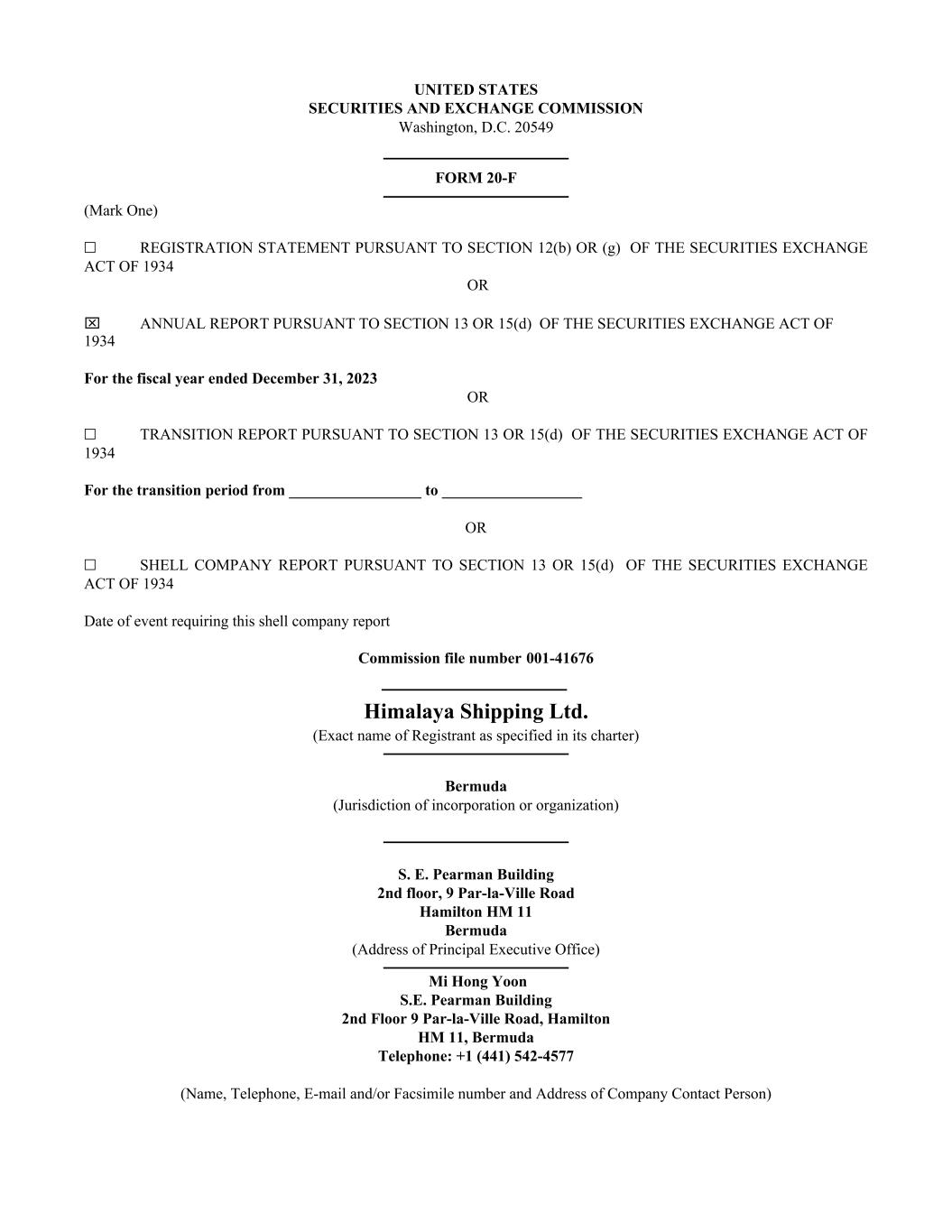
UNITED STATES SECURITIES AND EXCHANGE COMMISSION Washington, D.C. 20549 FORM 20-F (Mark One) ☐ REGISTRATION STATEMENT PURSUANT TO SECTION 12(b) OR (g) OF THE SECURITIES EXCHANGE ACT OF 1934 OR x ANNUAL REPORT PURSUANT TO SECTION 13 OR 15(d) OF THE SECURITIES EXCHANGE ACT OF 1934 For the fiscal year ended December 31, 2023 OR ☐ TRANSITION REPORT PURSUANT TO SECTION 13 OR 15(d) OF THE SECURITIES EXCHANGE ACT OF 1934 For the transition period from _________________ to __________________ OR ☐ SHELL COMPANY REPORT PURSUANT TO SECTION 13 OR 15(d) OF THE SECURITIES EXCHANGE ACT OF 1934 Date of event requiring this shell company report Commission file number 001-41676 Himalaya Shipping Ltd. (Exact name of Registrant as specified in its charter) Bermuda (Jurisdiction of incorporation or organization) S. E. Pearman Building 2nd floor, 9 Par-la-Ville Road Hamilton HM 11 Bermuda (Address of Principal Executive Office) Mi Hong Yoon S.E. Pearman Building 2nd Floor 9 Par-la-Ville Road, Hamilton HM 11, Bermuda Telephone: +1 (441) 542-4577 (Name, Telephone, E-mail and/or Facsimile number and Address of Company Contact Person)

Securities registered or to be registered pursuant to section 12(b) of the Act. Title of each class Trading Symbol Name of each exchange on which registered Common shares, par value $1.00 per share HSHP New York Stock Exchange Securities registered or to be registered pursuant to section 12(g) of the Act: None Securities for which there is a reporting obligation pursuant to Section 15(d) of the Act: None Indicate the number of outstanding shares of each of the issuer’s classes of capital or common stock as of the close of the period covered by the annual report. 43,900,000 Common Shares, par value $1.00 per share Indicate by check mark if the registrant is a well-known seasoned issuer, as defined in Rule 405 of the Securities Act. Yes o No x If this report is an annual or transition report, indicate by check mark if the registrant is not required to file reports pursuant to Section 13 or 15(d) of the Securities Exchange Act 1934. Yes o No x Note: Checking the box above will not relieve any registrant required to file reports pursuant to Section 13 or 15(d) of the Securities Exchange Act of 1934 from their obligations under those Sections. Indicate by check mark whether the registrant (1) has filed all reports required to be filed by Section 13 or 15(d) of the Securities Exchange Act of 1934 during the preceding 12 months (or for such shorter period that the registrant was required to file such reports), and (2) has been subject to such filing requirements for the past 90 days. Yes x No o Indicate by check mark whether the registrant has submitted electronically every Interactive Data File required to be submitted pursuant to Rule 405 of Regulation S-T (§232.405 of this chapter) during the preceding 12 months (or for such shorter period that the registrant was required to submit such files). Yes x No o Indicate by check mark whether the registrant is a large accelerated filer, an accelerated filer, a non-accelerated filer, or an emerging growth company. See definition of “large accelerated filer,” “accelerated filer” and “emerging growth company” in Rule 12b-2 of the Exchange Act. (Check one). Large accelerated filer o Accelerated filer o Non-accelerated filer x Emerging growth company x If an emerging growth company that prepares its financial statements in accordance with U.S. GAAP, indicate by check mark if the registrant has elected not to use the extended transition period for complying with any new or revised financial accounting standards† provided pursuant to Section 13(a) of the Exchange Act. x † The term “new or revised financial accounting standard” refers to any update issued by the Financial Accounting Standards Board to its Accounting Standards Codification after April 5, 2012. Indicate by check mark whether the registrant has filed a report on and attestation to its management’s assessment of the effectiveness of its internal control over financial reporting under Section 404(b) of the Sarbanes-Oxley Act (15 U.S.C. 7262(b)) by the registered public accounting firm that prepared or issued its audit report. Yes o No x If securities are registered pursuant to Section 12(b) of the Act, indicate by check mark whether the financial statements of the registrant included in the filing reflect the correction of an error to previously issued financial statements. Yes o No x
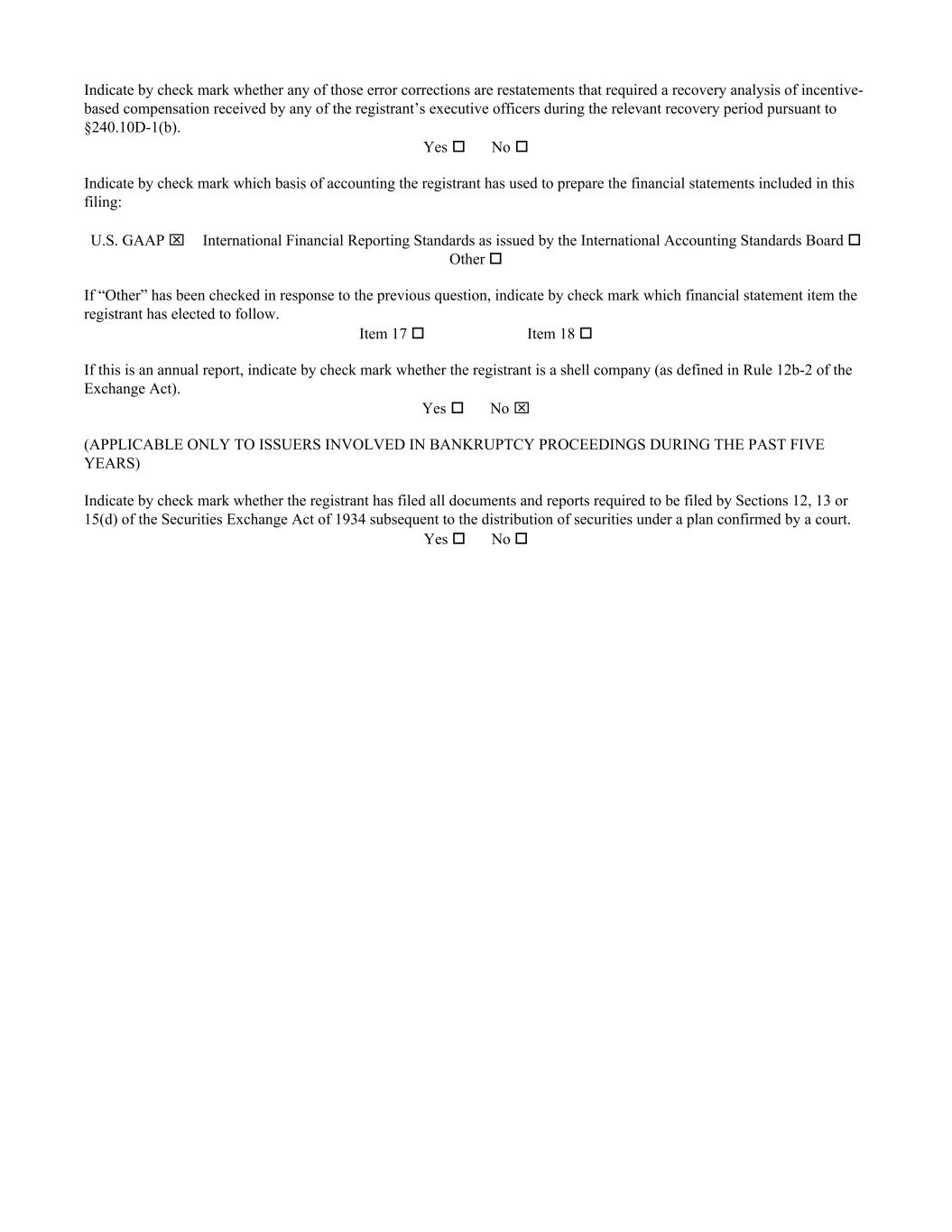
Indicate by check mark whether any of those error corrections are restatements that required a recovery analysis of incentive- based compensation received by any of the registrant’s executive officers during the relevant recovery period pursuant to §240.10D-1(b). Yes o No o Indicate by check mark which basis of accounting the registrant has used to prepare the financial statements included in this filing: U.S. GAAP x International Financial Reporting Standards as issued by the International Accounting Standards Board o Other o If “Other” has been checked in response to the previous question, indicate by check mark which financial statement item the registrant has elected to follow. Item 17 o Item 18 o If this is an annual report, indicate by check mark whether the registrant is a shell company (as defined in Rule 12b-2 of the Exchange Act). Yes o No x (APPLICABLE ONLY TO ISSUERS INVOLVED IN BANKRUPTCY PROCEEDINGS DURING THE PAST FIVE YEARS) Indicate by check mark whether the registrant has filed all documents and reports required to be filed by Sections 12, 13 or 15(d) of the Securities Exchange Act of 1934 subsequent to the distribution of securities under a plan confirmed by a court. Yes o No o
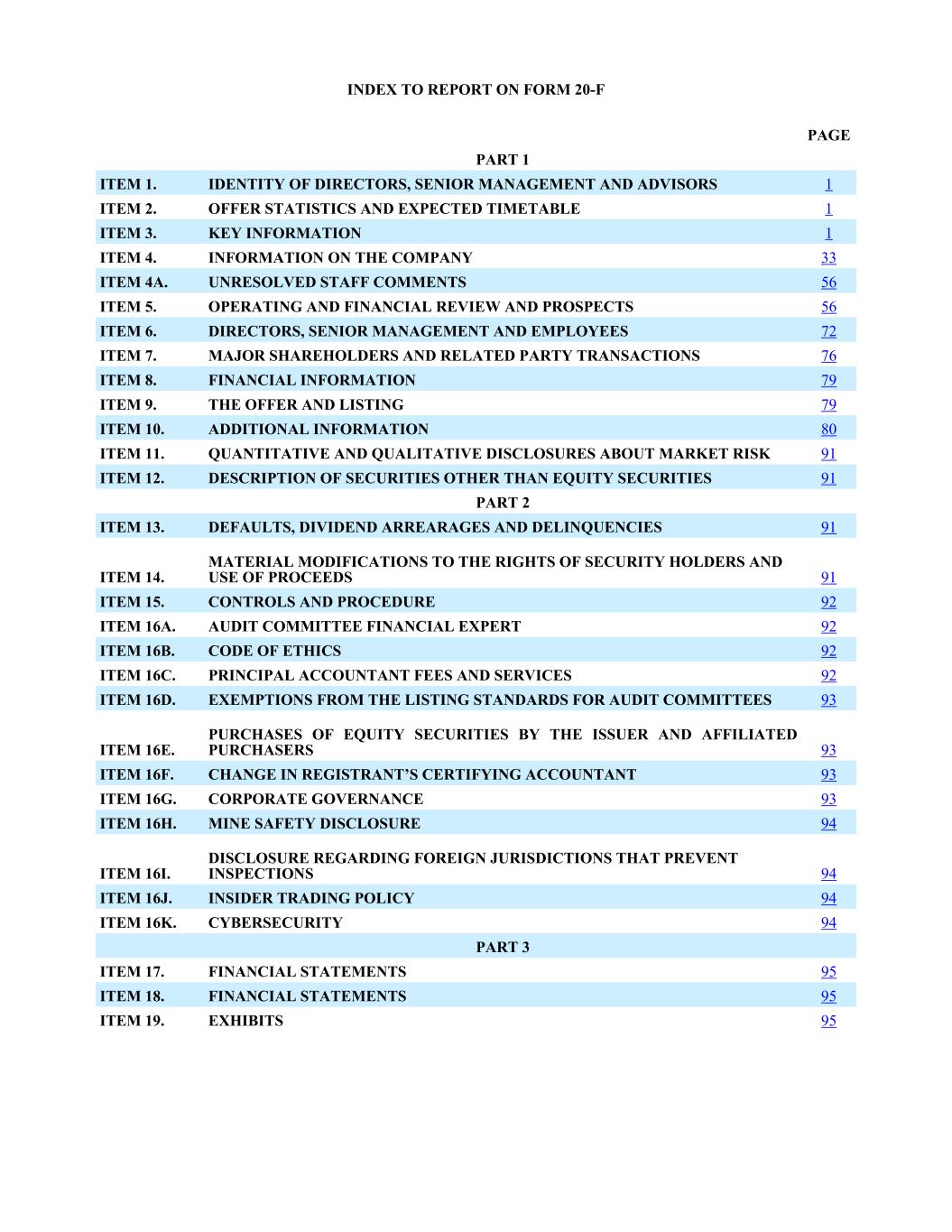
INDEX TO REPORT ON FORM 20-F PAGE PART 1 ITEM 1. IDENTITY OF DIRECTORS, SENIOR MANAGEMENT AND ADVISORS 1 ITEM 2. OFFER STATISTICS AND EXPECTED TIMETABLE 1 ITEM 3. KEY INFORMATION 1 ITEM 4. INFORMATION ON THE COMPANY 33 ITEM 4A. UNRESOLVED STAFF COMMENTS 56 ITEM 5. OPERATING AND FINANCIAL REVIEW AND PROSPECTS 56 ITEM 6. DIRECTORS, SENIOR MANAGEMENT AND EMPLOYEES 72 ITEM 7. MAJOR SHAREHOLDERS AND RELATED PARTY TRANSACTIONS 76 ITEM 8. FINANCIAL INFORMATION 79 ITEM 9. THE OFFER AND LISTING 79 ITEM 10. ADDITIONAL INFORMATION 80 ITEM 11. QUANTITATIVE AND QUALITATIVE DISCLOSURES ABOUT MARKET RISK 91 ITEM 12. DESCRIPTION OF SECURITIES OTHER THAN EQUITY SECURITIES 91 PART 2 ITEM 13. DEFAULTS, DIVIDEND ARREARAGES AND DELINQUENCIES 91 ITEM 14. MATERIAL MODIFICATIONS TO THE RIGHTS OF SECURITY HOLDERS AND USE OF PROCEEDS 91 ITEM 15. CONTROLS AND PROCEDURE 92 ITEM 16A. AUDIT COMMITTEE FINANCIAL EXPERT 92 ITEM 16B. CODE OF ETHICS 92 ITEM 16C. PRINCIPAL ACCOUNTANT FEES AND SERVICES 92 ITEM 16D. EXEMPTIONS FROM THE LISTING STANDARDS FOR AUDIT COMMITTEES 93 ITEM 16E. PURCHASES OF EQUITY SECURITIES BY THE ISSUER AND AFFILIATED PURCHASERS 93 ITEM 16F. CHANGE IN REGISTRANT’S CERTIFYING ACCOUNTANT 93 ITEM 16G. CORPORATE GOVERNANCE 93 ITEM 16H. MINE SAFETY DISCLOSURE 94 ITEM 16I. DISCLOSURE REGARDING FOREIGN JURISDICTIONS THAT PREVENT INSPECTIONS 94 ITEM 16J. INSIDER TRADING POLICY 94 ITEM 16K. CYBERSECURITY 94 PART 3 ITEM 17. FINANCIAL STATEMENTS 95 ITEM 18. FINANCIAL STATEMENTS 95 ITEM 19. EXHIBITS 95

NOTE ON THE PRESENTATION OF INFORMATION We have prepared this annual report using a number of conventions, which you should consider when reading the information contained herein. In this annual report, unless the context otherwise requires, (i) references to “Himalaya Shipping Ltd,” “Himalaya Shipping,” the “Company,” the “Registrant,” “we,” “us,” “Group,” “our” and words of similar import refer to Himalaya Shipping Ltd. and its consolidated subsidiaries, (ii) references to “our vessels” and “our newbuilding vessels” refer to the 12 Newcastlemax dry bulk vessels we have agreed to purchase, of which six vessels were delivered during the year ended December 31, 2023 and are currently in operation, and six were under construction at New Times Shipyard in China as of December 31, 2023. Of the six vessels under construction at December 31, 2023, three were delivered in January 2024 and the remaining three are expected to be delivered by the second quarter of 2024. References in the annual report to (i) our “Board” or “Board of Directors” refer to the board of directors of Himalaya Shipping Ltd. as constituted at any point in time and “Director” or “Directors” refers to a member or members of the Board, as applicable, (ii) our “Memorandum,” each provision thereof a “Clause,” or the “Bye-Laws,” each provision thereof a “Bye- Law,” refer to the memorandum of association and the amended and restated bye-laws of Himalaya Shipping Ltd., respectively, each as in effect from time to time, (iii) “Magni” or “Magni Partners” refers to Magni Partners (Bermuda) Limited, (iv) “Drew” refer to Drew Holdings Limited, (v) “New Times” or “New Times Shipyard” refer to New Times SB Jingjiang shipyard in China, (vi) “1-4 Shipbuilding Contracts” refer to the shipbuilding contracts with New Times relating to four vessels with hull numbers 0120833, 0120834, 0120835 and 0120836, (vii) “5-8 Shipbuilding Contracts” refer to the shipbuilding contracts with New Times relating to four vessels with hull numbers 0120837, 0120838, 0120839 and 0120840, (viii) references to “9-12 Shipbuilding Contracts” refer to the shipbuilding contracts with New Times relating to four additional vessels with hull numbers 0120841, 0120842, 0120843 and 0120844, (ix) “Shipbuilding Contracts” refer to 1-4 Shipbuilding Contracts, 5-8 Shipbuilding Contracts and 9-12 Shipbuilding Contracts, as the context requires, (x) “Avic Leasing Arrangements” or “Avic Leasing” refer to our sale and leaseback agreements with subsidiaries of Avic International Leasing Co., Ltd. in relation to the four vessels under our 1-4 Shipbuilding Contracts, (xi) “CCBFL Leasing Arrangements” or “CCBFL Leasing” refer to our sale and leaseback agreements with subsidiaries of CCB Financial Leasing Co., Ltd., in relation to six vessels under our 5-8 Shipbuilding Contract and 9-12 Shipbuilding Contracts, (xii) “Jiangsu Financial Leasing Arrangements” or “Jiangsu Financial Leasing” refer to our sale and leaseback agreements with subsidiaries of Jiangsu Financial Leasing Co. Ltd. in relation to vessels with hull numbers 0120839 and 0120840, originally financed under the CCBFL Leasing, (xiii)“Sale and Leaseback Agreements” refer to the Avic Leasing, the CCBFL Leasing, and the Jiangsu Leasing, (xiv) “Drew Holdings Revolving Credit Facility” or “Drew Holdings RCF” refer to our unsecured revolving credit facility with Drew, (xv) “Bridge Facility” refer to the unsecured Bridge Facility with DNB Bank ASA entered into in March 2023 and subsequently terminated in April 2023, (xvi) “Financing Arrangements” refer to our Avic Leasing Arrangements, CCBFL Leasing Arrangements, Jiangsu Financial Leasing Arrangements and Drew Holdings RCF described more fully herein, collectively, (xvii) the “Corporate Support Agreement” refer to our corporate services agreement with Magni Partners, (xviii) the “Management Agreement” refer to our management agreement with 2020 Bulkers Management AS (“2020 Bulkers” or “Manager”), (xix) the “Supervision Agreement” refer to the building supervision agreement of our vessels with SeaQuest Marine S.A. (“SeaQuest”), and (xx) the “Ship Management Agreements” refer to management agreements with respect to each vessel in our fleet, with either Wilhelmsen Ship Management (Norway) AS, or “Wilhemsen,” or OSM Bergen Dry AS, or “OSM,” each a “ Ship Manager.” References in this annual report to (i) the “SEC” refer to the US Securities and Exchange Commission and (ii) “U.S. GAAP” refer to the generally accepted accounting principles in the United States as in effect at any point in time. PRESENTATION OF FINANCIAL INFORMATION We produce financial statements in accordance with U.S. GAAP and all financial information included in this annual report is derived from our U.S. GAAP consolidated financial statements, except as otherwise indicated. Our consolidated financial statements included in this annual report comprise our consolidated statements of operations, comprehensive income (loss), changes in shareholders’ equity, and cash flows for the years ended December 31, 2023, 2022 and the period from March 17 to December 31, 2021 and consolidated balance sheets as of December 31, 2023 and 2022 (the “Audited Consolidated Financial Statements”). We present our consolidated financial statements in U.S. dollars.
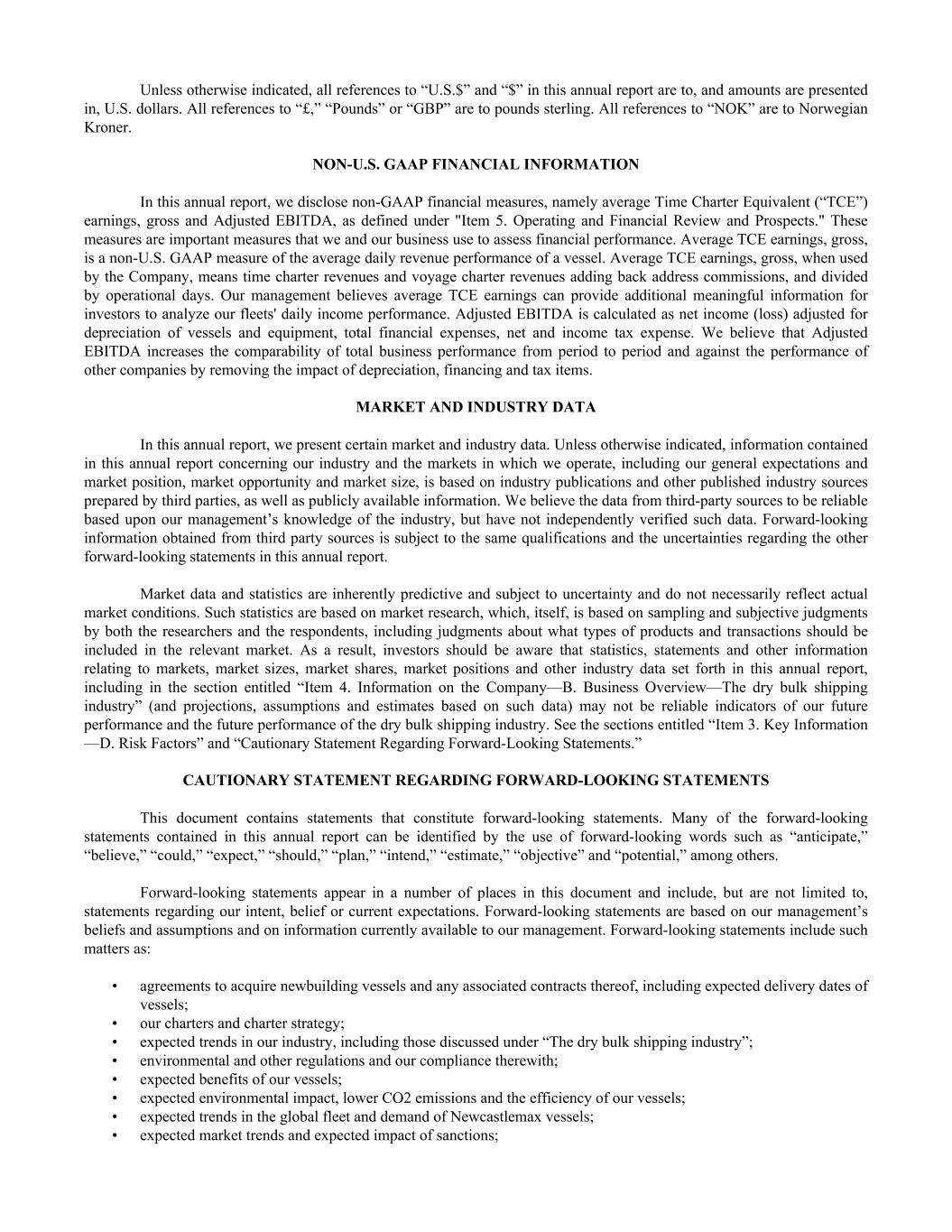
Unless otherwise indicated, all references to “U.S.$” and “$” in this annual report are to, and amounts are presented in, U.S. dollars. All references to “£,” “Pounds” or “GBP” are to pounds sterling. All references to “NOK” are to Norwegian Kroner. NON-U.S. GAAP FINANCIAL INFORMATION In this annual report, we disclose non-GAAP financial measures, namely average Time Charter Equivalent (“TCE”) earnings, gross and Adjusted EBITDA, as defined under "Item 5. Operating and Financial Review and Prospects." These measures are important measures that we and our business use to assess financial performance. Average TCE earnings, gross, is a non-U.S. GAAP measure of the average daily revenue performance of a vessel. Average TCE earnings, gross, when used by the Company, means time charter revenues and voyage charter revenues adding back address commissions, and divided by operational days. Our management believes average TCE earnings can provide additional meaningful information for investors to analyze our fleets' daily income performance. Adjusted EBITDA is calculated as net income (loss) adjusted for depreciation of vessels and equipment, total financial expenses, net and income tax expense. We believe that Adjusted EBITDA increases the comparability of total business performance from period to period and against the performance of other companies by removing the impact of depreciation, financing and tax items. MARKET AND INDUSTRY DATA In this annual report, we present certain market and industry data. Unless otherwise indicated, information contained in this annual report concerning our industry and the markets in which we operate, including our general expectations and market position, market opportunity and market size, is based on industry publications and other published industry sources prepared by third parties, as well as publicly available information. We believe the data from third-party sources to be reliable based upon our management’s knowledge of the industry, but have not independently verified such data. Forward-looking information obtained from third party sources is subject to the same qualifications and the uncertainties regarding the other forward-looking statements in this annual report. Market data and statistics are inherently predictive and subject to uncertainty and do not necessarily reflect actual market conditions. Such statistics are based on market research, which, itself, is based on sampling and subjective judgments by both the researchers and the respondents, including judgments about what types of products and transactions should be included in the relevant market. As a result, investors should be aware that statistics, statements and other information relating to markets, market sizes, market shares, market positions and other industry data set forth in this annual report, including in the section entitled “Item 4. Information on the Company—B. Business Overview—The dry bulk shipping industry” (and projections, assumptions and estimates based on such data) may not be reliable indicators of our future performance and the future performance of the dry bulk shipping industry. See the sections entitled “Item 3. Key Information —D. Risk Factors” and “Cautionary Statement Regarding Forward-Looking Statements.” CAUTIONARY STATEMENT REGARDING FORWARD-LOOKING STATEMENTS This document contains statements that constitute forward-looking statements. Many of the forward-looking statements contained in this annual report can be identified by the use of forward-looking words such as “anticipate,” “believe,” “could,” “expect,” “should,” “plan,” “intend,” “estimate,” “objective” and “potential,” among others. Forward-looking statements appear in a number of places in this document and include, but are not limited to, statements regarding our intent, belief or current expectations. Forward-looking statements are based on our management’s beliefs and assumptions and on information currently available to our management. Forward-looking statements include such matters as: • agreements to acquire newbuilding vessels and any associated contracts thereof, including expected delivery dates of vessels; • our charters and charter strategy; • expected trends in our industry, including those discussed under “The dry bulk shipping industry”; • environmental and other regulations and our compliance therewith; • expected benefits of our vessels; • expected environmental impact, lower CO2 emissions and the efficiency of our vessels; • expected trends in the global fleet and demand of Newcastlemax vessels; • expected market trends and expected impact of sanctions;
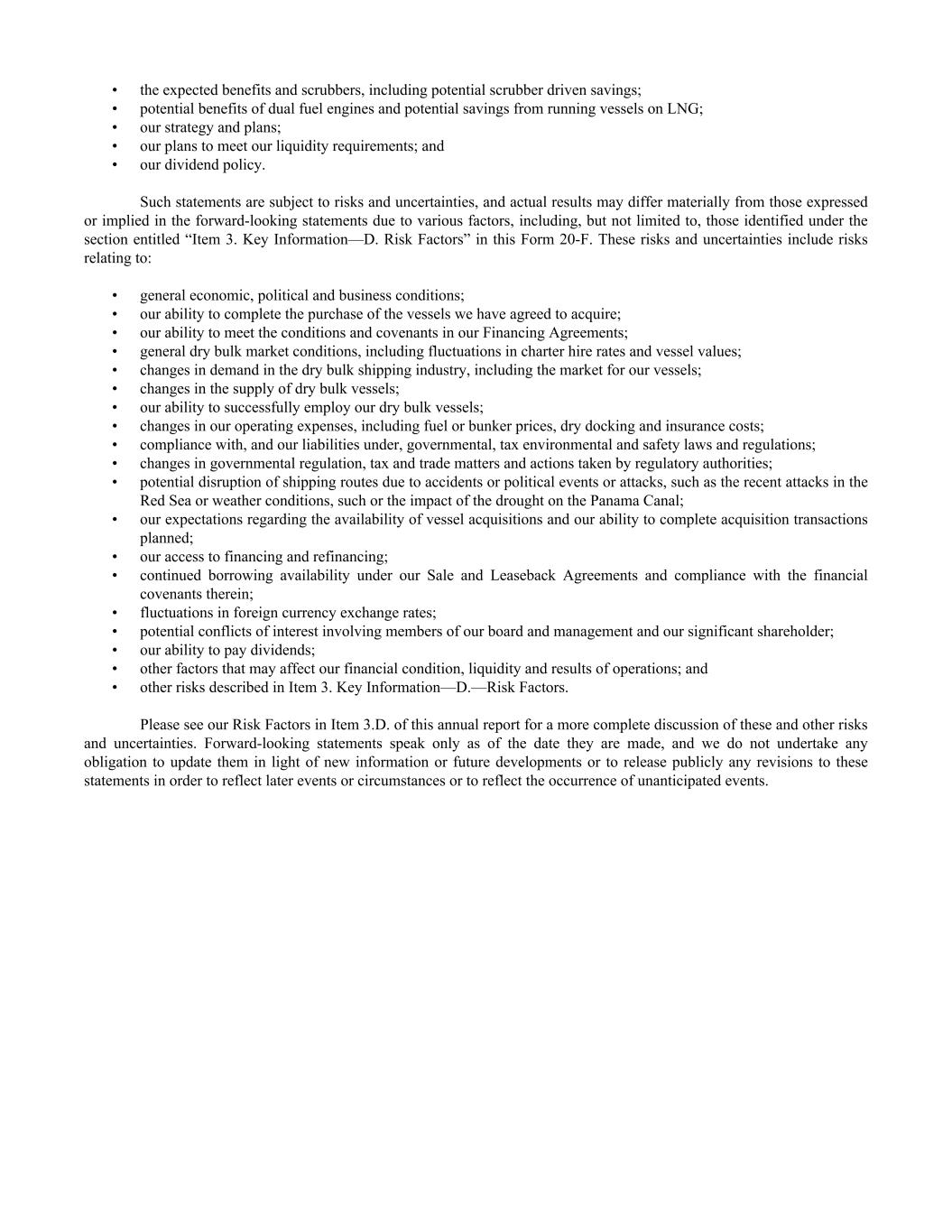
• the expected benefits and scrubbers, including potential scrubber driven savings; • potential benefits of dual fuel engines and potential savings from running vessels on LNG; • our strategy and plans; • our plans to meet our liquidity requirements; and • our dividend policy. Such statements are subject to risks and uncertainties, and actual results may differ materially from those expressed or implied in the forward-looking statements due to various factors, including, but not limited to, those identified under the section entitled “Item 3. Key Information—D. Risk Factors” in this Form 20-F. These risks and uncertainties include risks relating to: • general economic, political and business conditions; • our ability to complete the purchase of the vessels we have agreed to acquire; • our ability to meet the conditions and covenants in our Financing Agreements; • general dry bulk market conditions, including fluctuations in charter hire rates and vessel values; • changes in demand in the dry bulk shipping industry, including the market for our vessels; • changes in the supply of dry bulk vessels; • our ability to successfully employ our dry bulk vessels; • changes in our operating expenses, including fuel or bunker prices, dry docking and insurance costs; • compliance with, and our liabilities under, governmental, tax environmental and safety laws and regulations; • changes in governmental regulation, tax and trade matters and actions taken by regulatory authorities; • potential disruption of shipping routes due to accidents or political events or attacks, such as the recent attacks in the Red Sea or weather conditions, such or the impact of the drought on the Panama Canal; • our expectations regarding the availability of vessel acquisitions and our ability to complete acquisition transactions planned; • our access to financing and refinancing; • continued borrowing availability under our Sale and Leaseback Agreements and compliance with the financial covenants therein; • fluctuations in foreign currency exchange rates; • potential conflicts of interest involving members of our board and management and our significant shareholder; • our ability to pay dividends; • other factors that may affect our financial condition, liquidity and results of operations; and • other risks described in Item 3. Key Information—D.—Risk Factors. Please see our Risk Factors in Item 3.D. of this annual report for a more complete discussion of these and other risks and uncertainties. Forward-looking statements speak only as of the date they are made, and we do not undertake any obligation to update them in light of new information or future developments or to release publicly any revisions to these statements in order to reflect later events or circumstances or to reflect the occurrence of unanticipated events.
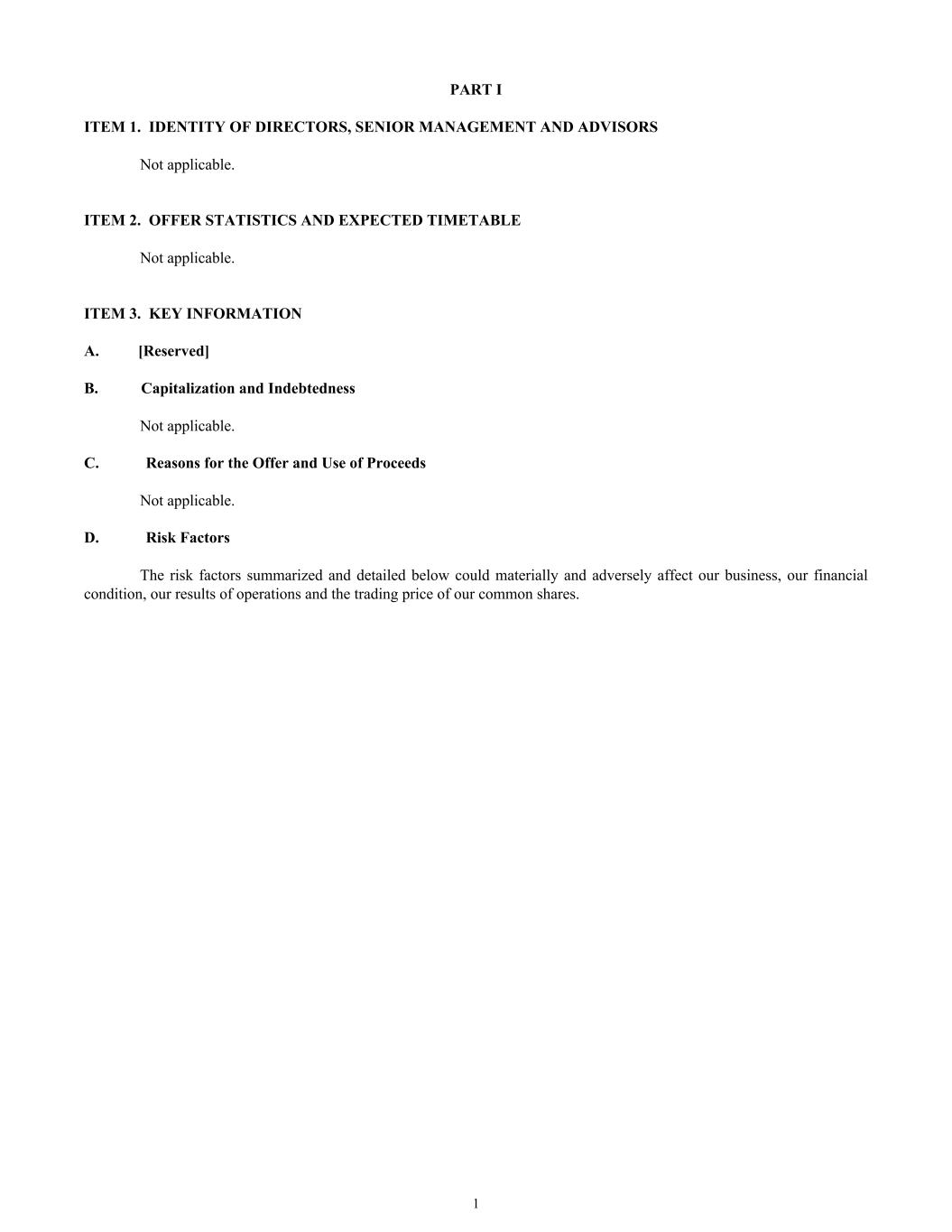
PART I ITEM 1. IDENTITY OF DIRECTORS, SENIOR MANAGEMENT AND ADVISORS Not applicable. ITEM 2. OFFER STATISTICS AND EXPECTED TIMETABLE Not applicable. ITEM 3. KEY INFORMATION A. [Reserved] B. Capitalization and Indebtedness Not applicable. C. Reasons for the Offer and Use of Proceeds Not applicable. D. Risk Factors The risk factors summarized and detailed below could materially and adversely affect our business, our financial condition, our results of operations and the trading price of our common shares. 1
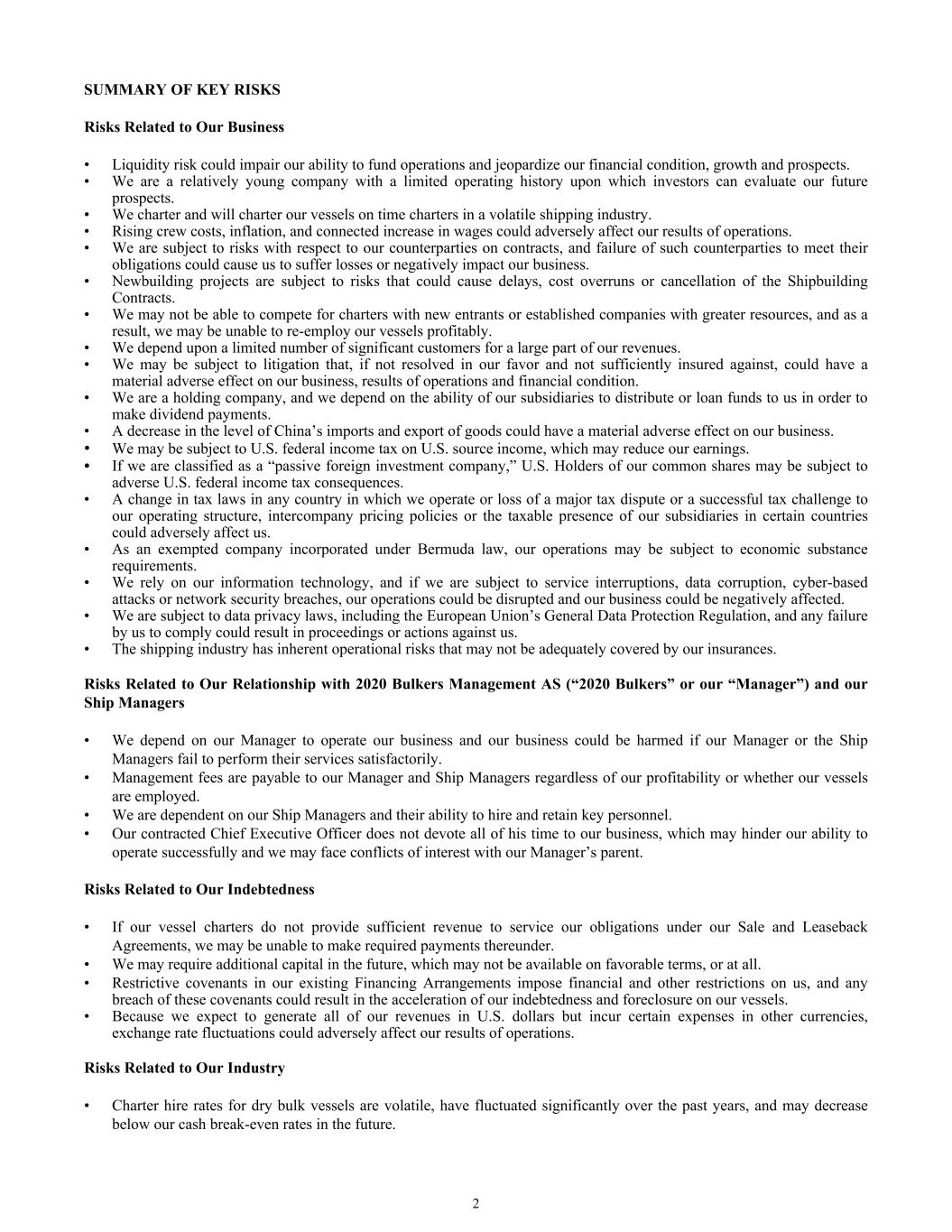
SUMMARY OF KEY RISKS Risks Related to Our Business • Liquidity risk could impair our ability to fund operations and jeopardize our financial condition, growth and prospects. • We are a relatively young company with a limited operating history upon which investors can evaluate our future prospects. • We charter and will charter our vessels on time charters in a volatile shipping industry. • Rising crew costs, inflation, and connected increase in wages could adversely affect our results of operations. • We are subject to risks with respect to our counterparties on contracts, and failure of such counterparties to meet their obligations could cause us to suffer losses or negatively impact our business. • Newbuilding projects are subject to risks that could cause delays, cost overruns or cancellation of the Shipbuilding Contracts. • We may not be able to compete for charters with new entrants or established companies with greater resources, and as a result, we may be unable to re-employ our vessels profitably. • We depend upon a limited number of significant customers for a large part of our revenues. • We may be subject to litigation that, if not resolved in our favor and not sufficiently insured against, could have a material adverse effect on our business, results of operations and financial condition. • We are a holding company, and we depend on the ability of our subsidiaries to distribute or loan funds to us in order to make dividend payments. • A decrease in the level of China’s imports and export of goods could have a material adverse effect on our business. • We may be subject to U.S. federal income tax on U.S. source income, which may reduce our earnings. • If we are classified as a “passive foreign investment company,” U.S. Holders of our common shares may be subject to adverse U.S. federal income tax consequences. • A change in tax laws in any country in which we operate or loss of a major tax dispute or a successful tax challenge to our operating structure, intercompany pricing policies or the taxable presence of our subsidiaries in certain countries could adversely affect us. • As an exempted company incorporated under Bermuda law, our operations may be subject to economic substance requirements. • We rely on our information technology, and if we are subject to service interruptions, data corruption, cyber-based attacks or network security breaches, our operations could be disrupted and our business could be negatively affected. • We are subject to data privacy laws, including the European Union’s General Data Protection Regulation, and any failure by us to comply could result in proceedings or actions against us. • The shipping industry has inherent operational risks that may not be adequately covered by our insurances. Risks Related to Our Relationship with 2020 Bulkers Management AS (“2020 Bulkers” or our “Manager”) and our Ship Managers • We depend on our Manager to operate our business and our business could be harmed if our Manager or the Ship Managers fail to perform their services satisfactorily. • Management fees are payable to our Manager and Ship Managers regardless of our profitability or whether our vessels are employed. • We are dependent on our Ship Managers and their ability to hire and retain key personnel. • Our contracted Chief Executive Officer does not devote all of his time to our business, which may hinder our ability to operate successfully and we may face conflicts of interest with our Manager’s parent. Risks Related to Our Indebtedness • If our vessel charters do not provide sufficient revenue to service our obligations under our Sale and Leaseback Agreements, we may be unable to make required payments thereunder. • We may require additional capital in the future, which may not be available on favorable terms, or at all. • Restrictive covenants in our existing Financing Arrangements impose financial and other restrictions on us, and any breach of these covenants could result in the acceleration of our indebtedness and foreclosure on our vessels. • Because we expect to generate all of our revenues in U.S. dollars but incur certain expenses in other currencies, exchange rate fluctuations could adversely affect our results of operations. Risks Related to Our Industry • Charter hire rates for dry bulk vessels are volatile, have fluctuated significantly over the past years, and may decrease below our cash break-even rates in the future. 2
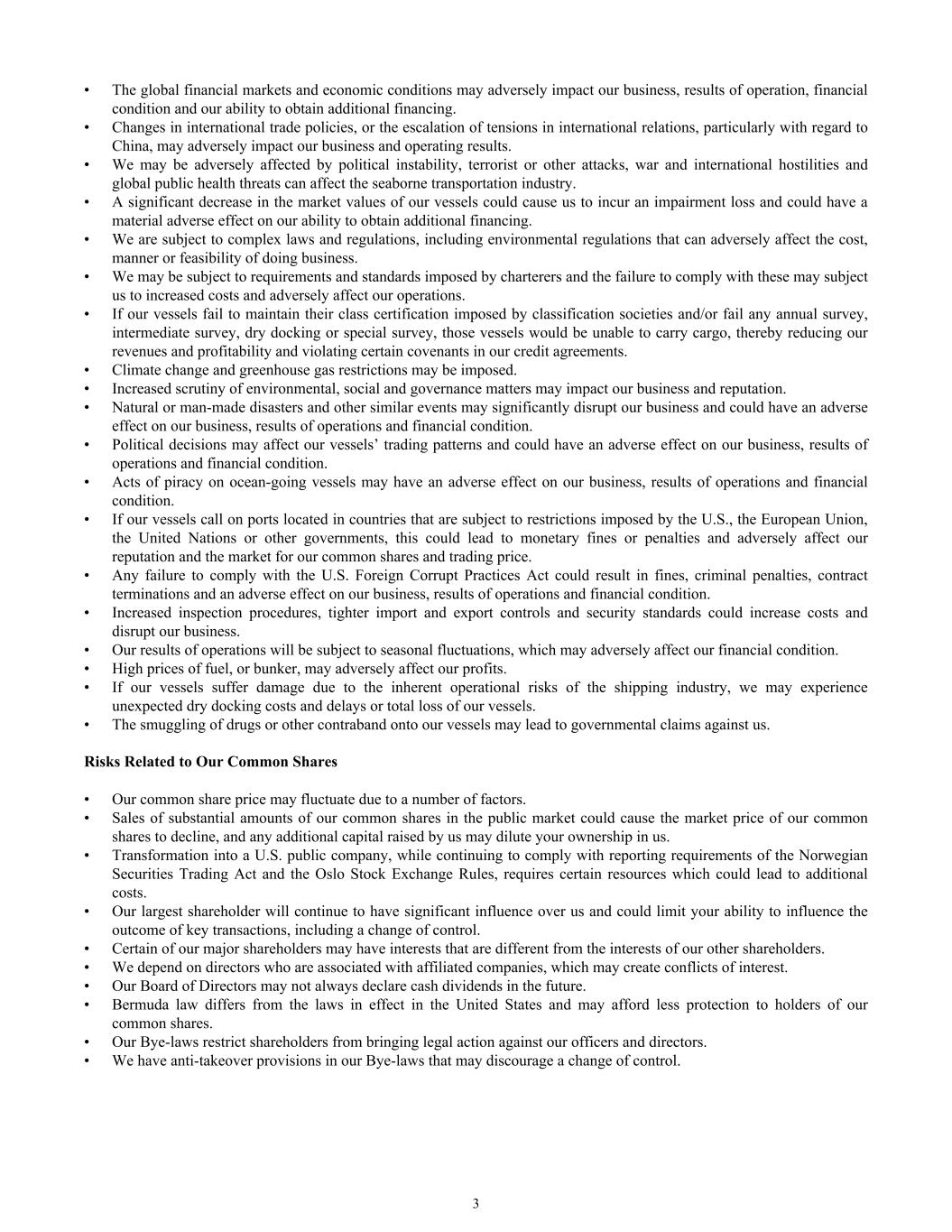
• The global financial markets and economic conditions may adversely impact our business, results of operation, financial condition and our ability to obtain additional financing. • Changes in international trade policies, or the escalation of tensions in international relations, particularly with regard to China, may adversely impact our business and operating results. • We may be adversely affected by political instability, terrorist or other attacks, war and international hostilities and global public health threats can affect the seaborne transportation industry. • A significant decrease in the market values of our vessels could cause us to incur an impairment loss and could have a material adverse effect on our ability to obtain additional financing. • We are subject to complex laws and regulations, including environmental regulations that can adversely affect the cost, manner or feasibility of doing business. • We may be subject to requirements and standards imposed by charterers and the failure to comply with these may subject us to increased costs and adversely affect our operations. • If our vessels fail to maintain their class certification imposed by classification societies and/or fail any annual survey, intermediate survey, dry docking or special survey, those vessels would be unable to carry cargo, thereby reducing our revenues and profitability and violating certain covenants in our credit agreements. • Climate change and greenhouse gas restrictions may be imposed. • Increased scrutiny of environmental, social and governance matters may impact our business and reputation. • Natural or man-made disasters and other similar events may significantly disrupt our business and could have an adverse effect on our business, results of operations and financial condition. • Political decisions may affect our vessels’ trading patterns and could have an adverse effect on our business, results of operations and financial condition. • Acts of piracy on ocean-going vessels may have an adverse effect on our business, results of operations and financial condition. • If our vessels call on ports located in countries that are subject to restrictions imposed by the U.S., the European Union, the United Nations or other governments, this could lead to monetary fines or penalties and adversely affect our reputation and the market for our common shares and trading price. • Any failure to comply with the U.S. Foreign Corrupt Practices Act could result in fines, criminal penalties, contract terminations and an adverse effect on our business, results of operations and financial condition. • Increased inspection procedures, tighter import and export controls and security standards could increase costs and disrupt our business. • Our results of operations will be subject to seasonal fluctuations, which may adversely affect our financial condition. • High prices of fuel, or bunker, may adversely affect our profits. • If our vessels suffer damage due to the inherent operational risks of the shipping industry, we may experience unexpected dry docking costs and delays or total loss of our vessels. • The smuggling of drugs or other contraband onto our vessels may lead to governmental claims against us. Risks Related to Our Common Shares • Our common share price may fluctuate due to a number of factors. • Sales of substantial amounts of our common shares in the public market could cause the market price of our common shares to decline, and any additional capital raised by us may dilute your ownership in us. • Transformation into a U.S. public company, while continuing to comply with reporting requirements of the Norwegian Securities Trading Act and the Oslo Stock Exchange Rules, requires certain resources which could lead to additional costs. • Our largest shareholder will continue to have significant influence over us and could limit your ability to influence the outcome of key transactions, including a change of control. • Certain of our major shareholders may have interests that are different from the interests of our other shareholders. • We depend on directors who are associated with affiliated companies, which may create conflicts of interest. • Our Board of Directors may not always declare cash dividends in the future. • Bermuda law differs from the laws in effect in the United States and may afford less protection to holders of our common shares. • Our Bye-laws restrict shareholders from bringing legal action against our officers and directors. • We have anti-takeover provisions in our Bye-laws that may discourage a change of control. 3
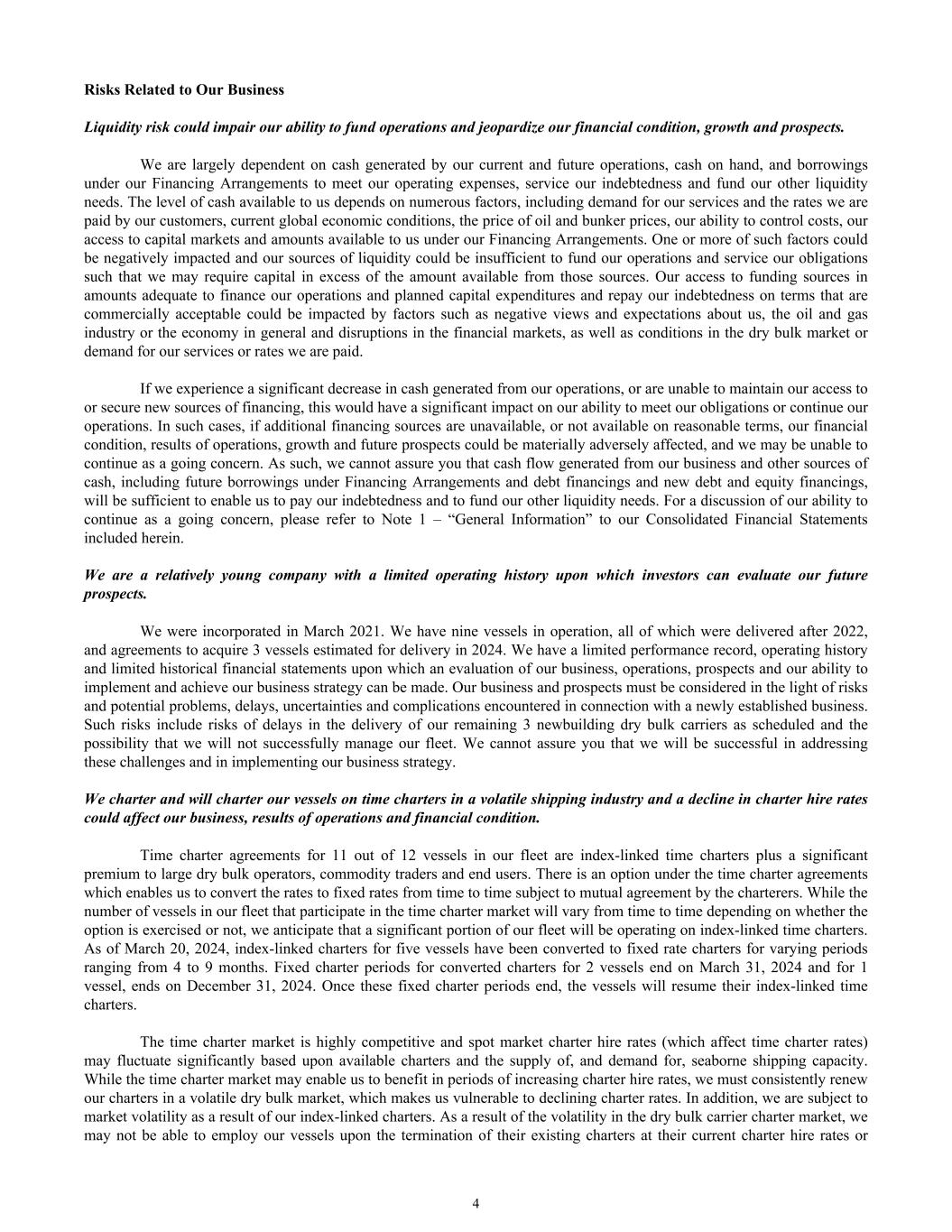
Risks Related to Our Business Liquidity risk could impair our ability to fund operations and jeopardize our financial condition, growth and prospects. We are largely dependent on cash generated by our current and future operations, cash on hand, and borrowings under our Financing Arrangements to meet our operating expenses, service our indebtedness and fund our other liquidity needs. The level of cash available to us depends on numerous factors, including demand for our services and the rates we are paid by our customers, current global economic conditions, the price of oil and bunker prices, our ability to control costs, our access to capital markets and amounts available to us under our Financing Arrangements. One or more of such factors could be negatively impacted and our sources of liquidity could be insufficient to fund our operations and service our obligations such that we may require capital in excess of the amount available from those sources. Our access to funding sources in amounts adequate to finance our operations and planned capital expenditures and repay our indebtedness on terms that are commercially acceptable could be impacted by factors such as negative views and expectations about us, the oil and gas industry or the economy in general and disruptions in the financial markets, as well as conditions in the dry bulk market or demand for our services or rates we are paid. If we experience a significant decrease in cash generated from our operations, or are unable to maintain our access to or secure new sources of financing, this would have a significant impact on our ability to meet our obligations or continue our operations. In such cases, if additional financing sources are unavailable, or not available on reasonable terms, our financial condition, results of operations, growth and future prospects could be materially adversely affected, and we may be unable to continue as a going concern. As such, we cannot assure you that cash flow generated from our business and other sources of cash, including future borrowings under Financing Arrangements and debt financings and new debt and equity financings, will be sufficient to enable us to pay our indebtedness and to fund our other liquidity needs. For a discussion of our ability to continue as a going concern, please refer to Note 1 – “General Information” to our Consolidated Financial Statements included herein. We are a relatively young company with a limited operating history upon which investors can evaluate our future prospects. We were incorporated in March 2021. We have nine vessels in operation, all of which were delivered after 2022, and agreements to acquire 3 vessels estimated for delivery in 2024. We have a limited performance record, operating history and limited historical financial statements upon which an evaluation of our business, operations, prospects and our ability to implement and achieve our business strategy can be made. Our business and prospects must be considered in the light of risks and potential problems, delays, uncertainties and complications encountered in connection with a newly established business. Such risks include risks of delays in the delivery of our remaining 3 newbuilding dry bulk carriers as scheduled and the possibility that we will not successfully manage our fleet. We cannot assure you that we will be successful in addressing these challenges and in implementing our business strategy. We charter and will charter our vessels on time charters in a volatile shipping industry and a decline in charter hire rates could affect our business, results of operations and financial condition. Time charter agreements for 11 out of 12 vessels in our fleet are index-linked time charters plus a significant premium to large dry bulk operators, commodity traders and end users. There is an option under the time charter agreements which enables us to convert the rates to fixed rates from time to time subject to mutual agreement by the charterers. While the number of vessels in our fleet that participate in the time charter market will vary from time to time depending on whether the option is exercised or not, we anticipate that a significant portion of our fleet will be operating on index-linked time charters. As of March 20, 2024, index-linked charters for five vessels have been converted to fixed rate charters for varying periods ranging from 4 to 9 months. Fixed charter periods for converted charters for 2 vessels end on March 31, 2024 and for 1 vessel, ends on December 31, 2024. Once these fixed charter periods end, the vessels will resume their index-linked time charters. The time charter market is highly competitive and spot market charter hire rates (which affect time charter rates) may fluctuate significantly based upon available charters and the supply of, and demand for, seaborne shipping capacity. While the time charter market may enable us to benefit in periods of increasing charter hire rates, we must consistently renew our charters in a volatile dry bulk market, which makes us vulnerable to declining charter rates. In addition, we are subject to market volatility as a result of our index-linked charters. As a result of the volatility in the dry bulk carrier charter market, we may not be able to employ our vessels upon the termination of their existing charters at their current charter hire rates or 4

premiums or at all. We cannot assure you that future charter hire rates will enable us to operate our vessels profitably, or to pay dividends. Rising crew costs, inflation, and connected increase in wages could adversely affect our results of operations. Due to an increase in the size of the global shipping fleet, the limited supply of and increased demand for crew has created upward pressure on crew costs. Continued higher crew costs or further increases in crew costs coupled with a persistent inflationary environment and the connected increase in crew wages could adversely affect our results of operations. We are subject to risks with respect to our counterparties on contracts, and failure of such counterparties to meet their obligations could cause us to suffer losses or negatively impact our business. We have entered, and plan to enter, into various contracts, including charter parties with our customers, newbuilding contracts (with related refund guarantees), vessel management agreements, the Avic Leasing, CCBFL Leasing and Jiangsu Leasing (our Sale and Leaseback Agreements), and other agreements. Such agreements subject us to counterparty risks. Such risk may be relevant for contracts we may enter into in the future and for the contracts, which we have already entered into, including the Shipbuilding Contracts with New Times and the related refund guarantees, the Avic Leasing, CCBFL Leasing and Jiangsu Leasing, the Supervision Agreement, the Management Agreement and the Corporate Support Agreement. The ability of each of our counterparties to perform their obligations under a contract with us will depend on a number of factors that are beyond our control, which may include, among other things, general economic conditions, the condition of the maritime industry, the overall financial condition of the counterparty, charter rates received for our Newcastlemax dry bulk carriers, the supply and demand for commodities and various other factors. In addition, in the event New Times does not perform under its contracts, and we are unable to enforce certain refund guarantees with third-party lenders that have provided the refund guarantees for any reason, we may lose all or part of our investment, and we may not be able to take delivery of the remaining undelivered vessels we ordered in accordance with our business plan. Should our counterparties fail to honor their obligations under agreements with us, in particular, the Shipbuilding Contracts and the related refund guarantees and the Avic Leasing and CCBFL Leasing, we could sustain significant losses, which could have a material adverse effect on our business, results of operations and financial condition. Charterers are sensitive to the commodity markets and may be impacted by market forces affecting commodities. In addition, in depressed market conditions, charterers may no longer need a vessel that is currently under charter or may be able to obtain a comparable vessel at lower rates. As a result, charterers may have incentive to renegotiate their charters or default on their obligations under charters. Should a charterer in the future fail to honor its obligations under agreements with us, it may be difficult to secure substitute employment for such vessel, and any new charter arrangements we secure on the spot market or on charters may be at lower rates, depending on the then existing charter rate levels, compared to the rates currently being charged for our vessels. If our charterers fail to meet their obligations to us or attempt to renegotiate our charter agreements, we could sustain significant losses which could have a material adverse effect on our business, results of operations and financial condition. The Company will seek to mitigate such consequences for example through re-negotiation of terms with its lenders, and strive to re-charter or seek remedies from defaulting charterers, however such efforts may not be successful and may lead to negative reactions from its lenders which may be detrimental for the Company’s business. Newbuilding projects are subject to risks that could cause delays, cost overruns or cancellation of the Shipbuilding Contracts. We have three newbuilding dry bulk carriers under construction under the Shipbuilding Contracts with New Times, which are estimated to be delivered in the second quarter of 2024. Risks of delays and failure of New Times to deliver exist until the vessels are delivered. Vessel construction projects are generally subject to risks of delay or cost overruns inherent in any large construction project as a result of numerous factors, including shortages of equipment, materials or skilled labor, unscheduled delays in the delivery of ordered materials and equipment or shipyard construction, failure of equipment to meet quality and/or performance standards, financial or operating difficulties experienced by equipment vendors or the shipyard, unanticipated actual or purported change orders, an inability to obtain required permits or approvals, unanticipated cost increases between order and delivery, design or engineering changes and work stoppages and other labor disputes, adverse weather conditions or any other events of force majeure. We also remain subject to risks of the impact of pandemics and containment measures taken in response to pandemics. 5
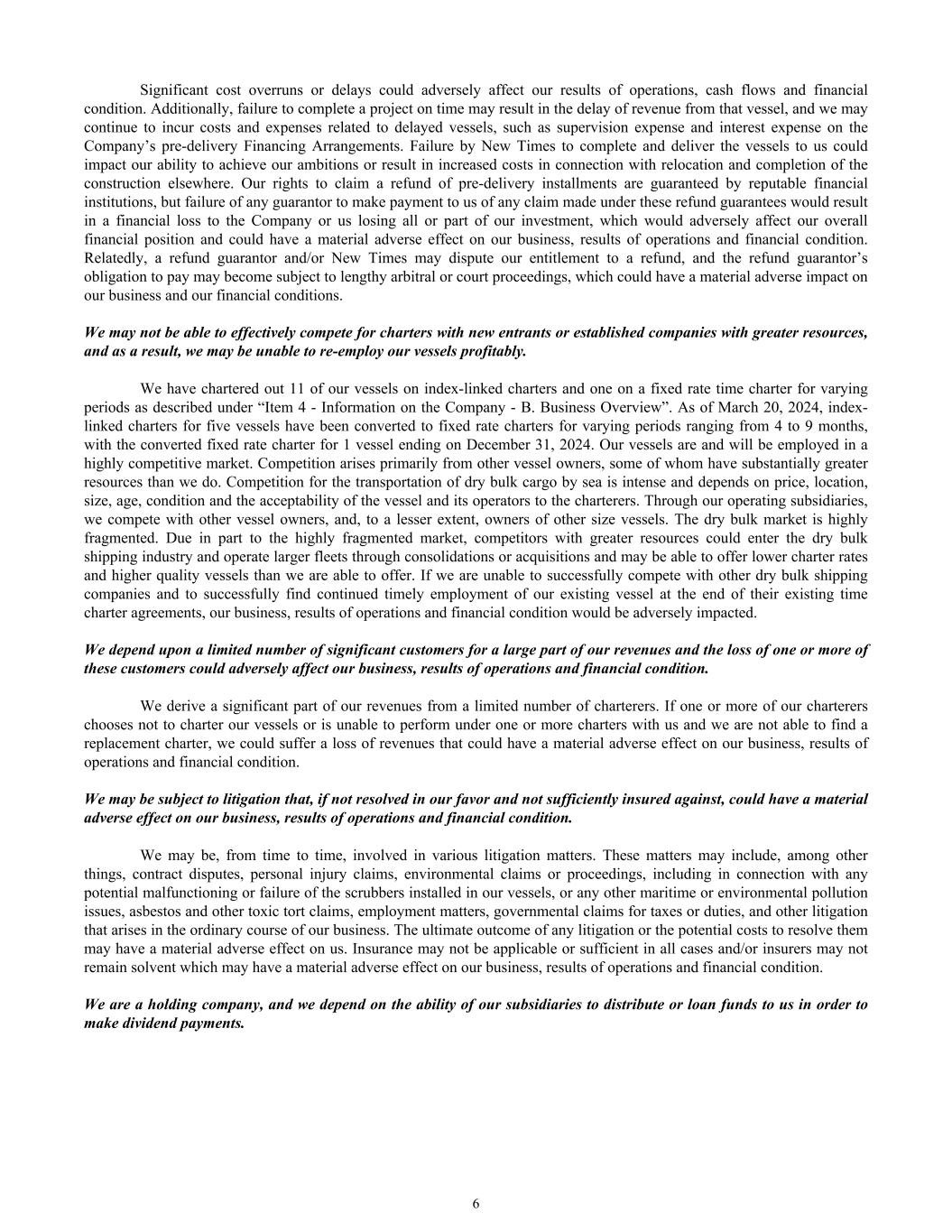
Significant cost overruns or delays could adversely affect our results of operations, cash flows and financial condition. Additionally, failure to complete a project on time may result in the delay of revenue from that vessel, and we may continue to incur costs and expenses related to delayed vessels, such as supervision expense and interest expense on the Company’s pre-delivery Financing Arrangements. Failure by New Times to complete and deliver the vessels to us could impact our ability to achieve our ambitions or result in increased costs in connection with relocation and completion of the construction elsewhere. Our rights to claim a refund of pre-delivery installments are guaranteed by reputable financial institutions, but failure of any guarantor to make payment to us of any claim made under these refund guarantees would result in a financial loss to the Company or us losing all or part of our investment, which would adversely affect our overall financial position and could have a material adverse effect on our business, results of operations and financial condition. Relatedly, a refund guarantor and/or New Times may dispute our entitlement to a refund, and the refund guarantor’s obligation to pay may become subject to lengthy arbitral or court proceedings, which could have a material adverse impact on our business and our financial conditions. We may not be able to effectively compete for charters with new entrants or established companies with greater resources, and as a result, we may be unable to re-employ our vessels profitably. We have chartered out 11 of our vessels on index-linked charters and one on a fixed rate time charter for varying periods as described under “Item 4 - Information on the Company - B. Business Overview”. As of March 20, 2024, index- linked charters for five vessels have been converted to fixed rate charters for varying periods ranging from 4 to 9 months, with the converted fixed rate charter for 1 vessel ending on December 31, 2024. Our vessels are and will be employed in a highly competitive market. Competition arises primarily from other vessel owners, some of whom have substantially greater resources than we do. Competition for the transportation of dry bulk cargo by sea is intense and depends on price, location, size, age, condition and the acceptability of the vessel and its operators to the charterers. Through our operating subsidiaries, we compete with other vessel owners, and, to a lesser extent, owners of other size vessels. The dry bulk market is highly fragmented. Due in part to the highly fragmented market, competitors with greater resources could enter the dry bulk shipping industry and operate larger fleets through consolidations or acquisitions and may be able to offer lower charter rates and higher quality vessels than we are able to offer. If we are unable to successfully compete with other dry bulk shipping companies and to successfully find continued timely employment of our existing vessel at the end of their existing time charter agreements, our business, results of operations and financial condition would be adversely impacted. We depend upon a limited number of significant customers for a large part of our revenues and the loss of one or more of these customers could adversely affect our business, results of operations and financial condition. We derive a significant part of our revenues from a limited number of charterers. If one or more of our charterers chooses not to charter our vessels or is unable to perform under one or more charters with us and we are not able to find a replacement charter, we could suffer a loss of revenues that could have a material adverse effect on our business, results of operations and financial condition. We may be subject to litigation that, if not resolved in our favor and not sufficiently insured against, could have a material adverse effect on our business, results of operations and financial condition. We may be, from time to time, involved in various litigation matters. These matters may include, among other things, contract disputes, personal injury claims, environmental claims or proceedings, including in connection with any potential malfunctioning or failure of the scrubbers installed in our vessels, or any other maritime or environmental pollution issues, asbestos and other toxic tort claims, employment matters, governmental claims for taxes or duties, and other litigation that arises in the ordinary course of our business. The ultimate outcome of any litigation or the potential costs to resolve them may have a material adverse effect on us. Insurance may not be applicable or sufficient in all cases and/or insurers may not remain solvent which may have a material adverse effect on our business, results of operations and financial condition. We are a holding company, and we depend on the ability of our subsidiaries to distribute or loan funds to us in order to make dividend payments. 6
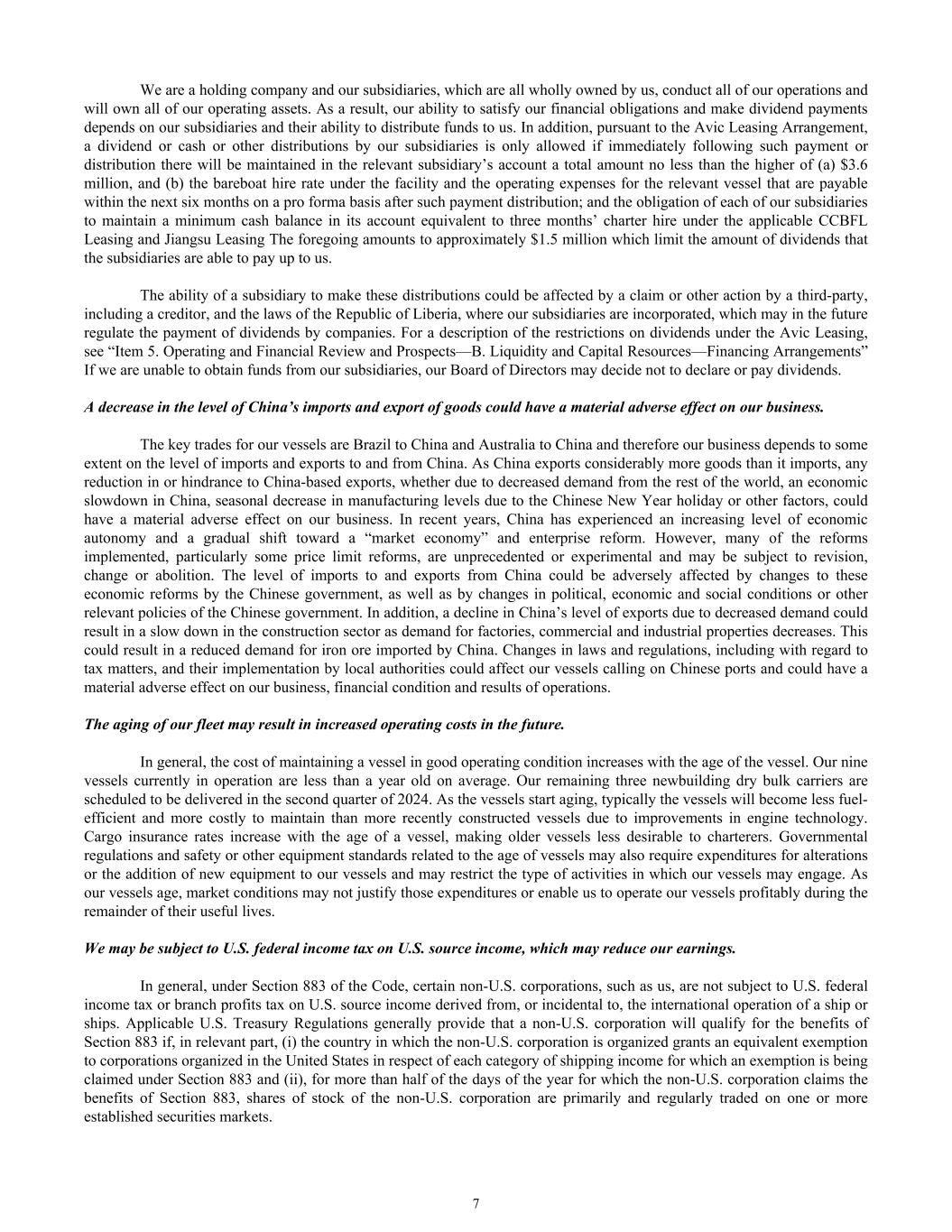
We are a holding company and our subsidiaries, which are all wholly owned by us, conduct all of our operations and will own all of our operating assets. As a result, our ability to satisfy our financial obligations and make dividend payments depends on our subsidiaries and their ability to distribute funds to us. In addition, pursuant to the Avic Leasing Arrangement, a dividend or cash or other distributions by our subsidiaries is only allowed if immediately following such payment or distribution there will be maintained in the relevant subsidiary’s account a total amount no less than the higher of (a) $3.6 million, and (b) the bareboat hire rate under the facility and the operating expenses for the relevant vessel that are payable within the next six months on a pro forma basis after such payment distribution; and the obligation of each of our subsidiaries to maintain a minimum cash balance in its account equivalent to three months’ charter hire under the applicable CCBFL Leasing and Jiangsu Leasing The foregoing amounts to approximately $1.5 million which limit the amount of dividends that the subsidiaries are able to pay up to us. The ability of a subsidiary to make these distributions could be affected by a claim or other action by a third-party, including a creditor, and the laws of the Republic of Liberia, where our subsidiaries are incorporated, which may in the future regulate the payment of dividends by companies. For a description of the restrictions on dividends under the Avic Leasing, see “Item 5. Operating and Financial Review and Prospects—B. Liquidity and Capital Resources—Financing Arrangements” If we are unable to obtain funds from our subsidiaries, our Board of Directors may decide not to declare or pay dividends. A decrease in the level of China’s imports and export of goods could have a material adverse effect on our business. The key trades for our vessels are Brazil to China and Australia to China and therefore our business depends to some extent on the level of imports and exports to and from China. As China exports considerably more goods than it imports, any reduction in or hindrance to China-based exports, whether due to decreased demand from the rest of the world, an economic slowdown in China, seasonal decrease in manufacturing levels due to the Chinese New Year holiday or other factors, could have a material adverse effect on our business. In recent years, China has experienced an increasing level of economic autonomy and a gradual shift toward a “market economy” and enterprise reform. However, many of the reforms implemented, particularly some price limit reforms, are unprecedented or experimental and may be subject to revision, change or abolition. The level of imports to and exports from China could be adversely affected by changes to these economic reforms by the Chinese government, as well as by changes in political, economic and social conditions or other relevant policies of the Chinese government. In addition, a decline in China’s level of exports due to decreased demand could result in a slow down in the construction sector as demand for factories, commercial and industrial properties decreases. This could result in a reduced demand for iron ore imported by China. Changes in laws and regulations, including with regard to tax matters, and their implementation by local authorities could affect our vessels calling on Chinese ports and could have a material adverse effect on our business, financial condition and results of operations. The aging of our fleet may result in increased operating costs in the future. In general, the cost of maintaining a vessel in good operating condition increases with the age of the vessel. Our nine vessels currently in operation are less than a year old on average. Our remaining three newbuilding dry bulk carriers are scheduled to be delivered in the second quarter of 2024. As the vessels start aging, typically the vessels will become less fuel- efficient and more costly to maintain than more recently constructed vessels due to improvements in engine technology. Cargo insurance rates increase with the age of a vessel, making older vessels less desirable to charterers. Governmental regulations and safety or other equipment standards related to the age of vessels may also require expenditures for alterations or the addition of new equipment to our vessels and may restrict the type of activities in which our vessels may engage. As our vessels age, market conditions may not justify those expenditures or enable us to operate our vessels profitably during the remainder of their useful lives. We may be subject to U.S. federal income tax on U.S. source income, which may reduce our earnings. In general, under Section 883 of the Code, certain non-U.S. corporations, such as us, are not subject to U.S. federal income tax or branch profits tax on U.S. source income derived from, or incidental to, the international operation of a ship or ships. Applicable U.S. Treasury Regulations generally provide that a non-U.S. corporation will qualify for the benefits of Section 883 if, in relevant part, (i) the country in which the non-U.S. corporation is organized grants an equivalent exemption to corporations organized in the United States in respect of each category of shipping income for which an exemption is being claimed under Section 883 and (ii), for more than half of the days of the year for which the non-U.S. corporation claims the benefits of Section 883, shares of stock of the non-U.S. corporation are primarily and regularly traded on one or more established securities markets. 7

Whether we qualify for the benefits of Section 883, in certain circumstances, depend on a specified percentage of our common shares being owned, directly or indirectly, by shareholders who meet certain tests, including being resident in the United States or certain other countries. In such circumstances, we would be required to satisfy certain substantiation and reporting requirements to establish that we so qualify, which in turn would require such shareholders (and certain intermediaries through which they indirectly own our common shares) to provide us with certain documentation. The ownership of our common shares may not allow us to so qualify for the benefits of Section 883, or, even if the ownership of our common shares would allow us to so qualify, we may not be able to satisfy the substantiation and reporting requirements that we would need to meet to establish that we so qualify. As a result, there can be no assurance that we will qualify for the benefits of Section 883 for 2023 taxable year or any subsequent taxable year. If we do not qualify for the benefits of Section 883 for any taxable year, we could be subject to a 4% U.S. federal income tax on the shipping income we derive during the year, on a gross income basis, that is attributable to the transport of cargoes to or from the United States. The imposition of this tax may adversely affect our business and would result in decreased earnings available for distribution to our shareholders. If we are classified as a “passive foreign investment company,” U.S. Holders of our common shares may be subject to adverse U.S. federal income tax consequences. A non-U.S. corporation, such as us, will be classified as a passive foreign investment company (“PFIC”) for U.S. federal income tax purposes for any taxable year if either (i) 75% or more of its gross income consists of passive income (the “income test”) or (ii) 50% or more of its assets (determined on the basis of a quarterly average) is attributable to assets that produce or are held for the production of passive income (the “asset test”). PFIC status is a factual determination that must be made annually after the close of each taxable year. This determination will depend on, among other things, the composition of our income, assets and operations, as well as the value of our assets (which may be determined, in part, by reference to the public price of our common shares, which may fluctuate significantly), from time to time. We believe that the income we earn from our time charters and will earn from voyage charters should not be treated as passive income for the purposes of the income test. Accordingly, based on the current composition of our income and assets, and our expected income and operations, we believe that we were not a PFIC for our most recent taxable year ending December 31, 2023 and we do not expect to be a PFIC for the current taxable or foreseeable future taxable years. There can be no assurance, however, that we were not a PFIC for the taxable year ending December 31, 2023 or will not be classified as a PFIC for the current taxable year or for future taxable years. If we are treated as a PFIC for any taxable year during which a U.S. Holder (as defined below) holds our common shares, such U.S. Holder could be subject to adverse U.S. federal income tax consequences. See “Item 10. Additional Information—E. Taxation—U.S. Federal Income Tax Considerations—Passive Foreign Investment Company Considerations.” A change in tax laws in any country in which we operate or loss of a major tax dispute or a successful tax challenge to our operating structure, intercompany pricing policies or the taxable presence of our subsidiaries in certain countries could adversely affect us. Tax laws, treaties and regulations are highly complex and subject to change and differing interpretation. Consequently, we and our subsidiaries are subject to changing laws, treaties and regulations in and between the countries in which we operate. Our tax expense is based on our interpretation of the tax laws in effect at the time the expense was incurred. A change in tax laws, treaties or regulations, or in the interpretation thereof, could result in a materially higher tax expense or a higher effective tax rate on our earnings. Such changes may include measures enacted in response to the ongoing initiatives in relation to fiscal legislation at an international level such as the Action Plan on Base Erosion and Profit Shifting of the Organization for Economic Co-Operation and Development. For example, on December 27, 2023, Bermuda enacted the Corporate Income Tax Act (the “CIT Act”). Entities subject to tax under the CIT Act are the Bermuda constituent entities of multi-national groups. While we have a tax exempt status in Bermuda until March 31, 2035, Bermuda specifically provided that the CIT Act applies notwithstanding any assurance given pursuant to the Exempted Undertakings Tax Protection Act 1966 (the “EUTP Act”). Based on a number of operational, economic and regulatory assumptions, we do not expect to have consolidated revenue sufficient for us to fall within scope of the CIT Act in the near future. We will monitor the developments on the Bermuda internal regulations with regards to the CIT Act implementation. To the extent our consolidated revenue is sufficient for us to be within the CIT Act thresholds, we may be subject to taxation in Bermuda. 8
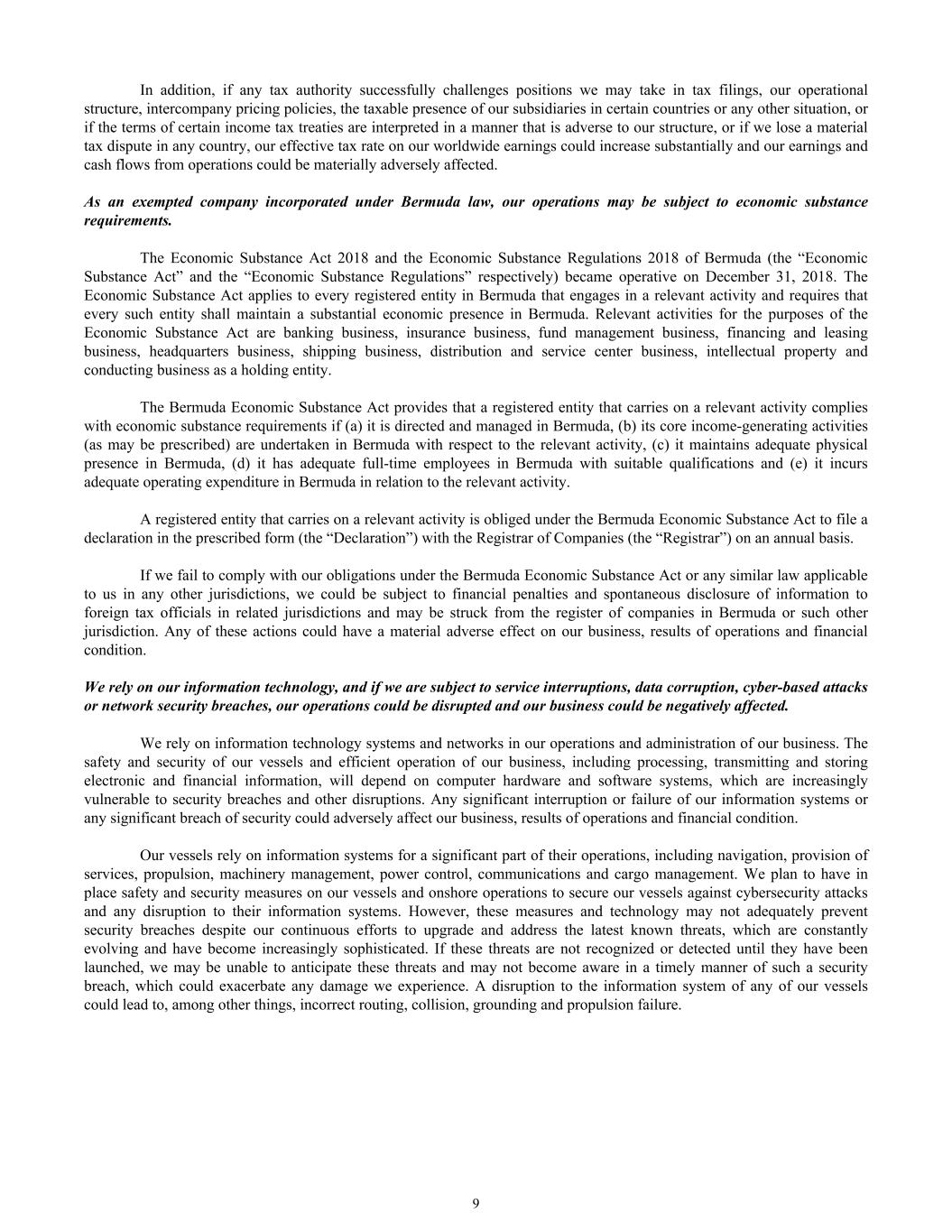
In addition, if any tax authority successfully challenges positions we may take in tax filings, our operational structure, intercompany pricing policies, the taxable presence of our subsidiaries in certain countries or any other situation, or if the terms of certain income tax treaties are interpreted in a manner that is adverse to our structure, or if we lose a material tax dispute in any country, our effective tax rate on our worldwide earnings could increase substantially and our earnings and cash flows from operations could be materially adversely affected. As an exempted company incorporated under Bermuda law, our operations may be subject to economic substance requirements. The Economic Substance Act 2018 and the Economic Substance Regulations 2018 of Bermuda (the “Economic Substance Act” and the “Economic Substance Regulations” respectively) became operative on December 31, 2018. The Economic Substance Act applies to every registered entity in Bermuda that engages in a relevant activity and requires that every such entity shall maintain a substantial economic presence in Bermuda. Relevant activities for the purposes of the Economic Substance Act are banking business, insurance business, fund management business, financing and leasing business, headquarters business, shipping business, distribution and service center business, intellectual property and conducting business as a holding entity. The Bermuda Economic Substance Act provides that a registered entity that carries on a relevant activity complies with economic substance requirements if (a) it is directed and managed in Bermuda, (b) its core income-generating activities (as may be prescribed) are undertaken in Bermuda with respect to the relevant activity, (c) it maintains adequate physical presence in Bermuda, (d) it has adequate full-time employees in Bermuda with suitable qualifications and (e) it incurs adequate operating expenditure in Bermuda in relation to the relevant activity. A registered entity that carries on a relevant activity is obliged under the Bermuda Economic Substance Act to file a declaration in the prescribed form (the “Declaration”) with the Registrar of Companies (the “Registrar”) on an annual basis. If we fail to comply with our obligations under the Bermuda Economic Substance Act or any similar law applicable to us in any other jurisdictions, we could be subject to financial penalties and spontaneous disclosure of information to foreign tax officials in related jurisdictions and may be struck from the register of companies in Bermuda or such other jurisdiction. Any of these actions could have a material adverse effect on our business, results of operations and financial condition. We rely on our information technology, and if we are subject to service interruptions, data corruption, cyber-based attacks or network security breaches, our operations could be disrupted and our business could be negatively affected. We rely on information technology systems and networks in our operations and administration of our business. The safety and security of our vessels and efficient operation of our business, including processing, transmitting and storing electronic and financial information, will depend on computer hardware and software systems, which are increasingly vulnerable to security breaches and other disruptions. Any significant interruption or failure of our information systems or any significant breach of security could adversely affect our business, results of operations and financial condition. Our vessels rely on information systems for a significant part of their operations, including navigation, provision of services, propulsion, machinery management, power control, communications and cargo management. We plan to have in place safety and security measures on our vessels and onshore operations to secure our vessels against cybersecurity attacks and any disruption to their information systems. However, these measures and technology may not adequately prevent security breaches despite our continuous efforts to upgrade and address the latest known threats, which are constantly evolving and have become increasingly sophisticated. If these threats are not recognized or detected until they have been launched, we may be unable to anticipate these threats and may not become aware in a timely manner of such a security breach, which could exacerbate any damage we experience. A disruption to the information system of any of our vessels could lead to, among other things, incorrect routing, collision, grounding and propulsion failure. 9
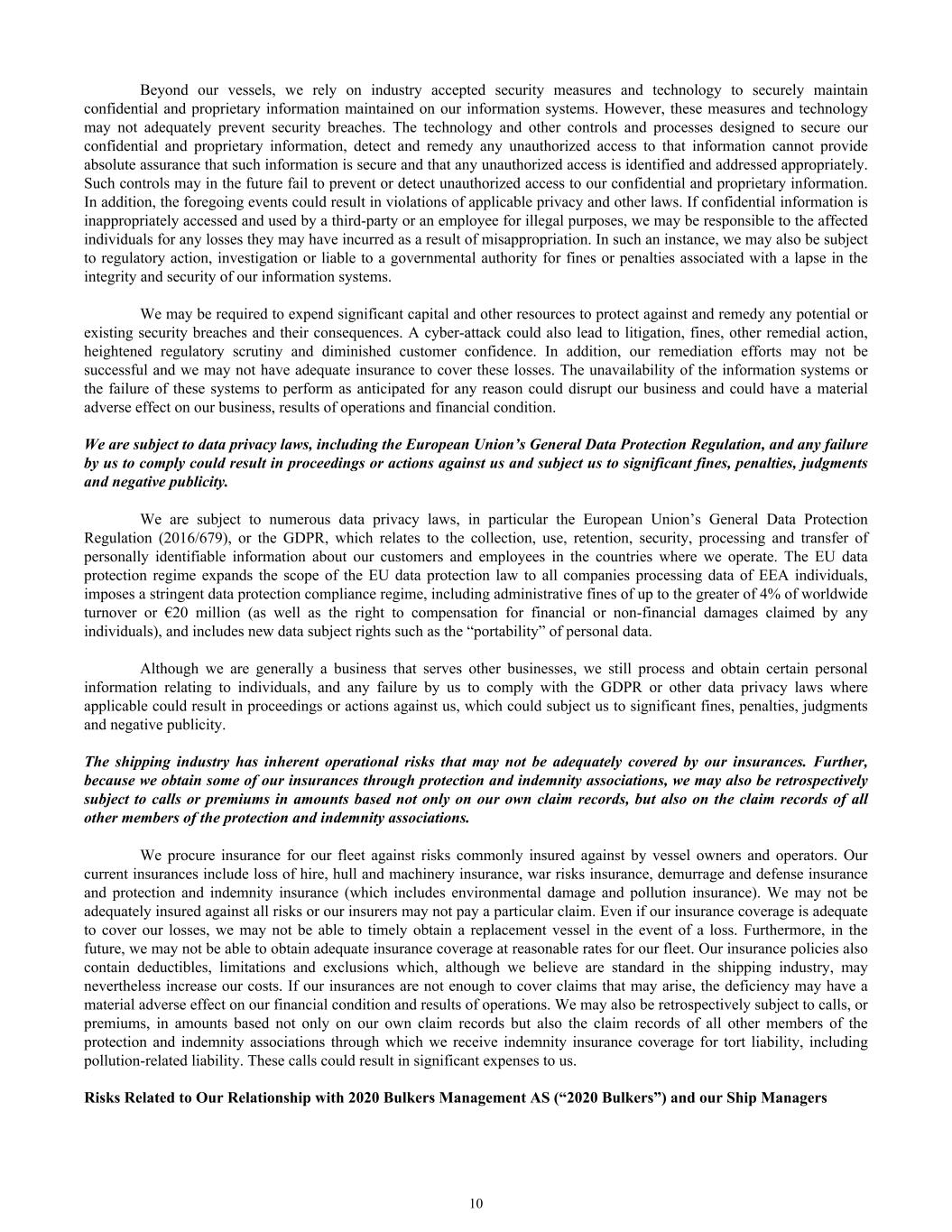
Beyond our vessels, we rely on industry accepted security measures and technology to securely maintain confidential and proprietary information maintained on our information systems. However, these measures and technology may not adequately prevent security breaches. The technology and other controls and processes designed to secure our confidential and proprietary information, detect and remedy any unauthorized access to that information cannot provide absolute assurance that such information is secure and that any unauthorized access is identified and addressed appropriately. Such controls may in the future fail to prevent or detect unauthorized access to our confidential and proprietary information. In addition, the foregoing events could result in violations of applicable privacy and other laws. If confidential information is inappropriately accessed and used by a third-party or an employee for illegal purposes, we may be responsible to the affected individuals for any losses they may have incurred as a result of misappropriation. In such an instance, we may also be subject to regulatory action, investigation or liable to a governmental authority for fines or penalties associated with a lapse in the integrity and security of our information systems. We may be required to expend significant capital and other resources to protect against and remedy any potential or existing security breaches and their consequences. A cyber-attack could also lead to litigation, fines, other remedial action, heightened regulatory scrutiny and diminished customer confidence. In addition, our remediation efforts may not be successful and we may not have adequate insurance to cover these losses. The unavailability of the information systems or the failure of these systems to perform as anticipated for any reason could disrupt our business and could have a material adverse effect on our business, results of operations and financial condition. We are subject to data privacy laws, including the European Union’s General Data Protection Regulation, and any failure by us to comply could result in proceedings or actions against us and subject us to significant fines, penalties, judgments and negative publicity. We are subject to numerous data privacy laws, in particular the European Union’s General Data Protection Regulation (2016/679), or the GDPR, which relates to the collection, use, retention, security, processing and transfer of personally identifiable information about our customers and employees in the countries where we operate. The EU data protection regime expands the scope of the EU data protection law to all companies processing data of EEA individuals, imposes a stringent data protection compliance regime, including administrative fines of up to the greater of 4% of worldwide turnover or €20 million (as well as the right to compensation for financial or non-financial damages claimed by any individuals), and includes new data subject rights such as the “portability” of personal data. Although we are generally a business that serves other businesses, we still process and obtain certain personal information relating to individuals, and any failure by us to comply with the GDPR or other data privacy laws where applicable could result in proceedings or actions against us, which could subject us to significant fines, penalties, judgments and negative publicity. The shipping industry has inherent operational risks that may not be adequately covered by our insurances. Further, because we obtain some of our insurances through protection and indemnity associations, we may also be retrospectively subject to calls or premiums in amounts based not only on our own claim records, but also on the claim records of all other members of the protection and indemnity associations. We procure insurance for our fleet against risks commonly insured against by vessel owners and operators. Our current insurances include loss of hire, hull and machinery insurance, war risks insurance, demurrage and defense insurance and protection and indemnity insurance (which includes environmental damage and pollution insurance). We may not be adequately insured against all risks or our insurers may not pay a particular claim. Even if our insurance coverage is adequate to cover our losses, we may not be able to timely obtain a replacement vessel in the event of a loss. Furthermore, in the future, we may not be able to obtain adequate insurance coverage at reasonable rates for our fleet. Our insurance policies also contain deductibles, limitations and exclusions which, although we believe are standard in the shipping industry, may nevertheless increase our costs. If our insurances are not enough to cover claims that may arise, the deficiency may have a material adverse effect on our financial condition and results of operations. We may also be retrospectively subject to calls, or premiums, in amounts based not only on our own claim records but also the claim records of all other members of the protection and indemnity associations through which we receive indemnity insurance coverage for tort liability, including pollution-related liability. These calls could result in significant expenses to us. Risks Related to Our Relationship with 2020 Bulkers Management AS (“2020 Bulkers”) and our Ship Managers 10
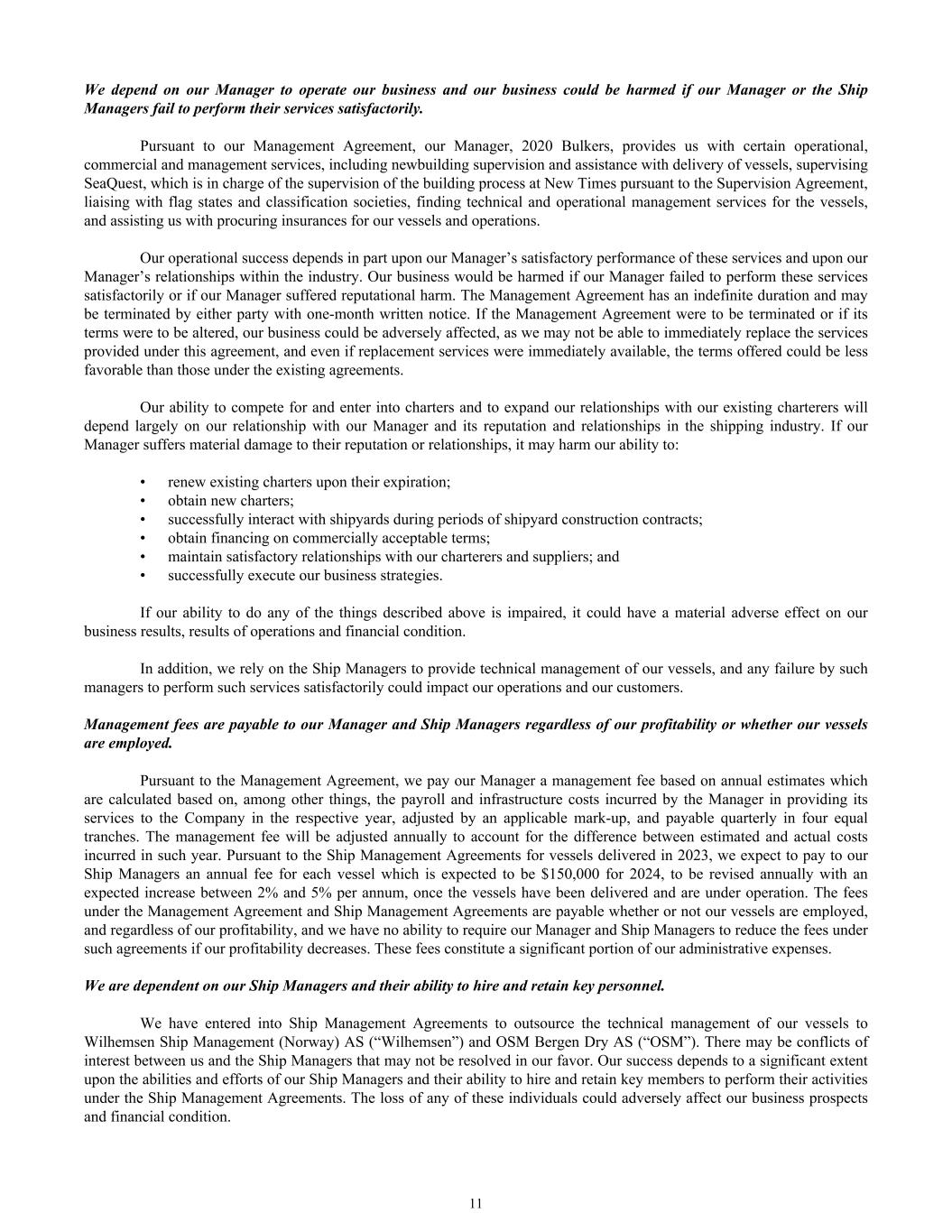
We depend on our Manager to operate our business and our business could be harmed if our Manager or the Ship Managers fail to perform their services satisfactorily. Pursuant to our Management Agreement, our Manager, 2020 Bulkers, provides us with certain operational, commercial and management services, including newbuilding supervision and assistance with delivery of vessels, supervising SeaQuest, which is in charge of the supervision of the building process at New Times pursuant to the Supervision Agreement, liaising with flag states and classification societies, finding technical and operational management services for the vessels, and assisting us with procuring insurances for our vessels and operations. Our operational success depends in part upon our Manager’s satisfactory performance of these services and upon our Manager’s relationships within the industry. Our business would be harmed if our Manager failed to perform these services satisfactorily or if our Manager suffered reputational harm. The Management Agreement has an indefinite duration and may be terminated by either party with one-month written notice. If the Management Agreement were to be terminated or if its terms were to be altered, our business could be adversely affected, as we may not be able to immediately replace the services provided under this agreement, and even if replacement services were immediately available, the terms offered could be less favorable than those under the existing agreements. Our ability to compete for and enter into charters and to expand our relationships with our existing charterers will depend largely on our relationship with our Manager and its reputation and relationships in the shipping industry. If our Manager suffers material damage to their reputation or relationships, it may harm our ability to: • renew existing charters upon their expiration; • obtain new charters; • successfully interact with shipyards during periods of shipyard construction contracts; • obtain financing on commercially acceptable terms; • maintain satisfactory relationships with our charterers and suppliers; and • successfully execute our business strategies. If our ability to do any of the things described above is impaired, it could have a material adverse effect on our business results, results of operations and financial condition. In addition, we rely on the Ship Managers to provide technical management of our vessels, and any failure by such managers to perform such services satisfactorily could impact our operations and our customers. Management fees are payable to our Manager and Ship Managers regardless of our profitability or whether our vessels are employed. Pursuant to the Management Agreement, we pay our Manager a management fee based on annual estimates which are calculated based on, among other things, the payroll and infrastructure costs incurred by the Manager in providing its services to the Company in the respective year, adjusted by an applicable mark-up, and payable quarterly in four equal tranches. The management fee will be adjusted annually to account for the difference between estimated and actual costs incurred in such year. Pursuant to the Ship Management Agreements for vessels delivered in 2023, we expect to pay to our Ship Managers an annual fee for each vessel which is expected to be $150,000 for 2024, to be revised annually with an expected increase between 2% and 5% per annum, once the vessels have been delivered and are under operation. The fees under the Management Agreement and Ship Management Agreements are payable whether or not our vessels are employed, and regardless of our profitability, and we have no ability to require our Manager and Ship Managers to reduce the fees under such agreements if our profitability decreases. These fees constitute a significant portion of our administrative expenses. We are dependent on our Ship Managers and their ability to hire and retain key personnel. We have entered into Ship Management Agreements to outsource the technical management of our vessels to Wilhemsen Ship Management (Norway) AS (“Wilhemsen”) and OSM Bergen Dry AS (“OSM”). There may be conflicts of interest between us and the Ship Managers that may not be resolved in our favor. Our success depends to a significant extent upon the abilities and efforts of our Ship Managers and their ability to hire and retain key members to perform their activities under the Ship Management Agreements. The loss of any of these individuals could adversely affect our business prospects and financial condition. 11
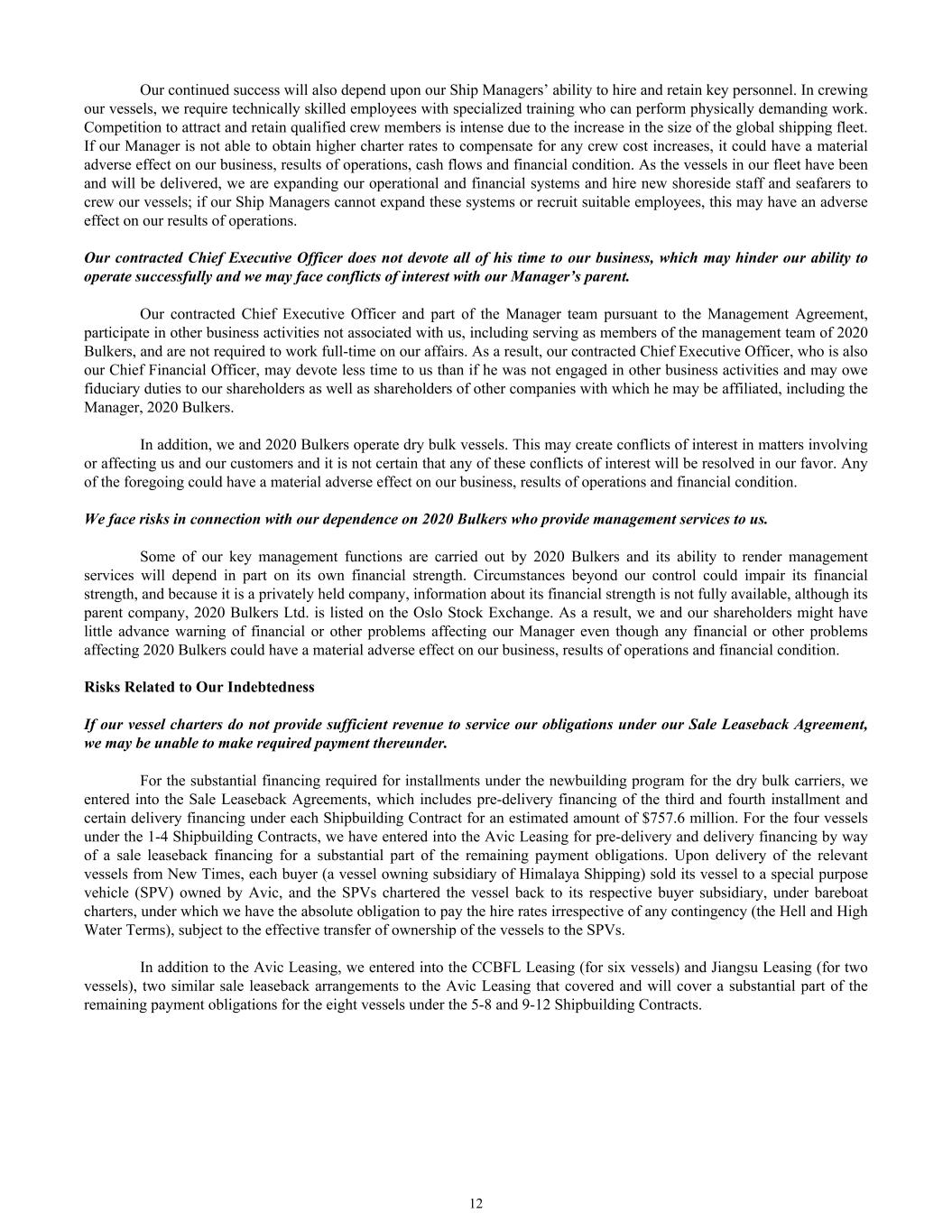
Our continued success will also depend upon our Ship Managers’ ability to hire and retain key personnel. In crewing our vessels, we require technically skilled employees with specialized training who can perform physically demanding work. Competition to attract and retain qualified crew members is intense due to the increase in the size of the global shipping fleet. If our Manager is not able to obtain higher charter rates to compensate for any crew cost increases, it could have a material adverse effect on our business, results of operations, cash flows and financial condition. As the vessels in our fleet have been and will be delivered, we are expanding our operational and financial systems and hire new shoreside staff and seafarers to crew our vessels; if our Ship Managers cannot expand these systems or recruit suitable employees, this may have an adverse effect on our results of operations. Our contracted Chief Executive Officer does not devote all of his time to our business, which may hinder our ability to operate successfully and we may face conflicts of interest with our Manager’s parent. Our contracted Chief Executive Officer and part of the Manager team pursuant to the Management Agreement, participate in other business activities not associated with us, including serving as members of the management team of 2020 Bulkers, and are not required to work full-time on our affairs. As a result, our contracted Chief Executive Officer, who is also our Chief Financial Officer, may devote less time to us than if he was not engaged in other business activities and may owe fiduciary duties to our shareholders as well as shareholders of other companies with which he may be affiliated, including the Manager, 2020 Bulkers. In addition, we and 2020 Bulkers operate dry bulk vessels. This may create conflicts of interest in matters involving or affecting us and our customers and it is not certain that any of these conflicts of interest will be resolved in our favor. Any of the foregoing could have a material adverse effect on our business, results of operations and financial condition. We face risks in connection with our dependence on 2020 Bulkers who provide management services to us. Some of our key management functions are carried out by 2020 Bulkers and its ability to render management services will depend in part on its own financial strength. Circumstances beyond our control could impair its financial strength, and because it is a privately held company, information about its financial strength is not fully available, although its parent company, 2020 Bulkers Ltd. is listed on the Oslo Stock Exchange. As a result, we and our shareholders might have little advance warning of financial or other problems affecting our Manager even though any financial or other problems affecting 2020 Bulkers could have a material adverse effect on our business, results of operations and financial condition. Risks Related to Our Indebtedness If our vessel charters do not provide sufficient revenue to service our obligations under our Sale Leaseback Agreement, we may be unable to make required payment thereunder. For the substantial financing required for installments under the newbuilding program for the dry bulk carriers, we entered into the Sale Leaseback Agreements, which includes pre-delivery financing of the third and fourth installment and certain delivery financing under each Shipbuilding Contract for an estimated amount of $757.6 million. For the four vessels under the 1-4 Shipbuilding Contracts, we have entered into the Avic Leasing for pre-delivery and delivery financing by way of a sale leaseback financing for a substantial part of the remaining payment obligations. Upon delivery of the relevant vessels from New Times, each buyer (a vessel owning subsidiary of Himalaya Shipping) sold its vessel to a special purpose vehicle (SPV) owned by Avic, and the SPVs chartered the vessel back to its respective buyer subsidiary, under bareboat charters, under which we have the absolute obligation to pay the hire rates irrespective of any contingency (the Hell and High Water Terms), subject to the effective transfer of ownership of the vessels to the SPVs. In addition to the Avic Leasing, we entered into the CCBFL Leasing (for six vessels) and Jiangsu Leasing (for two vessels), two similar sale leaseback arrangements to the Avic Leasing that covered and will cover a substantial part of the remaining payment obligations for the eight vessels under the 5-8 and 9-12 Shipbuilding Contracts. 12
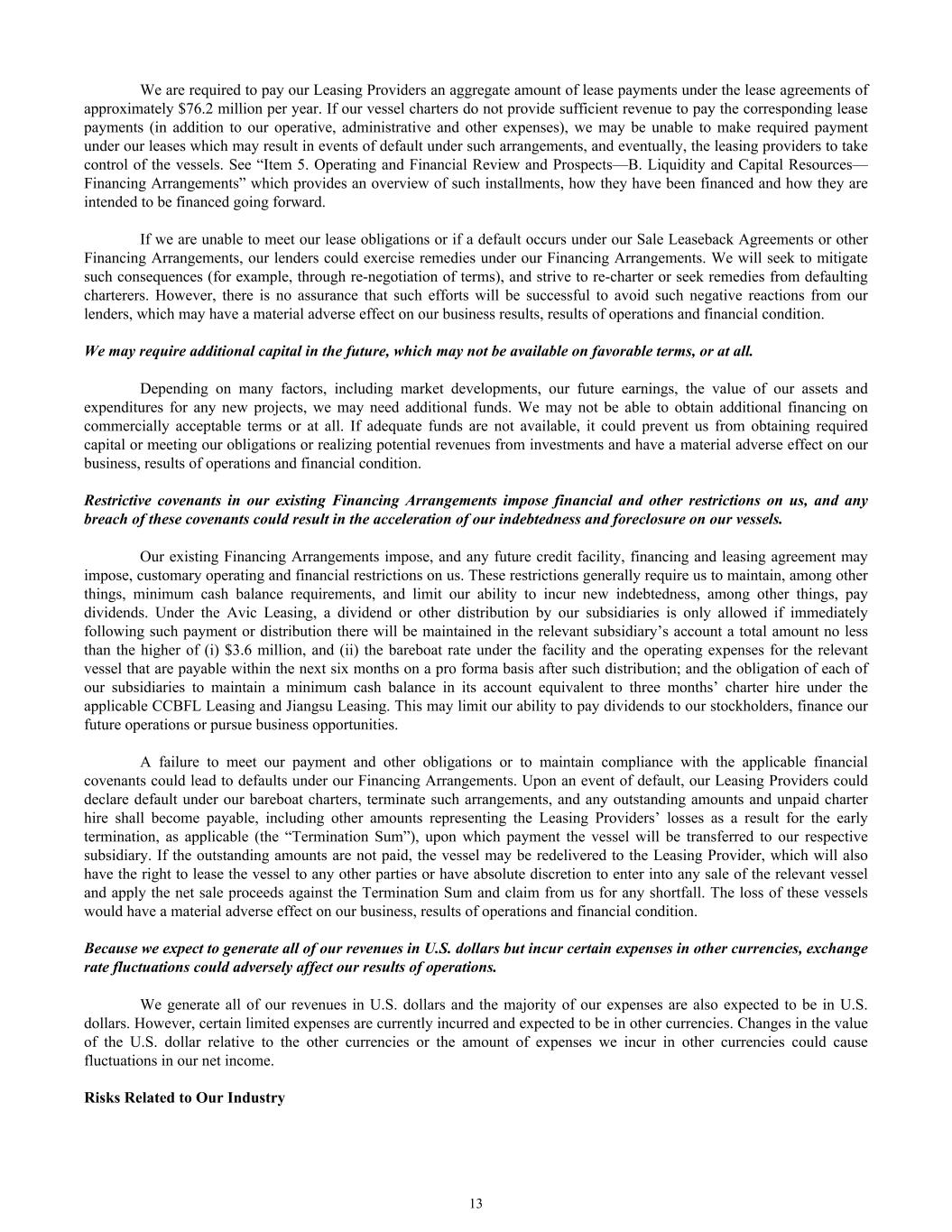
We are required to pay our Leasing Providers an aggregate amount of lease payments under the lease agreements of approximately $76.2 million per year. If our vessel charters do not provide sufficient revenue to pay the corresponding lease payments (in addition to our operative, administrative and other expenses), we may be unable to make required payment under our leases which may result in events of default under such arrangements, and eventually, the leasing providers to take control of the vessels. See “Item 5. Operating and Financial Review and Prospects—B. Liquidity and Capital Resources— Financing Arrangements” which provides an overview of such installments, how they have been financed and how they are intended to be financed going forward. If we are unable to meet our lease obligations or if a default occurs under our Sale Leaseback Agreements or other Financing Arrangements, our lenders could exercise remedies under our Financing Arrangements. We will seek to mitigate such consequences (for example, through re-negotiation of terms), and strive to re-charter or seek remedies from defaulting charterers. However, there is no assurance that such efforts will be successful to avoid such negative reactions from our lenders, which may have a material adverse effect on our business results, results of operations and financial condition. We may require additional capital in the future, which may not be available on favorable terms, or at all. Depending on many factors, including market developments, our future earnings, the value of our assets and expenditures for any new projects, we may need additional funds. We may not be able to obtain additional financing on commercially acceptable terms or at all. If adequate funds are not available, it could prevent us from obtaining required capital or meeting our obligations or realizing potential revenues from investments and have a material adverse effect on our business, results of operations and financial condition. Restrictive covenants in our existing Financing Arrangements impose financial and other restrictions on us, and any breach of these covenants could result in the acceleration of our indebtedness and foreclosure on our vessels. Our existing Financing Arrangements impose, and any future credit facility, financing and leasing agreement may impose, customary operating and financial restrictions on us. These restrictions generally require us to maintain, among other things, minimum cash balance requirements, and limit our ability to incur new indebtedness, among other things, pay dividends. Under the Avic Leasing, a dividend or other distribution by our subsidiaries is only allowed if immediately following such payment or distribution there will be maintained in the relevant subsidiary’s account a total amount no less than the higher of (i) $3.6 million, and (ii) the bareboat rate under the facility and the operating expenses for the relevant vessel that are payable within the next six months on a pro forma basis after such distribution; and the obligation of each of our subsidiaries to maintain a minimum cash balance in its account equivalent to three months’ charter hire under the applicable CCBFL Leasing and Jiangsu Leasing. This may limit our ability to pay dividends to our stockholders, finance our future operations or pursue business opportunities. A failure to meet our payment and other obligations or to maintain compliance with the applicable financial covenants could lead to defaults under our Financing Arrangements. Upon an event of default, our Leasing Providers could declare default under our bareboat charters, terminate such arrangements, and any outstanding amounts and unpaid charter hire shall become payable, including other amounts representing the Leasing Providers’ losses as a result for the early termination, as applicable (the “Termination Sum”), upon which payment the vessel will be transferred to our respective subsidiary. If the outstanding amounts are not paid, the vessel may be redelivered to the Leasing Provider, which will also have the right to lease the vessel to any other parties or have absolute discretion to enter into any sale of the relevant vessel and apply the net sale proceeds against the Termination Sum and claim from us for any shortfall. The loss of these vessels would have a material adverse effect on our business, results of operations and financial condition. Because we expect to generate all of our revenues in U.S. dollars but incur certain expenses in other currencies, exchange rate fluctuations could adversely affect our results of operations. We generate all of our revenues in U.S. dollars and the majority of our expenses are also expected to be in U.S. dollars. However, certain limited expenses are currently incurred and expected to be in other currencies. Changes in the value of the U.S. dollar relative to the other currencies or the amount of expenses we incur in other currencies could cause fluctuations in our net income. Risks Related to Our Industry 13
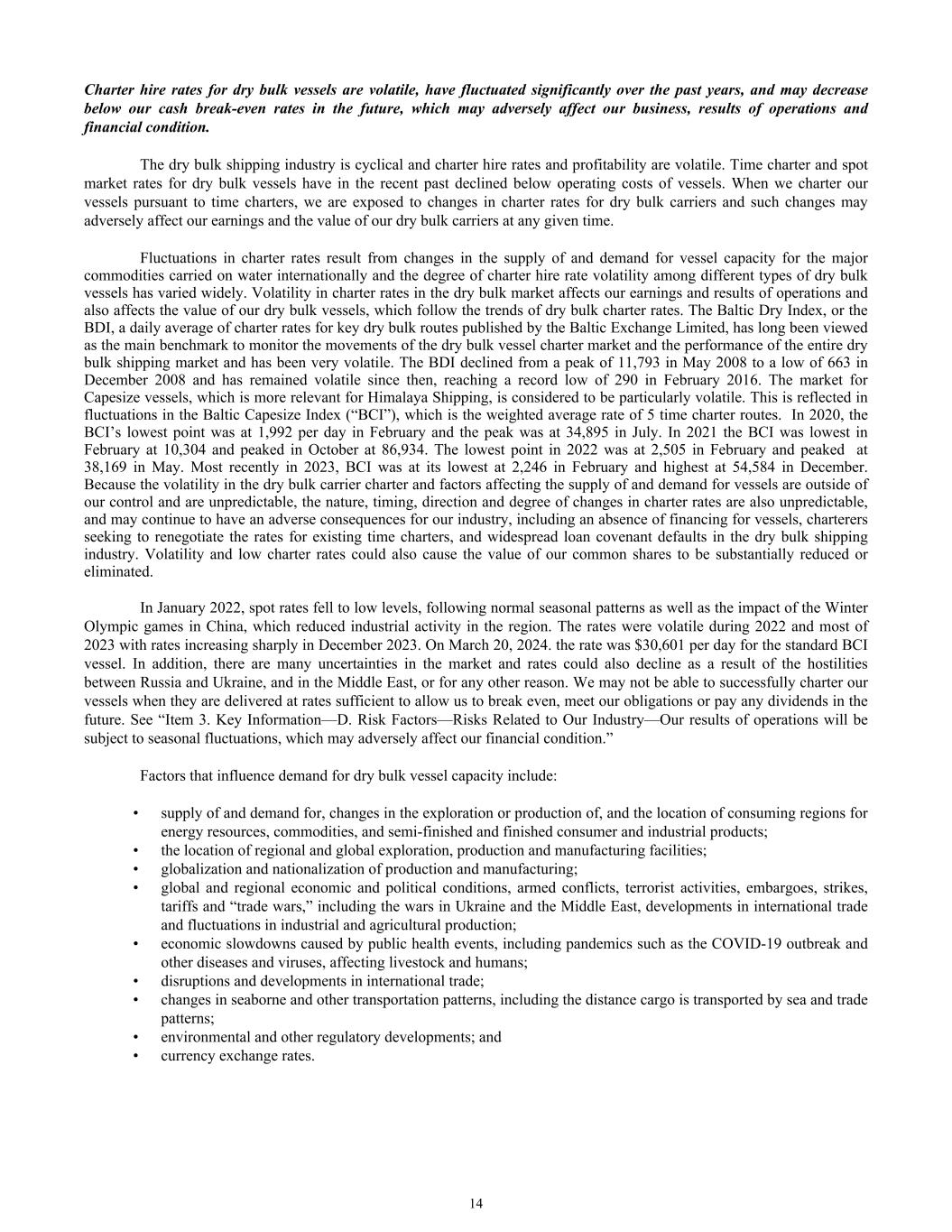
Charter hire rates for dry bulk vessels are volatile, have fluctuated significantly over the past years, and may decrease below our cash break-even rates in the future, which may adversely affect our business, results of operations and financial condition. The dry bulk shipping industry is cyclical and charter hire rates and profitability are volatile. Time charter and spot market rates for dry bulk vessels have in the recent past declined below operating costs of vessels. When we charter our vessels pursuant to time charters, we are exposed to changes in charter rates for dry bulk carriers and such changes may adversely affect our earnings and the value of our dry bulk carriers at any given time. Fluctuations in charter rates result from changes in the supply of and demand for vessel capacity for the major commodities carried on water internationally and the degree of charter hire rate volatility among different types of dry bulk vessels has varied widely. Volatility in charter rates in the dry bulk market affects our earnings and results of operations and also affects the value of our dry bulk vessels, which follow the trends of dry bulk charter rates. The Baltic Dry Index, or the BDI, a daily average of charter rates for key dry bulk routes published by the Baltic Exchange Limited, has long been viewed as the main benchmark to monitor the movements of the dry bulk vessel charter market and the performance of the entire dry bulk shipping market and has been very volatile. The BDI declined from a peak of 11,793 in May 2008 to a low of 663 in December 2008 and has remained volatile since then, reaching a record low of 290 in February 2016. The market for Capesize vessels, which is more relevant for Himalaya Shipping, is considered to be particularly volatile. This is reflected in fluctuations in the Baltic Capesize Index (“BCI”), which is the weighted average rate of 5 time charter routes. In 2020, the BCI’s lowest point was at 1,992 per day in February and the peak was at 34,895 in July. In 2021 the BCI was lowest in February at 10,304 and peaked in October at 86,934. The lowest point in 2022 was at 2,505 in February and peaked at 38,169 in May. Most recently in 2023, BCI was at its lowest at 2,246 in February and highest at 54,584 in December. Because the volatility in the dry bulk carrier charter and factors affecting the supply of and demand for vessels are outside of our control and are unpredictable, the nature, timing, direction and degree of changes in charter rates are also unpredictable, and may continue to have an adverse consequences for our industry, including an absence of financing for vessels, charterers seeking to renegotiate the rates for existing time charters, and widespread loan covenant defaults in the dry bulk shipping industry. Volatility and low charter rates could also cause the value of our common shares to be substantially reduced or eliminated. In January 2022, spot rates fell to low levels, following normal seasonal patterns as well as the impact of the Winter Olympic games in China, which reduced industrial activity in the region. The rates were volatile during 2022 and most of 2023 with rates increasing sharply in December 2023. On March 20, 2024. the rate was $30,601 per day for the standard BCI vessel. In addition, there are many uncertainties in the market and rates could also decline as a result of the hostilities between Russia and Ukraine, and in the Middle East, or for any other reason. We may not be able to successfully charter our vessels when they are delivered at rates sufficient to allow us to break even, meet our obligations or pay any dividends in the future. See “Item 3. Key Information—D. Risk Factors—Risks Related to Our Industry—Our results of operations will be subject to seasonal fluctuations, which may adversely affect our financial condition.” Factors that influence demand for dry bulk vessel capacity include: • supply of and demand for, changes in the exploration or production of, and the location of consuming regions for energy resources, commodities, and semi-finished and finished consumer and industrial products; • the location of regional and global exploration, production and manufacturing facilities; • globalization and nationalization of production and manufacturing; • global and regional economic and political conditions, armed conflicts, terrorist activities, embargoes, strikes, tariffs and “trade wars,” including the wars in Ukraine and the Middle East, developments in international trade and fluctuations in industrial and agricultural production; • economic slowdowns caused by public health events, including pandemics such as the COVID-19 outbreak and other diseases and viruses, affecting livestock and humans; • disruptions and developments in international trade; • changes in seaborne and other transportation patterns, including the distance cargo is transported by sea and trade patterns; • environmental and other regulatory developments; and • currency exchange rates. 14
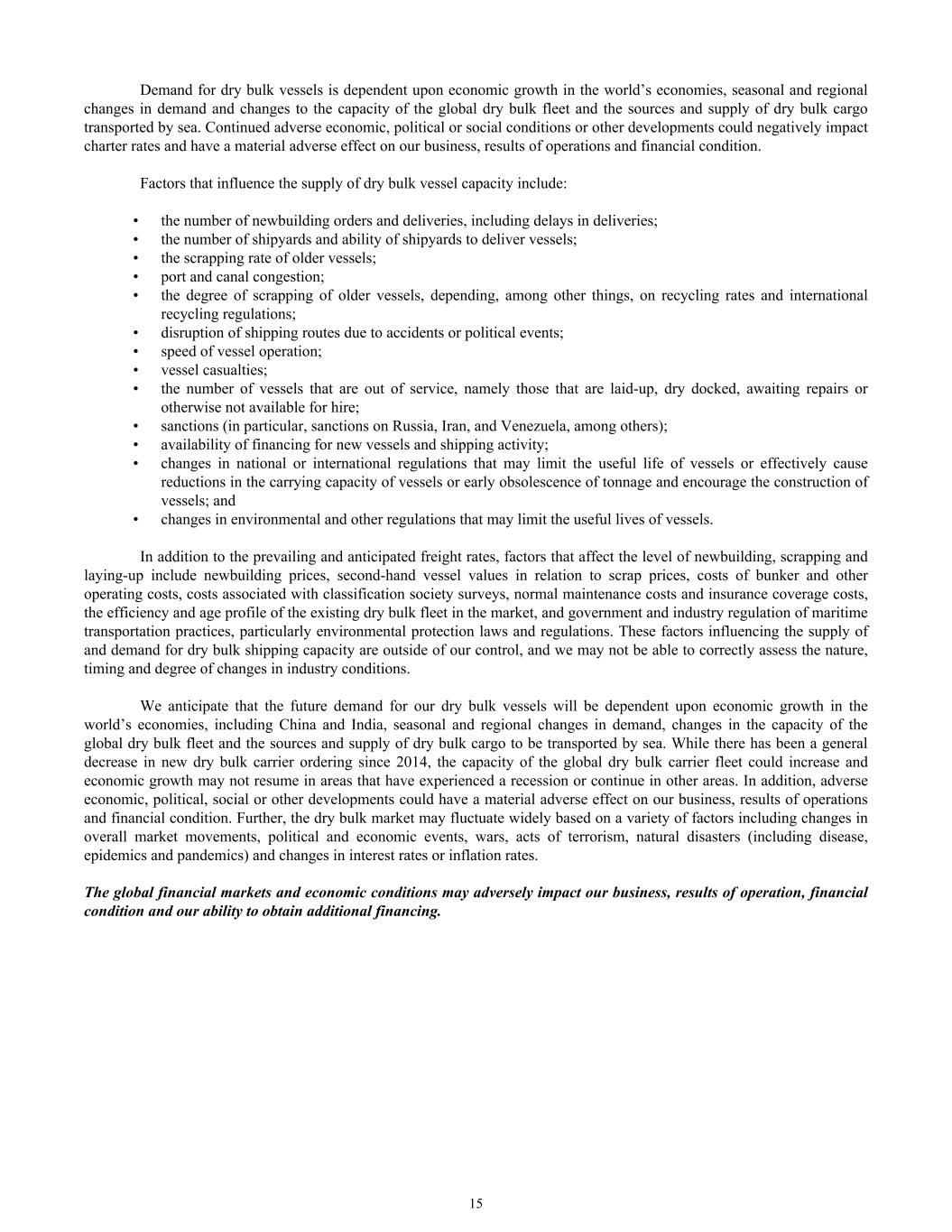
Demand for dry bulk vessels is dependent upon economic growth in the world’s economies, seasonal and regional changes in demand and changes to the capacity of the global dry bulk fleet and the sources and supply of dry bulk cargo transported by sea. Continued adverse economic, political or social conditions or other developments could negatively impact charter rates and have a material adverse effect on our business, results of operations and financial condition. Factors that influence the supply of dry bulk vessel capacity include: • the number of newbuilding orders and deliveries, including delays in deliveries; • the number of shipyards and ability of shipyards to deliver vessels; • the scrapping rate of older vessels; • port and canal congestion; • the degree of scrapping of older vessels, depending, among other things, on recycling rates and international recycling regulations; • disruption of shipping routes due to accidents or political events; • speed of vessel operation; • vessel casualties; • the number of vessels that are out of service, namely those that are laid-up, dry docked, awaiting repairs or otherwise not available for hire; • sanctions (in particular, sanctions on Russia, Iran, and Venezuela, among others); • availability of financing for new vessels and shipping activity; • changes in national or international regulations that may limit the useful life of vessels or effectively cause reductions in the carrying capacity of vessels or early obsolescence of tonnage and encourage the construction of vessels; and • changes in environmental and other regulations that may limit the useful lives of vessels. In addition to the prevailing and anticipated freight rates, factors that affect the level of newbuilding, scrapping and laying-up include newbuilding prices, second-hand vessel values in relation to scrap prices, costs of bunker and other operating costs, costs associated with classification society surveys, normal maintenance costs and insurance coverage costs, the efficiency and age profile of the existing dry bulk fleet in the market, and government and industry regulation of maritime transportation practices, particularly environmental protection laws and regulations. These factors influencing the supply of and demand for dry bulk shipping capacity are outside of our control, and we may not be able to correctly assess the nature, timing and degree of changes in industry conditions. We anticipate that the future demand for our dry bulk vessels will be dependent upon economic growth in the world’s economies, including China and India, seasonal and regional changes in demand, changes in the capacity of the global dry bulk fleet and the sources and supply of dry bulk cargo to be transported by sea. While there has been a general decrease in new dry bulk carrier ordering since 2014, the capacity of the global dry bulk carrier fleet could increase and economic growth may not resume in areas that have experienced a recession or continue in other areas. In addition, adverse economic, political, social or other developments could have a material adverse effect on our business, results of operations and financial condition. Further, the dry bulk market may fluctuate widely based on a variety of factors including changes in overall market movements, political and economic events, wars, acts of terrorism, natural disasters (including disease, epidemics and pandemics) and changes in interest rates or inflation rates. The global financial markets and economic conditions may adversely impact our business, results of operation, financial condition and our ability to obtain additional financing. 15
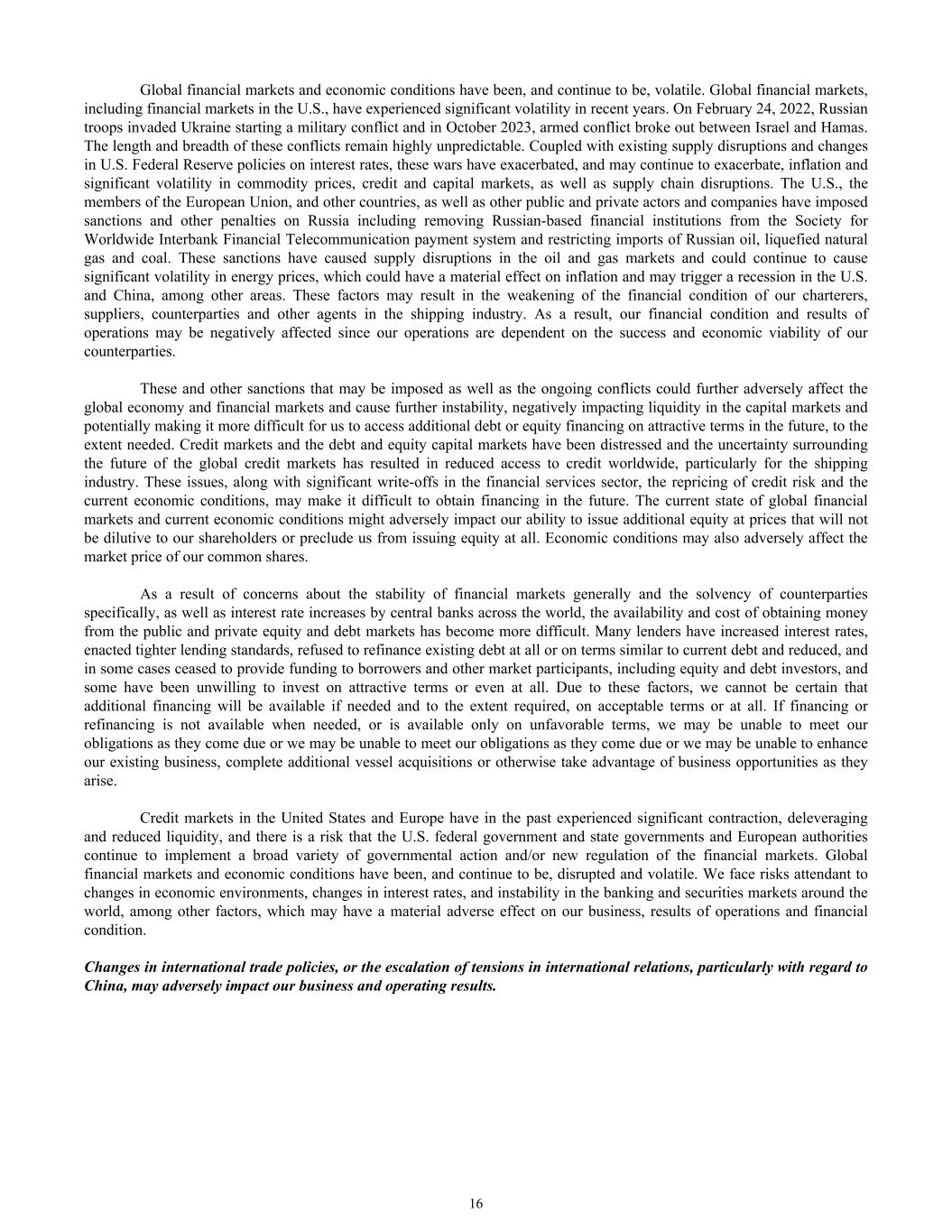
Global financial markets and economic conditions have been, and continue to be, volatile. Global financial markets, including financial markets in the U.S., have experienced significant volatility in recent years. On February 24, 2022, Russian troops invaded Ukraine starting a military conflict and in October 2023, armed conflict broke out between Israel and Hamas. The length and breadth of these conflicts remain highly unpredictable. Coupled with existing supply disruptions and changes in U.S. Federal Reserve policies on interest rates, these wars have exacerbated, and may continue to exacerbate, inflation and significant volatility in commodity prices, credit and capital markets, as well as supply chain disruptions. The U.S., the members of the European Union, and other countries, as well as other public and private actors and companies have imposed sanctions and other penalties on Russia including removing Russian-based financial institutions from the Society for Worldwide Interbank Financial Telecommunication payment system and restricting imports of Russian oil, liquefied natural gas and coal. These sanctions have caused supply disruptions in the oil and gas markets and could continue to cause significant volatility in energy prices, which could have a material effect on inflation and may trigger a recession in the U.S. and China, among other areas. These factors may result in the weakening of the financial condition of our charterers, suppliers, counterparties and other agents in the shipping industry. As a result, our financial condition and results of operations may be negatively affected since our operations are dependent on the success and economic viability of our counterparties. These and other sanctions that may be imposed as well as the ongoing conflicts could further adversely affect the global economy and financial markets and cause further instability, negatively impacting liquidity in the capital markets and potentially making it more difficult for us to access additional debt or equity financing on attractive terms in the future, to the extent needed. Credit markets and the debt and equity capital markets have been distressed and the uncertainty surrounding the future of the global credit markets has resulted in reduced access to credit worldwide, particularly for the shipping industry. These issues, along with significant write-offs in the financial services sector, the repricing of credit risk and the current economic conditions, may make it difficult to obtain financing in the future. The current state of global financial markets and current economic conditions might adversely impact our ability to issue additional equity at prices that will not be dilutive to our shareholders or preclude us from issuing equity at all. Economic conditions may also adversely affect the market price of our common shares. As a result of concerns about the stability of financial markets generally and the solvency of counterparties specifically, as well as interest rate increases by central banks across the world, the availability and cost of obtaining money from the public and private equity and debt markets has become more difficult. Many lenders have increased interest rates, enacted tighter lending standards, refused to refinance existing debt at all or on terms similar to current debt and reduced, and in some cases ceased to provide funding to borrowers and other market participants, including equity and debt investors, and some have been unwilling to invest on attractive terms or even at all. Due to these factors, we cannot be certain that additional financing will be available if needed and to the extent required, on acceptable terms or at all. If financing or refinancing is not available when needed, or is available only on unfavorable terms, we may be unable to meet our obligations as they come due or we may be unable to meet our obligations as they come due or we may be unable to enhance our existing business, complete additional vessel acquisitions or otherwise take advantage of business opportunities as they arise. Credit markets in the United States and Europe have in the past experienced significant contraction, deleveraging and reduced liquidity, and there is a risk that the U.S. federal government and state governments and European authorities continue to implement a broad variety of governmental action and/or new regulation of the financial markets. Global financial markets and economic conditions have been, and continue to be, disrupted and volatile. We face risks attendant to changes in economic environments, changes in interest rates, and instability in the banking and securities markets around the world, among other factors, which may have a material adverse effect on our business, results of operations and financial condition. Changes in international trade policies, or the escalation of tensions in international relations, particularly with regard to China, may adversely impact our business and operating results. 16
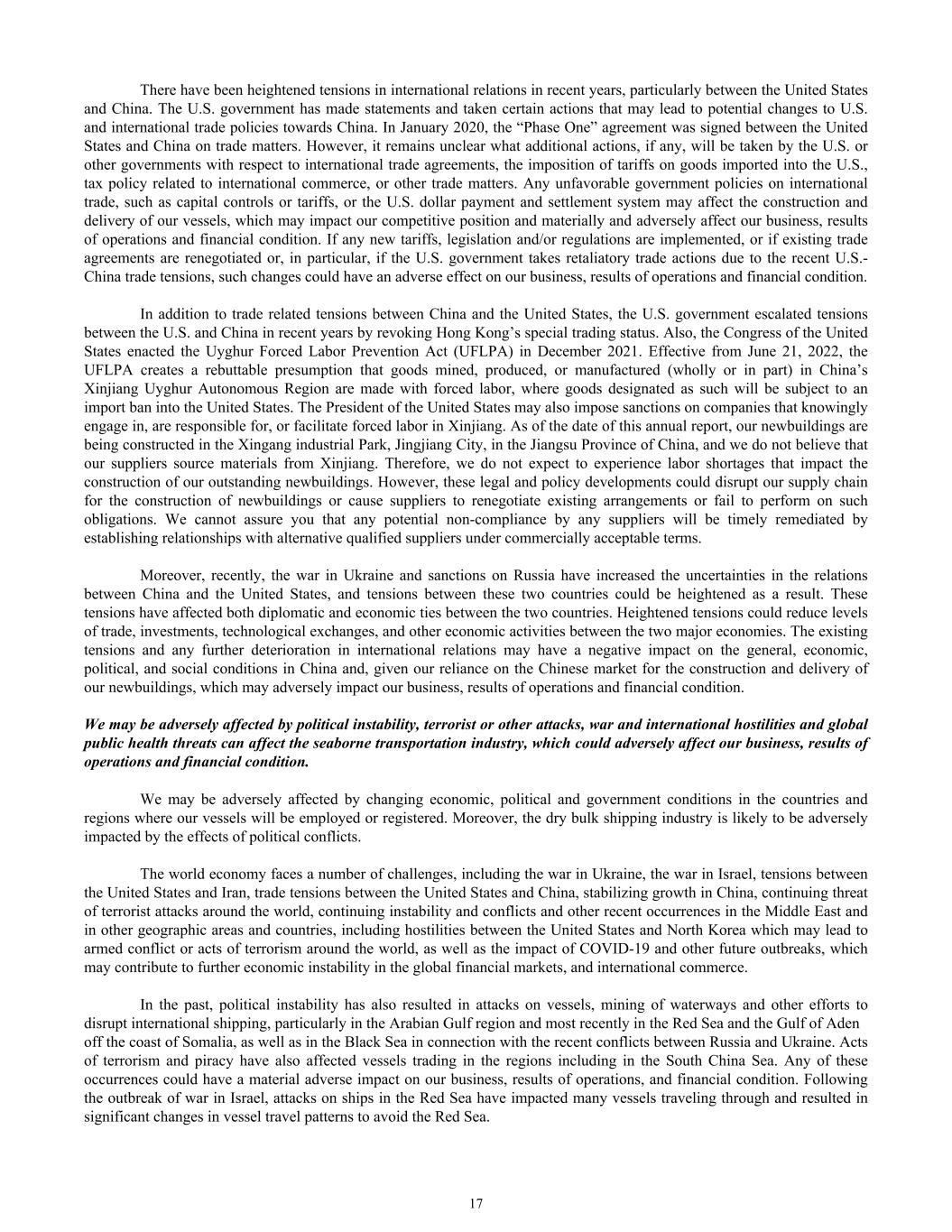
There have been heightened tensions in international relations in recent years, particularly between the United States and China. The U.S. government has made statements and taken certain actions that may lead to potential changes to U.S. and international trade policies towards China. In January 2020, the “Phase One” agreement was signed between the United States and China on trade matters. However, it remains unclear what additional actions, if any, will be taken by the U.S. or other governments with respect to international trade agreements, the imposition of tariffs on goods imported into the U.S., tax policy related to international commerce, or other trade matters. Any unfavorable government policies on international trade, such as capital controls or tariffs, or the U.S. dollar payment and settlement system may affect the construction and delivery of our vessels, which may impact our competitive position and materially and adversely affect our business, results of operations and financial condition. If any new tariffs, legislation and/or regulations are implemented, or if existing trade agreements are renegotiated or, in particular, if the U.S. government takes retaliatory trade actions due to the recent U.S.- China trade tensions, such changes could have an adverse effect on our business, results of operations and financial condition. In addition to trade related tensions between China and the United States, the U.S. government escalated tensions between the U.S. and China in recent years by revoking Hong Kong’s special trading status. Also, the Congress of the United States enacted the Uyghur Forced Labor Prevention Act (UFLPA) in December 2021. Effective from June 21, 2022, the UFLPA creates a rebuttable presumption that goods mined, produced, or manufactured (wholly or in part) in China’s Xinjiang Uyghur Autonomous Region are made with forced labor, where goods designated as such will be subject to an import ban into the United States. The President of the United States may also impose sanctions on companies that knowingly engage in, are responsible for, or facilitate forced labor in Xinjiang. As of the date of this annual report, our newbuildings are being constructed in the Xingang industrial Park, Jingjiang City, in the Jiangsu Province of China, and we do not believe that our suppliers source materials from Xinjiang. Therefore, we do not expect to experience labor shortages that impact the construction of our outstanding newbuildings. However, these legal and policy developments could disrupt our supply chain for the construction of newbuildings or cause suppliers to renegotiate existing arrangements or fail to perform on such obligations. We cannot assure you that any potential non-compliance by any suppliers will be timely remediated by establishing relationships with alternative qualified suppliers under commercially acceptable terms. Moreover, recently, the war in Ukraine and sanctions on Russia have increased the uncertainties in the relations between China and the United States, and tensions between these two countries could be heightened as a result. These tensions have affected both diplomatic and economic ties between the two countries. Heightened tensions could reduce levels of trade, investments, technological exchanges, and other economic activities between the two major economies. The existing tensions and any further deterioration in international relations may have a negative impact on the general, economic, political, and social conditions in China and, given our reliance on the Chinese market for the construction and delivery of our newbuildings, which may adversely impact our business, results of operations and financial condition. We may be adversely affected by political instability, terrorist or other attacks, war and international hostilities and global public health threats can affect the seaborne transportation industry, which could adversely affect our business, results of operations and financial condition. We may be adversely affected by changing economic, political and government conditions in the countries and regions where our vessels will be employed or registered. Moreover, the dry bulk shipping industry is likely to be adversely impacted by the effects of political conflicts. The world economy faces a number of challenges, including the war in Ukraine, the war in Israel, tensions between the United States and Iran, trade tensions between the United States and China, stabilizing growth in China, continuing threat of terrorist attacks around the world, continuing instability and conflicts and other recent occurrences in the Middle East and in other geographic areas and countries, including hostilities between the United States and North Korea which may lead to armed conflict or acts of terrorism around the world, as well as the impact of COVID-19 and other future outbreaks, which may contribute to further economic instability in the global financial markets, and international commerce. In the past, political instability has also resulted in attacks on vessels, mining of waterways and other efforts to disrupt international shipping, particularly in the Arabian Gulf region and most recently in the Red Sea and the Gulf of Aden off the coast of Somalia, as well as in the Black Sea in connection with the recent conflicts between Russia and Ukraine. Acts of terrorism and piracy have also affected vessels trading in the regions including in the South China Sea. Any of these occurrences could have a material adverse impact on our business, results of operations, and financial condition. Following the outbreak of war in Israel, attacks on ships in the Red Sea have impacted many vessels traveling through and resulted in significant changes in vessel travel patterns to avoid the Red Sea. 17
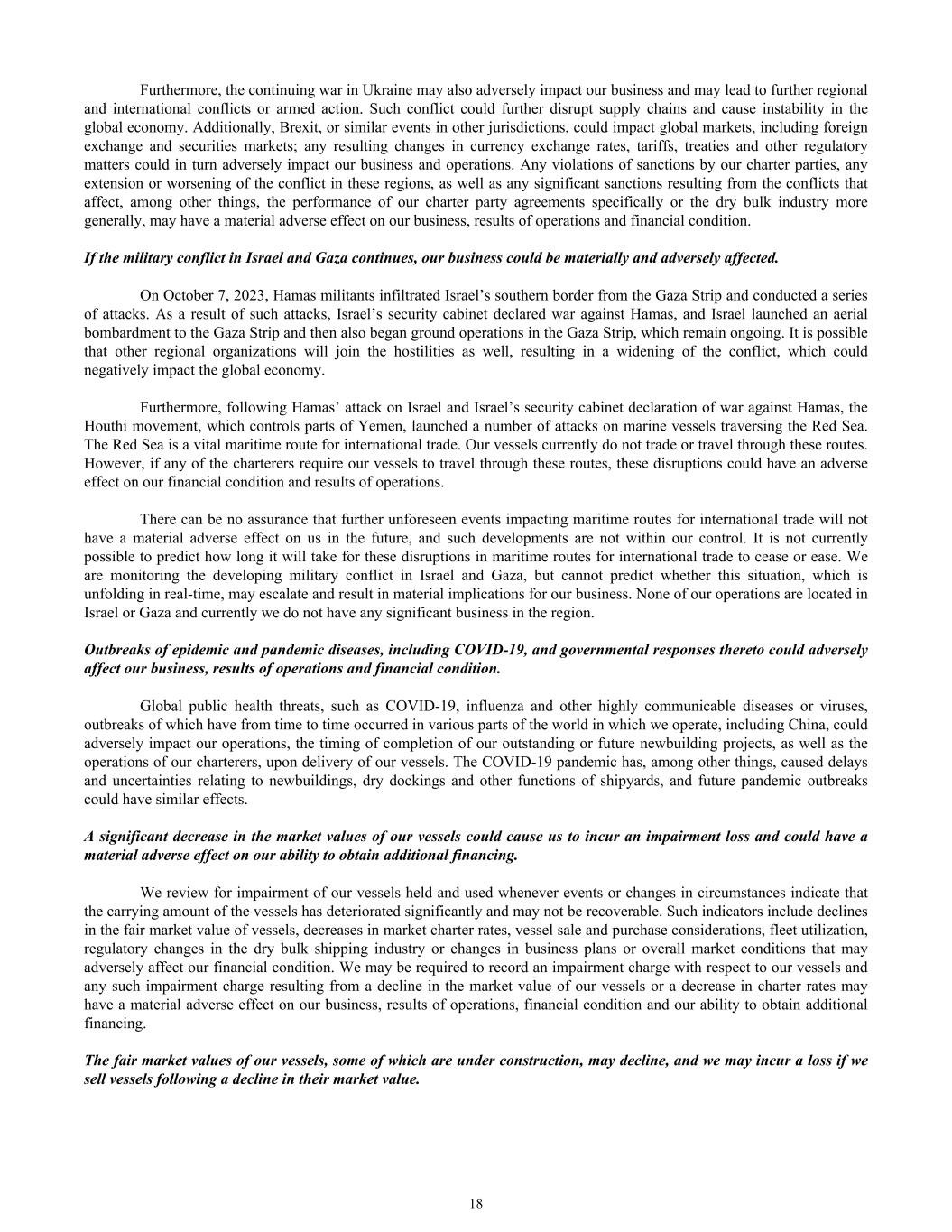
Furthermore, the continuing war in Ukraine may also adversely impact our business and may lead to further regional and international conflicts or armed action. Such conflict could further disrupt supply chains and cause instability in the global economy. Additionally, Brexit, or similar events in other jurisdictions, could impact global markets, including foreign exchange and securities markets; any resulting changes in currency exchange rates, tariffs, treaties and other regulatory matters could in turn adversely impact our business and operations. Any violations of sanctions by our charter parties, any extension or worsening of the conflict in these regions, as well as any significant sanctions resulting from the conflicts that affect, among other things, the performance of our charter party agreements specifically or the dry bulk industry more generally, may have a material adverse effect on our business, results of operations and financial condition. If the military conflict in Israel and Gaza continues, our business could be materially and adversely affected. On October 7, 2023, Hamas militants infiltrated Israel’s southern border from the Gaza Strip and conducted a series of attacks. As a result of such attacks, Israel’s security cabinet declared war against Hamas, and Israel launched an aerial bombardment to the Gaza Strip and then also began ground operations in the Gaza Strip, which remain ongoing. It is possible that other regional organizations will join the hostilities as well, resulting in a widening of the conflict, which could negatively impact the global economy. Furthermore, following Hamas’ attack on Israel and Israel’s security cabinet declaration of war against Hamas, the Houthi movement, which controls parts of Yemen, launched a number of attacks on marine vessels traversing the Red Sea. The Red Sea is a vital maritime route for international trade. Our vessels currently do not trade or travel through these routes. However, if any of the charterers require our vessels to travel through these routes, these disruptions could have an adverse effect on our financial condition and results of operations. There can be no assurance that further unforeseen events impacting maritime routes for international trade will not have a material adverse effect on us in the future, and such developments are not within our control. It is not currently possible to predict how long it will take for these disruptions in maritime routes for international trade to cease or ease. We are monitoring the developing military conflict in Israel and Gaza, but cannot predict whether this situation, which is unfolding in real-time, may escalate and result in material implications for our business. None of our operations are located in Israel or Gaza and currently we do not have any significant business in the region. Outbreaks of epidemic and pandemic diseases, including COVID-19, and governmental responses thereto could adversely affect our business, results of operations and financial condition. Global public health threats, such as COVID-19, influenza and other highly communicable diseases or viruses, outbreaks of which have from time to time occurred in various parts of the world in which we operate, including China, could adversely impact our operations, the timing of completion of our outstanding or future newbuilding projects, as well as the operations of our charterers, upon delivery of our vessels. The COVID-19 pandemic has, among other things, caused delays and uncertainties relating to newbuildings, dry dockings and other functions of shipyards, and future pandemic outbreaks could have similar effects. A significant decrease in the market values of our vessels could cause us to incur an impairment loss and could have a material adverse effect on our ability to obtain additional financing. We review for impairment of our vessels held and used whenever events or changes in circumstances indicate that the carrying amount of the vessels has deteriorated significantly and may not be recoverable. Such indicators include declines in the fair market value of vessels, decreases in market charter rates, vessel sale and purchase considerations, fleet utilization, regulatory changes in the dry bulk shipping industry or changes in business plans or overall market conditions that may adversely affect our financial condition. We may be required to record an impairment charge with respect to our vessels and any such impairment charge resulting from a decline in the market value of our vessels or a decrease in charter rates may have a material adverse effect on our business, results of operations, financial condition and our ability to obtain additional financing. The fair market values of our vessels, some of which are under construction, may decline, and we may incur a loss if we sell vessels following a decline in their market value. 18
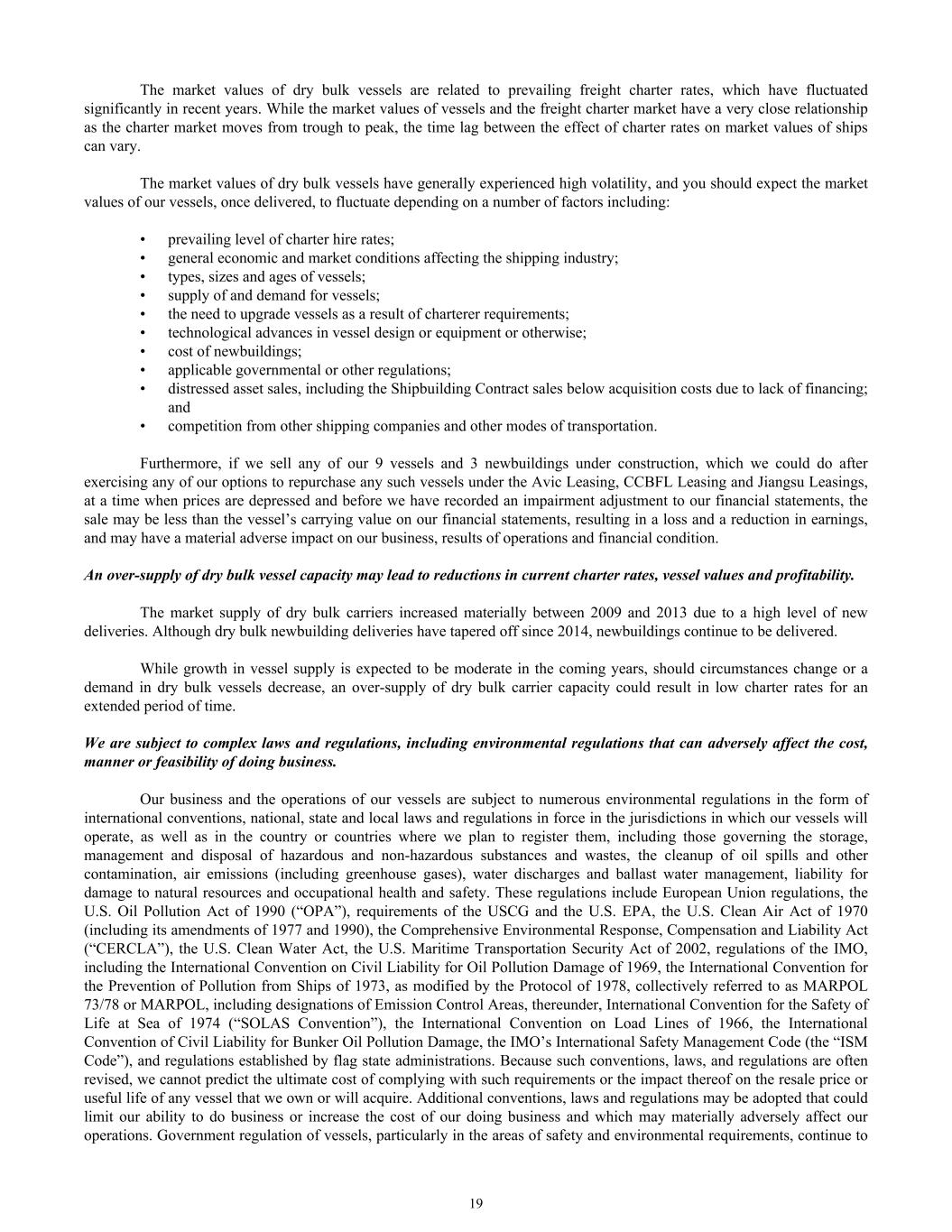
The market values of dry bulk vessels are related to prevailing freight charter rates, which have fluctuated significantly in recent years. While the market values of vessels and the freight charter market have a very close relationship as the charter market moves from trough to peak, the time lag between the effect of charter rates on market values of ships can vary. The market values of dry bulk vessels have generally experienced high volatility, and you should expect the market values of our vessels, once delivered, to fluctuate depending on a number of factors including: • prevailing level of charter hire rates; • general economic and market conditions affecting the shipping industry; • types, sizes and ages of vessels; • supply of and demand for vessels; • the need to upgrade vessels as a result of charterer requirements; • technological advances in vessel design or equipment or otherwise; • cost of newbuildings; • applicable governmental or other regulations; • distressed asset sales, including the Shipbuilding Contract sales below acquisition costs due to lack of financing; and • competition from other shipping companies and other modes of transportation. Furthermore, if we sell any of our 9 vessels and 3 newbuildings under construction, which we could do after exercising any of our options to repurchase any such vessels under the Avic Leasing, CCBFL Leasing and Jiangsu Leasings, at a time when prices are depressed and before we have recorded an impairment adjustment to our financial statements, the sale may be less than the vessel’s carrying value on our financial statements, resulting in a loss and a reduction in earnings, and may have a material adverse impact on our business, results of operations and financial condition. An over-supply of dry bulk vessel capacity may lead to reductions in current charter rates, vessel values and profitability. The market supply of dry bulk carriers increased materially between 2009 and 2013 due to a high level of new deliveries. Although dry bulk newbuilding deliveries have tapered off since 2014, newbuildings continue to be delivered. While growth in vessel supply is expected to be moderate in the coming years, should circumstances change or a demand in dry bulk vessels decrease, an over-supply of dry bulk carrier capacity could result in low charter rates for an extended period of time. We are subject to complex laws and regulations, including environmental regulations that can adversely affect the cost, manner or feasibility of doing business. Our business and the operations of our vessels are subject to numerous environmental regulations in the form of international conventions, national, state and local laws and regulations in force in the jurisdictions in which our vessels will operate, as well as in the country or countries where we plan to register them, including those governing the storage, management and disposal of hazardous and non-hazardous substances and wastes, the cleanup of oil spills and other contamination, air emissions (including greenhouse gases), water discharges and ballast water management, liability for damage to natural resources and occupational health and safety. These regulations include European Union regulations, the U.S. Oil Pollution Act of 1990 (“OPA”), requirements of the USCG and the U.S. EPA, the U.S. Clean Air Act of 1970 (including its amendments of 1977 and 1990), the Comprehensive Environmental Response, Compensation and Liability Act (“CERCLA”), the U.S. Clean Water Act, the U.S. Maritime Transportation Security Act of 2002, regulations of the IMO, including the International Convention on Civil Liability for Oil Pollution Damage of 1969, the International Convention for the Prevention of Pollution from Ships of 1973, as modified by the Protocol of 1978, collectively referred to as MARPOL 73/78 or MARPOL, including designations of Emission Control Areas, thereunder, International Convention for the Safety of Life at Sea of 1974 (“SOLAS Convention”), the International Convention on Load Lines of 1966, the International Convention of Civil Liability for Bunker Oil Pollution Damage, the IMO’s International Safety Management Code (the “ISM Code”), and regulations established by flag state administrations. Because such conventions, laws, and regulations are often revised, we cannot predict the ultimate cost of complying with such requirements or the impact thereof on the resale price or useful life of any vessel that we own or will acquire. Additional conventions, laws and regulations may be adopted that could limit our ability to do business or increase the cost of our doing business and which may materially adversely affect our operations. Government regulation of vessels, particularly in the areas of safety and environmental requirements, continue to 19
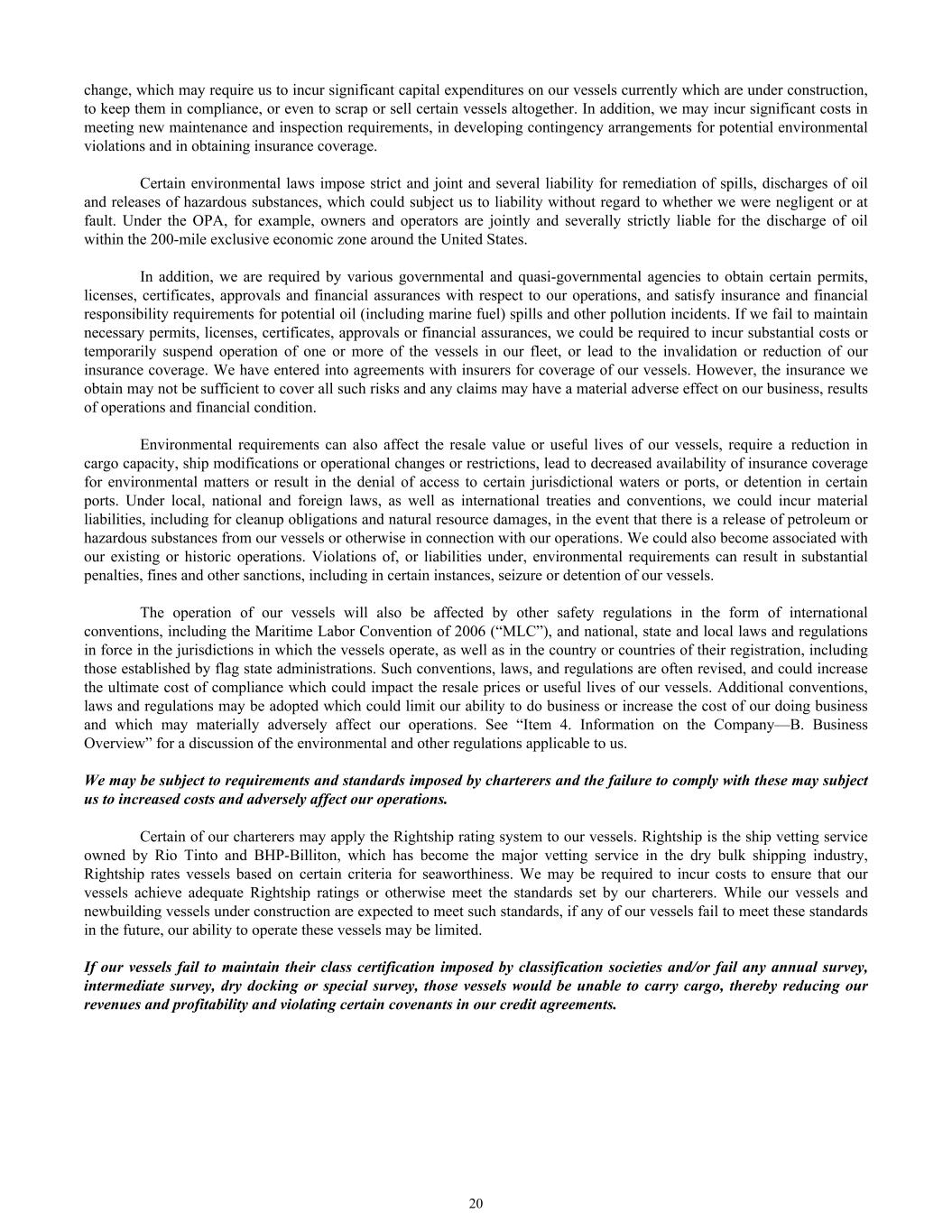
change, which may require us to incur significant capital expenditures on our vessels currently which are under construction, to keep them in compliance, or even to scrap or sell certain vessels altogether. In addition, we may incur significant costs in meeting new maintenance and inspection requirements, in developing contingency arrangements for potential environmental violations and in obtaining insurance coverage. Certain environmental laws impose strict and joint and several liability for remediation of spills, discharges of oil and releases of hazardous substances, which could subject us to liability without regard to whether we were negligent or at fault. Under the OPA, for example, owners and operators are jointly and severally strictly liable for the discharge of oil within the 200-mile exclusive economic zone around the United States. In addition, we are required by various governmental and quasi-governmental agencies to obtain certain permits, licenses, certificates, approvals and financial assurances with respect to our operations, and satisfy insurance and financial responsibility requirements for potential oil (including marine fuel) spills and other pollution incidents. If we fail to maintain necessary permits, licenses, certificates, approvals or financial assurances, we could be required to incur substantial costs or temporarily suspend operation of one or more of the vessels in our fleet, or lead to the invalidation or reduction of our insurance coverage. We have entered into agreements with insurers for coverage of our vessels. However, the insurance we obtain may not be sufficient to cover all such risks and any claims may have a material adverse effect on our business, results of operations and financial condition. Environmental requirements can also affect the resale value or useful lives of our vessels, require a reduction in cargo capacity, ship modifications or operational changes or restrictions, lead to decreased availability of insurance coverage for environmental matters or result in the denial of access to certain jurisdictional waters or ports, or detention in certain ports. Under local, national and foreign laws, as well as international treaties and conventions, we could incur material liabilities, including for cleanup obligations and natural resource damages, in the event that there is a release of petroleum or hazardous substances from our vessels or otherwise in connection with our operations. We could also become associated with our existing or historic operations. Violations of, or liabilities under, environmental requirements can result in substantial penalties, fines and other sanctions, including in certain instances, seizure or detention of our vessels. The operation of our vessels will also be affected by other safety regulations in the form of international conventions, including the Maritime Labor Convention of 2006 (“MLC”), and national, state and local laws and regulations in force in the jurisdictions in which the vessels operate, as well as in the country or countries of their registration, including those established by flag state administrations. Such conventions, laws, and regulations are often revised, and could increase the ultimate cost of compliance which could impact the resale prices or useful lives of our vessels. Additional conventions, laws and regulations may be adopted which could limit our ability to do business or increase the cost of our doing business and which may materially adversely affect our operations. See “Item 4. Information on the Company—B. Business Overview” for a discussion of the environmental and other regulations applicable to us. We may be subject to requirements and standards imposed by charterers and the failure to comply with these may subject us to increased costs and adversely affect our operations. Certain of our charterers may apply the Rightship rating system to our vessels. Rightship is the ship vetting service owned by Rio Tinto and BHP-Billiton, which has become the major vetting service in the dry bulk shipping industry, Rightship rates vessels based on certain criteria for seaworthiness. We may be required to incur costs to ensure that our vessels achieve adequate Rightship ratings or otherwise meet the standards set by our charterers. While our vessels and newbuilding vessels under construction are expected to meet such standards, if any of our vessels fail to meet these standards in the future, our ability to operate these vessels may be limited. If our vessels fail to maintain their class certification imposed by classification societies and/or fail any annual survey, intermediate survey, dry docking or special survey, those vessels would be unable to carry cargo, thereby reducing our revenues and profitability and violating certain covenants in our credit agreements. 20
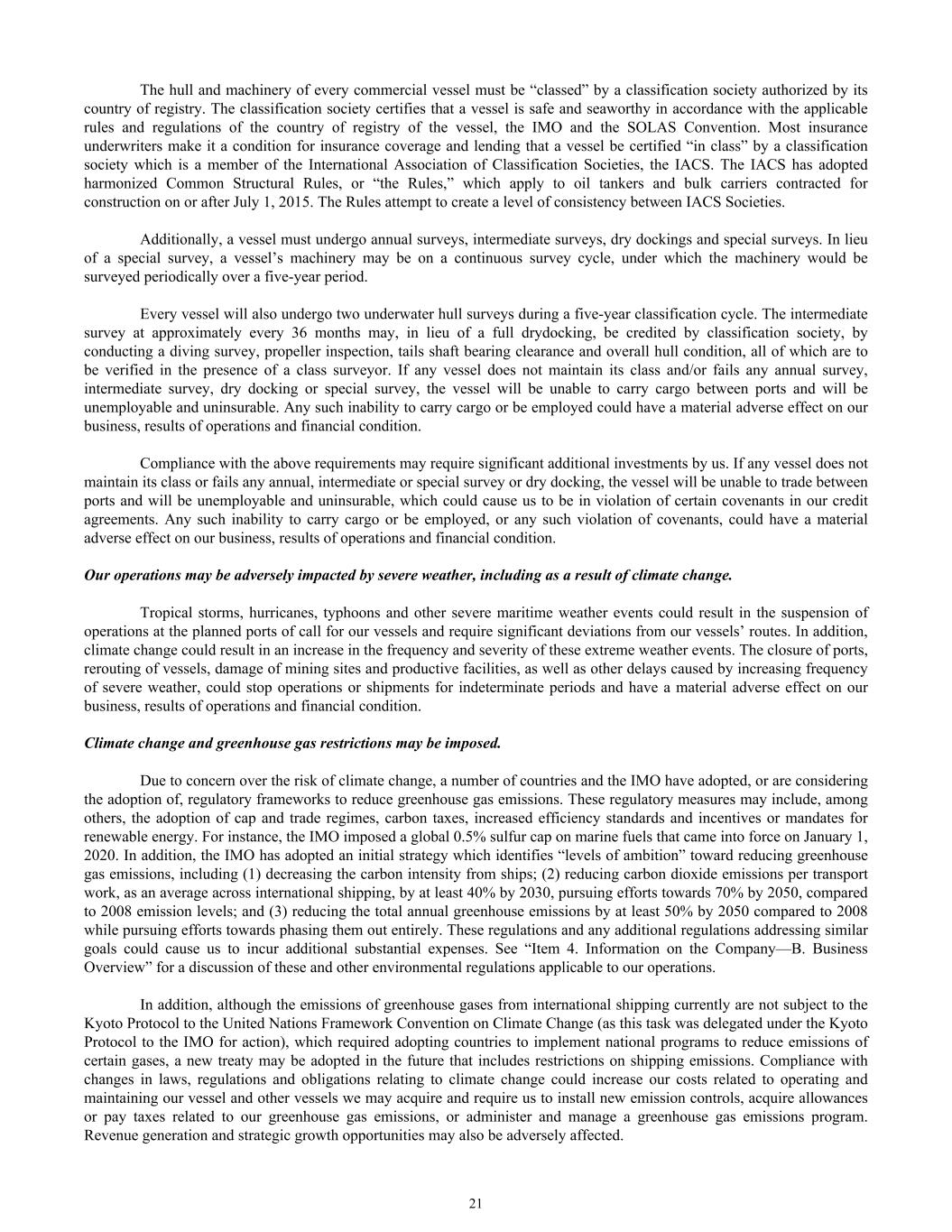
The hull and machinery of every commercial vessel must be “classed” by a classification society authorized by its country of registry. The classification society certifies that a vessel is safe and seaworthy in accordance with the applicable rules and regulations of the country of registry of the vessel, the IMO and the SOLAS Convention. Most insurance underwriters make it a condition for insurance coverage and lending that a vessel be certified “in class” by a classification society which is a member of the International Association of Classification Societies, the IACS. The IACS has adopted harmonized Common Structural Rules, or “the Rules,” which apply to oil tankers and bulk carriers contracted for construction on or after July 1, 2015. The Rules attempt to create a level of consistency between IACS Societies. Additionally, a vessel must undergo annual surveys, intermediate surveys, dry dockings and special surveys. In lieu of a special survey, a vessel’s machinery may be on a continuous survey cycle, under which the machinery would be surveyed periodically over a five-year period. Every vessel will also undergo two underwater hull surveys during a five-year classification cycle. The intermediate survey at approximately every 36 months may, in lieu of a full drydocking, be credited by classification society, by conducting a diving survey, propeller inspection, tails shaft bearing clearance and overall hull condition, all of which are to be verified in the presence of a class surveyor. If any vessel does not maintain its class and/or fails any annual survey, intermediate survey, dry docking or special survey, the vessel will be unable to carry cargo between ports and will be unemployable and uninsurable. Any such inability to carry cargo or be employed could have a material adverse effect on our business, results of operations and financial condition. Compliance with the above requirements may require significant additional investments by us. If any vessel does not maintain its class or fails any annual, intermediate or special survey or dry docking, the vessel will be unable to trade between ports and will be unemployable and uninsurable, which could cause us to be in violation of certain covenants in our credit agreements. Any such inability to carry cargo or be employed, or any such violation of covenants, could have a material adverse effect on our business, results of operations and financial condition. Our operations may be adversely impacted by severe weather, including as a result of climate change. Tropical storms, hurricanes, typhoons and other severe maritime weather events could result in the suspension of operations at the planned ports of call for our vessels and require significant deviations from our vessels’ routes. In addition, climate change could result in an increase in the frequency and severity of these extreme weather events. The closure of ports, rerouting of vessels, damage of mining sites and productive facilities, as well as other delays caused by increasing frequency of severe weather, could stop operations or shipments for indeterminate periods and have a material adverse effect on our business, results of operations and financial condition. Climate change and greenhouse gas restrictions may be imposed. Due to concern over the risk of climate change, a number of countries and the IMO have adopted, or are considering the adoption of, regulatory frameworks to reduce greenhouse gas emissions. These regulatory measures may include, among others, the adoption of cap and trade regimes, carbon taxes, increased efficiency standards and incentives or mandates for renewable energy. For instance, the IMO imposed a global 0.5% sulfur cap on marine fuels that came into force on January 1, 2020. In addition, the IMO has adopted an initial strategy which identifies “levels of ambition” toward reducing greenhouse gas emissions, including (1) decreasing the carbon intensity from ships; (2) reducing carbon dioxide emissions per transport work, as an average across international shipping, by at least 40% by 2030, pursuing efforts towards 70% by 2050, compared to 2008 emission levels; and (3) reducing the total annual greenhouse emissions by at least 50% by 2050 compared to 2008 while pursuing efforts towards phasing them out entirely. These regulations and any additional regulations addressing similar goals could cause us to incur additional substantial expenses. See “Item 4. Information on the Company—B. Business Overview” for a discussion of these and other environmental regulations applicable to our operations. In addition, although the emissions of greenhouse gases from international shipping currently are not subject to the Kyoto Protocol to the United Nations Framework Convention on Climate Change (as this task was delegated under the Kyoto Protocol to the IMO for action), which required adopting countries to implement national programs to reduce emissions of certain gases, a new treaty may be adopted in the future that includes restrictions on shipping emissions. Compliance with changes in laws, regulations and obligations relating to climate change could increase our costs related to operating and maintaining our vessel and other vessels we may acquire and require us to install new emission controls, acquire allowances or pay taxes related to our greenhouse gas emissions, or administer and manage a greenhouse gas emissions program. Revenue generation and strategic growth opportunities may also be adversely affected. 21
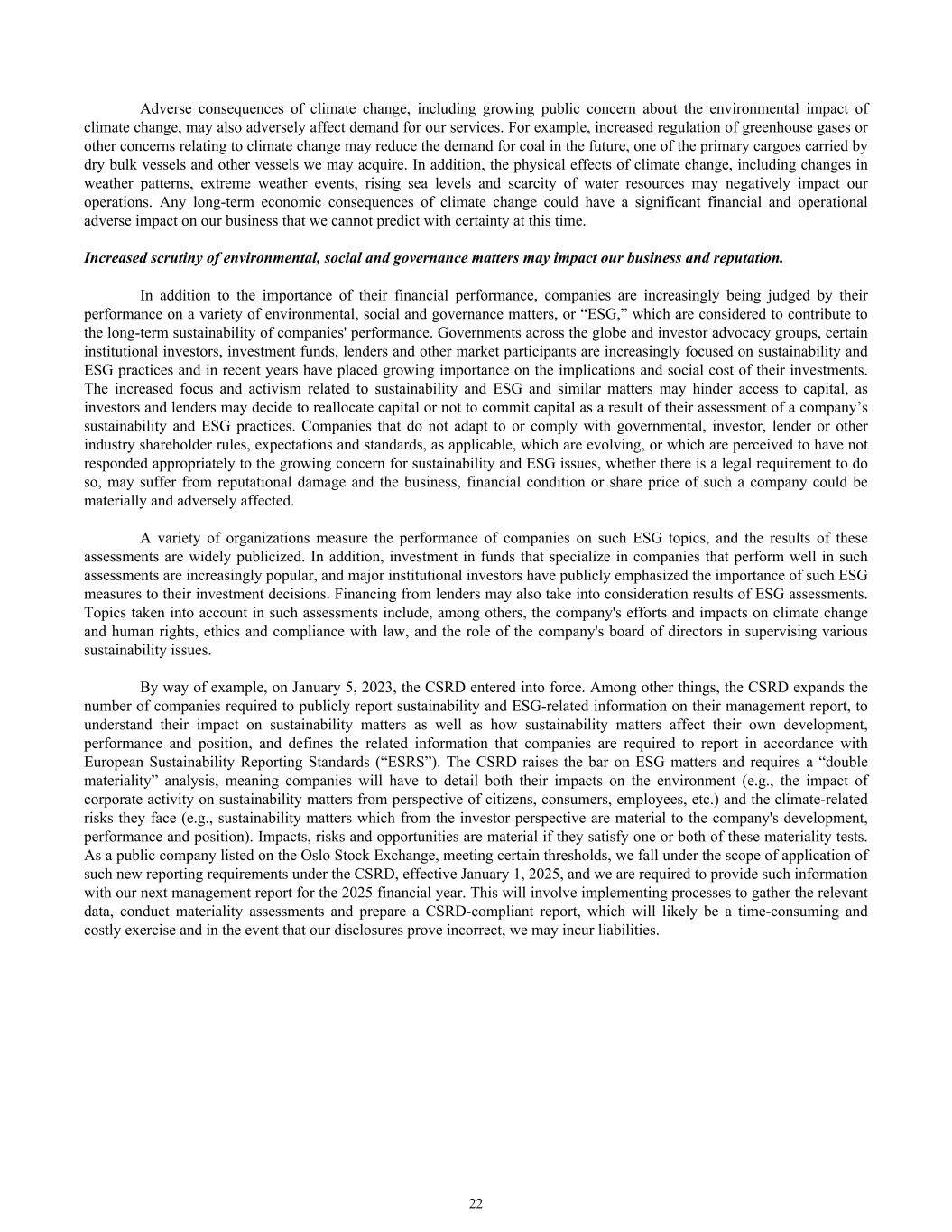
Adverse consequences of climate change, including growing public concern about the environmental impact of climate change, may also adversely affect demand for our services. For example, increased regulation of greenhouse gases or other concerns relating to climate change may reduce the demand for coal in the future, one of the primary cargoes carried by dry bulk vessels and other vessels we may acquire. In addition, the physical effects of climate change, including changes in weather patterns, extreme weather events, rising sea levels and scarcity of water resources may negatively impact our operations. Any long-term economic consequences of climate change could have a significant financial and operational adverse impact on our business that we cannot predict with certainty at this time. Increased scrutiny of environmental, social and governance matters may impact our business and reputation. In addition to the importance of their financial performance, companies are increasingly being judged by their performance on a variety of environmental, social and governance matters, or “ESG,” which are considered to contribute to the long-term sustainability of companies' performance. Governments across the globe and investor advocacy groups, certain institutional investors, investment funds, lenders and other market participants are increasingly focused on sustainability and ESG practices and in recent years have placed growing importance on the implications and social cost of their investments. The increased focus and activism related to sustainability and ESG and similar matters may hinder access to capital, as investors and lenders may decide to reallocate capital or not to commit capital as a result of their assessment of a company’s sustainability and ESG practices. Companies that do not adapt to or comply with governmental, investor, lender or other industry shareholder rules, expectations and standards, as applicable, which are evolving, or which are perceived to have not responded appropriately to the growing concern for sustainability and ESG issues, whether there is a legal requirement to do so, may suffer from reputational damage and the business, financial condition or share price of such a company could be materially and adversely affected. A variety of organizations measure the performance of companies on such ESG topics, and the results of these assessments are widely publicized. In addition, investment in funds that specialize in companies that perform well in such assessments are increasingly popular, and major institutional investors have publicly emphasized the importance of such ESG measures to their investment decisions. Financing from lenders may also take into consideration results of ESG assessments. Topics taken into account in such assessments include, among others, the company's efforts and impacts on climate change and human rights, ethics and compliance with law, and the role of the company's board of directors in supervising various sustainability issues. By way of example, on January 5, 2023, the CSRD entered into force. Among other things, the CSRD expands the number of companies required to publicly report sustainability and ESG-related information on their management report, to understand their impact on sustainability matters as well as how sustainability matters affect their own development, performance and position, and defines the related information that companies are required to report in accordance with European Sustainability Reporting Standards (“ESRS”). The CSRD raises the bar on ESG matters and requires a “double materiality” analysis, meaning companies will have to detail both their impacts on the environment (e.g., the impact of corporate activity on sustainability matters from perspective of citizens, consumers, employees, etc.) and the climate-related risks they face (e.g., sustainability matters which from the investor perspective are material to the company's development, performance and position). Impacts, risks and opportunities are material if they satisfy one or both of these materiality tests. As a public company listed on the Oslo Stock Exchange, meeting certain thresholds, we fall under the scope of application of such new reporting requirements under the CSRD, effective January 1, 2025, and we are required to provide such information with our next management report for the 2025 financial year. This will involve implementing processes to gather the relevant data, conduct materiality assessments and prepare a CSRD-compliant report, which will likely be a time-consuming and costly exercise and in the event that our disclosures prove incorrect, we may incur liabilities. 22
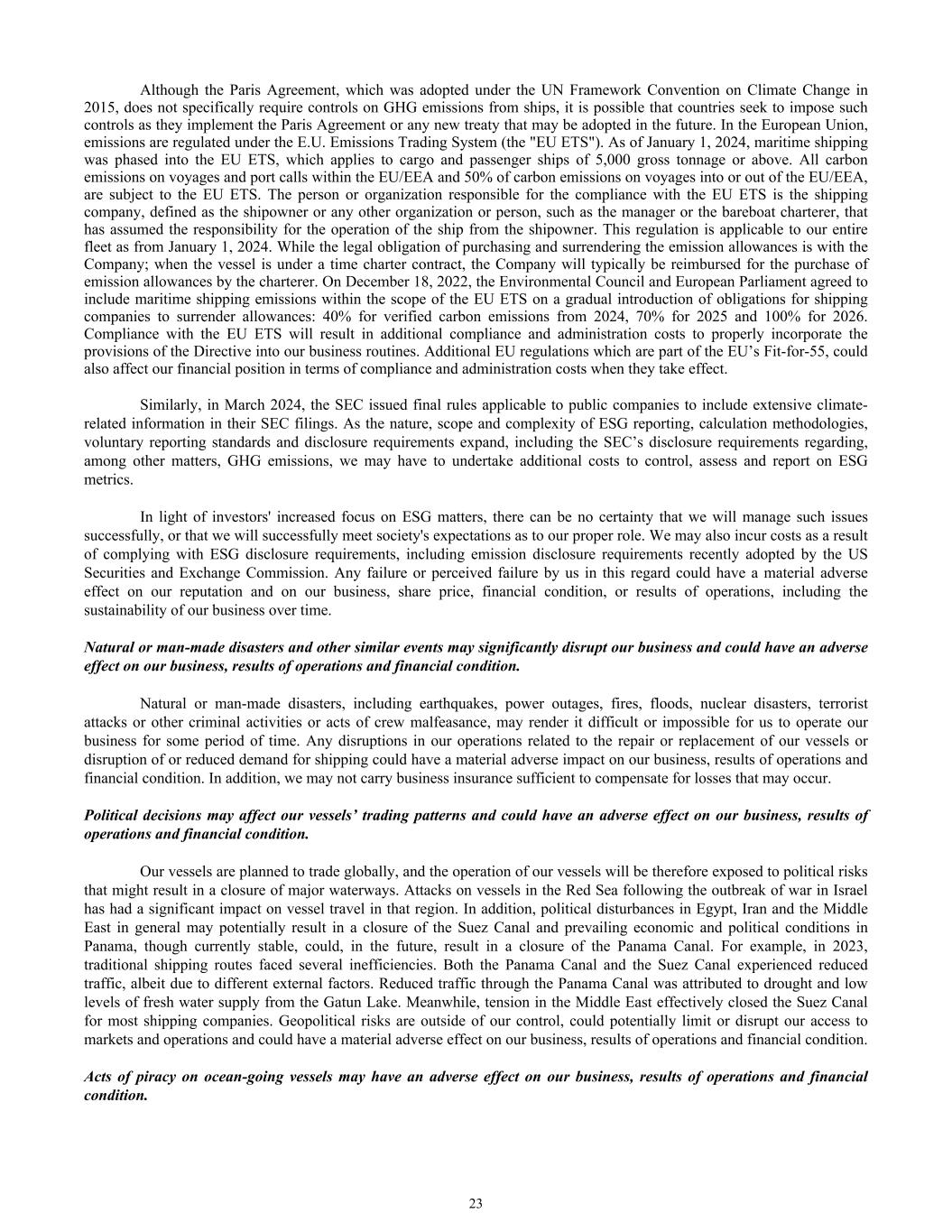
Although the Paris Agreement, which was adopted under the UN Framework Convention on Climate Change in 2015, does not specifically require controls on GHG emissions from ships, it is possible that countries seek to impose such controls as they implement the Paris Agreement or any new treaty that may be adopted in the future. In the European Union, emissions are regulated under the E.U. Emissions Trading System (the "EU ETS"). As of January 1, 2024, maritime shipping was phased into the EU ETS, which applies to cargo and passenger ships of 5,000 gross tonnage or above. All carbon emissions on voyages and port calls within the EU/EEA and 50% of carbon emissions on voyages into or out of the EU/EEA, are subject to the EU ETS. The person or organization responsible for the compliance with the EU ETS is the shipping company, defined as the shipowner or any other organization or person, such as the manager or the bareboat charterer, that has assumed the responsibility for the operation of the ship from the shipowner. This regulation is applicable to our entire fleet as from January 1, 2024. While the legal obligation of purchasing and surrendering the emission allowances is with the Company; when the vessel is under a time charter contract, the Company will typically be reimbursed for the purchase of emission allowances by the charterer. On December 18, 2022, the Environmental Council and European Parliament agreed to include maritime shipping emissions within the scope of the EU ETS on a gradual introduction of obligations for shipping companies to surrender allowances: 40% for verified carbon emissions from 2024, 70% for 2025 and 100% for 2026. Compliance with the EU ETS will result in additional compliance and administration costs to properly incorporate the provisions of the Directive into our business routines. Additional EU regulations which are part of the EU’s Fit-for-55, could also affect our financial position in terms of compliance and administration costs when they take effect. Similarly, in March 2024, the SEC issued final rules applicable to public companies to include extensive climate- related information in their SEC filings. As the nature, scope and complexity of ESG reporting, calculation methodologies, voluntary reporting standards and disclosure requirements expand, including the SEC’s disclosure requirements regarding, among other matters, GHG emissions, we may have to undertake additional costs to control, assess and report on ESG metrics. In light of investors' increased focus on ESG matters, there can be no certainty that we will manage such issues successfully, or that we will successfully meet society's expectations as to our proper role. We may also incur costs as a result of complying with ESG disclosure requirements, including emission disclosure requirements recently adopted by the US Securities and Exchange Commission. Any failure or perceived failure by us in this regard could have a material adverse effect on our reputation and on our business, share price, financial condition, or results of operations, including the sustainability of our business over time. Natural or man-made disasters and other similar events may significantly disrupt our business and could have an adverse effect on our business, results of operations and financial condition. Natural or man-made disasters, including earthquakes, power outages, fires, floods, nuclear disasters, terrorist attacks or other criminal activities or acts of crew malfeasance, may render it difficult or impossible for us to operate our business for some period of time. Any disruptions in our operations related to the repair or replacement of our vessels or disruption of or reduced demand for shipping could have a material adverse impact on our business, results of operations and financial condition. In addition, we may not carry business insurance sufficient to compensate for losses that may occur. Political decisions may affect our vessels’ trading patterns and could have an adverse effect on our business, results of operations and financial condition. Our vessels are planned to trade globally, and the operation of our vessels will be therefore exposed to political risks that might result in a closure of major waterways. Attacks on vessels in the Red Sea following the outbreak of war in Israel has had a significant impact on vessel travel in that region. In addition, political disturbances in Egypt, Iran and the Middle East in general may potentially result in a closure of the Suez Canal and prevailing economic and political conditions in Panama, though currently stable, could, in the future, result in a closure of the Panama Canal. For example, in 2023, traditional shipping routes faced several inefficiencies. Both the Panama Canal and the Suez Canal experienced reduced traffic, albeit due to different external factors. Reduced traffic through the Panama Canal was attributed to drought and low levels of fresh water supply from the Gatun Lake. Meanwhile, tension in the Middle East effectively closed the Suez Canal for most shipping companies. Geopolitical risks are outside of our control, could potentially limit or disrupt our access to markets and operations and could have a material adverse effect on our business, results of operations and financial condition. Acts of piracy on ocean-going vessels may have an adverse effect on our business, results of operations and financial condition. 23
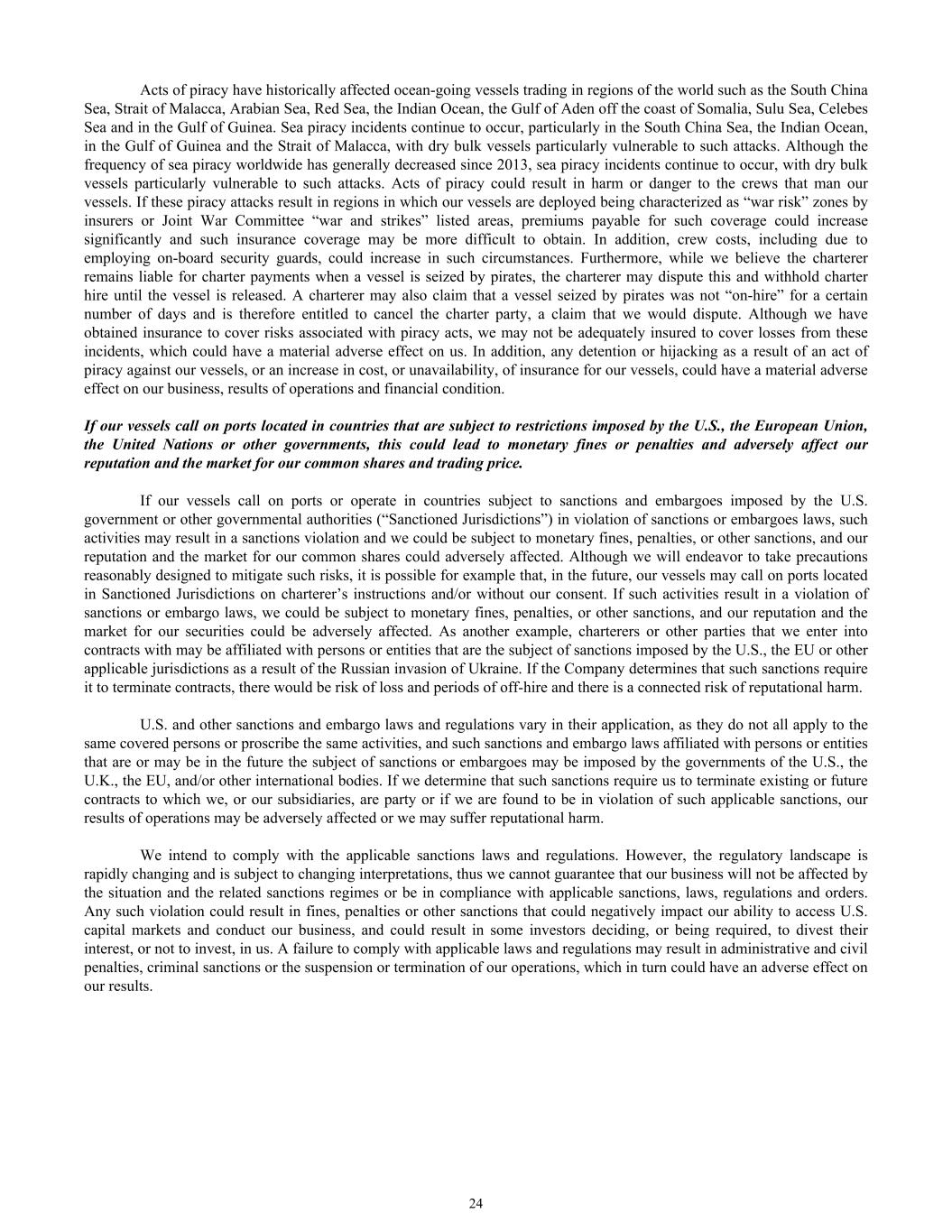
Acts of piracy have historically affected ocean-going vessels trading in regions of the world such as the South China Sea, Strait of Malacca, Arabian Sea, Red Sea, the Indian Ocean, the Gulf of Aden off the coast of Somalia, Sulu Sea, Celebes Sea and in the Gulf of Guinea. Sea piracy incidents continue to occur, particularly in the South China Sea, the Indian Ocean, in the Gulf of Guinea and the Strait of Malacca, with dry bulk vessels particularly vulnerable to such attacks. Although the frequency of sea piracy worldwide has generally decreased since 2013, sea piracy incidents continue to occur, with dry bulk vessels particularly vulnerable to such attacks. Acts of piracy could result in harm or danger to the crews that man our vessels. If these piracy attacks result in regions in which our vessels are deployed being characterized as “war risk” zones by insurers or Joint War Committee “war and strikes” listed areas, premiums payable for such coverage could increase significantly and such insurance coverage may be more difficult to obtain. In addition, crew costs, including due to employing on-board security guards, could increase in such circumstances. Furthermore, while we believe the charterer remains liable for charter payments when a vessel is seized by pirates, the charterer may dispute this and withhold charter hire until the vessel is released. A charterer may also claim that a vessel seized by pirates was not “on-hire” for a certain number of days and is therefore entitled to cancel the charter party, a claim that we would dispute. Although we have obtained insurance to cover risks associated with piracy acts, we may not be adequately insured to cover losses from these incidents, which could have a material adverse effect on us. In addition, any detention or hijacking as a result of an act of piracy against our vessels, or an increase in cost, or unavailability, of insurance for our vessels, could have a material adverse effect on our business, results of operations and financial condition. If our vessels call on ports located in countries that are subject to restrictions imposed by the U.S., the European Union, the United Nations or other governments, this could lead to monetary fines or penalties and adversely affect our reputation and the market for our common shares and trading price. If our vessels call on ports or operate in countries subject to sanctions and embargoes imposed by the U.S. government or other governmental authorities (“Sanctioned Jurisdictions”) in violation of sanctions or embargoes laws, such activities may result in a sanctions violation and we could be subject to monetary fines, penalties, or other sanctions, and our reputation and the market for our common shares could adversely affected. Although we will endeavor to take precautions reasonably designed to mitigate such risks, it is possible for example that, in the future, our vessels may call on ports located in Sanctioned Jurisdictions on charterer’s instructions and/or without our consent. If such activities result in a violation of sanctions or embargo laws, we could be subject to monetary fines, penalties, or other sanctions, and our reputation and the market for our securities could be adversely affected. As another example, charterers or other parties that we enter into contracts with may be affiliated with persons or entities that are the subject of sanctions imposed by the U.S., the EU or other applicable jurisdictions as a result of the Russian invasion of Ukraine. If the Company determines that such sanctions require it to terminate contracts, there would be risk of loss and periods of off-hire and there is a connected risk of reputational harm. U.S. and other sanctions and embargo laws and regulations vary in their application, as they do not all apply to the same covered persons or proscribe the same activities, and such sanctions and embargo laws affiliated with persons or entities that are or may be in the future the subject of sanctions or embargoes may be imposed by the governments of the U.S., the U.K., the EU, and/or other international bodies. If we determine that such sanctions require us to terminate existing or future contracts to which we, or our subsidiaries, are party or if we are found to be in violation of such applicable sanctions, our results of operations may be adversely affected or we may suffer reputational harm. We intend to comply with the applicable sanctions laws and regulations. However, the regulatory landscape is rapidly changing and is subject to changing interpretations, thus we cannot guarantee that our business will not be affected by the situation and the related sanctions regimes or be in compliance with applicable sanctions, laws, regulations and orders. Any such violation could result in fines, penalties or other sanctions that could negatively impact our ability to access U.S. capital markets and conduct our business, and could result in some investors deciding, or being required, to divest their interest, or not to invest, in us. A failure to comply with applicable laws and regulations may result in administrative and civil penalties, criminal sanctions or the suspension or termination of our operations, which in turn could have an adverse effect on our results. 24
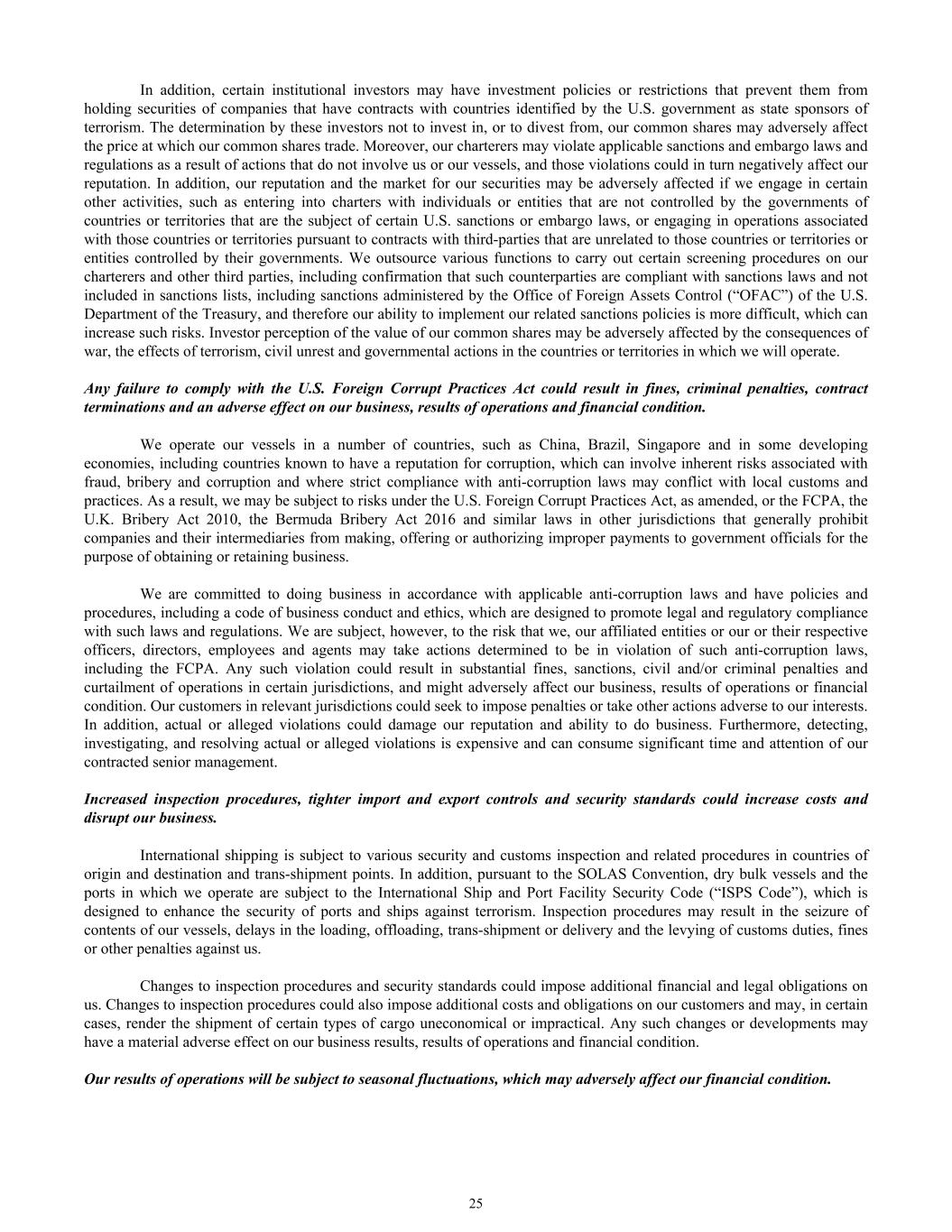
In addition, certain institutional investors may have investment policies or restrictions that prevent them from holding securities of companies that have contracts with countries identified by the U.S. government as state sponsors of terrorism. The determination by these investors not to invest in, or to divest from, our common shares may adversely affect the price at which our common shares trade. Moreover, our charterers may violate applicable sanctions and embargo laws and regulations as a result of actions that do not involve us or our vessels, and those violations could in turn negatively affect our reputation. In addition, our reputation and the market for our securities may be adversely affected if we engage in certain other activities, such as entering into charters with individuals or entities that are not controlled by the governments of countries or territories that are the subject of certain U.S. sanctions or embargo laws, or engaging in operations associated with those countries or territories pursuant to contracts with third-parties that are unrelated to those countries or territories or entities controlled by their governments. We outsource various functions to carry out certain screening procedures on our charterers and other third parties, including confirmation that such counterparties are compliant with sanctions laws and not included in sanctions lists, including sanctions administered by the Office of Foreign Assets Control (“OFAC”) of the U.S. Department of the Treasury, and therefore our ability to implement our related sanctions policies is more difficult, which can increase such risks. Investor perception of the value of our common shares may be adversely affected by the consequences of war, the effects of terrorism, civil unrest and governmental actions in the countries or territories in which we will operate. Any failure to comply with the U.S. Foreign Corrupt Practices Act could result in fines, criminal penalties, contract terminations and an adverse effect on our business, results of operations and financial condition. We operate our vessels in a number of countries, such as China, Brazil, Singapore and in some developing economies, including countries known to have a reputation for corruption, which can involve inherent risks associated with fraud, bribery and corruption and where strict compliance with anti-corruption laws may conflict with local customs and practices. As a result, we may be subject to risks under the U.S. Foreign Corrupt Practices Act, as amended, or the FCPA, the U.K. Bribery Act 2010, the Bermuda Bribery Act 2016 and similar laws in other jurisdictions that generally prohibit companies and their intermediaries from making, offering or authorizing improper payments to government officials for the purpose of obtaining or retaining business. We are committed to doing business in accordance with applicable anti-corruption laws and have policies and procedures, including a code of business conduct and ethics, which are designed to promote legal and regulatory compliance with such laws and regulations. We are subject, however, to the risk that we, our affiliated entities or our or their respective officers, directors, employees and agents may take actions determined to be in violation of such anti-corruption laws, including the FCPA. Any such violation could result in substantial fines, sanctions, civil and/or criminal penalties and curtailment of operations in certain jurisdictions, and might adversely affect our business, results of operations or financial condition. Our customers in relevant jurisdictions could seek to impose penalties or take other actions adverse to our interests. In addition, actual or alleged violations could damage our reputation and ability to do business. Furthermore, detecting, investigating, and resolving actual or alleged violations is expensive and can consume significant time and attention of our contracted senior management. Increased inspection procedures, tighter import and export controls and security standards could increase costs and disrupt our business. International shipping is subject to various security and customs inspection and related procedures in countries of origin and destination and trans-shipment points. In addition, pursuant to the SOLAS Convention, dry bulk vessels and the ports in which we operate are subject to the International Ship and Port Facility Security Code (“ISPS Code”), which is designed to enhance the security of ports and ships against terrorism. Inspection procedures may result in the seizure of contents of our vessels, delays in the loading, offloading, trans-shipment or delivery and the levying of customs duties, fines or other penalties against us. Changes to inspection procedures and security standards could impose additional financial and legal obligations on us. Changes to inspection procedures could also impose additional costs and obligations on our customers and may, in certain cases, render the shipment of certain types of cargo uneconomical or impractical. Any such changes or developments may have a material adverse effect on our business results, results of operations and financial condition. Our results of operations will be subject to seasonal fluctuations, which may adversely affect our financial condition. 25
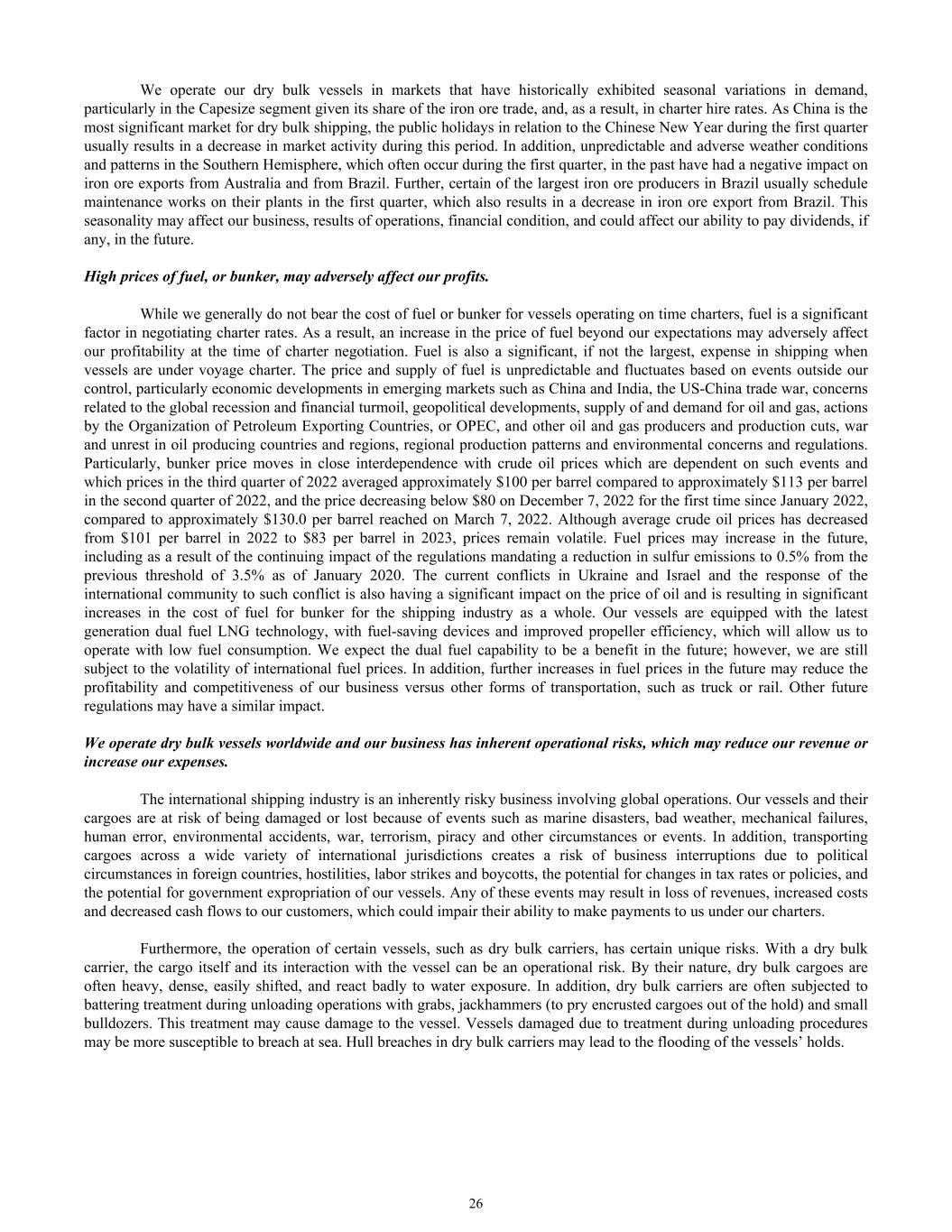
We operate our dry bulk vessels in markets that have historically exhibited seasonal variations in demand, particularly in the Capesize segment given its share of the iron ore trade, and, as a result, in charter hire rates. As China is the most significant market for dry bulk shipping, the public holidays in relation to the Chinese New Year during the first quarter usually results in a decrease in market activity during this period. In addition, unpredictable and adverse weather conditions and patterns in the Southern Hemisphere, which often occur during the first quarter, in the past have had a negative impact on iron ore exports from Australia and from Brazil. Further, certain of the largest iron ore producers in Brazil usually schedule maintenance works on their plants in the first quarter, which also results in a decrease in iron ore export from Brazil. This seasonality may affect our business, results of operations, financial condition, and could affect our ability to pay dividends, if any, in the future. High prices of fuel, or bunker, may adversely affect our profits. While we generally do not bear the cost of fuel or bunker for vessels operating on time charters, fuel is a significant factor in negotiating charter rates. As a result, an increase in the price of fuel beyond our expectations may adversely affect our profitability at the time of charter negotiation. Fuel is also a significant, if not the largest, expense in shipping when vessels are under voyage charter. The price and supply of fuel is unpredictable and fluctuates based on events outside our control, particularly economic developments in emerging markets such as China and India, the US-China trade war, concerns related to the global recession and financial turmoil, geopolitical developments, supply of and demand for oil and gas, actions by the Organization of Petroleum Exporting Countries, or OPEC, and other oil and gas producers and production cuts, war and unrest in oil producing countries and regions, regional production patterns and environmental concerns and regulations. Particularly, bunker price moves in close interdependence with crude oil prices which are dependent on such events and which prices in the third quarter of 2022 averaged approximately $100 per barrel compared to approximately $113 per barrel in the second quarter of 2022, and the price decreasing below $80 on December 7, 2022 for the first time since January 2022, compared to approximately $130.0 per barrel reached on March 7, 2022. Although average crude oil prices has decreased from $101 per barrel in 2022 to $83 per barrel in 2023, prices remain volatile. Fuel prices may increase in the future, including as a result of the continuing impact of the regulations mandating a reduction in sulfur emissions to 0.5% from the previous threshold of 3.5% as of January 2020. The current conflicts in Ukraine and Israel and the response of the international community to such conflict is also having a significant impact on the price of oil and is resulting in significant increases in the cost of fuel for bunker for the shipping industry as a whole. Our vessels are equipped with the latest generation dual fuel LNG technology, with fuel-saving devices and improved propeller efficiency, which will allow us to operate with low fuel consumption. We expect the dual fuel capability to be a benefit in the future; however, we are still subject to the volatility of international fuel prices. In addition, further increases in fuel prices in the future may reduce the profitability and competitiveness of our business versus other forms of transportation, such as truck or rail. Other future regulations may have a similar impact. We operate dry bulk vessels worldwide and our business has inherent operational risks, which may reduce our revenue or increase our expenses. The international shipping industry is an inherently risky business involving global operations. Our vessels and their cargoes are at risk of being damaged or lost because of events such as marine disasters, bad weather, mechanical failures, human error, environmental accidents, war, terrorism, piracy and other circumstances or events. In addition, transporting cargoes across a wide variety of international jurisdictions creates a risk of business interruptions due to political circumstances in foreign countries, hostilities, labor strikes and boycotts, the potential for changes in tax rates or policies, and the potential for government expropriation of our vessels. Any of these events may result in loss of revenues, increased costs and decreased cash flows to our customers, which could impair their ability to make payments to us under our charters. Furthermore, the operation of certain vessels, such as dry bulk carriers, has certain unique risks. With a dry bulk carrier, the cargo itself and its interaction with the vessel can be an operational risk. By their nature, dry bulk cargoes are often heavy, dense, easily shifted, and react badly to water exposure. In addition, dry bulk carriers are often subjected to battering treatment during unloading operations with grabs, jackhammers (to pry encrusted cargoes out of the hold) and small bulldozers. This treatment may cause damage to the vessel. Vessels damaged due to treatment during unloading procedures may be more susceptible to breach at sea. Hull breaches in dry bulk carriers may lead to the flooding of the vessels’ holds. 26
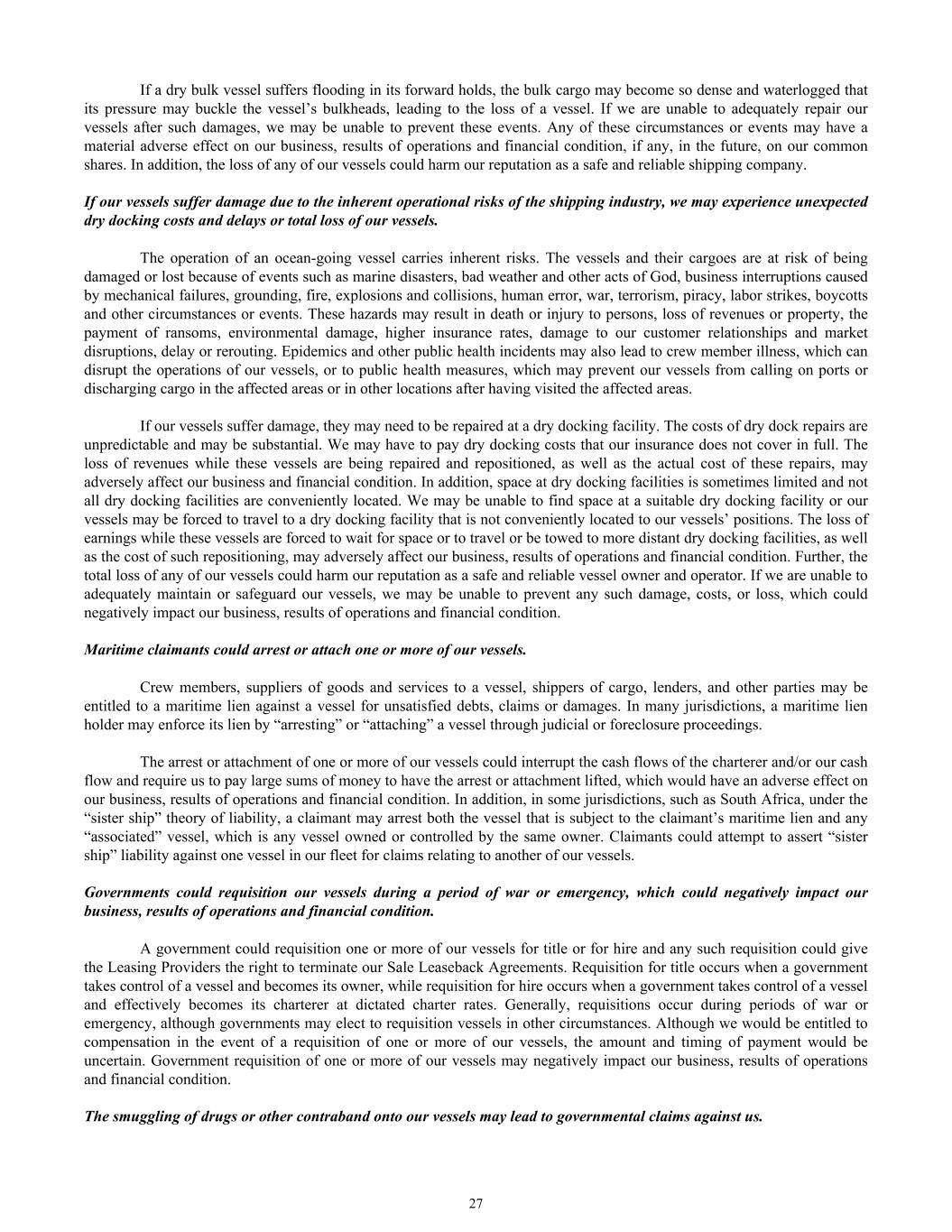
If a dry bulk vessel suffers flooding in its forward holds, the bulk cargo may become so dense and waterlogged that its pressure may buckle the vessel’s bulkheads, leading to the loss of a vessel. If we are unable to adequately repair our vessels after such damages, we may be unable to prevent these events. Any of these circumstances or events may have a material adverse effect on our business, results of operations and financial condition, if any, in the future, on our common shares. In addition, the loss of any of our vessels could harm our reputation as a safe and reliable shipping company. If our vessels suffer damage due to the inherent operational risks of the shipping industry, we may experience unexpected dry docking costs and delays or total loss of our vessels. The operation of an ocean-going vessel carries inherent risks. The vessels and their cargoes are at risk of being damaged or lost because of events such as marine disasters, bad weather and other acts of God, business interruptions caused by mechanical failures, grounding, fire, explosions and collisions, human error, war, terrorism, piracy, labor strikes, boycotts and other circumstances or events. These hazards may result in death or injury to persons, loss of revenues or property, the payment of ransoms, environmental damage, higher insurance rates, damage to our customer relationships and market disruptions, delay or rerouting. Epidemics and other public health incidents may also lead to crew member illness, which can disrupt the operations of our vessels, or to public health measures, which may prevent our vessels from calling on ports or discharging cargo in the affected areas or in other locations after having visited the affected areas. If our vessels suffer damage, they may need to be repaired at a dry docking facility. The costs of dry dock repairs are unpredictable and may be substantial. We may have to pay dry docking costs that our insurance does not cover in full. The loss of revenues while these vessels are being repaired and repositioned, as well as the actual cost of these repairs, may adversely affect our business and financial condition. In addition, space at dry docking facilities is sometimes limited and not all dry docking facilities are conveniently located. We may be unable to find space at a suitable dry docking facility or our vessels may be forced to travel to a dry docking facility that is not conveniently located to our vessels’ positions. The loss of earnings while these vessels are forced to wait for space or to travel or be towed to more distant dry docking facilities, as well as the cost of such repositioning, may adversely affect our business, results of operations and financial condition. Further, the total loss of any of our vessels could harm our reputation as a safe and reliable vessel owner and operator. If we are unable to adequately maintain or safeguard our vessels, we may be unable to prevent any such damage, costs, or loss, which could negatively impact our business, results of operations and financial condition. Maritime claimants could arrest or attach one or more of our vessels. Crew members, suppliers of goods and services to a vessel, shippers of cargo, lenders, and other parties may be entitled to a maritime lien against a vessel for unsatisfied debts, claims or damages. In many jurisdictions, a maritime lien holder may enforce its lien by “arresting” or “attaching” a vessel through judicial or foreclosure proceedings. The arrest or attachment of one or more of our vessels could interrupt the cash flows of the charterer and/or our cash flow and require us to pay large sums of money to have the arrest or attachment lifted, which would have an adverse effect on our business, results of operations and financial condition. In addition, in some jurisdictions, such as South Africa, under the “sister ship” theory of liability, a claimant may arrest both the vessel that is subject to the claimant’s maritime lien and any “associated” vessel, which is any vessel owned or controlled by the same owner. Claimants could attempt to assert “sister ship” liability against one vessel in our fleet for claims relating to another of our vessels. Governments could requisition our vessels during a period of war or emergency, which could negatively impact our business, results of operations and financial condition. A government could requisition one or more of our vessels for title or for hire and any such requisition could give the Leasing Providers the right to terminate our Sale Leaseback Agreements. Requisition for title occurs when a government takes control of a vessel and becomes its owner, while requisition for hire occurs when a government takes control of a vessel and effectively becomes its charterer at dictated charter rates. Generally, requisitions occur during periods of war or emergency, although governments may elect to requisition vessels in other circumstances. Although we would be entitled to compensation in the event of a requisition of one or more of our vessels, the amount and timing of payment would be uncertain. Government requisition of one or more of our vessels may negatively impact our business, results of operations and financial condition. The smuggling of drugs or other contraband onto our vessels may lead to governmental claims against us. 27
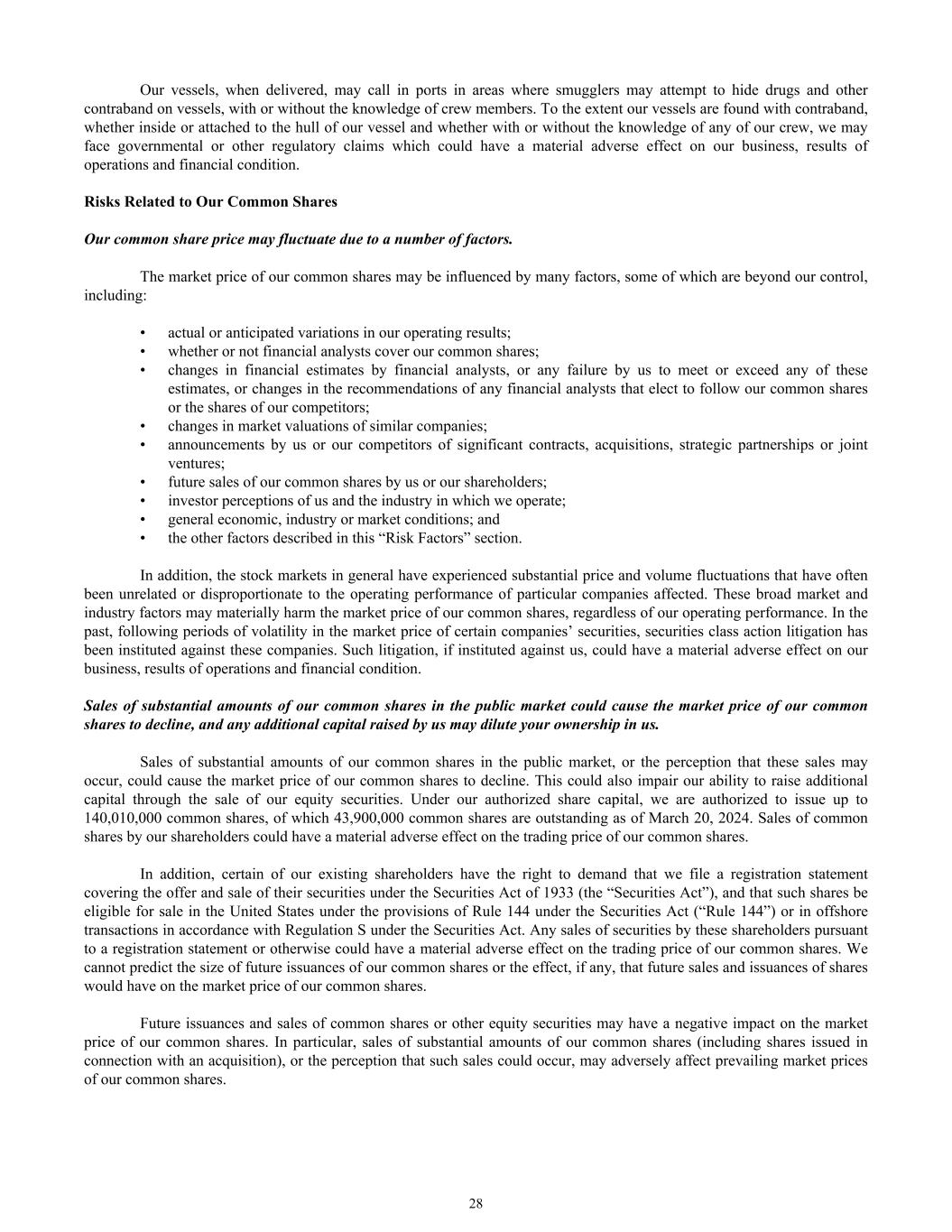
Our vessels, when delivered, may call in ports in areas where smugglers may attempt to hide drugs and other contraband on vessels, with or without the knowledge of crew members. To the extent our vessels are found with contraband, whether inside or attached to the hull of our vessel and whether with or without the knowledge of any of our crew, we may face governmental or other regulatory claims which could have a material adverse effect on our business, results of operations and financial condition. Risks Related to Our Common Shares Our common share price may fluctuate due to a number of factors. The market price of our common shares may be influenced by many factors, some of which are beyond our control, including: • actual or anticipated variations in our operating results; • whether or not financial analysts cover our common shares; • changes in financial estimates by financial analysts, or any failure by us to meet or exceed any of these estimates, or changes in the recommendations of any financial analysts that elect to follow our common shares or the shares of our competitors; • changes in market valuations of similar companies; • announcements by us or our competitors of significant contracts, acquisitions, strategic partnerships or joint ventures; • future sales of our common shares by us or our shareholders; • investor perceptions of us and the industry in which we operate; • general economic, industry or market conditions; and • the other factors described in this “Risk Factors” section. In addition, the stock markets in general have experienced substantial price and volume fluctuations that have often been unrelated or disproportionate to the operating performance of particular companies affected. These broad market and industry factors may materially harm the market price of our common shares, regardless of our operating performance. In the past, following periods of volatility in the market price of certain companies’ securities, securities class action litigation has been instituted against these companies. Such litigation, if instituted against us, could have a material adverse effect on our business, results of operations and financial condition. Sales of substantial amounts of our common shares in the public market could cause the market price of our common shares to decline, and any additional capital raised by us may dilute your ownership in us. Sales of substantial amounts of our common shares in the public market, or the perception that these sales may occur, could cause the market price of our common shares to decline. This could also impair our ability to raise additional capital through the sale of our equity securities. Under our authorized share capital, we are authorized to issue up to 140,010,000 common shares, of which 43,900,000 common shares are outstanding as of March 20, 2024. Sales of common shares by our shareholders could have a material adverse effect on the trading price of our common shares. In addition, certain of our existing shareholders have the right to demand that we file a registration statement covering the offer and sale of their securities under the Securities Act of 1933 (the “Securities Act”), and that such shares be eligible for sale in the United States under the provisions of Rule 144 under the Securities Act (“Rule 144”) or in offshore transactions in accordance with Regulation S under the Securities Act. Any sales of securities by these shareholders pursuant to a registration statement or otherwise could have a material adverse effect on the trading price of our common shares. We cannot predict the size of future issuances of our common shares or the effect, if any, that future sales and issuances of shares would have on the market price of our common shares. Future issuances and sales of common shares or other equity securities may have a negative impact on the market price of our common shares. In particular, sales of substantial amounts of our common shares (including shares issued in connection with an acquisition), or the perception that such sales could occur, may adversely affect prevailing market prices of our common shares. 28
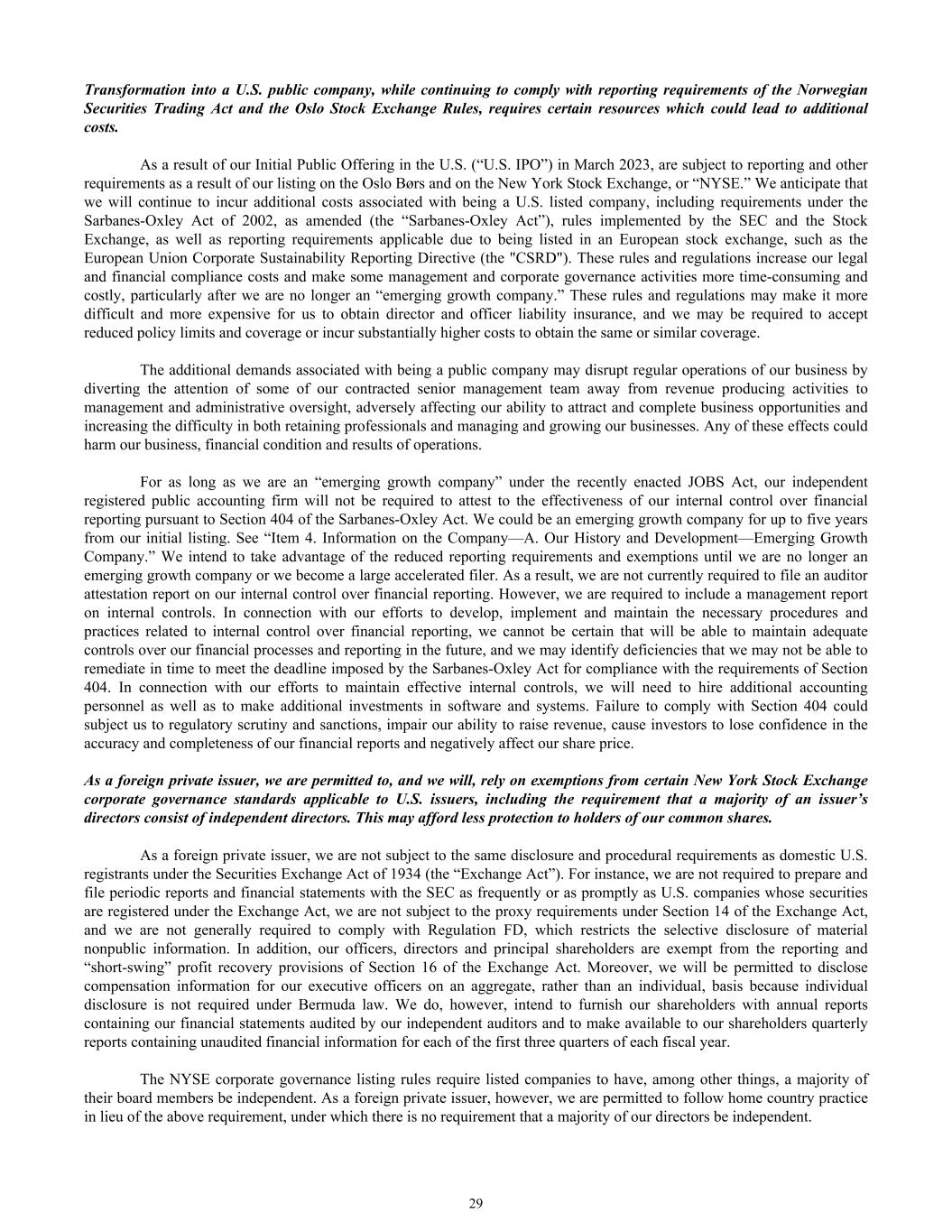
Transformation into a U.S. public company, while continuing to comply with reporting requirements of the Norwegian Securities Trading Act and the Oslo Stock Exchange Rules, requires certain resources which could lead to additional costs. As a result of our Initial Public Offering in the U.S. (“U.S. IPO”) in March 2023, are subject to reporting and other requirements as a result of our listing on the Oslo Børs and on the New York Stock Exchange, or “NYSE.” We anticipate that we will continue to incur additional costs associated with being a U.S. listed company, including requirements under the Sarbanes-Oxley Act of 2002, as amended (the “Sarbanes-Oxley Act”), rules implemented by the SEC and the Stock Exchange, as well as reporting requirements applicable due to being listed in an European stock exchange, such as the European Union Corporate Sustainability Reporting Directive (the "CSRD"). These rules and regulations increase our legal and financial compliance costs and make some management and corporate governance activities more time-consuming and costly, particularly after we are no longer an “emerging growth company.” These rules and regulations may make it more difficult and more expensive for us to obtain director and officer liability insurance, and we may be required to accept reduced policy limits and coverage or incur substantially higher costs to obtain the same or similar coverage. The additional demands associated with being a public company may disrupt regular operations of our business by diverting the attention of some of our contracted senior management team away from revenue producing activities to management and administrative oversight, adversely affecting our ability to attract and complete business opportunities and increasing the difficulty in both retaining professionals and managing and growing our businesses. Any of these effects could harm our business, financial condition and results of operations. For as long as we are an “emerging growth company” under the recently enacted JOBS Act, our independent registered public accounting firm will not be required to attest to the effectiveness of our internal control over financial reporting pursuant to Section 404 of the Sarbanes-Oxley Act. We could be an emerging growth company for up to five years from our initial listing. See “Item 4. Information on the Company—A. Our History and Development—Emerging Growth Company.” We intend to take advantage of the reduced reporting requirements and exemptions until we are no longer an emerging growth company or we become a large accelerated filer. As a result, we are not currently required to file an auditor attestation report on our internal control over financial reporting. However, we are required to include a management report on internal controls. In connection with our efforts to develop, implement and maintain the necessary procedures and practices related to internal control over financial reporting, we cannot be certain that will be able to maintain adequate controls over our financial processes and reporting in the future, and we may identify deficiencies that we may not be able to remediate in time to meet the deadline imposed by the Sarbanes-Oxley Act for compliance with the requirements of Section 404. In connection with our efforts to maintain effective internal controls, we will need to hire additional accounting personnel as well as to make additional investments in software and systems. Failure to comply with Section 404 could subject us to regulatory scrutiny and sanctions, impair our ability to raise revenue, cause investors to lose confidence in the accuracy and completeness of our financial reports and negatively affect our share price. As a foreign private issuer, we are permitted to, and we will, rely on exemptions from certain New York Stock Exchange corporate governance standards applicable to U.S. issuers, including the requirement that a majority of an issuer’s directors consist of independent directors. This may afford less protection to holders of our common shares. As a foreign private issuer, we are not subject to the same disclosure and procedural requirements as domestic U.S. registrants under the Securities Exchange Act of 1934 (the “Exchange Act”). For instance, we are not required to prepare and file periodic reports and financial statements with the SEC as frequently or as promptly as U.S. companies whose securities are registered under the Exchange Act, we are not subject to the proxy requirements under Section 14 of the Exchange Act, and we are not generally required to comply with Regulation FD, which restricts the selective disclosure of material nonpublic information. In addition, our officers, directors and principal shareholders are exempt from the reporting and “short-swing” profit recovery provisions of Section 16 of the Exchange Act. Moreover, we will be permitted to disclose compensation information for our executive officers on an aggregate, rather than an individual, basis because individual disclosure is not required under Bermuda law. We do, however, intend to furnish our shareholders with annual reports containing our financial statements audited by our independent auditors and to make available to our shareholders quarterly reports containing unaudited financial information for each of the first three quarters of each fiscal year. The NYSE corporate governance listing rules require listed companies to have, among other things, a majority of their board members be independent. As a foreign private issuer, however, we are permitted to follow home country practice in lieu of the above requirement, under which there is no requirement that a majority of our directors be independent. 29
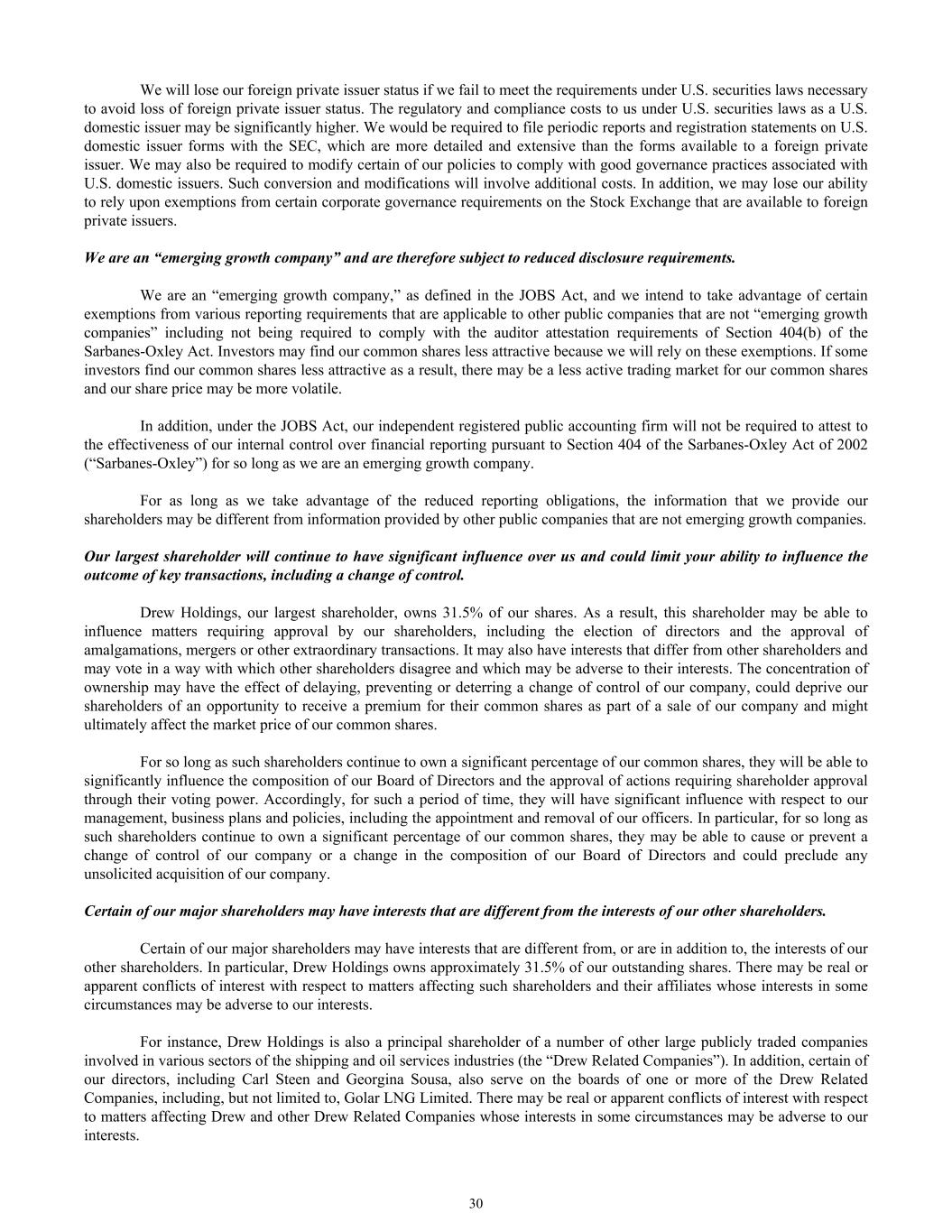
We will lose our foreign private issuer status if we fail to meet the requirements under U.S. securities laws necessary to avoid loss of foreign private issuer status. The regulatory and compliance costs to us under U.S. securities laws as a U.S. domestic issuer may be significantly higher. We would be required to file periodic reports and registration statements on U.S. domestic issuer forms with the SEC, which are more detailed and extensive than the forms available to a foreign private issuer. We may also be required to modify certain of our policies to comply with good governance practices associated with U.S. domestic issuers. Such conversion and modifications will involve additional costs. In addition, we may lose our ability to rely upon exemptions from certain corporate governance requirements on the Stock Exchange that are available to foreign private issuers. We are an “emerging growth company” and are therefore subject to reduced disclosure requirements. We are an “emerging growth company,” as defined in the JOBS Act, and we intend to take advantage of certain exemptions from various reporting requirements that are applicable to other public companies that are not “emerging growth companies” including not being required to comply with the auditor attestation requirements of Section 404(b) of the Sarbanes-Oxley Act. Investors may find our common shares less attractive because we will rely on these exemptions. If some investors find our common shares less attractive as a result, there may be a less active trading market for our common shares and our share price may be more volatile. In addition, under the JOBS Act, our independent registered public accounting firm will not be required to attest to the effectiveness of our internal control over financial reporting pursuant to Section 404 of the Sarbanes-Oxley Act of 2002 (“Sarbanes-Oxley”) for so long as we are an emerging growth company. For as long as we take advantage of the reduced reporting obligations, the information that we provide our shareholders may be different from information provided by other public companies that are not emerging growth companies. Our largest shareholder will continue to have significant influence over us and could limit your ability to influence the outcome of key transactions, including a change of control. Drew Holdings, our largest shareholder, owns 31.5% of our shares. As a result, this shareholder may be able to influence matters requiring approval by our shareholders, including the election of directors and the approval of amalgamations, mergers or other extraordinary transactions. It may also have interests that differ from other shareholders and may vote in a way with which other shareholders disagree and which may be adverse to their interests. The concentration of ownership may have the effect of delaying, preventing or deterring a change of control of our company, could deprive our shareholders of an opportunity to receive a premium for their common shares as part of a sale of our company and might ultimately affect the market price of our common shares. For so long as such shareholders continue to own a significant percentage of our common shares, they will be able to significantly influence the composition of our Board of Directors and the approval of actions requiring shareholder approval through their voting power. Accordingly, for such a period of time, they will have significant influence with respect to our management, business plans and policies, including the appointment and removal of our officers. In particular, for so long as such shareholders continue to own a significant percentage of our common shares, they may be able to cause or prevent a change of control of our company or a change in the composition of our Board of Directors and could preclude any unsolicited acquisition of our company. Certain of our major shareholders may have interests that are different from the interests of our other shareholders. Certain of our major shareholders may have interests that are different from, or are in addition to, the interests of our other shareholders. In particular, Drew Holdings owns approximately 31.5% of our outstanding shares. There may be real or apparent conflicts of interest with respect to matters affecting such shareholders and their affiliates whose interests in some circumstances may be adverse to our interests. For instance, Drew Holdings is also a principal shareholder of a number of other large publicly traded companies involved in various sectors of the shipping and oil services industries (the “Drew Related Companies”). In addition, certain of our directors, including Carl Steen and Georgina Sousa, also serve on the boards of one or more of the Drew Related Companies, including, but not limited to, Golar LNG Limited. There may be real or apparent conflicts of interest with respect to matters affecting Drew and other Drew Related Companies whose interests in some circumstances may be adverse to our interests. 30
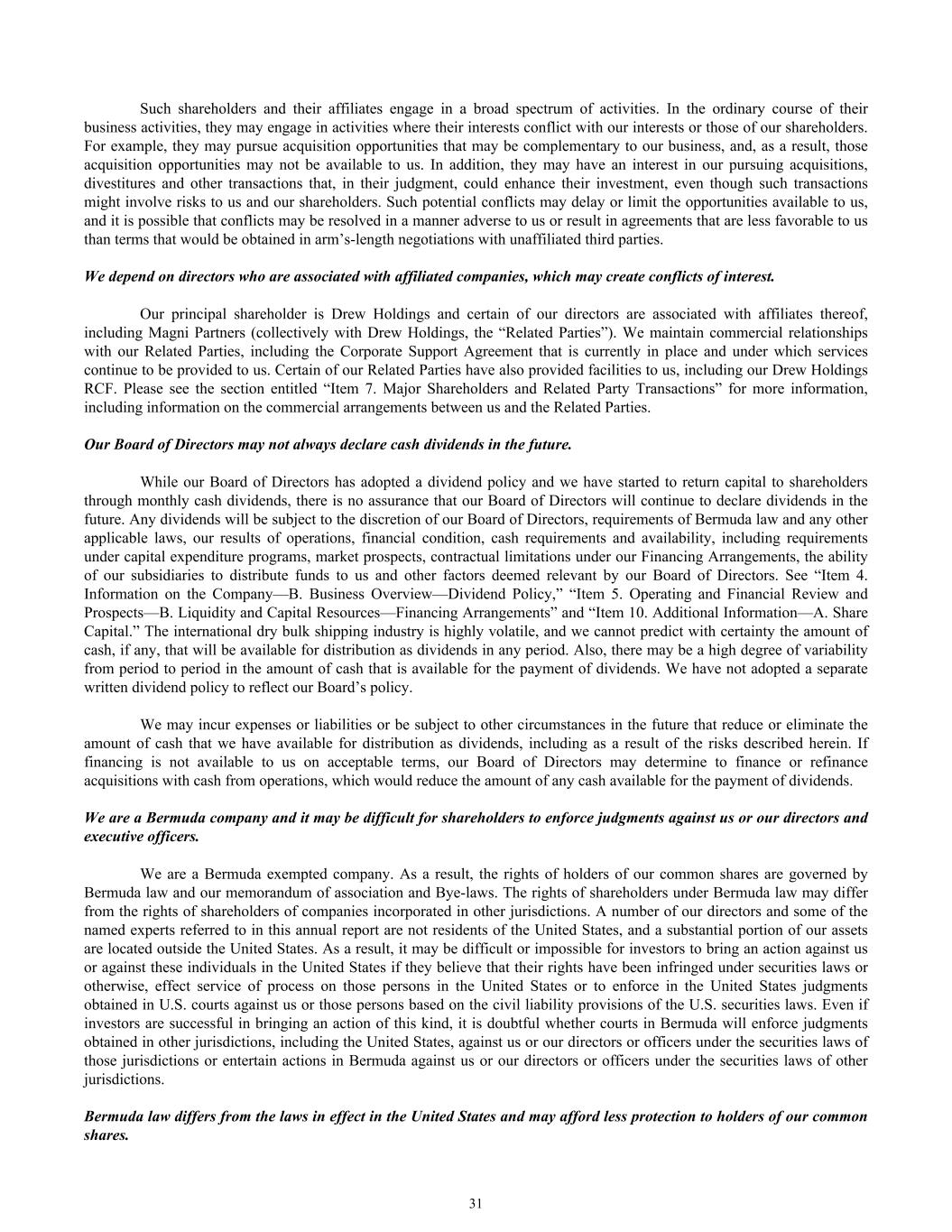
Such shareholders and their affiliates engage in a broad spectrum of activities. In the ordinary course of their business activities, they may engage in activities where their interests conflict with our interests or those of our shareholders. For example, they may pursue acquisition opportunities that may be complementary to our business, and, as a result, those acquisition opportunities may not be available to us. In addition, they may have an interest in our pursuing acquisitions, divestitures and other transactions that, in their judgment, could enhance their investment, even though such transactions might involve risks to us and our shareholders. Such potential conflicts may delay or limit the opportunities available to us, and it is possible that conflicts may be resolved in a manner adverse to us or result in agreements that are less favorable to us than terms that would be obtained in arm’s-length negotiations with unaffiliated third parties. We depend on directors who are associated with affiliated companies, which may create conflicts of interest. Our principal shareholder is Drew Holdings and certain of our directors are associated with affiliates thereof, including Magni Partners (collectively with Drew Holdings, the “Related Parties”). We maintain commercial relationships with our Related Parties, including the Corporate Support Agreement that is currently in place and under which services continue to be provided to us. Certain of our Related Parties have also provided facilities to us, including our Drew Holdings RCF. Please see the section entitled “Item 7. Major Shareholders and Related Party Transactions” for more information, including information on the commercial arrangements between us and the Related Parties. Our Board of Directors may not always declare cash dividends in the future. While our Board of Directors has adopted a dividend policy and we have started to return capital to shareholders through monthly cash dividends, there is no assurance that our Board of Directors will continue to declare dividends in the future. Any dividends will be subject to the discretion of our Board of Directors, requirements of Bermuda law and any other applicable laws, our results of operations, financial condition, cash requirements and availability, including requirements under capital expenditure programs, market prospects, contractual limitations under our Financing Arrangements, the ability of our subsidiaries to distribute funds to us and other factors deemed relevant by our Board of Directors. See “Item 4. Information on the Company—B. Business Overview—Dividend Policy,” “Item 5. Operating and Financial Review and Prospects—B. Liquidity and Capital Resources—Financing Arrangements” and “Item 10. Additional Information—A. Share Capital.” The international dry bulk shipping industry is highly volatile, and we cannot predict with certainty the amount of cash, if any, that will be available for distribution as dividends in any period. Also, there may be a high degree of variability from period to period in the amount of cash that is available for the payment of dividends. We have not adopted a separate written dividend policy to reflect our Board’s policy. We may incur expenses or liabilities or be subject to other circumstances in the future that reduce or eliminate the amount of cash that we have available for distribution as dividends, including as a result of the risks described herein. If financing is not available to us on acceptable terms, our Board of Directors may determine to finance or refinance acquisitions with cash from operations, which would reduce the amount of any cash available for the payment of dividends. We are a Bermuda company and it may be difficult for shareholders to enforce judgments against us or our directors and executive officers. We are a Bermuda exempted company. As a result, the rights of holders of our common shares are governed by Bermuda law and our memorandum of association and Bye-laws. The rights of shareholders under Bermuda law may differ from the rights of shareholders of companies incorporated in other jurisdictions. A number of our directors and some of the named experts referred to in this annual report are not residents of the United States, and a substantial portion of our assets are located outside the United States. As a result, it may be difficult or impossible for investors to bring an action against us or against these individuals in the United States if they believe that their rights have been infringed under securities laws or otherwise, effect service of process on those persons in the United States or to enforce in the United States judgments obtained in U.S. courts against us or those persons based on the civil liability provisions of the U.S. securities laws. Even if investors are successful in bringing an action of this kind, it is doubtful whether courts in Bermuda will enforce judgments obtained in other jurisdictions, including the United States, against us or our directors or officers under the securities laws of those jurisdictions or entertain actions in Bermuda against us or our directors or officers under the securities laws of other jurisdictions. Bermuda law differs from the laws in effect in the United States and may afford less protection to holders of our common shares. 31
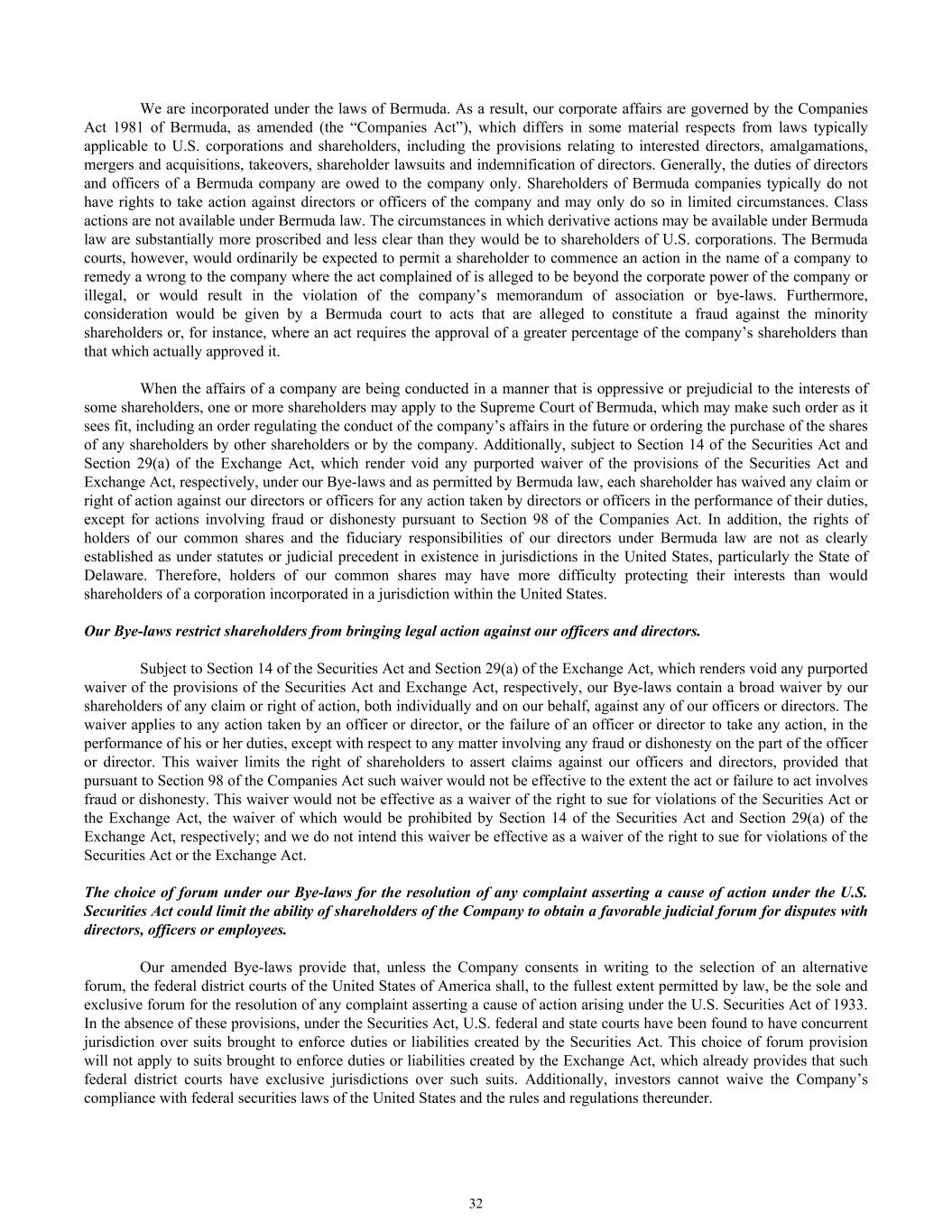
We are incorporated under the laws of Bermuda. As a result, our corporate affairs are governed by the Companies Act 1981 of Bermuda, as amended (the “Companies Act”), which differs in some material respects from laws typically applicable to U.S. corporations and shareholders, including the provisions relating to interested directors, amalgamations, mergers and acquisitions, takeovers, shareholder lawsuits and indemnification of directors. Generally, the duties of directors and officers of a Bermuda company are owed to the company only. Shareholders of Bermuda companies typically do not have rights to take action against directors or officers of the company and may only do so in limited circumstances. Class actions are not available under Bermuda law. The circumstances in which derivative actions may be available under Bermuda law are substantially more proscribed and less clear than they would be to shareholders of U.S. corporations. The Bermuda courts, however, would ordinarily be expected to permit a shareholder to commence an action in the name of a company to remedy a wrong to the company where the act complained of is alleged to be beyond the corporate power of the company or illegal, or would result in the violation of the company’s memorandum of association or bye-laws. Furthermore, consideration would be given by a Bermuda court to acts that are alleged to constitute a fraud against the minority shareholders or, for instance, where an act requires the approval of a greater percentage of the company’s shareholders than that which actually approved it. When the affairs of a company are being conducted in a manner that is oppressive or prejudicial to the interests of some shareholders, one or more shareholders may apply to the Supreme Court of Bermuda, which may make such order as it sees fit, including an order regulating the conduct of the company’s affairs in the future or ordering the purchase of the shares of any shareholders by other shareholders or by the company. Additionally, subject to Section 14 of the Securities Act and Section 29(a) of the Exchange Act, which render void any purported waiver of the provisions of the Securities Act and Exchange Act, respectively, under our Bye-laws and as permitted by Bermuda law, each shareholder has waived any claim or right of action against our directors or officers for any action taken by directors or officers in the performance of their duties, except for actions involving fraud or dishonesty pursuant to Section 98 of the Companies Act. In addition, the rights of holders of our common shares and the fiduciary responsibilities of our directors under Bermuda law are not as clearly established as under statutes or judicial precedent in existence in jurisdictions in the United States, particularly the State of Delaware. Therefore, holders of our common shares may have more difficulty protecting their interests than would shareholders of a corporation incorporated in a jurisdiction within the United States. Our Bye-laws restrict shareholders from bringing legal action against our officers and directors. Subject to Section 14 of the Securities Act and Section 29(a) of the Exchange Act, which renders void any purported waiver of the provisions of the Securities Act and Exchange Act, respectively, our Bye-laws contain a broad waiver by our shareholders of any claim or right of action, both individually and on our behalf, against any of our officers or directors. The waiver applies to any action taken by an officer or director, or the failure of an officer or director to take any action, in the performance of his or her duties, except with respect to any matter involving any fraud or dishonesty on the part of the officer or director. This waiver limits the right of shareholders to assert claims against our officers and directors, provided that pursuant to Section 98 of the Companies Act such waiver would not be effective to the extent the act or failure to act involves fraud or dishonesty. This waiver would not be effective as a waiver of the right to sue for violations of the Securities Act or the Exchange Act, the waiver of which would be prohibited by Section 14 of the Securities Act and Section 29(a) of the Exchange Act, respectively; and we do not intend this waiver be effective as a waiver of the right to sue for violations of the Securities Act or the Exchange Act. The choice of forum under our Bye-laws for the resolution of any complaint asserting a cause of action under the U.S. Securities Act could limit the ability of shareholders of the Company to obtain a favorable judicial forum for disputes with directors, officers or employees. Our amended Bye-laws provide that, unless the Company consents in writing to the selection of an alternative forum, the federal district courts of the United States of America shall, to the fullest extent permitted by law, be the sole and exclusive forum for the resolution of any complaint asserting a cause of action arising under the U.S. Securities Act of 1933. In the absence of these provisions, under the Securities Act, U.S. federal and state courts have been found to have concurrent jurisdiction over suits brought to enforce duties or liabilities created by the Securities Act. This choice of forum provision will not apply to suits brought to enforce duties or liabilities created by the Exchange Act, which already provides that such federal district courts have exclusive jurisdictions over such suits. Additionally, investors cannot waive the Company’s compliance with federal securities laws of the United States and the rules and regulations thereunder. 32
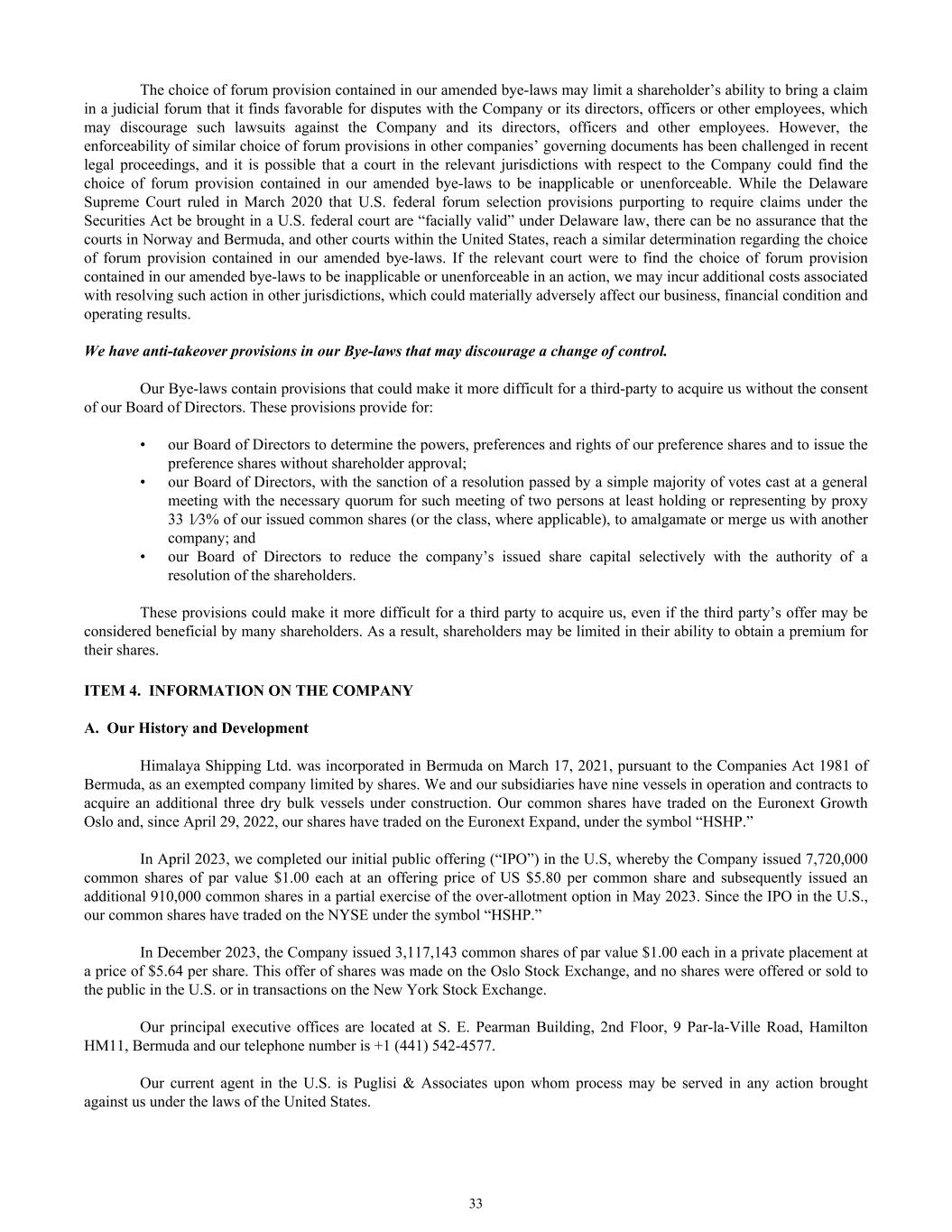
The choice of forum provision contained in our amended bye-laws may limit a shareholder’s ability to bring a claim in a judicial forum that it finds favorable for disputes with the Company or its directors, officers or other employees, which may discourage such lawsuits against the Company and its directors, officers and other employees. However, the enforceability of similar choice of forum provisions in other companies’ governing documents has been challenged in recent legal proceedings, and it is possible that a court in the relevant jurisdictions with respect to the Company could find the choice of forum provision contained in our amended bye-laws to be inapplicable or unenforceable. While the Delaware Supreme Court ruled in March 2020 that U.S. federal forum selection provisions purporting to require claims under the Securities Act be brought in a U.S. federal court are “facially valid” under Delaware law, there can be no assurance that the courts in Norway and Bermuda, and other courts within the United States, reach a similar determination regarding the choice of forum provision contained in our amended bye-laws. If the relevant court were to find the choice of forum provision contained in our amended bye-laws to be inapplicable or unenforceable in an action, we may incur additional costs associated with resolving such action in other jurisdictions, which could materially adversely affect our business, financial condition and operating results. We have anti-takeover provisions in our Bye-laws that may discourage a change of control. Our Bye-laws contain provisions that could make it more difficult for a third-party to acquire us without the consent of our Board of Directors. These provisions provide for: • our Board of Directors to determine the powers, preferences and rights of our preference shares and to issue the preference shares without shareholder approval; • our Board of Directors, with the sanction of a resolution passed by a simple majority of votes cast at a general meeting with the necessary quorum for such meeting of two persons at least holding or representing by proxy 33 1⁄3% of our issued common shares (or the class, where applicable), to amalgamate or merge us with another company; and • our Board of Directors to reduce the company’s issued share capital selectively with the authority of a resolution of the shareholders. These provisions could make it more difficult for a third party to acquire us, even if the third party’s offer may be considered beneficial by many shareholders. As a result, shareholders may be limited in their ability to obtain a premium for their shares. ITEM 4. INFORMATION ON THE COMPANY A. Our History and Development Himalaya Shipping Ltd. was incorporated in Bermuda on March 17, 2021, pursuant to the Companies Act 1981 of Bermuda, as an exempted company limited by shares. We and our subsidiaries have nine vessels in operation and contracts to acquire an additional three dry bulk vessels under construction. Our common shares have traded on the Euronext Growth Oslo and, since April 29, 2022, our shares have traded on the Euronext Expand, under the symbol “HSHP.” In April 2023, we completed our initial public offering (“IPO”) in the U.S, whereby the Company issued 7,720,000 common shares of par value $1.00 each at an offering price of US $5.80 per common share and subsequently issued an additional 910,000 common shares in a partial exercise of the over-allotment option in May 2023. Since the IPO in the U.S., our common shares have traded on the NYSE under the symbol “HSHP.” In December 2023, the Company issued 3,117,143 common shares of par value $1.00 each in a private placement at a price of $5.64 per share. This offer of shares was made on the Oslo Stock Exchange, and no shares were offered or sold to the public in the U.S. or in transactions on the New York Stock Exchange. Our principal executive offices are located at S. E. Pearman Building, 2nd Floor, 9 Par-la-Ville Road, Hamilton HM11, Bermuda and our telephone number is +1 (441) 542-4577. Our current agent in the U.S. is Puglisi & Associates upon whom process may be served in any action brought against us under the laws of the United States. 33
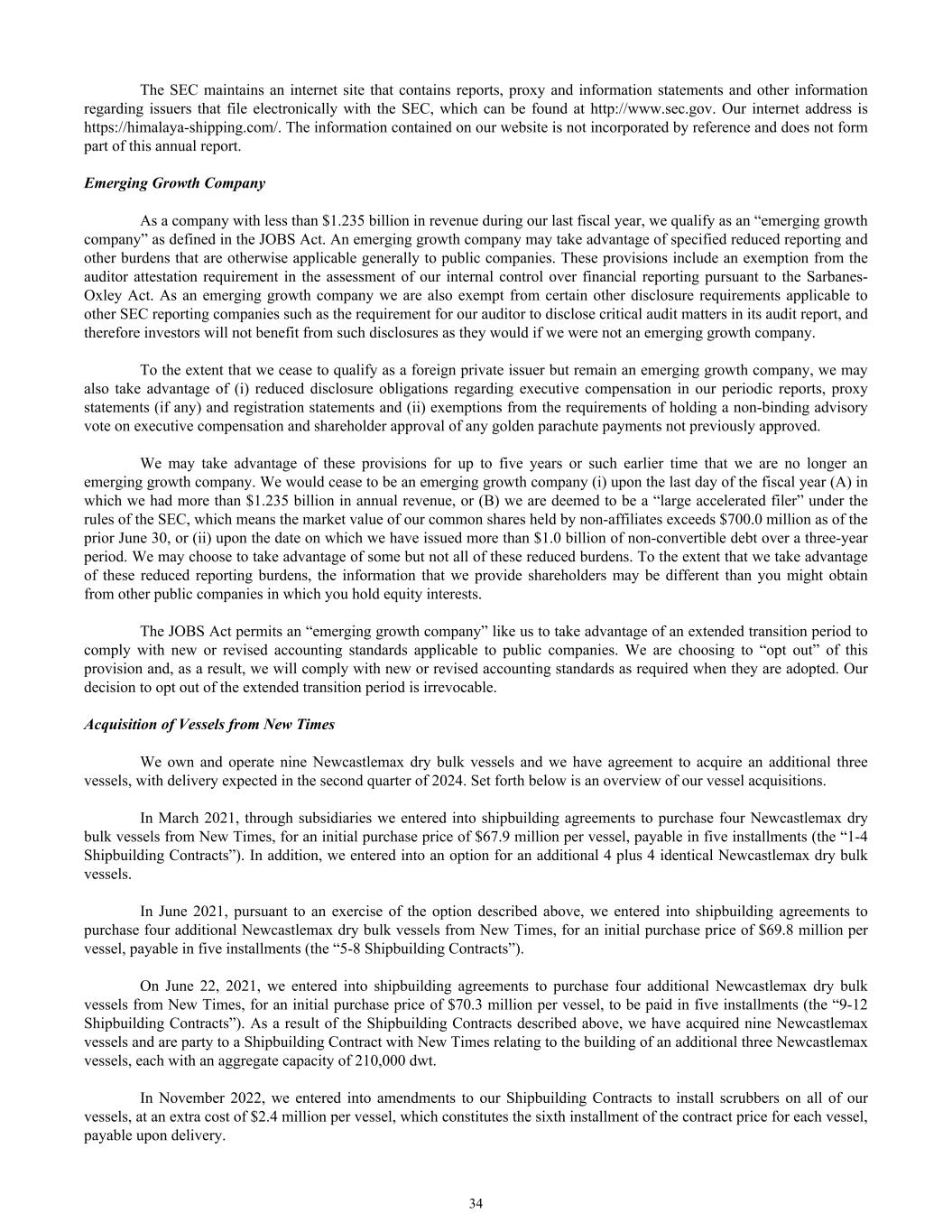
The SEC maintains an internet site that contains reports, proxy and information statements and other information regarding issuers that file electronically with the SEC, which can be found at http://www.sec.gov. Our internet address is https://himalaya-shipping.com/. The information contained on our website is not incorporated by reference and does not form part of this annual report. Emerging Growth Company As a company with less than $1.235 billion in revenue during our last fiscal year, we qualify as an “emerging growth company” as defined in the JOBS Act. An emerging growth company may take advantage of specified reduced reporting and other burdens that are otherwise applicable generally to public companies. These provisions include an exemption from the auditor attestation requirement in the assessment of our internal control over financial reporting pursuant to the Sarbanes- Oxley Act. As an emerging growth company we are also exempt from certain other disclosure requirements applicable to other SEC reporting companies such as the requirement for our auditor to disclose critical audit matters in its audit report, and therefore investors will not benefit from such disclosures as they would if we were not an emerging growth company. To the extent that we cease to qualify as a foreign private issuer but remain an emerging growth company, we may also take advantage of (i) reduced disclosure obligations regarding executive compensation in our periodic reports, proxy statements (if any) and registration statements and (ii) exemptions from the requirements of holding a non-binding advisory vote on executive compensation and shareholder approval of any golden parachute payments not previously approved. We may take advantage of these provisions for up to five years or such earlier time that we are no longer an emerging growth company. We would cease to be an emerging growth company (i) upon the last day of the fiscal year (A) in which we had more than $1.235 billion in annual revenue, or (B) we are deemed to be a “large accelerated filer” under the rules of the SEC, which means the market value of our common shares held by non-affiliates exceeds $700.0 million as of the prior June 30, or (ii) upon the date on which we have issued more than $1.0 billion of non-convertible debt over a three-year period. We may choose to take advantage of some but not all of these reduced burdens. To the extent that we take advantage of these reduced reporting burdens, the information that we provide shareholders may be different than you might obtain from other public companies in which you hold equity interests. The JOBS Act permits an “emerging growth company” like us to take advantage of an extended transition period to comply with new or revised accounting standards applicable to public companies. We are choosing to “opt out” of this provision and, as a result, we will comply with new or revised accounting standards as required when they are adopted. Our decision to opt out of the extended transition period is irrevocable. Acquisition of Vessels from New Times We own and operate nine Newcastlemax dry bulk vessels and we have agreement to acquire an additional three vessels, with delivery expected in the second quarter of 2024. Set forth below is an overview of our vessel acquisitions. In March 2021, through subsidiaries we entered into shipbuilding agreements to purchase four Newcastlemax dry bulk vessels from New Times, for an initial purchase price of $67.9 million per vessel, payable in five installments (the “1-4 Shipbuilding Contracts”). In addition, we entered into an option for an additional 4 plus 4 identical Newcastlemax dry bulk vessels. In June 2021, pursuant to an exercise of the option described above, we entered into shipbuilding agreements to purchase four additional Newcastlemax dry bulk vessels from New Times, for an initial purchase price of $69.8 million per vessel, payable in five installments (the “5-8 Shipbuilding Contracts”). On June 22, 2021, we entered into shipbuilding agreements to purchase four additional Newcastlemax dry bulk vessels from New Times, for an initial purchase price of $70.3 million per vessel, to be paid in five installments (the “9-12 Shipbuilding Contracts”). As a result of the Shipbuilding Contracts described above, we have acquired nine Newcastlemax vessels and are party to a Shipbuilding Contract with New Times relating to the building of an additional three Newcastlemax vessels, each with an aggregate capacity of 210,000 dwt. In November 2022, we entered into amendments to our Shipbuilding Contracts to install scrubbers on all of our vessels, at an extra cost of $2.4 million per vessel, which constitutes the sixth installment of the contract price for each vessel, payable upon delivery. 34
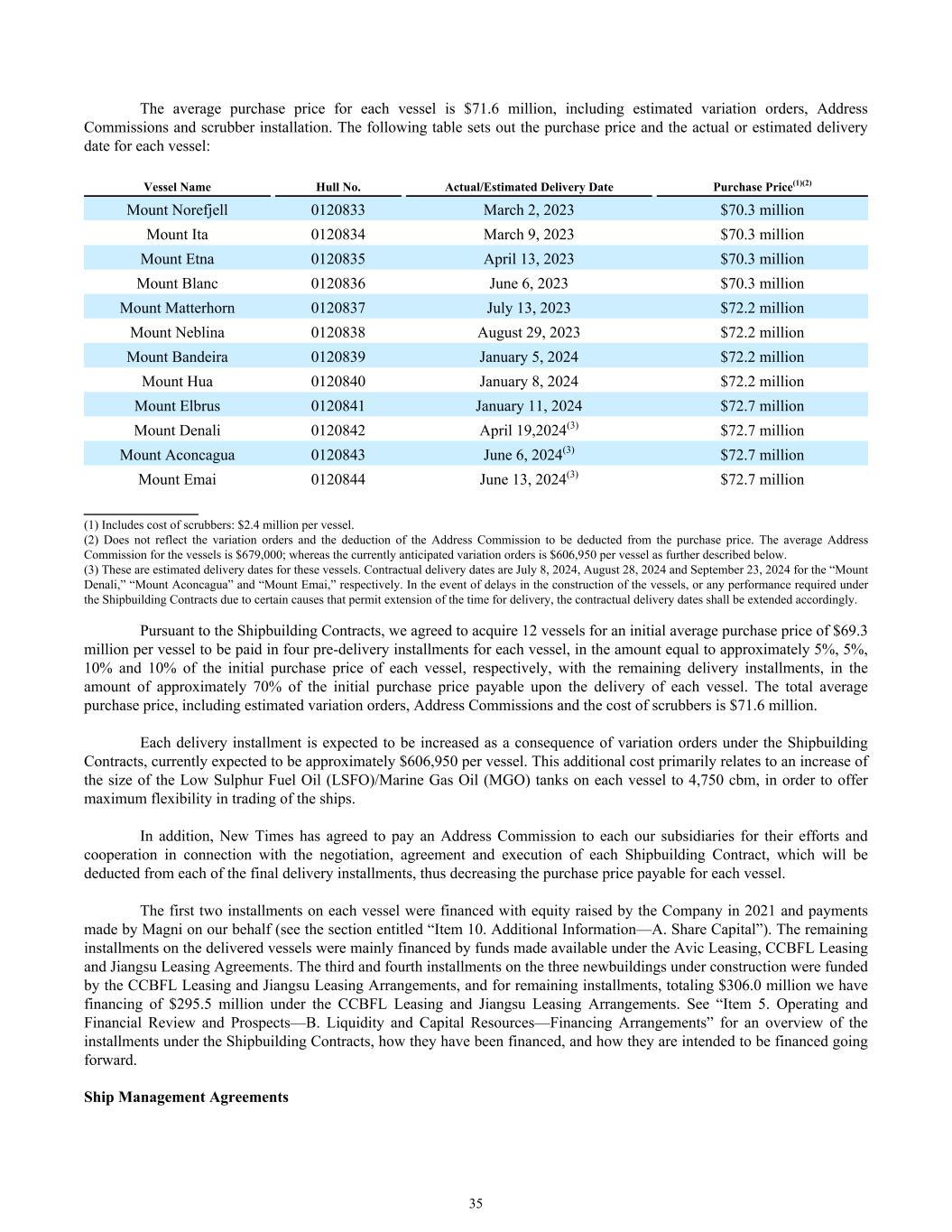
The average purchase price for each vessel is $71.6 million, including estimated variation orders, Address Commissions and scrubber installation. The following table sets out the purchase price and the actual or estimated delivery date for each vessel: Vessel Name Hull No. Actual/Estimated Delivery Date Purchase Price(1)(2) Mount Norefjell 0120833 March 2, 2023 $70.3 million Mount Ita 0120834 March 9, 2023 $70.3 million Mount Etna 0120835 April 13, 2023 $70.3 million Mount Blanc 0120836 June 6, 2023 $70.3 million Mount Matterhorn 0120837 July 13, 2023 $72.2 million Mount Neblina 0120838 August 29, 2023 $72.2 million Mount Bandeira 0120839 January 5, 2024 $72.2 million Mount Hua 0120840 January 8, 2024 $72.2 million Mount Elbrus 0120841 January 11, 2024 $72.7 million Mount Denali 0120842 April 19,2024(3) $72.7 million Mount Aconcagua 0120843 June 6, 2024(3) $72.7 million Mount Emai 0120844 June 13, 2024(3) $72.7 million ___________ (1) Includes cost of scrubbers: $2.4 million per vessel. (2) Does not reflect the variation orders and the deduction of the Address Commission to be deducted from the purchase price. The average Address Commission for the vessels is $679,000; whereas the currently anticipated variation orders is $606,950 per vessel as further described below. (3) These are estimated delivery dates for these vessels. Contractual delivery dates are July 8, 2024, August 28, 2024 and September 23, 2024 for the “Mount Denali,” “Mount Aconcagua” and “Mount Emai,” respectively. In the event of delays in the construction of the vessels, or any performance required under the Shipbuilding Contracts due to certain causes that permit extension of the time for delivery, the contractual delivery dates shall be extended accordingly. Pursuant to the Shipbuilding Contracts, we agreed to acquire 12 vessels for an initial average purchase price of $69.3 million per vessel to be paid in four pre-delivery installments for each vessel, in the amount equal to approximately 5%, 5%, 10% and 10% of the initial purchase price of each vessel, respectively, with the remaining delivery installments, in the amount of approximately 70% of the initial purchase price payable upon the delivery of each vessel. The total average purchase price, including estimated variation orders, Address Commissions and the cost of scrubbers is $71.6 million. Each delivery installment is expected to be increased as a consequence of variation orders under the Shipbuilding Contracts, currently expected to be approximately $606,950 per vessel. This additional cost primarily relates to an increase of the size of the Low Sulphur Fuel Oil (LSFO)/Marine Gas Oil (MGO) tanks on each vessel to 4,750 cbm, in order to offer maximum flexibility in trading of the ships. In addition, New Times has agreed to pay an Address Commission to each our subsidiaries for their efforts and cooperation in connection with the negotiation, agreement and execution of each Shipbuilding Contract, which will be deducted from each of the final delivery installments, thus decreasing the purchase price payable for each vessel. The first two installments on each vessel were financed with equity raised by the Company in 2021 and payments made by Magni on our behalf (see the section entitled “Item 10. Additional Information—A. Share Capital”). The remaining installments on the delivered vessels were mainly financed by funds made available under the Avic Leasing, CCBFL Leasing and Jiangsu Leasing Agreements. The third and fourth installments on the three newbuildings under construction were funded by the CCBFL Leasing and Jiangsu Leasing Arrangements, and for remaining installments, totaling $306.0 million we have financing of $295.5 million under the CCBFL Leasing and Jiangsu Leasing Arrangements. See “Item 5. Operating and Financial Review and Prospects—B. Liquidity and Capital Resources—Financing Arrangements” for an overview of the installments under the Shipbuilding Contracts, how they have been financed, and how they are intended to be financed going forward. Ship Management Agreements 35
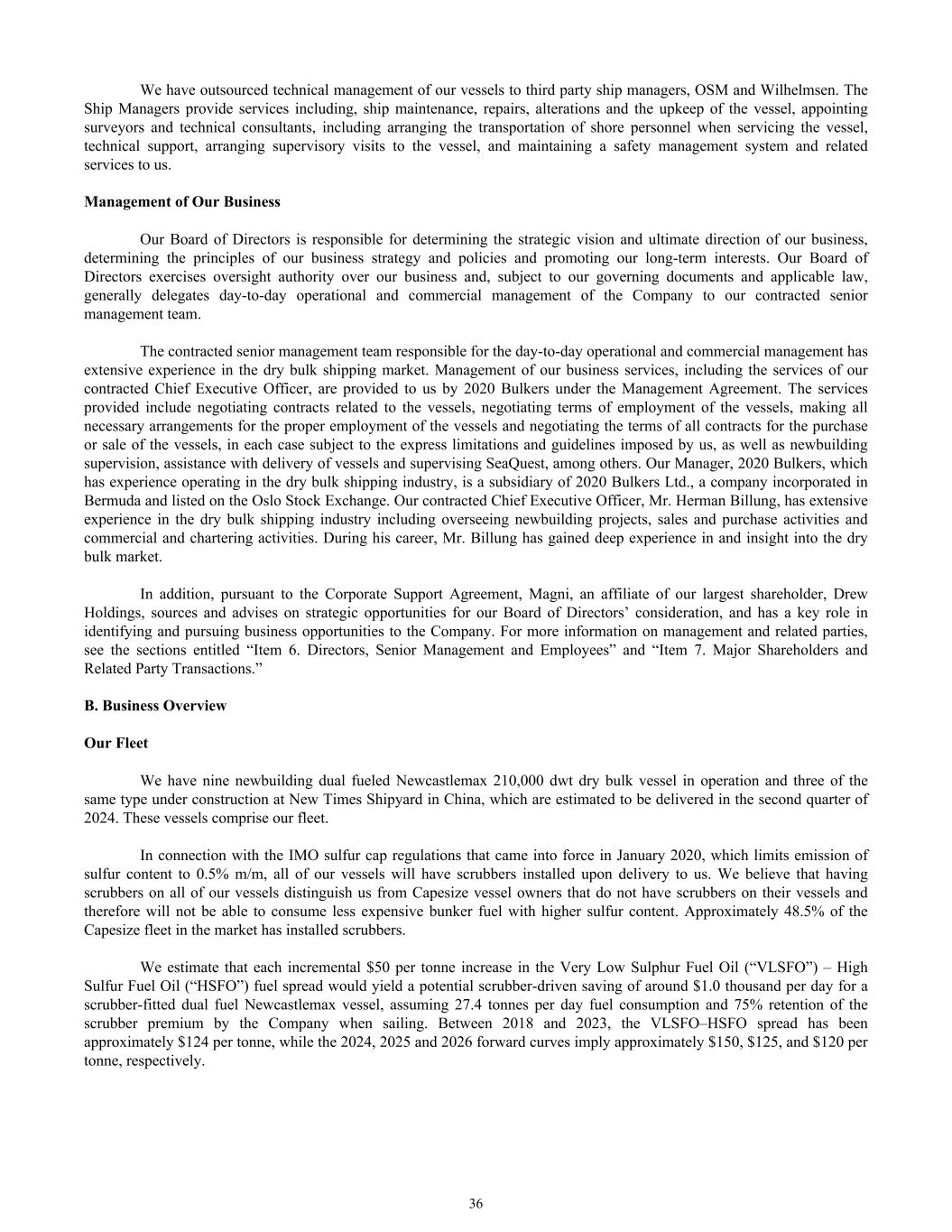
We have outsourced technical management of our vessels to third party ship managers, OSM and Wilhelmsen. The Ship Managers provide services including, ship maintenance, repairs, alterations and the upkeep of the vessel, appointing surveyors and technical consultants, including arranging the transportation of shore personnel when servicing the vessel, technical support, arranging supervisory visits to the vessel, and maintaining a safety management system and related services to us. Management of Our Business Our Board of Directors is responsible for determining the strategic vision and ultimate direction of our business, determining the principles of our business strategy and policies and promoting our long-term interests. Our Board of Directors exercises oversight authority over our business and, subject to our governing documents and applicable law, generally delegates day-to-day operational and commercial management of the Company to our contracted senior management team. The contracted senior management team responsible for the day-to-day operational and commercial management has extensive experience in the dry bulk shipping market. Management of our business services, including the services of our contracted Chief Executive Officer, are provided to us by 2020 Bulkers under the Management Agreement. The services provided include negotiating contracts related to the vessels, negotiating terms of employment of the vessels, making all necessary arrangements for the proper employment of the vessels and negotiating the terms of all contracts for the purchase or sale of the vessels, in each case subject to the express limitations and guidelines imposed by us, as well as newbuilding supervision, assistance with delivery of vessels and supervising SeaQuest, among others. Our Manager, 2020 Bulkers, which has experience operating in the dry bulk shipping industry, is a subsidiary of 2020 Bulkers Ltd., a company incorporated in Bermuda and listed on the Oslo Stock Exchange. Our contracted Chief Executive Officer, Mr. Herman Billung, has extensive experience in the dry bulk shipping industry including overseeing newbuilding projects, sales and purchase activities and commercial and chartering activities. During his career, Mr. Billung has gained deep experience in and insight into the dry bulk market. In addition, pursuant to the Corporate Support Agreement, Magni, an affiliate of our largest shareholder, Drew Holdings, sources and advises on strategic opportunities for our Board of Directors’ consideration, and has a key role in identifying and pursuing business opportunities to the Company. For more information on management and related parties, see the sections entitled “Item 6. Directors, Senior Management and Employees” and “Item 7. Major Shareholders and Related Party Transactions.” B. Business Overview Our Fleet We have nine newbuilding dual fueled Newcastlemax 210,000 dwt dry bulk vessel in operation and three of the same type under construction at New Times Shipyard in China, which are estimated to be delivered in the second quarter of 2024. These vessels comprise our fleet. In connection with the IMO sulfur cap regulations that came into force in January 2020, which limits emission of sulfur content to 0.5% m/m, all of our vessels will have scrubbers installed upon delivery to us. We believe that having scrubbers on all of our vessels distinguish us from Capesize vessel owners that do not have scrubbers on their vessels and therefore will not be able to consume less expensive bunker fuel with higher sulfur content. Approximately 48.5% of the Capesize fleet in the market has installed scrubbers. We estimate that each incremental $50 per tonne increase in the Very Low Sulphur Fuel Oil (“VLSFO”) – High Sulfur Fuel Oil (“HSFO”) fuel spread would yield a potential scrubber-driven saving of around $1.0 thousand per day for a scrubber-fitted dual fuel Newcastlemax vessel, assuming 27.4 tonnes per day fuel consumption and 75% retention of the scrubber premium by the Company when sailing. Between 2018 and 2023, the VLSFO–HSFO spread has been approximately $124 per tonne, while the 2024, 2025 and 2026 forward curves imply approximately $150, $125, and $120 per tonne, respectively. 36
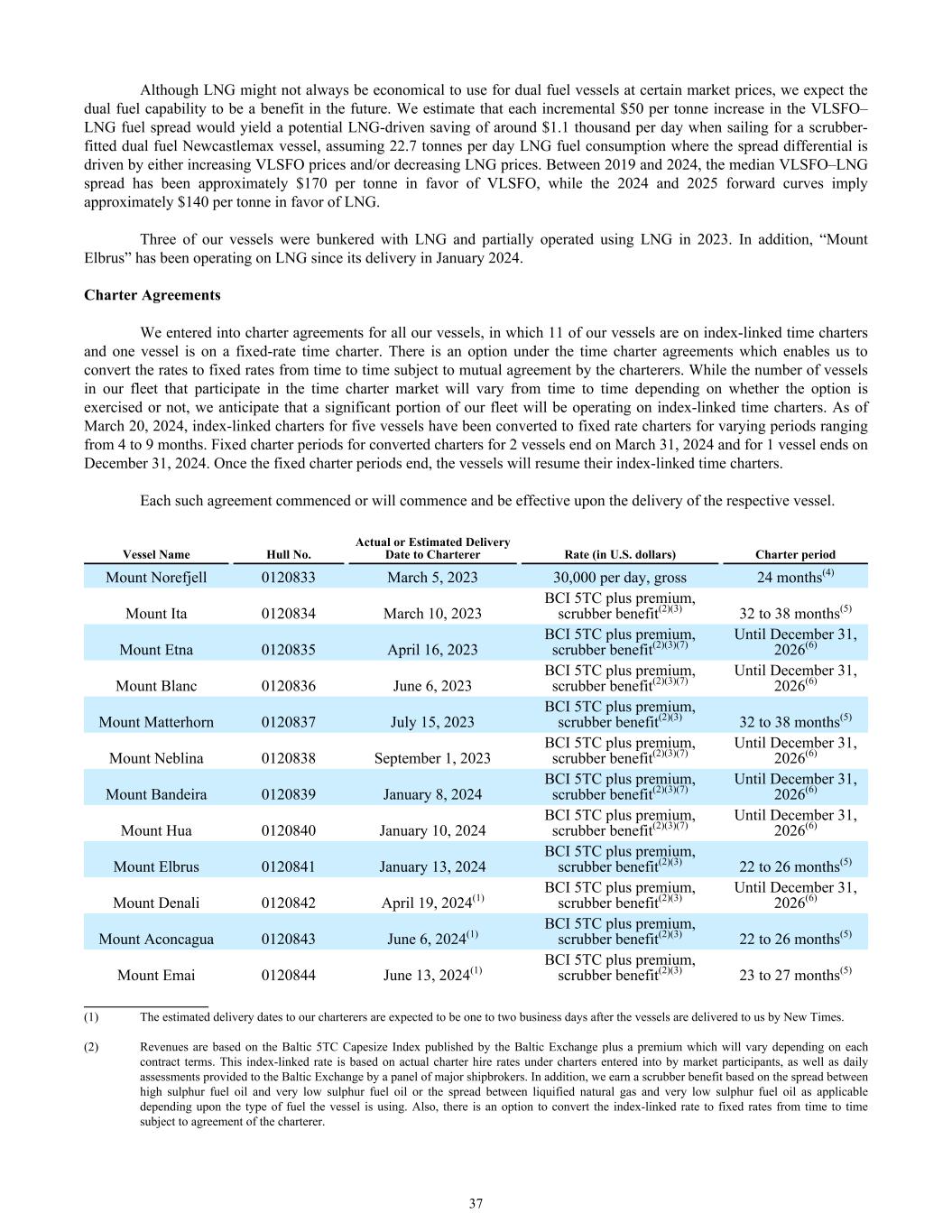
Although LNG might not always be economical to use for dual fuel vessels at certain market prices, we expect the dual fuel capability to be a benefit in the future. We estimate that each incremental $50 per tonne increase in the VLSFO– LNG fuel spread would yield a potential LNG-driven saving of around $1.1 thousand per day when sailing for a scrubber- fitted dual fuel Newcastlemax vessel, assuming 22.7 tonnes per day LNG fuel consumption where the spread differential is driven by either increasing VLSFO prices and/or decreasing LNG prices. Between 2019 and 2024, the median VLSFO–LNG spread has been approximately $170 per tonne in favor of VLSFO, while the 2024 and 2025 forward curves imply approximately $140 per tonne in favor of LNG. Three of our vessels were bunkered with LNG and partially operated using LNG in 2023. In addition, “Mount Elbrus” has been operating on LNG since its delivery in January 2024. Charter Agreements We entered into charter agreements for all our vessels, in which 11 of our vessels are on index-linked time charters and one vessel is on a fixed-rate time charter. There is an option under the time charter agreements which enables us to convert the rates to fixed rates from time to time subject to mutual agreement by the charterers. While the number of vessels in our fleet that participate in the time charter market will vary from time to time depending on whether the option is exercised or not, we anticipate that a significant portion of our fleet will be operating on index-linked time charters. As of March 20, 2024, index-linked charters for five vessels have been converted to fixed rate charters for varying periods ranging from 4 to 9 months. Fixed charter periods for converted charters for 2 vessels end on March 31, 2024 and for 1 vessel ends on December 31, 2024. Once the fixed charter periods end, the vessels will resume their index-linked time charters. Each such agreement commenced or will commence and be effective upon the delivery of the respective vessel. Vessel Name Hull No. Actual or Estimated Delivery Date to Charterer Rate (in U.S. dollars) Charter period Mount Norefjell 0120833 March 5, 2023 30,000 per day, gross 24 months(4) Mount Ita 0120834 March 10, 2023 BCI 5TC plus premium, scrubber benefit(2)(3) 32 to 38 months(5) Mount Etna 0120835 April 16, 2023 BCI 5TC plus premium, scrubber benefit(2)(3)(7) Until December 31, 2026(6) Mount Blanc 0120836 June 6, 2023 BCI 5TC plus premium, scrubber benefit(2)(3)(7) Until December 31, 2026(6) Mount Matterhorn 0120837 July 15, 2023 BCI 5TC plus premium, scrubber benefit(2)(3) 32 to 38 months(5) Mount Neblina 0120838 September 1, 2023 BCI 5TC plus premium, scrubber benefit(2)(3)(7) Until December 31, 2026(6) Mount Bandeira 0120839 January 8, 2024 BCI 5TC plus premium, scrubber benefit(2)(3)(7) Until December 31, 2026(6) Mount Hua 0120840 January 10, 2024 BCI 5TC plus premium, scrubber benefit(2)(3)(7) Until December 31, 2026(6) Mount Elbrus 0120841 January 13, 2024 BCI 5TC plus premium, scrubber benefit(2)(3) 22 to 26 months(5) Mount Denali 0120842 April 19, 2024(1) BCI 5TC plus premium, scrubber benefit(2)(3) Until December 31, 2026(6) Mount Aconcagua 0120843 June 6, 2024(1) BCI 5TC plus premium, scrubber benefit(2)(3) 22 to 26 months(5) Mount Emai 0120844 June 13, 2024(1) BCI 5TC plus premium, scrubber benefit(2)(3) 23 to 27 months(5) ________________ (1) The estimated delivery dates to our charterers are expected to be one to two business days after the vessels are delivered to us by New Times. (2) Revenues are based on the Baltic 5TC Capesize Index published by the Baltic Exchange plus a premium which will vary depending on each contract terms. This index-linked rate is based on actual charter hire rates under charters entered into by market participants, as well as daily assessments provided to the Baltic Exchange by a panel of major shipbrokers. In addition, we earn a scrubber benefit based on the spread between high sulphur fuel oil and very low sulphur fuel oil or the spread between liquified natural gas and very low sulphur fuel oil as applicable depending upon the type of fuel the vessel is using. Also, there is an option to convert the index-linked rate to fixed rates from time to time subject to agreement of the charterer. 37
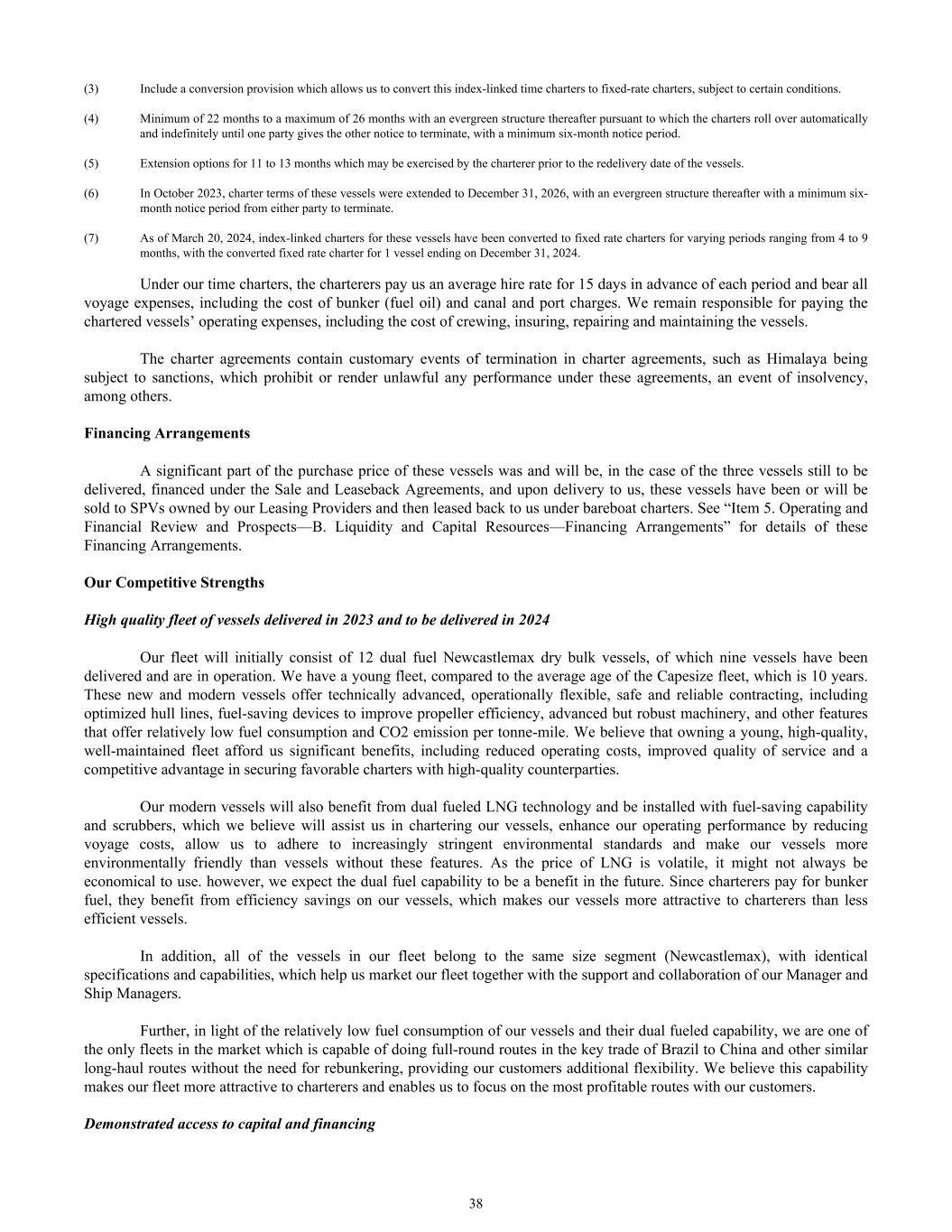
(3) Include a conversion provision which allows us to convert this index-linked time charters to fixed-rate charters, subject to certain conditions. (4) Minimum of 22 months to a maximum of 26 months with an evergreen structure thereafter pursuant to which the charters roll over automatically and indefinitely until one party gives the other notice to terminate, with a minimum six-month notice period. (5) Extension options for 11 to 13 months which may be exercised by the charterer prior to the redelivery date of the vessels. (6) In October 2023, charter terms of these vessels were extended to December 31, 2026, with an evergreen structure thereafter with a minimum six- month notice period from either party to terminate. (7) As of March 20, 2024, index-linked charters for these vessels have been converted to fixed rate charters for varying periods ranging from 4 to 9 months, with the converted fixed rate charter for 1 vessel ending on December 31, 2024. Under our time charters, the charterers pay us an average hire rate for 15 days in advance of each period and bear all voyage expenses, including the cost of bunker (fuel oil) and canal and port charges. We remain responsible for paying the chartered vessels’ operating expenses, including the cost of crewing, insuring, repairing and maintaining the vessels. The charter agreements contain customary events of termination in charter agreements, such as Himalaya being subject to sanctions, which prohibit or render unlawful any performance under these agreements, an event of insolvency, among others. Financing Arrangements A significant part of the purchase price of these vessels was and will be, in the case of the three vessels still to be delivered, financed under the Sale and Leaseback Agreements, and upon delivery to us, these vessels have been or will be sold to SPVs owned by our Leasing Providers and then leased back to us under bareboat charters. See “Item 5. Operating and Financial Review and Prospects—B. Liquidity and Capital Resources—Financing Arrangements” for details of these Financing Arrangements. Our Competitive Strengths High quality fleet of vessels delivered in 2023 and to be delivered in 2024 Our fleet will initially consist of 12 dual fuel Newcastlemax dry bulk vessels, of which nine vessels have been delivered and are in operation. We have a young fleet, compared to the average age of the Capesize fleet, which is 10 years. These new and modern vessels offer technically advanced, operationally flexible, safe and reliable contracting, including optimized hull lines, fuel-saving devices to improve propeller efficiency, advanced but robust machinery, and other features that offer relatively low fuel consumption and CO2 emission per tonne-mile. We believe that owning a young, high-quality, well-maintained fleet afford us significant benefits, including reduced operating costs, improved quality of service and a competitive advantage in securing favorable charters with high-quality counterparties. Our modern vessels will also benefit from dual fueled LNG technology and be installed with fuel-saving capability and scrubbers, which we believe will assist us in chartering our vessels, enhance our operating performance by reducing voyage costs, allow us to adhere to increasingly stringent environmental standards and make our vessels more environmentally friendly than vessels without these features. As the price of LNG is volatile, it might not always be economical to use. however, we expect the dual fuel capability to be a benefit in the future. Since charterers pay for bunker fuel, they benefit from efficiency savings on our vessels, which makes our vessels more attractive to charterers than less efficient vessels. In addition, all of the vessels in our fleet belong to the same size segment (Newcastlemax), with identical specifications and capabilities, which help us market our fleet together with the support and collaboration of our Manager and Ship Managers. Further, in light of the relatively low fuel consumption of our vessels and their dual fueled capability, we are one of the only fleets in the market which is capable of doing full-round routes in the key trade of Brazil to China and other similar long-haul routes without the need for rebunkering, providing our customers additional flexibility. We believe this capability makes our fleet more attractive to charterers and enables us to focus on the most profitable routes with our customers. Demonstrated access to capital and financing 38
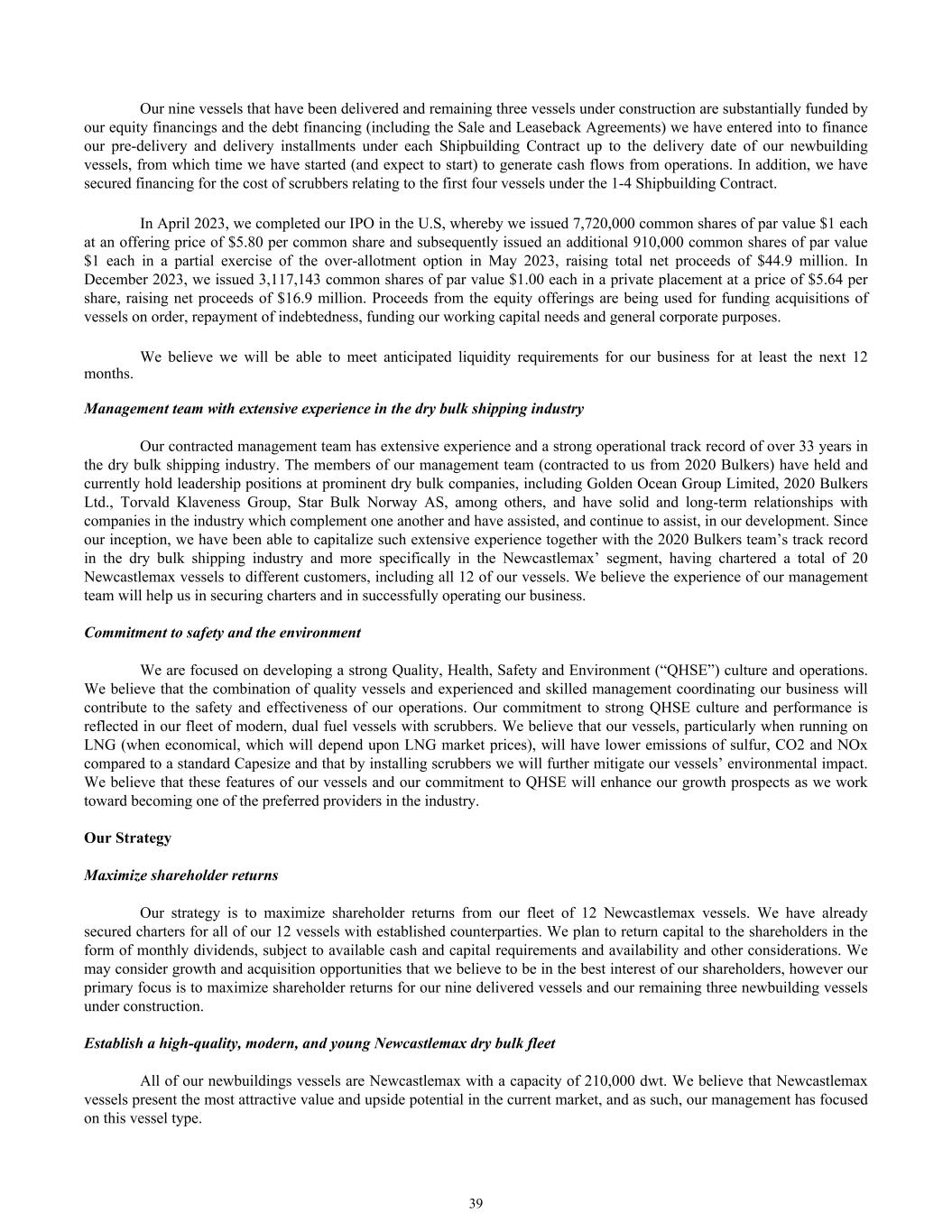
Our nine vessels that have been delivered and remaining three vessels under construction are substantially funded by our equity financings and the debt financing (including the Sale and Leaseback Agreements) we have entered into to finance our pre-delivery and delivery installments under each Shipbuilding Contract up to the delivery date of our newbuilding vessels, from which time we have started (and expect to start) to generate cash flows from operations. In addition, we have secured financing for the cost of scrubbers relating to the first four vessels under the 1-4 Shipbuilding Contract. In April 2023, we completed our IPO in the U.S, whereby we issued 7,720,000 common shares of par value $1 each at an offering price of $5.80 per common share and subsequently issued an additional 910,000 common shares of par value $1 each in a partial exercise of the over-allotment option in May 2023, raising total net proceeds of $44.9 million. In December 2023, we issued 3,117,143 common shares of par value $1.00 each in a private placement at a price of $5.64 per share, raising net proceeds of $16.9 million. Proceeds from the equity offerings are being used for funding acquisitions of vessels on order, repayment of indebtedness, funding our working capital needs and general corporate purposes. We believe we will be able to meet anticipated liquidity requirements for our business for at least the next 12 months. Management team with extensive experience in the dry bulk shipping industry Our contracted management team has extensive experience and a strong operational track record of over 33 years in the dry bulk shipping industry. The members of our management team (contracted to us from 2020 Bulkers) have held and currently hold leadership positions at prominent dry bulk companies, including Golden Ocean Group Limited, 2020 Bulkers Ltd., Torvald Klaveness Group, Star Bulk Norway AS, among others, and have solid and long-term relationships with companies in the industry which complement one another and have assisted, and continue to assist, in our development. Since our inception, we have been able to capitalize such extensive experience together with the 2020 Bulkers team’s track record in the dry bulk shipping industry and more specifically in the Newcastlemax’ segment, having chartered a total of 20 Newcastlemax vessels to different customers, including all 12 of our vessels. We believe the experience of our management team will help us in securing charters and in successfully operating our business. Commitment to safety and the environment We are focused on developing a strong Quality, Health, Safety and Environment (“QHSE”) culture and operations. We believe that the combination of quality vessels and experienced and skilled management coordinating our business will contribute to the safety and effectiveness of our operations. Our commitment to strong QHSE culture and performance is reflected in our fleet of modern, dual fuel vessels with scrubbers. We believe that our vessels, particularly when running on LNG (when economical, which will depend upon LNG market prices), will have lower emissions of sulfur, CO2 and NOx compared to a standard Capesize and that by installing scrubbers we will further mitigate our vessels’ environmental impact. We believe that these features of our vessels and our commitment to QHSE will enhance our growth prospects as we work toward becoming one of the preferred providers in the industry. Our Strategy Maximize shareholder returns Our strategy is to maximize shareholder returns from our fleet of 12 Newcastlemax vessels. We have already secured charters for all of our 12 vessels with established counterparties. We plan to return capital to the shareholders in the form of monthly dividends, subject to available cash and capital requirements and availability and other considerations. We may consider growth and acquisition opportunities that we believe to be in the best interest of our shareholders, however our primary focus is to maximize shareholder returns for our nine delivered vessels and our remaining three newbuilding vessels under construction. Establish a high-quality, modern, and young Newcastlemax dry bulk fleet All of our newbuildings vessels are Newcastlemax with a capacity of 210,000 dwt. We believe that Newcastlemax vessels present the most attractive value and upside potential in the current market, and as such, our management has focused on this vessel type. 39
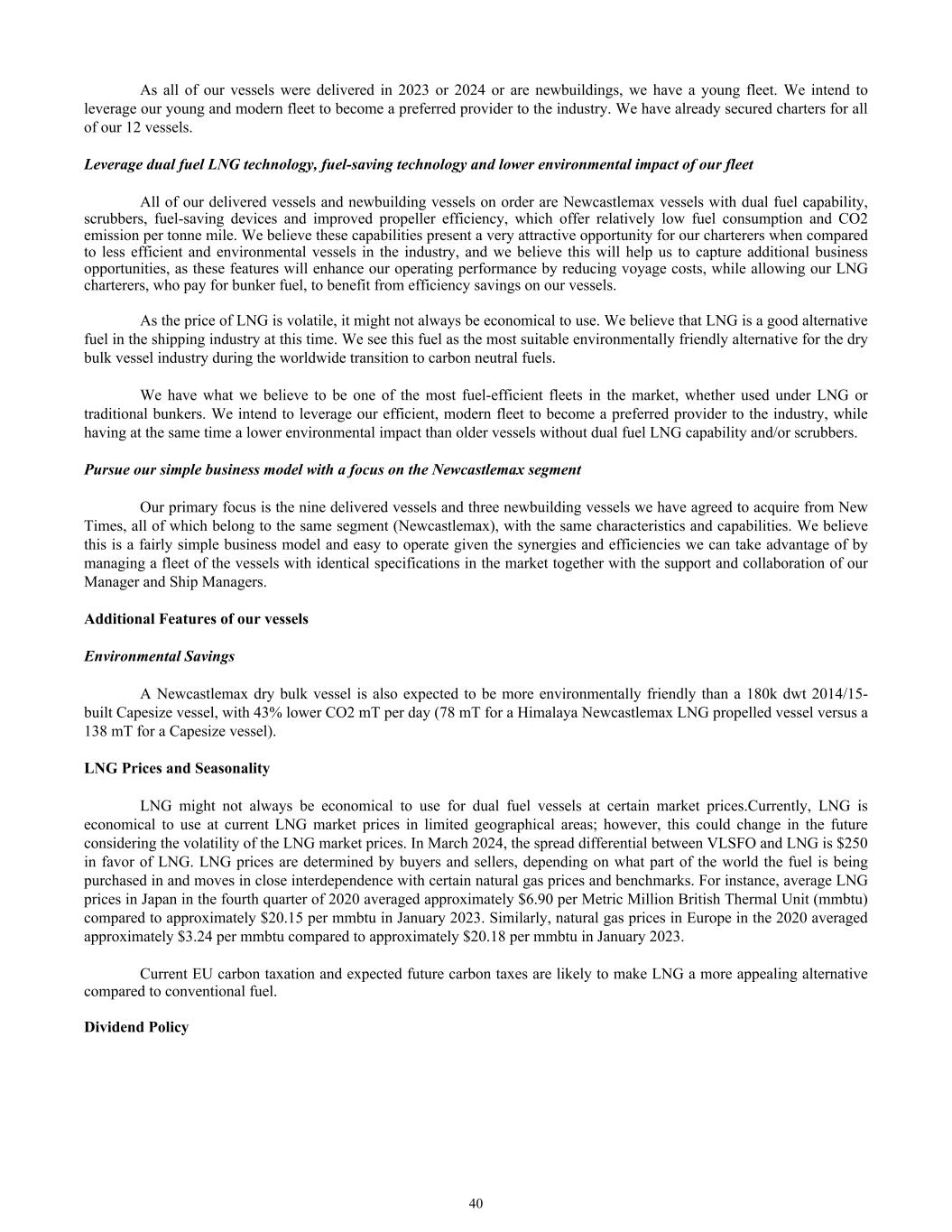
As all of our vessels were delivered in 2023 or 2024 or are newbuildings, we have a young fleet. We intend to leverage our young and modern fleet to become a preferred provider to the industry. We have already secured charters for all of our 12 vessels. Leverage dual fuel LNG technology, fuel-saving technology and lower environmental impact of our fleet All of our delivered vessels and newbuilding vessels on order are Newcastlemax vessels with dual fuel capability, scrubbers, fuel-saving devices and improved propeller efficiency, which offer relatively low fuel consumption and CO2 emission per tonne mile. We believe these capabilities present a very attractive opportunity for our charterers when compared to less efficient and environmental vessels in the industry, and we believe this will help us to capture additional business opportunities, as these features will enhance our operating performance by reducing voyage costs, while allowing our LNG charterers, who pay for bunker fuel, to benefit from efficiency savings on our vessels. As the price of LNG is volatile, it might not always be economical to use. We believe that LNG is a good alternative fuel in the shipping industry at this time. We see this fuel as the most suitable environmentally friendly alternative for the dry bulk vessel industry during the worldwide transition to carbon neutral fuels. We have what we believe to be one of the most fuel-efficient fleets in the market, whether used under LNG or traditional bunkers. We intend to leverage our efficient, modern fleet to become a preferred provider to the industry, while having at the same time a lower environmental impact than older vessels without dual fuel LNG capability and/or scrubbers. Pursue our simple business model with a focus on the Newcastlemax segment Our primary focus is the nine delivered vessels and three newbuilding vessels we have agreed to acquire from New Times, all of which belong to the same segment (Newcastlemax), with the same characteristics and capabilities. We believe this is a fairly simple business model and easy to operate given the synergies and efficiencies we can take advantage of by managing a fleet of the vessels with identical specifications in the market together with the support and collaboration of our Manager and Ship Managers. Additional Features of our vessels Environmental Savings A Newcastlemax dry bulk vessel is also expected to be more environmentally friendly than a 180k dwt 2014/15- built Capesize vessel, with 43% lower CO2 mT per day (78 mT for a Himalaya Newcastlemax LNG propelled vessel versus a 138 mT for a Capesize vessel). LNG Prices and Seasonality LNG might not always be economical to use for dual fuel vessels at certain market prices.Currently, LNG is economical to use at current LNG market prices in limited geographical areas; however, this could change in the future considering the volatility of the LNG market prices. In March 2024, the spread differential between VLSFO and LNG is $250 in favor of LNG. LNG prices are determined by buyers and sellers, depending on what part of the world the fuel is being purchased in and moves in close interdependence with certain natural gas prices and benchmarks. For instance, average LNG prices in Japan in the fourth quarter of 2020 averaged approximately $6.90 per Metric Million British Thermal Unit (mmbtu) compared to approximately $20.15 per mmbtu in January 2023. Similarly, natural gas prices in Europe in the 2020 averaged approximately $3.24 per mmbtu compared to approximately $20.18 per mmbtu in January 2023. Current EU carbon taxation and expected future carbon taxes are likely to make LNG a more appealing alternative compared to conventional fuel. Dividend Policy 40
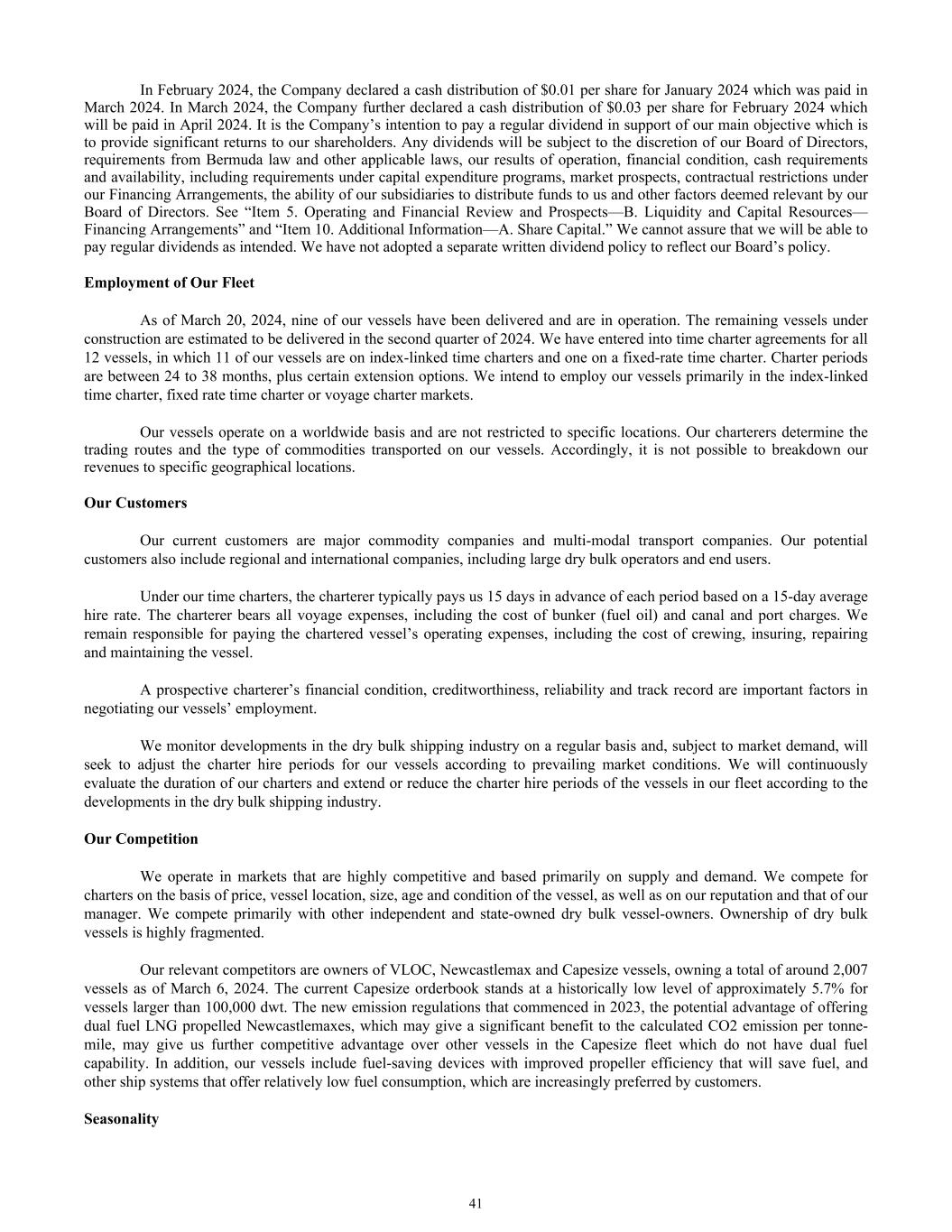
In February 2024, the Company declared a cash distribution of $0.01 per share for January 2024 which was paid in March 2024. In March 2024, the Company further declared a cash distribution of $0.03 per share for February 2024 which will be paid in April 2024. It is the Company’s intention to pay a regular dividend in support of our main objective which is to provide significant returns to our shareholders. Any dividends will be subject to the discretion of our Board of Directors, requirements from Bermuda law and other applicable laws, our results of operation, financial condition, cash requirements and availability, including requirements under capital expenditure programs, market prospects, contractual restrictions under our Financing Arrangements, the ability of our subsidiaries to distribute funds to us and other factors deemed relevant by our Board of Directors. See “Item 5. Operating and Financial Review and Prospects—B. Liquidity and Capital Resources— Financing Arrangements” and “Item 10. Additional Information—A. Share Capital.” We cannot assure that we will be able to pay regular dividends as intended. We have not adopted a separate written dividend policy to reflect our Board’s policy. Employment of Our Fleet As of March 20, 2024, nine of our vessels have been delivered and are in operation. The remaining vessels under construction are estimated to be delivered in the second quarter of 2024. We have entered into time charter agreements for all 12 vessels, in which 11 of our vessels are on index-linked time charters and one on a fixed-rate time charter. Charter periods are between 24 to 38 months, plus certain extension options. We intend to employ our vessels primarily in the index-linked time charter, fixed rate time charter or voyage charter markets. Our vessels operate on a worldwide basis and are not restricted to specific locations. Our charterers determine the trading routes and the type of commodities transported on our vessels. Accordingly, it is not possible to breakdown our revenues to specific geographical locations. Our Customers Our current customers are major commodity companies and multi-modal transport companies. Our potential customers also include regional and international companies, including large dry bulk operators and end users. Under our time charters, the charterer typically pays us 15 days in advance of each period based on a 15-day average hire rate. The charterer bears all voyage expenses, including the cost of bunker (fuel oil) and canal and port charges. We remain responsible for paying the chartered vessel’s operating expenses, including the cost of crewing, insuring, repairing and maintaining the vessel. A prospective charterer’s financial condition, creditworthiness, reliability and track record are important factors in negotiating our vessels’ employment. We monitor developments in the dry bulk shipping industry on a regular basis and, subject to market demand, will seek to adjust the charter hire periods for our vessels according to prevailing market conditions. We will continuously evaluate the duration of our charters and extend or reduce the charter hire periods of the vessels in our fleet according to the developments in the dry bulk shipping industry. Our Competition We operate in markets that are highly competitive and based primarily on supply and demand. We compete for charters on the basis of price, vessel location, size, age and condition of the vessel, as well as on our reputation and that of our manager. We compete primarily with other independent and state-owned dry bulk vessel-owners. Ownership of dry bulk vessels is highly fragmented. Our relevant competitors are owners of VLOC, Newcastlemax and Capesize vessels, owning a total of around 2,007 vessels as of March 6, 2024. The current Capesize orderbook stands at a historically low level of approximately 5.7% for vessels larger than 100,000 dwt. The new emission regulations that commenced in 2023, the potential advantage of offering dual fuel LNG propelled Newcastlemaxes, which may give a significant benefit to the calculated CO2 emission per tonne- mile, may give us further competitive advantage over other vessels in the Capesize fleet which do not have dual fuel capability. In addition, our vessels include fuel-saving devices with improved propeller efficiency that will save fuel, and other ship systems that offer relatively low fuel consumption, which are increasingly preferred by customers. Seasonality 41

We operate our vessels in markets that have historically exhibited seasonal variations in demand, particularly in the Capesize segment given its share of the iron ore trade, and, as a result, in charter hire rates. As China is the most significant market for dry bulk shipping, the public holidays in relation to the Chinese New Year during the first quarter usually results in a decrease in market activity during this period. In addition, unpredictable and adverse weather conditions and patterns in the Southern Hemisphere, which often occur during the first quarter, in the past have had a negative impact on iron ore exports from Australia and from Brazil. Further, certain of the largest iron ore producers in Brazil usually schedule maintenance works on their plants in the first quarter which also results in a decrease on iron ore export from Brazil. This seasonality may materially affect our operating results and cash available for dividends. The dry bulk shipping industry The Capesize market performed strongly in the fourth quarter of 2023, with the Baltic 5TC index averaging $28,836, an increase from $13,407 during the third quarter. The strong drivers were Brazilian iron ore exports, as well as higher Bauxite exports out of West Africa. The trend has continued into 2024, with rates for early February at the highest seasonal levels since 2010. The principal cargo markets for large dry bulk vessels are iron ore, bauxite and to a lesser extent coal. These cargoes are mostly transported between major exporting countries like Australia, Brazil and West Africa, to importer of raw materials such as China, the rest of Asia and Europe. Overall, Capesize trade growth was strong during 2023, with ton-miles performed by Capesize vessels up 4.8% compared to 2022. A significant drop in congestion for the Capesize fleet during the third quarter, resulting in historically the lowest levels seen since 2016, had a negative effect on utilization. Currently, fleet utilization is approximately at historic average levels. The 4.8% increase in Capesize ton-miles was mainly driven by a 29% growth in the bauxite trade, while the iron ore trade increased by 3.8% measured in ton-miles. Specifically, the iron ore trade was primarily driven by a 7.9% increase in Brazilian export volumes. Australian export volumes were also up 1.2% compared to 2022. For the coal trade, ton-miles were down 1.4% compared to 2022. Global crude steel production for 2023 was up by 0.2% compared to 2022. Chinese steel production increased 0.9% while the rest of the world steel production was down by 0.7%. Chinese iron ore imports increased by 6% in 2023 compared to 2022. Chinese iron ore port inventories currently stand at 115 million tons, compared to 125 million tons a year ago. Steel production outside China has rebounded, still however at levels well below pre-Covid production levels. China’s property sector remains a challenge in spite of the government’s stimulus efforts, although there has been a positive development in construction completions during the year. Growth in vessel supply is expected to be moderate in the coming years, with expected Capesize deliveries of 5.6 million dwt (or 1.4% of existing fleet) for the remainder of 2024, 7.1 million dwt (or 1.8%) in 2025, 6.5 million dwt (or 1.6%) in 2026 and 3.5 million dwt (or 0.9%) in 2027, down from 10.7 million dwt delivered in 2023. As a result of the high ordering in other shipping segments, Chinese yards are believed to have very limited capacity for the ordering of large dry bulk vessels before 2028, with orders recently having been placed for delivery as late as the second half of 2028. This gives good visibility for limited supply growth in the coming years. New ordering is expected to remain subdued in part driven by uncertainties as it relates to the optimal propulsion systems to meet the shipping industry’s ambitions for decarbonization. Current newbuilding costs for a scrubber-fitted dual fueled Newcastlemax in China is believed to be $86 million. The Capesize order book representing 5.7% of the sailing fleet is close to a 25-year low. By 2027, 52% of the fleet will be older than 15 years. Potential upside to the future development in the Capesize market from current levels, relate to restocking of China’s low iron ore inventories, as well as increased coal imports following new restrictions being put in place for domestic coal miners starting May 1, 2024. In the long term, the Simandou iron ore project in Guinea is expected to add significant growth in ton-miles demand. It is expected that the high grade iron ore to a certain extent will substitute domestic Chinese production. 42
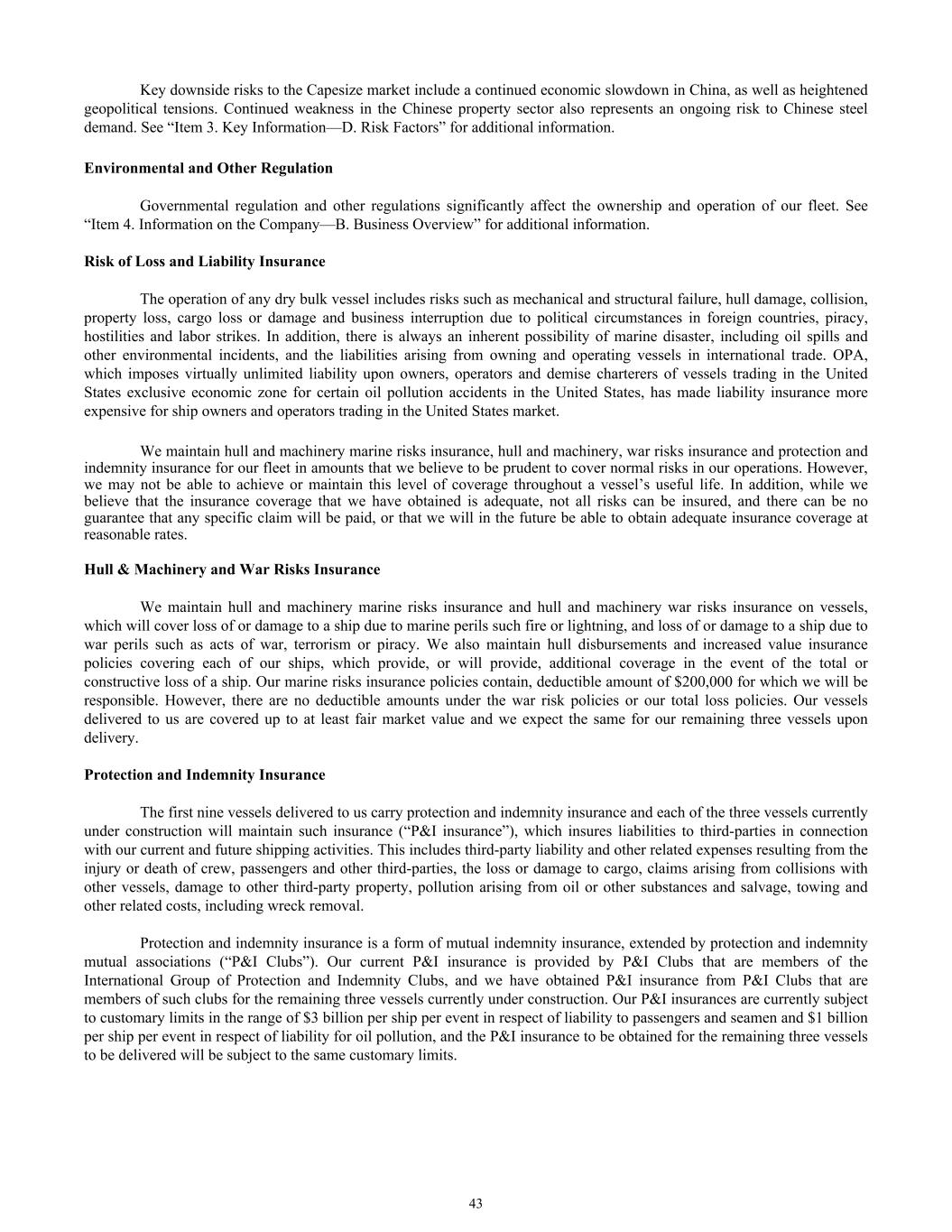
Key downside risks to the Capesize market include a continued economic slowdown in China, as well as heightened geopolitical tensions. Continued weakness in the Chinese property sector also represents an ongoing risk to Chinese steel demand. See “Item 3. Key Information—D. Risk Factors” for additional information. Environmental and Other Regulation Governmental regulation and other regulations significantly affect the ownership and operation of our fleet. See “Item 4. Information on the Company—B. Business Overview” for additional information. Risk of Loss and Liability Insurance The operation of any dry bulk vessel includes risks such as mechanical and structural failure, hull damage, collision, property loss, cargo loss or damage and business interruption due to political circumstances in foreign countries, piracy, hostilities and labor strikes. In addition, there is always an inherent possibility of marine disaster, including oil spills and other environmental incidents, and the liabilities arising from owning and operating vessels in international trade. OPA, which imposes virtually unlimited liability upon owners, operators and demise charterers of vessels trading in the United States exclusive economic zone for certain oil pollution accidents in the United States, has made liability insurance more expensive for ship owners and operators trading in the United States market. We maintain hull and machinery marine risks insurance, hull and machinery, war risks insurance and protection and indemnity insurance for our fleet in amounts that we believe to be prudent to cover normal risks in our operations. However, we may not be able to achieve or maintain this level of coverage throughout a vessel’s useful life. In addition, while we believe that the insurance coverage that we have obtained is adequate, not all risks can be insured, and there can be no guarantee that any specific claim will be paid, or that we will in the future be able to obtain adequate insurance coverage at reasonable rates. Hull & Machinery and War Risks Insurance We maintain hull and machinery marine risks insurance and hull and machinery war risks insurance on vessels, which will cover loss of or damage to a ship due to marine perils such fire or lightning, and loss of or damage to a ship due to war perils such as acts of war, terrorism or piracy. We also maintain hull disbursements and increased value insurance policies covering each of our ships, which provide, or will provide, additional coverage in the event of the total or constructive loss of a ship. Our marine risks insurance policies contain, deductible amount of $200,000 for which we will be responsible. However, there are no deductible amounts under the war risk policies or our total loss policies. Our vessels delivered to us are covered up to at least fair market value and we expect the same for our remaining three vessels upon delivery. Protection and Indemnity Insurance The first nine vessels delivered to us carry protection and indemnity insurance and each of the three vessels currently under construction will maintain such insurance (“P&I insurance”), which insures liabilities to third-parties in connection with our current and future shipping activities. This includes third-party liability and other related expenses resulting from the injury or death of crew, passengers and other third-parties, the loss or damage to cargo, claims arising from collisions with other vessels, damage to other third-party property, pollution arising from oil or other substances and salvage, towing and other related costs, including wreck removal. Protection and indemnity insurance is a form of mutual indemnity insurance, extended by protection and indemnity mutual associations (“P&I Clubs”). Our current P&I insurance is provided by P&I Clubs that are members of the International Group of Protection and Indemnity Clubs, and we have obtained P&I insurance from P&I Clubs that are members of such clubs for the remaining three vessels currently under construction. Our P&I insurances are currently subject to customary limits in the range of $3 billion per ship per event in respect of liability to passengers and seamen and $1 billion per ship per event in respect of liability for oil pollution, and the P&I insurance to be obtained for the remaining three vessels to be delivered will be subject to the same customary limits. 43
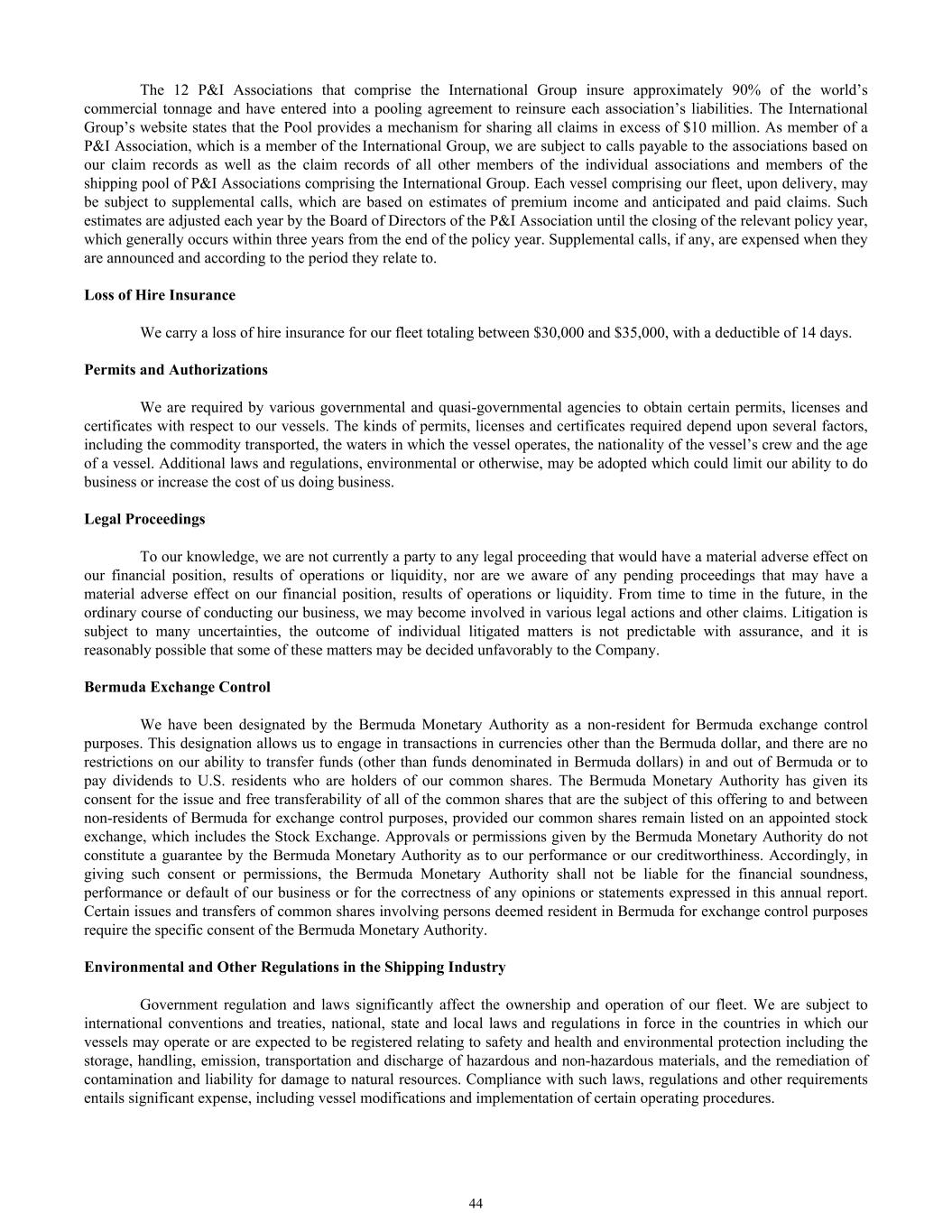
The 12 P&I Associations that comprise the International Group insure approximately 90% of the world’s commercial tonnage and have entered into a pooling agreement to reinsure each association’s liabilities. The International Group’s website states that the Pool provides a mechanism for sharing all claims in excess of $10 million. As member of a P&I Association, which is a member of the International Group, we are subject to calls payable to the associations based on our claim records as well as the claim records of all other members of the individual associations and members of the shipping pool of P&I Associations comprising the International Group. Each vessel comprising our fleet, upon delivery, may be subject to supplemental calls, which are based on estimates of premium income and anticipated and paid claims. Such estimates are adjusted each year by the Board of Directors of the P&I Association until the closing of the relevant policy year, which generally occurs within three years from the end of the policy year. Supplemental calls, if any, are expensed when they are announced and according to the period they relate to. Loss of Hire Insurance We carry a loss of hire insurance for our fleet totaling between $30,000 and $35,000, with a deductible of 14 days. Permits and Authorizations We are required by various governmental and quasi-governmental agencies to obtain certain permits, licenses and certificates with respect to our vessels. The kinds of permits, licenses and certificates required depend upon several factors, including the commodity transported, the waters in which the vessel operates, the nationality of the vessel’s crew and the age of a vessel. Additional laws and regulations, environmental or otherwise, may be adopted which could limit our ability to do business or increase the cost of us doing business. Legal Proceedings To our knowledge, we are not currently a party to any legal proceeding that would have a material adverse effect on our financial position, results of operations or liquidity, nor are we aware of any pending proceedings that may have a material adverse effect on our financial position, results of operations or liquidity. From time to time in the future, in the ordinary course of conducting our business, we may become involved in various legal actions and other claims. Litigation is subject to many uncertainties, the outcome of individual litigated matters is not predictable with assurance, and it is reasonably possible that some of these matters may be decided unfavorably to the Company. Bermuda Exchange Control We have been designated by the Bermuda Monetary Authority as a non-resident for Bermuda exchange control purposes. This designation allows us to engage in transactions in currencies other than the Bermuda dollar, and there are no restrictions on our ability to transfer funds (other than funds denominated in Bermuda dollars) in and out of Bermuda or to pay dividends to U.S. residents who are holders of our common shares. The Bermuda Monetary Authority has given its consent for the issue and free transferability of all of the common shares that are the subject of this offering to and between non-residents of Bermuda for exchange control purposes, provided our common shares remain listed on an appointed stock exchange, which includes the Stock Exchange. Approvals or permissions given by the Bermuda Monetary Authority do not constitute a guarantee by the Bermuda Monetary Authority as to our performance or our creditworthiness. Accordingly, in giving such consent or permissions, the Bermuda Monetary Authority shall not be liable for the financial soundness, performance or default of our business or for the correctness of any opinions or statements expressed in this annual report. Certain issues and transfers of common shares involving persons deemed resident in Bermuda for exchange control purposes require the specific consent of the Bermuda Monetary Authority. Environmental and Other Regulations in the Shipping Industry Government regulation and laws significantly affect the ownership and operation of our fleet. We are subject to international conventions and treaties, national, state and local laws and regulations in force in the countries in which our vessels may operate or are expected to be registered relating to safety and health and environmental protection including the storage, handling, emission, transportation and discharge of hazardous and non-hazardous materials, and the remediation of contamination and liability for damage to natural resources. Compliance with such laws, regulations and other requirements entails significant expense, including vessel modifications and implementation of certain operating procedures. 44
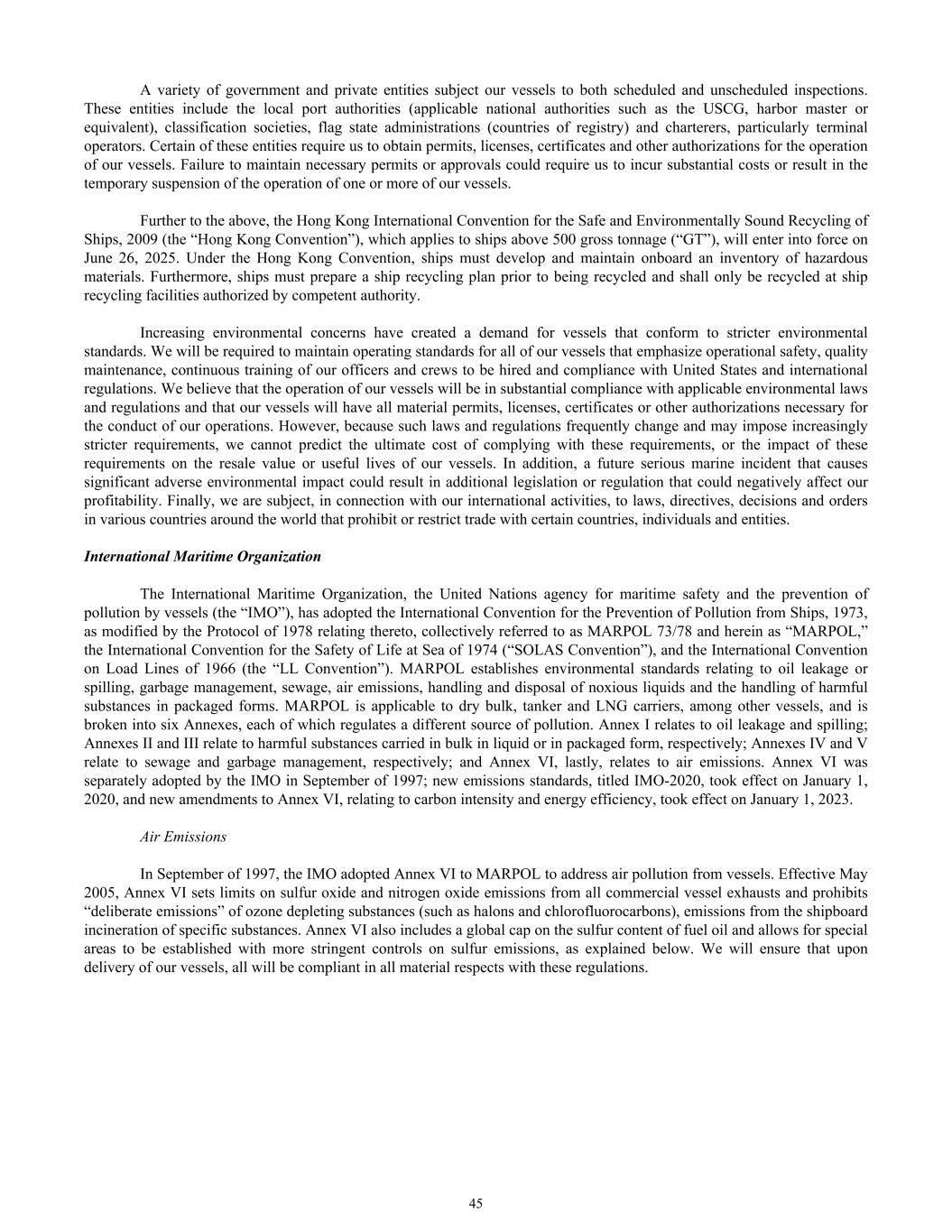
A variety of government and private entities subject our vessels to both scheduled and unscheduled inspections. These entities include the local port authorities (applicable national authorities such as the USCG, harbor master or equivalent), classification societies, flag state administrations (countries of registry) and charterers, particularly terminal operators. Certain of these entities require us to obtain permits, licenses, certificates and other authorizations for the operation of our vessels. Failure to maintain necessary permits or approvals could require us to incur substantial costs or result in the temporary suspension of the operation of one or more of our vessels. Further to the above, the Hong Kong International Convention for the Safe and Environmentally Sound Recycling of Ships, 2009 (the “Hong Kong Convention”), which applies to ships above 500 gross tonnage (“GT”), will enter into force on June 26, 2025. Under the Hong Kong Convention, ships must develop and maintain onboard an inventory of hazardous materials. Furthermore, ships must prepare a ship recycling plan prior to being recycled and shall only be recycled at ship recycling facilities authorized by competent authority. Increasing environmental concerns have created a demand for vessels that conform to stricter environmental standards. We will be required to maintain operating standards for all of our vessels that emphasize operational safety, quality maintenance, continuous training of our officers and crews to be hired and compliance with United States and international regulations. We believe that the operation of our vessels will be in substantial compliance with applicable environmental laws and regulations and that our vessels will have all material permits, licenses, certificates or other authorizations necessary for the conduct of our operations. However, because such laws and regulations frequently change and may impose increasingly stricter requirements, we cannot predict the ultimate cost of complying with these requirements, or the impact of these requirements on the resale value or useful lives of our vessels. In addition, a future serious marine incident that causes significant adverse environmental impact could result in additional legislation or regulation that could negatively affect our profitability. Finally, we are subject, in connection with our international activities, to laws, directives, decisions and orders in various countries around the world that prohibit or restrict trade with certain countries, individuals and entities. International Maritime Organization The International Maritime Organization, the United Nations agency for maritime safety and the prevention of pollution by vessels (the “IMO”), has adopted the International Convention for the Prevention of Pollution from Ships, 1973, as modified by the Protocol of 1978 relating thereto, collectively referred to as MARPOL 73/78 and herein as “MARPOL,” the International Convention for the Safety of Life at Sea of 1974 (“SOLAS Convention”), and the International Convention on Load Lines of 1966 (the “LL Convention”). MARPOL establishes environmental standards relating to oil leakage or spilling, garbage management, sewage, air emissions, handling and disposal of noxious liquids and the handling of harmful substances in packaged forms. MARPOL is applicable to dry bulk, tanker and LNG carriers, among other vessels, and is broken into six Annexes, each of which regulates a different source of pollution. Annex I relates to oil leakage and spilling; Annexes II and III relate to harmful substances carried in bulk in liquid or in packaged form, respectively; Annexes IV and V relate to sewage and garbage management, respectively; and Annex VI, lastly, relates to air emissions. Annex VI was separately adopted by the IMO in September of 1997; new emissions standards, titled IMO-2020, took effect on January 1, 2020, and new amendments to Annex VI, relating to carbon intensity and energy efficiency, took effect on January 1, 2023. Air Emissions In September of 1997, the IMO adopted Annex VI to MARPOL to address air pollution from vessels. Effective May 2005, Annex VI sets limits on sulfur oxide and nitrogen oxide emissions from all commercial vessel exhausts and prohibits “deliberate emissions” of ozone depleting substances (such as halons and chlorofluorocarbons), emissions from the shipboard incineration of specific substances. Annex VI also includes a global cap on the sulfur content of fuel oil and allows for special areas to be established with more stringent controls on sulfur emissions, as explained below. We will ensure that upon delivery of our vessels, all will be compliant in all material respects with these regulations. 45
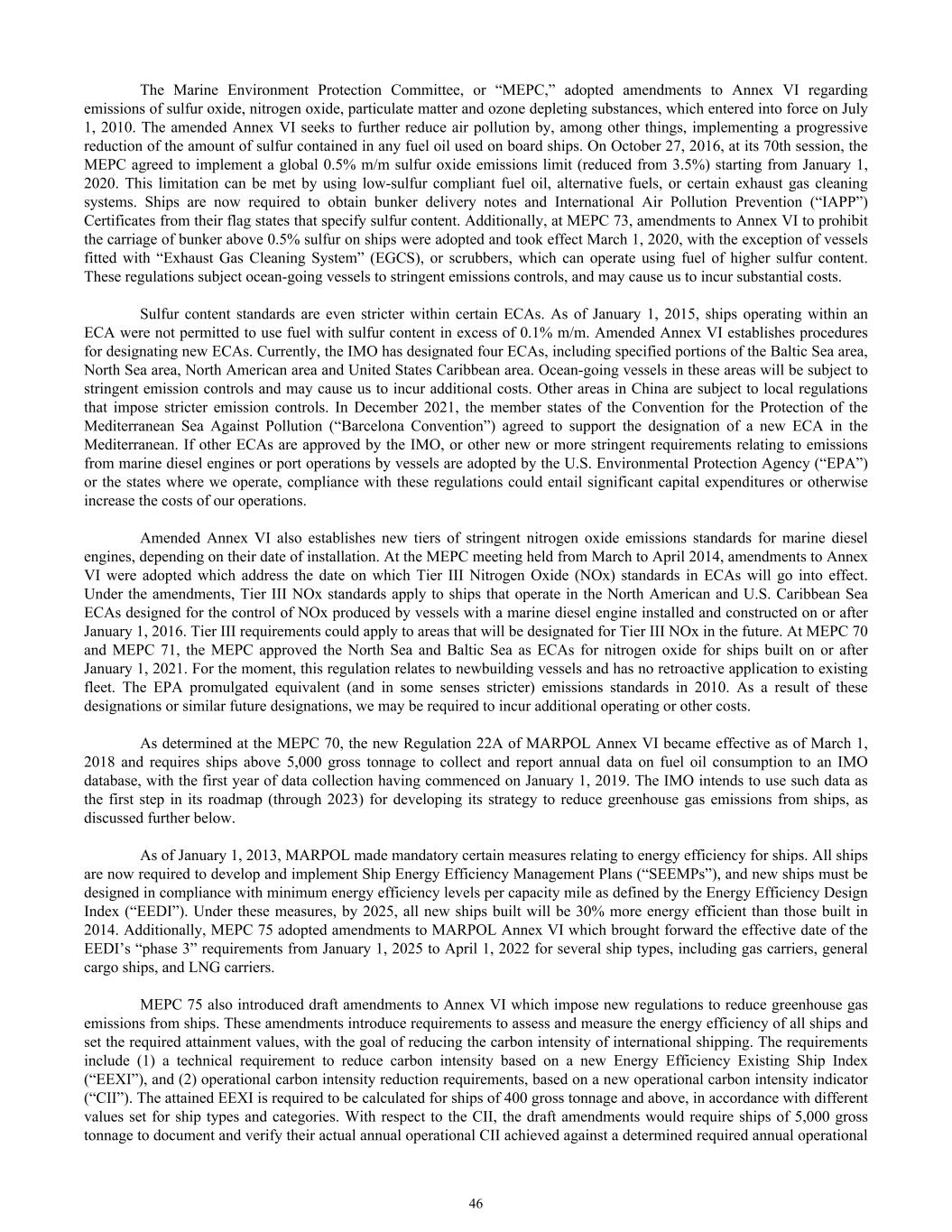
The Marine Environment Protection Committee, or “MEPC,” adopted amendments to Annex VI regarding emissions of sulfur oxide, nitrogen oxide, particulate matter and ozone depleting substances, which entered into force on July 1, 2010. The amended Annex VI seeks to further reduce air pollution by, among other things, implementing a progressive reduction of the amount of sulfur contained in any fuel oil used on board ships. On October 27, 2016, at its 70th session, the MEPC agreed to implement a global 0.5% m/m sulfur oxide emissions limit (reduced from 3.5%) starting from January 1, 2020. This limitation can be met by using low-sulfur compliant fuel oil, alternative fuels, or certain exhaust gas cleaning systems. Ships are now required to obtain bunker delivery notes and International Air Pollution Prevention (“IAPP”) Certificates from their flag states that specify sulfur content. Additionally, at MEPC 73, amendments to Annex VI to prohibit the carriage of bunker above 0.5% sulfur on ships were adopted and took effect March 1, 2020, with the exception of vessels fitted with “Exhaust Gas Cleaning System” (EGCS), or scrubbers, which can operate using fuel of higher sulfur content. These regulations subject ocean-going vessels to stringent emissions controls, and may cause us to incur substantial costs. Sulfur content standards are even stricter within certain ECAs. As of January 1, 2015, ships operating within an ECA were not permitted to use fuel with sulfur content in excess of 0.1% m/m. Amended Annex VI establishes procedures for designating new ECAs. Currently, the IMO has designated four ECAs, including specified portions of the Baltic Sea area, North Sea area, North American area and United States Caribbean area. Ocean-going vessels in these areas will be subject to stringent emission controls and may cause us to incur additional costs. Other areas in China are subject to local regulations that impose stricter emission controls. In December 2021, the member states of the Convention for the Protection of the Mediterranean Sea Against Pollution (“Barcelona Convention”) agreed to support the designation of a new ECA in the Mediterranean. If other ECAs are approved by the IMO, or other new or more stringent requirements relating to emissions from marine diesel engines or port operations by vessels are adopted by the U.S. Environmental Protection Agency (“EPA”) or the states where we operate, compliance with these regulations could entail significant capital expenditures or otherwise increase the costs of our operations. Amended Annex VI also establishes new tiers of stringent nitrogen oxide emissions standards for marine diesel engines, depending on their date of installation. At the MEPC meeting held from March to April 2014, amendments to Annex VI were adopted which address the date on which Tier III Nitrogen Oxide (NOx) standards in ECAs will go into effect. Under the amendments, Tier III NOx standards apply to ships that operate in the North American and U.S. Caribbean Sea ECAs designed for the control of NOx produced by vessels with a marine diesel engine installed and constructed on or after January 1, 2016. Tier III requirements could apply to areas that will be designated for Tier III NOx in the future. At MEPC 70 and MEPC 71, the MEPC approved the North Sea and Baltic Sea as ECAs for nitrogen oxide for ships built on or after January 1, 2021. For the moment, this regulation relates to newbuilding vessels and has no retroactive application to existing fleet. The EPA promulgated equivalent (and in some senses stricter) emissions standards in 2010. As a result of these designations or similar future designations, we may be required to incur additional operating or other costs. As determined at the MEPC 70, the new Regulation 22A of MARPOL Annex VI became effective as of March 1, 2018 and requires ships above 5,000 gross tonnage to collect and report annual data on fuel oil consumption to an IMO database, with the first year of data collection having commenced on January 1, 2019. The IMO intends to use such data as the first step in its roadmap (through 2023) for developing its strategy to reduce greenhouse gas emissions from ships, as discussed further below. As of January 1, 2013, MARPOL made mandatory certain measures relating to energy efficiency for ships. All ships are now required to develop and implement Ship Energy Efficiency Management Plans (“SEEMPs”), and new ships must be designed in compliance with minimum energy efficiency levels per capacity mile as defined by the Energy Efficiency Design Index (“EEDI”). Under these measures, by 2025, all new ships built will be 30% more energy efficient than those built in 2014. Additionally, MEPC 75 adopted amendments to MARPOL Annex VI which brought forward the effective date of the EEDI’s “phase 3” requirements from January 1, 2025 to April 1, 2022 for several ship types, including gas carriers, general cargo ships, and LNG carriers. MEPC 75 also introduced draft amendments to Annex VI which impose new regulations to reduce greenhouse gas emissions from ships. These amendments introduce requirements to assess and measure the energy efficiency of all ships and set the required attainment values, with the goal of reducing the carbon intensity of international shipping. The requirements include (1) a technical requirement to reduce carbon intensity based on a new Energy Efficiency Existing Ship Index (“EEXI”), and (2) operational carbon intensity reduction requirements, based on a new operational carbon intensity indicator (“CII”). The attained EEXI is required to be calculated for ships of 400 gross tonnage and above, in accordance with different values set for ship types and categories. With respect to the CII, the draft amendments would require ships of 5,000 gross tonnage to document and verify their actual annual operational CII achieved against a determined required annual operational 46
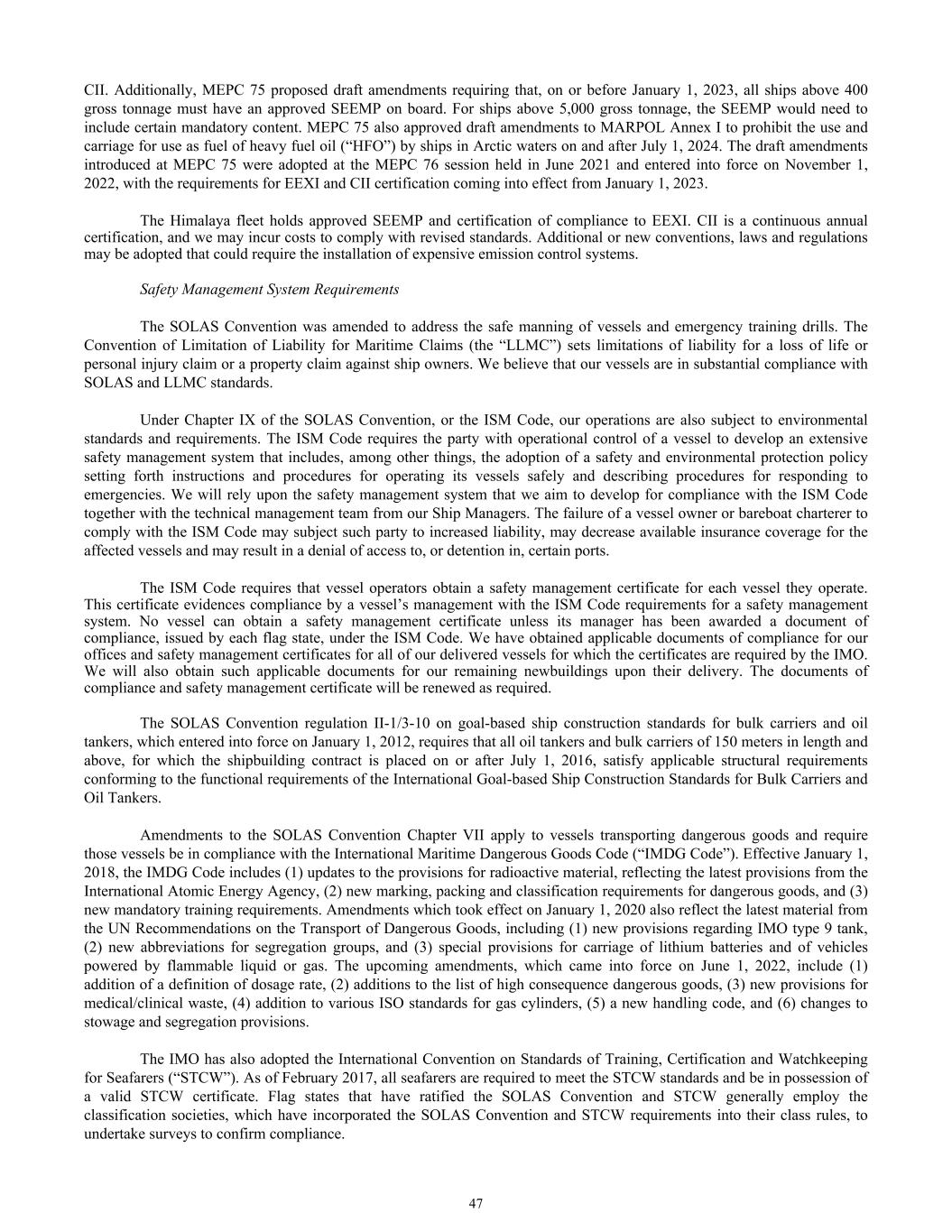
CII. Additionally, MEPC 75 proposed draft amendments requiring that, on or before January 1, 2023, all ships above 400 gross tonnage must have an approved SEEMP on board. For ships above 5,000 gross tonnage, the SEEMP would need to include certain mandatory content. MEPC 75 also approved draft amendments to MARPOL Annex I to prohibit the use and carriage for use as fuel of heavy fuel oil (“HFO”) by ships in Arctic waters on and after July 1, 2024. The draft amendments introduced at MEPC 75 were adopted at the MEPC 76 session held in June 2021 and entered into force on November 1, 2022, with the requirements for EEXI and CII certification coming into effect from January 1, 2023. The Himalaya fleet holds approved SEEMP and certification of compliance to EEXI. CII is a continuous annual certification, and we may incur costs to comply with revised standards. Additional or new conventions, laws and regulations may be adopted that could require the installation of expensive emission control systems. Safety Management System Requirements The SOLAS Convention was amended to address the safe manning of vessels and emergency training drills. The Convention of Limitation of Liability for Maritime Claims (the “LLMC”) sets limitations of liability for a loss of life or personal injury claim or a property claim against ship owners. We believe that our vessels are in substantial compliance with SOLAS and LLMC standards. Under Chapter IX of the SOLAS Convention, or the ISM Code, our operations are also subject to environmental standards and requirements. The ISM Code requires the party with operational control of a vessel to develop an extensive safety management system that includes, among other things, the adoption of a safety and environmental protection policy setting forth instructions and procedures for operating its vessels safely and describing procedures for responding to emergencies. We will rely upon the safety management system that we aim to develop for compliance with the ISM Code together with the technical management team from our Ship Managers. The failure of a vessel owner or bareboat charterer to comply with the ISM Code may subject such party to increased liability, may decrease available insurance coverage for the affected vessels and may result in a denial of access to, or detention in, certain ports. The ISM Code requires that vessel operators obtain a safety management certificate for each vessel they operate. This certificate evidences compliance by a vessel’s management with the ISM Code requirements for a safety management system. No vessel can obtain a safety management certificate unless its manager has been awarded a document of compliance, issued by each flag state, under the ISM Code. We have obtained applicable documents of compliance for our offices and safety management certificates for all of our delivered vessels for which the certificates are required by the IMO. We will also obtain such applicable documents for our remaining newbuildings upon their delivery. The documents of compliance and safety management certificate will be renewed as required. The SOLAS Convention regulation II-1/3-10 on goal-based ship construction standards for bulk carriers and oil tankers, which entered into force on January 1, 2012, requires that all oil tankers and bulk carriers of 150 meters in length and above, for which the shipbuilding contract is placed on or after July 1, 2016, satisfy applicable structural requirements conforming to the functional requirements of the International Goal-based Ship Construction Standards for Bulk Carriers and Oil Tankers. Amendments to the SOLAS Convention Chapter VII apply to vessels transporting dangerous goods and require those vessels be in compliance with the International Maritime Dangerous Goods Code (“IMDG Code”). Effective January 1, 2018, the IMDG Code includes (1) updates to the provisions for radioactive material, reflecting the latest provisions from the International Atomic Energy Agency, (2) new marking, packing and classification requirements for dangerous goods, and (3) new mandatory training requirements. Amendments which took effect on January 1, 2020 also reflect the latest material from the UN Recommendations on the Transport of Dangerous Goods, including (1) new provisions regarding IMO type 9 tank, (2) new abbreviations for segregation groups, and (3) special provisions for carriage of lithium batteries and of vehicles powered by flammable liquid or gas. The upcoming amendments, which came into force on June 1, 2022, include (1) addition of a definition of dosage rate, (2) additions to the list of high consequence dangerous goods, (3) new provisions for medical/clinical waste, (4) addition to various ISO standards for gas cylinders, (5) a new handling code, and (6) changes to stowage and segregation provisions. The IMO has also adopted the International Convention on Standards of Training, Certification and Watchkeeping for Seafarers (“STCW”). As of February 2017, all seafarers are required to meet the STCW standards and be in possession of a valid STCW certificate. Flag states that have ratified the SOLAS Convention and STCW generally employ the classification societies, which have incorporated the SOLAS Convention and STCW requirements into their class rules, to undertake surveys to confirm compliance. 47
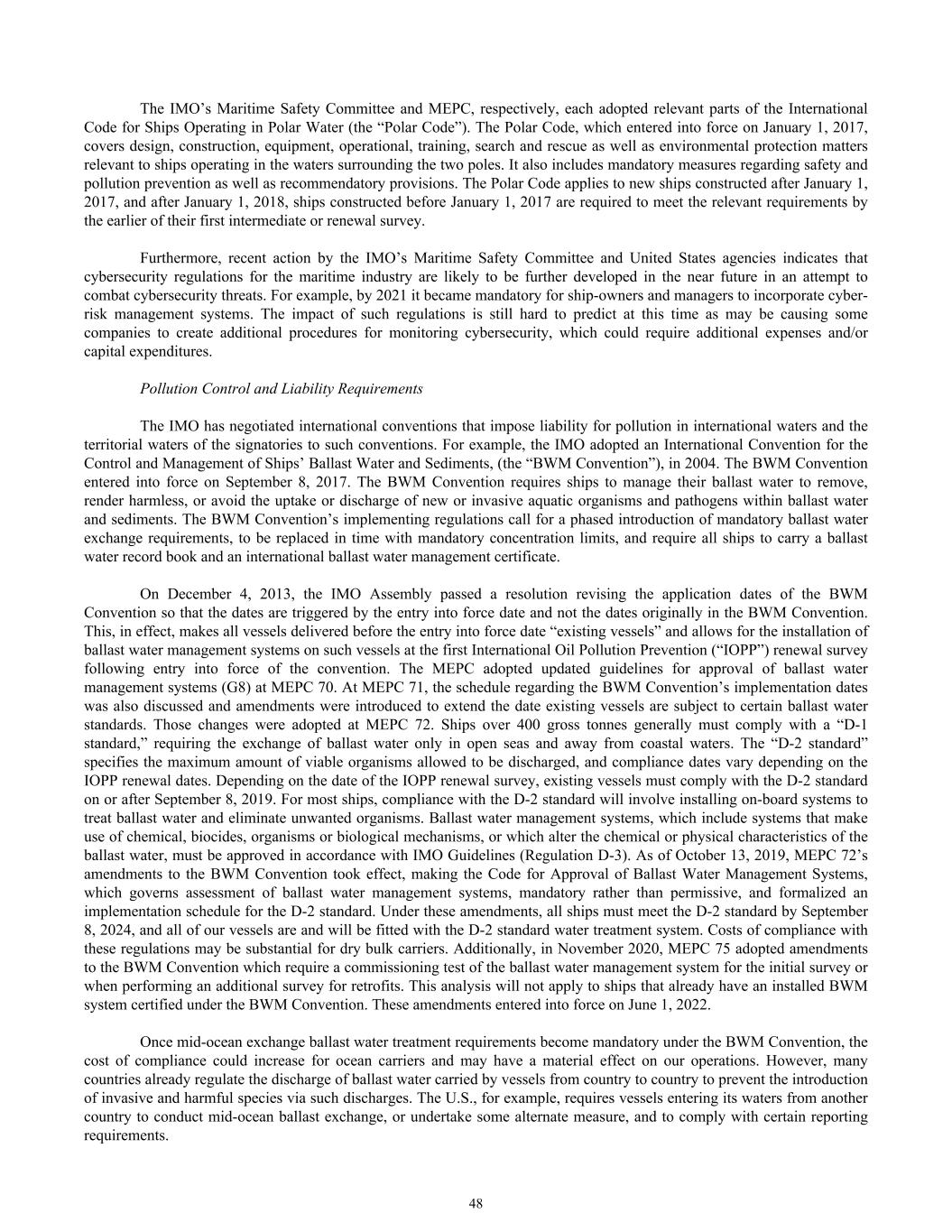
The IMO’s Maritime Safety Committee and MEPC, respectively, each adopted relevant parts of the International Code for Ships Operating in Polar Water (the “Polar Code”). The Polar Code, which entered into force on January 1, 2017, covers design, construction, equipment, operational, training, search and rescue as well as environmental protection matters relevant to ships operating in the waters surrounding the two poles. It also includes mandatory measures regarding safety and pollution prevention as well as recommendatory provisions. The Polar Code applies to new ships constructed after January 1, 2017, and after January 1, 2018, ships constructed before January 1, 2017 are required to meet the relevant requirements by the earlier of their first intermediate or renewal survey. Furthermore, recent action by the IMO’s Maritime Safety Committee and United States agencies indicates that cybersecurity regulations for the maritime industry are likely to be further developed in the near future in an attempt to combat cybersecurity threats. For example, by 2021 it became mandatory for ship-owners and managers to incorporate cyber- risk management systems. The impact of such regulations is still hard to predict at this time as may be causing some companies to create additional procedures for monitoring cybersecurity, which could require additional expenses and/or capital expenditures. Pollution Control and Liability Requirements The IMO has negotiated international conventions that impose liability for pollution in international waters and the territorial waters of the signatories to such conventions. For example, the IMO adopted an International Convention for the Control and Management of Ships’ Ballast Water and Sediments, (the “BWM Convention”), in 2004. The BWM Convention entered into force on September 8, 2017. The BWM Convention requires ships to manage their ballast water to remove, render harmless, or avoid the uptake or discharge of new or invasive aquatic organisms and pathogens within ballast water and sediments. The BWM Convention’s implementing regulations call for a phased introduction of mandatory ballast water exchange requirements, to be replaced in time with mandatory concentration limits, and require all ships to carry a ballast water record book and an international ballast water management certificate. On December 4, 2013, the IMO Assembly passed a resolution revising the application dates of the BWM Convention so that the dates are triggered by the entry into force date and not the dates originally in the BWM Convention. This, in effect, makes all vessels delivered before the entry into force date “existing vessels” and allows for the installation of ballast water management systems on such vessels at the first International Oil Pollution Prevention (“IOPP”) renewal survey following entry into force of the convention. The MEPC adopted updated guidelines for approval of ballast water management systems (G8) at MEPC 70. At MEPC 71, the schedule regarding the BWM Convention’s implementation dates was also discussed and amendments were introduced to extend the date existing vessels are subject to certain ballast water standards. Those changes were adopted at MEPC 72. Ships over 400 gross tonnes generally must comply with a “D-1 standard,” requiring the exchange of ballast water only in open seas and away from coastal waters. The “D-2 standard” specifies the maximum amount of viable organisms allowed to be discharged, and compliance dates vary depending on the IOPP renewal dates. Depending on the date of the IOPP renewal survey, existing vessels must comply with the D-2 standard on or after September 8, 2019. For most ships, compliance with the D-2 standard will involve installing on-board systems to treat ballast water and eliminate unwanted organisms. Ballast water management systems, which include systems that make use of chemical, biocides, organisms or biological mechanisms, or which alter the chemical or physical characteristics of the ballast water, must be approved in accordance with IMO Guidelines (Regulation D-3). As of October 13, 2019, MEPC 72’s amendments to the BWM Convention took effect, making the Code for Approval of Ballast Water Management Systems, which governs assessment of ballast water management systems, mandatory rather than permissive, and formalized an implementation schedule for the D-2 standard. Under these amendments, all ships must meet the D-2 standard by September 8, 2024, and all of our vessels are and will be fitted with the D-2 standard water treatment system. Costs of compliance with these regulations may be substantial for dry bulk carriers. Additionally, in November 2020, MEPC 75 adopted amendments to the BWM Convention which require a commissioning test of the ballast water management system for the initial survey or when performing an additional survey for retrofits. This analysis will not apply to ships that already have an installed BWM system certified under the BWM Convention. These amendments entered into force on June 1, 2022. Once mid-ocean exchange ballast water treatment requirements become mandatory under the BWM Convention, the cost of compliance could increase for ocean carriers and may have a material effect on our operations. However, many countries already regulate the discharge of ballast water carried by vessels from country to country to prevent the introduction of invasive and harmful species via such discharges. The U.S., for example, requires vessels entering its waters from another country to conduct mid-ocean ballast exchange, or undertake some alternate measure, and to comply with certain reporting requirements. 48
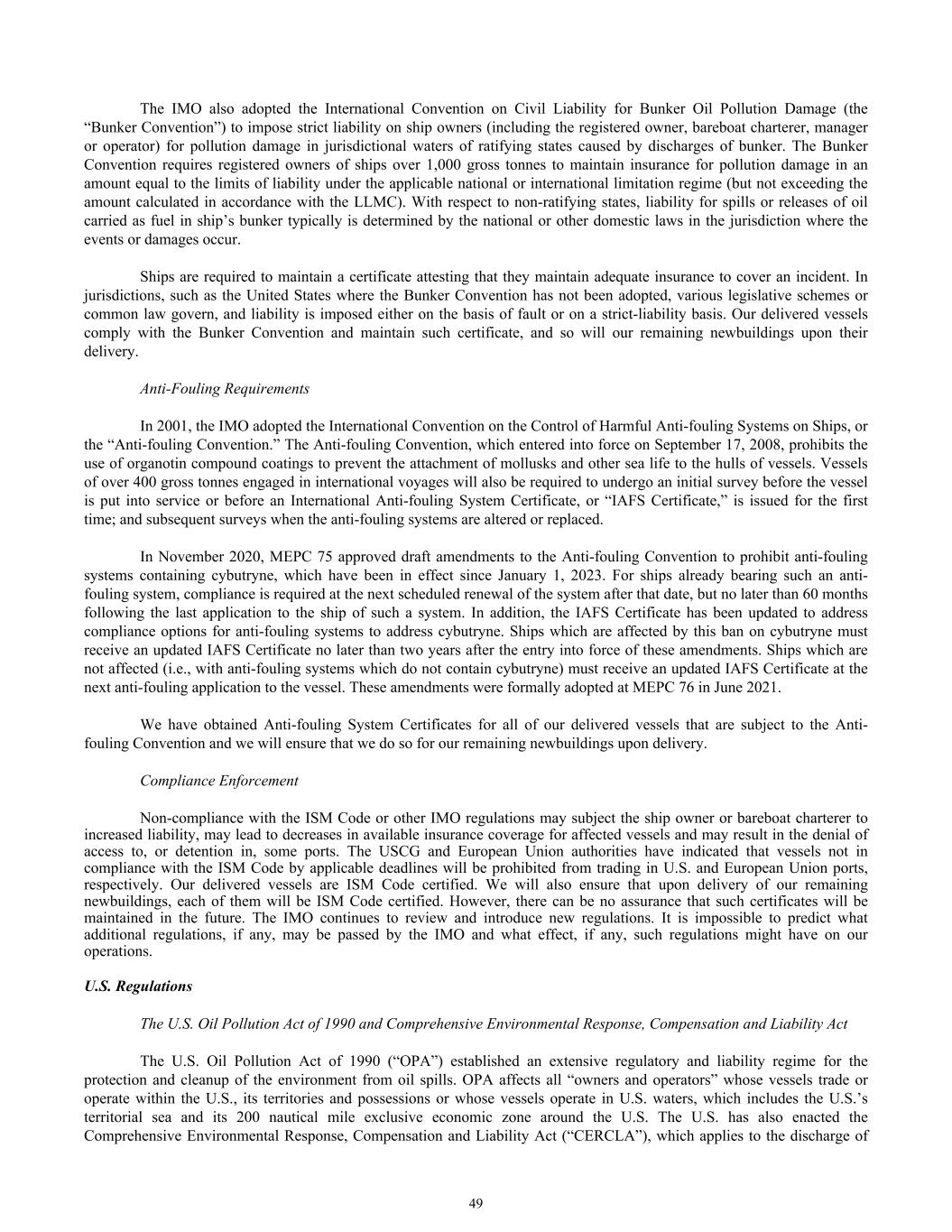
The IMO also adopted the International Convention on Civil Liability for Bunker Oil Pollution Damage (the “Bunker Convention”) to impose strict liability on ship owners (including the registered owner, bareboat charterer, manager or operator) for pollution damage in jurisdictional waters of ratifying states caused by discharges of bunker. The Bunker Convention requires registered owners of ships over 1,000 gross tonnes to maintain insurance for pollution damage in an amount equal to the limits of liability under the applicable national or international limitation regime (but not exceeding the amount calculated in accordance with the LLMC). With respect to non-ratifying states, liability for spills or releases of oil carried as fuel in ship’s bunker typically is determined by the national or other domestic laws in the jurisdiction where the events or damages occur. Ships are required to maintain a certificate attesting that they maintain adequate insurance to cover an incident. In jurisdictions, such as the United States where the Bunker Convention has not been adopted, various legislative schemes or common law govern, and liability is imposed either on the basis of fault or on a strict-liability basis. Our delivered vessels comply with the Bunker Convention and maintain such certificate, and so will our remaining newbuildings upon their delivery. Anti-Fouling Requirements In 2001, the IMO adopted the International Convention on the Control of Harmful Anti-fouling Systems on Ships, or the “Anti-fouling Convention.” The Anti-fouling Convention, which entered into force on September 17, 2008, prohibits the use of organotin compound coatings to prevent the attachment of mollusks and other sea life to the hulls of vessels. Vessels of over 400 gross tonnes engaged in international voyages will also be required to undergo an initial survey before the vessel is put into service or before an International Anti-fouling System Certificate, or “IAFS Certificate,” is issued for the first time; and subsequent surveys when the anti-fouling systems are altered or replaced. In November 2020, MEPC 75 approved draft amendments to the Anti-fouling Convention to prohibit anti-fouling systems containing cybutryne, which have been in effect since January 1, 2023. For ships already bearing such an anti- fouling system, compliance is required at the next scheduled renewal of the system after that date, but no later than 60 months following the last application to the ship of such a system. In addition, the IAFS Certificate has been updated to address compliance options for anti-fouling systems to address cybutryne. Ships which are affected by this ban on cybutryne must receive an updated IAFS Certificate no later than two years after the entry into force of these amendments. Ships which are not affected (i.e., with anti-fouling systems which do not contain cybutryne) must receive an updated IAFS Certificate at the next anti-fouling application to the vessel. These amendments were formally adopted at MEPC 76 in June 2021. We have obtained Anti-fouling System Certificates for all of our delivered vessels that are subject to the Anti- fouling Convention and we will ensure that we do so for our remaining newbuildings upon delivery. Compliance Enforcement Non-compliance with the ISM Code or other IMO regulations may subject the ship owner or bareboat charterer to increased liability, may lead to decreases in available insurance coverage for affected vessels and may result in the denial of access to, or detention in, some ports. The USCG and European Union authorities have indicated that vessels not in compliance with the ISM Code by applicable deadlines will be prohibited from trading in U.S. and European Union ports, respectively. Our delivered vessels are ISM Code certified. We will also ensure that upon delivery of our remaining newbuildings, each of them will be ISM Code certified. However, there can be no assurance that such certificates will be maintained in the future. The IMO continues to review and introduce new regulations. It is impossible to predict what additional regulations, if any, may be passed by the IMO and what effect, if any, such regulations might have on our operations. U.S. Regulations The U.S. Oil Pollution Act of 1990 and Comprehensive Environmental Response, Compensation and Liability Act The U.S. Oil Pollution Act of 1990 (“OPA”) established an extensive regulatory and liability regime for the protection and cleanup of the environment from oil spills. OPA affects all “owners and operators” whose vessels trade or operate within the U.S., its territories and possessions or whose vessels operate in U.S. waters, which includes the U.S.’s territorial sea and its 200 nautical mile exclusive economic zone around the U.S. The U.S. has also enacted the Comprehensive Environmental Response, Compensation and Liability Act (“CERCLA”), which applies to the discharge of 49
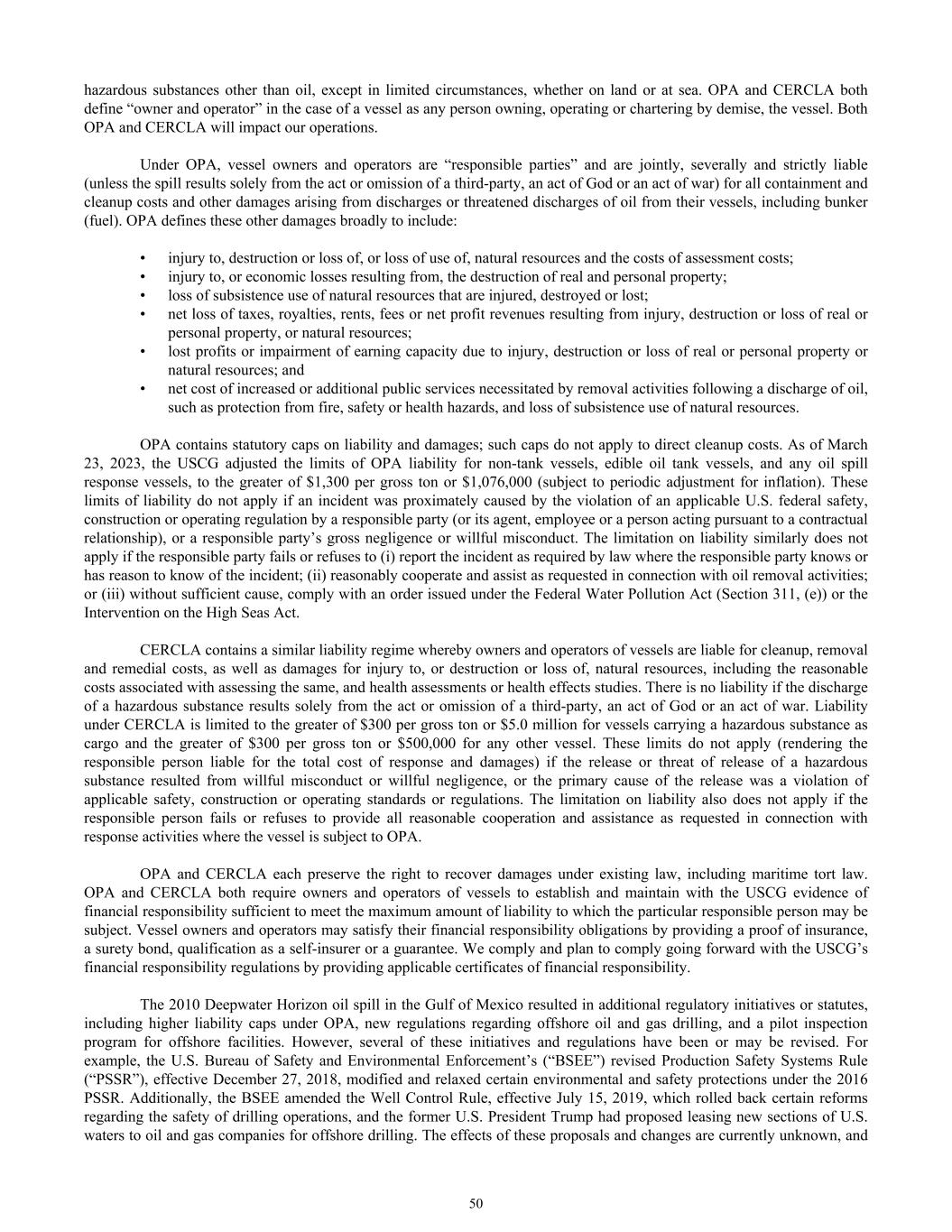
hazardous substances other than oil, except in limited circumstances, whether on land or at sea. OPA and CERCLA both define “owner and operator” in the case of a vessel as any person owning, operating or chartering by demise, the vessel. Both OPA and CERCLA will impact our operations. Under OPA, vessel owners and operators are “responsible parties” and are jointly, severally and strictly liable (unless the spill results solely from the act or omission of a third-party, an act of God or an act of war) for all containment and cleanup costs and other damages arising from discharges or threatened discharges of oil from their vessels, including bunker (fuel). OPA defines these other damages broadly to include: • injury to, destruction or loss of, or loss of use of, natural resources and the costs of assessment costs; • injury to, or economic losses resulting from, the destruction of real and personal property; • loss of subsistence use of natural resources that are injured, destroyed or lost; • net loss of taxes, royalties, rents, fees or net profit revenues resulting from injury, destruction or loss of real or personal property, or natural resources; • lost profits or impairment of earning capacity due to injury, destruction or loss of real or personal property or natural resources; and • net cost of increased or additional public services necessitated by removal activities following a discharge of oil, such as protection from fire, safety or health hazards, and loss of subsistence use of natural resources. OPA contains statutory caps on liability and damages; such caps do not apply to direct cleanup costs. As of March 23, 2023, the USCG adjusted the limits of OPA liability for non-tank vessels, edible oil tank vessels, and any oil spill response vessels, to the greater of $1,300 per gross ton or $1,076,000 (subject to periodic adjustment for inflation). These limits of liability do not apply if an incident was proximately caused by the violation of an applicable U.S. federal safety, construction or operating regulation by a responsible party (or its agent, employee or a person acting pursuant to a contractual relationship), or a responsible party’s gross negligence or willful misconduct. The limitation on liability similarly does not apply if the responsible party fails or refuses to (i) report the incident as required by law where the responsible party knows or has reason to know of the incident; (ii) reasonably cooperate and assist as requested in connection with oil removal activities; or (iii) without sufficient cause, comply with an order issued under the Federal Water Pollution Act (Section 311, (e)) or the Intervention on the High Seas Act. CERCLA contains a similar liability regime whereby owners and operators of vessels are liable for cleanup, removal and remedial costs, as well as damages for injury to, or destruction or loss of, natural resources, including the reasonable costs associated with assessing the same, and health assessments or health effects studies. There is no liability if the discharge of a hazardous substance results solely from the act or omission of a third-party, an act of God or an act of war. Liability under CERCLA is limited to the greater of $300 per gross ton or $5.0 million for vessels carrying a hazardous substance as cargo and the greater of $300 per gross ton or $500,000 for any other vessel. These limits do not apply (rendering the responsible person liable for the total cost of response and damages) if the release or threat of release of a hazardous substance resulted from willful misconduct or willful negligence, or the primary cause of the release was a violation of applicable safety, construction or operating standards or regulations. The limitation on liability also does not apply if the responsible person fails or refuses to provide all reasonable cooperation and assistance as requested in connection with response activities where the vessel is subject to OPA. OPA and CERCLA each preserve the right to recover damages under existing law, including maritime tort law. OPA and CERCLA both require owners and operators of vessels to establish and maintain with the USCG evidence of financial responsibility sufficient to meet the maximum amount of liability to which the particular responsible person may be subject. Vessel owners and operators may satisfy their financial responsibility obligations by providing a proof of insurance, a surety bond, qualification as a self-insurer or a guarantee. We comply and plan to comply going forward with the USCG’s financial responsibility regulations by providing applicable certificates of financial responsibility. The 2010 Deepwater Horizon oil spill in the Gulf of Mexico resulted in additional regulatory initiatives or statutes, including higher liability caps under OPA, new regulations regarding offshore oil and gas drilling, and a pilot inspection program for offshore facilities. However, several of these initiatives and regulations have been or may be revised. For example, the U.S. Bureau of Safety and Environmental Enforcement’s (“BSEE”) revised Production Safety Systems Rule (“PSSR”), effective December 27, 2018, modified and relaxed certain environmental and safety protections under the 2016 PSSR. Additionally, the BSEE amended the Well Control Rule, effective July 15, 2019, which rolled back certain reforms regarding the safety of drilling operations, and the former U.S. President Trump had proposed leasing new sections of U.S. waters to oil and gas companies for offshore drilling. The effects of these proposals and changes are currently unknown, and 50
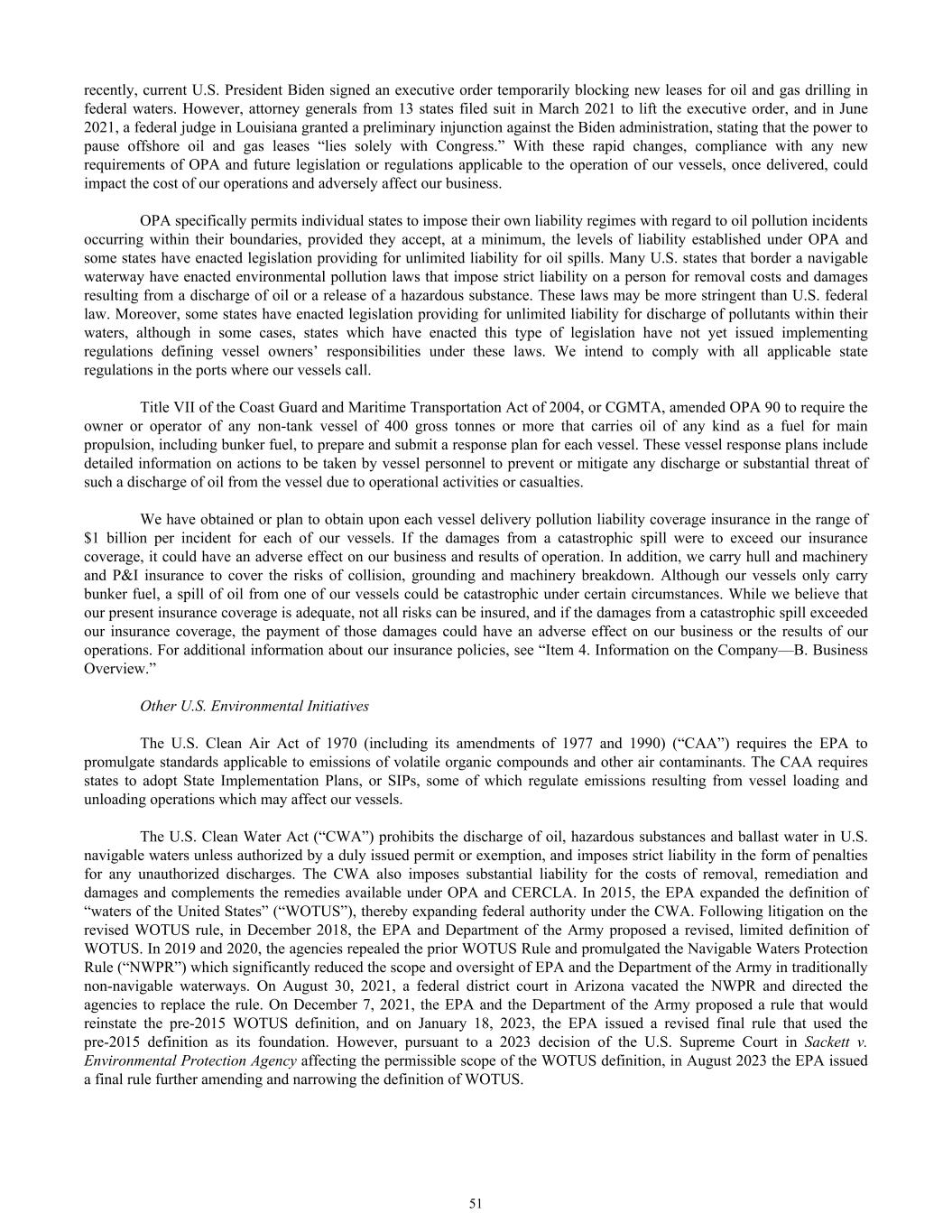
recently, current U.S. President Biden signed an executive order temporarily blocking new leases for oil and gas drilling in federal waters. However, attorney generals from 13 states filed suit in March 2021 to lift the executive order, and in June 2021, a federal judge in Louisiana granted a preliminary injunction against the Biden administration, stating that the power to pause offshore oil and gas leases “lies solely with Congress.” With these rapid changes, compliance with any new requirements of OPA and future legislation or regulations applicable to the operation of our vessels, once delivered, could impact the cost of our operations and adversely affect our business. OPA specifically permits individual states to impose their own liability regimes with regard to oil pollution incidents occurring within their boundaries, provided they accept, at a minimum, the levels of liability established under OPA and some states have enacted legislation providing for unlimited liability for oil spills. Many U.S. states that border a navigable waterway have enacted environmental pollution laws that impose strict liability on a person for removal costs and damages resulting from a discharge of oil or a release of a hazardous substance. These laws may be more stringent than U.S. federal law. Moreover, some states have enacted legislation providing for unlimited liability for discharge of pollutants within their waters, although in some cases, states which have enacted this type of legislation have not yet issued implementing regulations defining vessel owners’ responsibilities under these laws. We intend to comply with all applicable state regulations in the ports where our vessels call. Title VII of the Coast Guard and Maritime Transportation Act of 2004, or CGMTA, amended OPA 90 to require the owner or operator of any non-tank vessel of 400 gross tonnes or more that carries oil of any kind as a fuel for main propulsion, including bunker fuel, to prepare and submit a response plan for each vessel. These vessel response plans include detailed information on actions to be taken by vessel personnel to prevent or mitigate any discharge or substantial threat of such a discharge of oil from the vessel due to operational activities or casualties. We have obtained or plan to obtain upon each vessel delivery pollution liability coverage insurance in the range of $1 billion per incident for each of our vessels. If the damages from a catastrophic spill were to exceed our insurance coverage, it could have an adverse effect on our business and results of operation. In addition, we carry hull and machinery and P&I insurance to cover the risks of collision, grounding and machinery breakdown. Although our vessels only carry bunker fuel, a spill of oil from one of our vessels could be catastrophic under certain circumstances. While we believe that our present insurance coverage is adequate, not all risks can be insured, and if the damages from a catastrophic spill exceeded our insurance coverage, the payment of those damages could have an adverse effect on our business or the results of our operations. For additional information about our insurance policies, see “Item 4. Information on the Company—B. Business Overview.” Other U.S. Environmental Initiatives The U.S. Clean Air Act of 1970 (including its amendments of 1977 and 1990) (“CAA”) requires the EPA to promulgate standards applicable to emissions of volatile organic compounds and other air contaminants. The CAA requires states to adopt State Implementation Plans, or SIPs, some of which regulate emissions resulting from vessel loading and unloading operations which may affect our vessels. The U.S. Clean Water Act (“CWA”) prohibits the discharge of oil, hazardous substances and ballast water in U.S. navigable waters unless authorized by a duly issued permit or exemption, and imposes strict liability in the form of penalties for any unauthorized discharges. The CWA also imposes substantial liability for the costs of removal, remediation and damages and complements the remedies available under OPA and CERCLA. In 2015, the EPA expanded the definition of “waters of the United States” (“WOTUS”), thereby expanding federal authority under the CWA. Following litigation on the revised WOTUS rule, in December 2018, the EPA and Department of the Army proposed a revised, limited definition of WOTUS. In 2019 and 2020, the agencies repealed the prior WOTUS Rule and promulgated the Navigable Waters Protection Rule (“NWPR”) which significantly reduced the scope and oversight of EPA and the Department of the Army in traditionally non-navigable waterways. On August 30, 2021, a federal district court in Arizona vacated the NWPR and directed the agencies to replace the rule. On December 7, 2021, the EPA and the Department of the Army proposed a rule that would reinstate the pre-2015 WOTUS definition, and on January 18, 2023, the EPA issued a revised final rule that used the pre-2015 definition as its foundation. However, pursuant to a 2023 decision of the U.S. Supreme Court in Sackett v. Environmental Protection Agency affecting the permissible scope of the WOTUS definition, in August 2023 the EPA issued a final rule further amending and narrowing the definition of WOTUS. 51
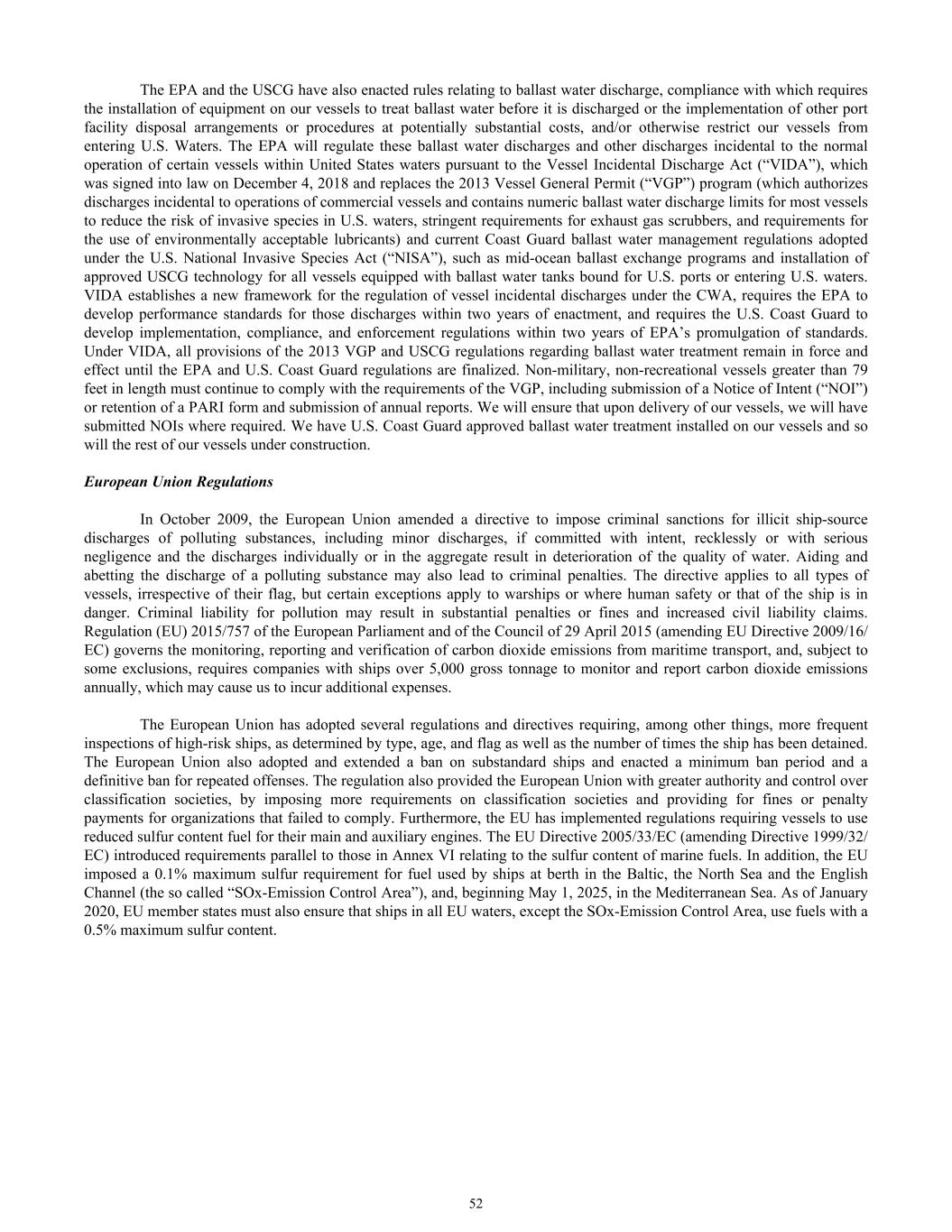
The EPA and the USCG have also enacted rules relating to ballast water discharge, compliance with which requires the installation of equipment on our vessels to treat ballast water before it is discharged or the implementation of other port facility disposal arrangements or procedures at potentially substantial costs, and/or otherwise restrict our vessels from entering U.S. Waters. The EPA will regulate these ballast water discharges and other discharges incidental to the normal operation of certain vessels within United States waters pursuant to the Vessel Incidental Discharge Act (“VIDA”), which was signed into law on December 4, 2018 and replaces the 2013 Vessel General Permit (“VGP”) program (which authorizes discharges incidental to operations of commercial vessels and contains numeric ballast water discharge limits for most vessels to reduce the risk of invasive species in U.S. waters, stringent requirements for exhaust gas scrubbers, and requirements for the use of environmentally acceptable lubricants) and current Coast Guard ballast water management regulations adopted under the U.S. National Invasive Species Act (“NISA”), such as mid-ocean ballast exchange programs and installation of approved USCG technology for all vessels equipped with ballast water tanks bound for U.S. ports or entering U.S. waters. VIDA establishes a new framework for the regulation of vessel incidental discharges under the CWA, requires the EPA to develop performance standards for those discharges within two years of enactment, and requires the U.S. Coast Guard to develop implementation, compliance, and enforcement regulations within two years of EPA’s promulgation of standards. Under VIDA, all provisions of the 2013 VGP and USCG regulations regarding ballast water treatment remain in force and effect until the EPA and U.S. Coast Guard regulations are finalized. Non-military, non-recreational vessels greater than 79 feet in length must continue to comply with the requirements of the VGP, including submission of a Notice of Intent (“NOI”) or retention of a PARI form and submission of annual reports. We will ensure that upon delivery of our vessels, we will have submitted NOIs where required. We have U.S. Coast Guard approved ballast water treatment installed on our vessels and so will the rest of our vessels under construction. European Union Regulations In October 2009, the European Union amended a directive to impose criminal sanctions for illicit ship-source discharges of polluting substances, including minor discharges, if committed with intent, recklessly or with serious negligence and the discharges individually or in the aggregate result in deterioration of the quality of water. Aiding and abetting the discharge of a polluting substance may also lead to criminal penalties. The directive applies to all types of vessels, irrespective of their flag, but certain exceptions apply to warships or where human safety or that of the ship is in danger. Criminal liability for pollution may result in substantial penalties or fines and increased civil liability claims. Regulation (EU) 2015/757 of the European Parliament and of the Council of 29 April 2015 (amending EU Directive 2009/16/ EC) governs the monitoring, reporting and verification of carbon dioxide emissions from maritime transport, and, subject to some exclusions, requires companies with ships over 5,000 gross tonnage to monitor and report carbon dioxide emissions annually, which may cause us to incur additional expenses. The European Union has adopted several regulations and directives requiring, among other things, more frequent inspections of high-risk ships, as determined by type, age, and flag as well as the number of times the ship has been detained. The European Union also adopted and extended a ban on substandard ships and enacted a minimum ban period and a definitive ban for repeated offenses. The regulation also provided the European Union with greater authority and control over classification societies, by imposing more requirements on classification societies and providing for fines or penalty payments for organizations that failed to comply. Furthermore, the EU has implemented regulations requiring vessels to use reduced sulfur content fuel for their main and auxiliary engines. The EU Directive 2005/33/EC (amending Directive 1999/32/ EC) introduced requirements parallel to those in Annex VI relating to the sulfur content of marine fuels. In addition, the EU imposed a 0.1% maximum sulfur requirement for fuel used by ships at berth in the Baltic, the North Sea and the English Channel (the so called “SOx-Emission Control Area”), and, beginning May 1, 2025, in the Mediterranean Sea. As of January 2020, EU member states must also ensure that ships in all EU waters, except the SOx-Emission Control Area, use fuels with a 0.5% maximum sulfur content. 52
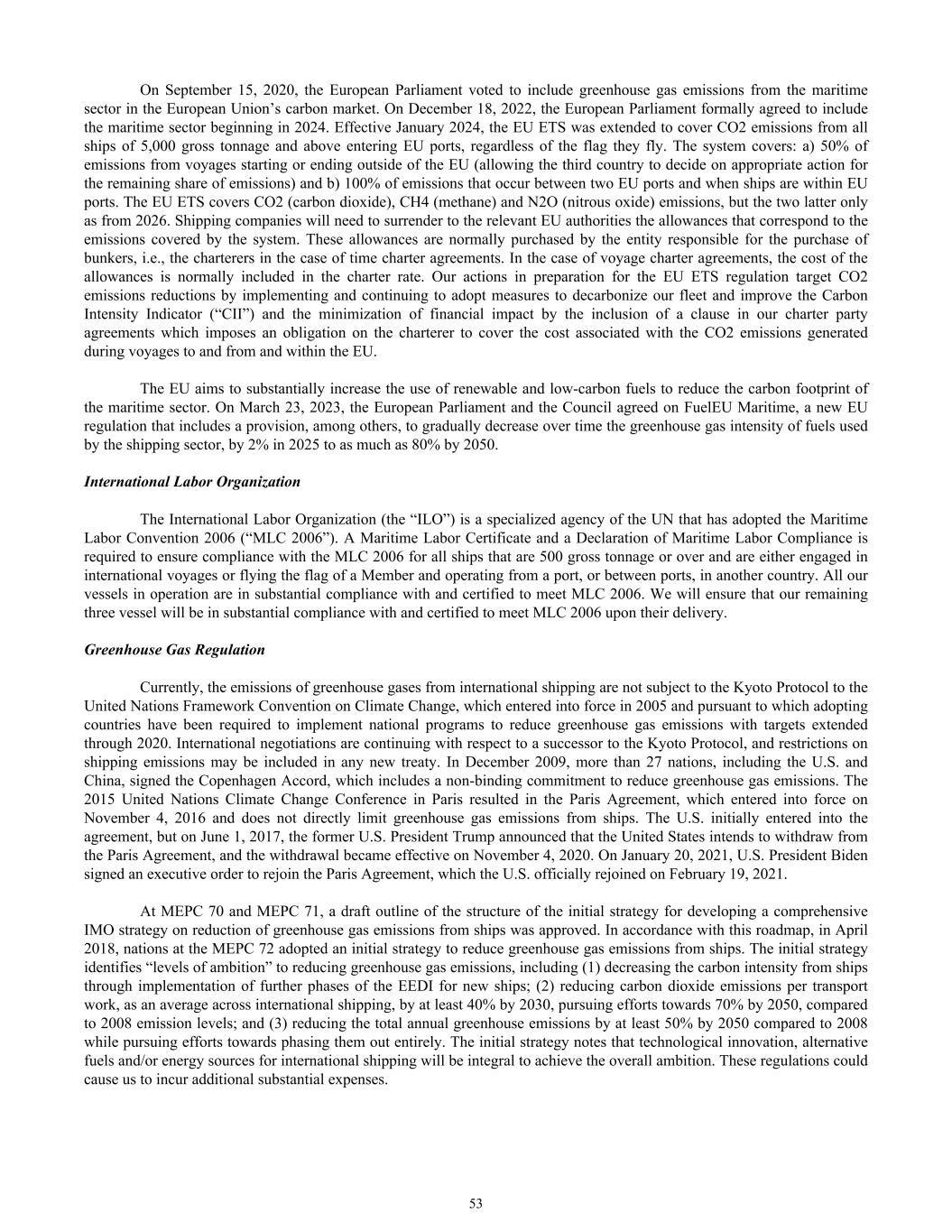
On September 15, 2020, the European Parliament voted to include greenhouse gas emissions from the maritime sector in the European Union’s carbon market. On December 18, 2022, the European Parliament formally agreed to include the maritime sector beginning in 2024. Effective January 2024, the EU ETS was extended to cover CO2 emissions from all ships of 5,000 gross tonnage and above entering EU ports, regardless of the flag they fly. The system covers: a) 50% of emissions from voyages starting or ending outside of the EU (allowing the third country to decide on appropriate action for the remaining share of emissions) and b) 100% of emissions that occur between two EU ports and when ships are within EU ports. The EU ETS covers CO2 (carbon dioxide), CH4 (methane) and N2O (nitrous oxide) emissions, but the two latter only as from 2026. Shipping companies will need to surrender to the relevant EU authorities the allowances that correspond to the emissions covered by the system. These allowances are normally purchased by the entity responsible for the purchase of bunkers, i.e., the charterers in the case of time charter agreements. In the case of voyage charter agreements, the cost of the allowances is normally included in the charter rate. Our actions in preparation for the EU ETS regulation target CO2 emissions reductions by implementing and continuing to adopt measures to decarbonize our fleet and improve the Carbon Intensity Indicator (“CII”) and the minimization of financial impact by the inclusion of a clause in our charter party agreements which imposes an obligation on the charterer to cover the cost associated with the CO2 emissions generated during voyages to and from and within the EU. The EU aims to substantially increase the use of renewable and low-carbon fuels to reduce the carbon footprint of the maritime sector. On March 23, 2023, the European Parliament and the Council agreed on FuelEU Maritime, a new EU regulation that includes a provision, among others, to gradually decrease over time the greenhouse gas intensity of fuels used by the shipping sector, by 2% in 2025 to as much as 80% by 2050. International Labor Organization The International Labor Organization (the “ILO”) is a specialized agency of the UN that has adopted the Maritime Labor Convention 2006 (“MLC 2006”). A Maritime Labor Certificate and a Declaration of Maritime Labor Compliance is required to ensure compliance with the MLC 2006 for all ships that are 500 gross tonnage or over and are either engaged in international voyages or flying the flag of a Member and operating from a port, or between ports, in another country. All our vessels in operation are in substantial compliance with and certified to meet MLC 2006. We will ensure that our remaining three vessel will be in substantial compliance with and certified to meet MLC 2006 upon their delivery. Greenhouse Gas Regulation Currently, the emissions of greenhouse gases from international shipping are not subject to the Kyoto Protocol to the United Nations Framework Convention on Climate Change, which entered into force in 2005 and pursuant to which adopting countries have been required to implement national programs to reduce greenhouse gas emissions with targets extended through 2020. International negotiations are continuing with respect to a successor to the Kyoto Protocol, and restrictions on shipping emissions may be included in any new treaty. In December 2009, more than 27 nations, including the U.S. and China, signed the Copenhagen Accord, which includes a non-binding commitment to reduce greenhouse gas emissions. The 2015 United Nations Climate Change Conference in Paris resulted in the Paris Agreement, which entered into force on November 4, 2016 and does not directly limit greenhouse gas emissions from ships. The U.S. initially entered into the agreement, but on June 1, 2017, the former U.S. President Trump announced that the United States intends to withdraw from the Paris Agreement, and the withdrawal became effective on November 4, 2020. On January 20, 2021, U.S. President Biden signed an executive order to rejoin the Paris Agreement, which the U.S. officially rejoined on February 19, 2021. At MEPC 70 and MEPC 71, a draft outline of the structure of the initial strategy for developing a comprehensive IMO strategy on reduction of greenhouse gas emissions from ships was approved. In accordance with this roadmap, in April 2018, nations at the MEPC 72 adopted an initial strategy to reduce greenhouse gas emissions from ships. The initial strategy identifies “levels of ambition” to reducing greenhouse gas emissions, including (1) decreasing the carbon intensity from ships through implementation of further phases of the EEDI for new ships; (2) reducing carbon dioxide emissions per transport work, as an average across international shipping, by at least 40% by 2030, pursuing efforts towards 70% by 2050, compared to 2008 emission levels; and (3) reducing the total annual greenhouse emissions by at least 50% by 2050 compared to 2008 while pursuing efforts towards phasing them out entirely. The initial strategy notes that technological innovation, alternative fuels and/or energy sources for international shipping will be integral to achieve the overall ambition. These regulations could cause us to incur additional substantial expenses. 53
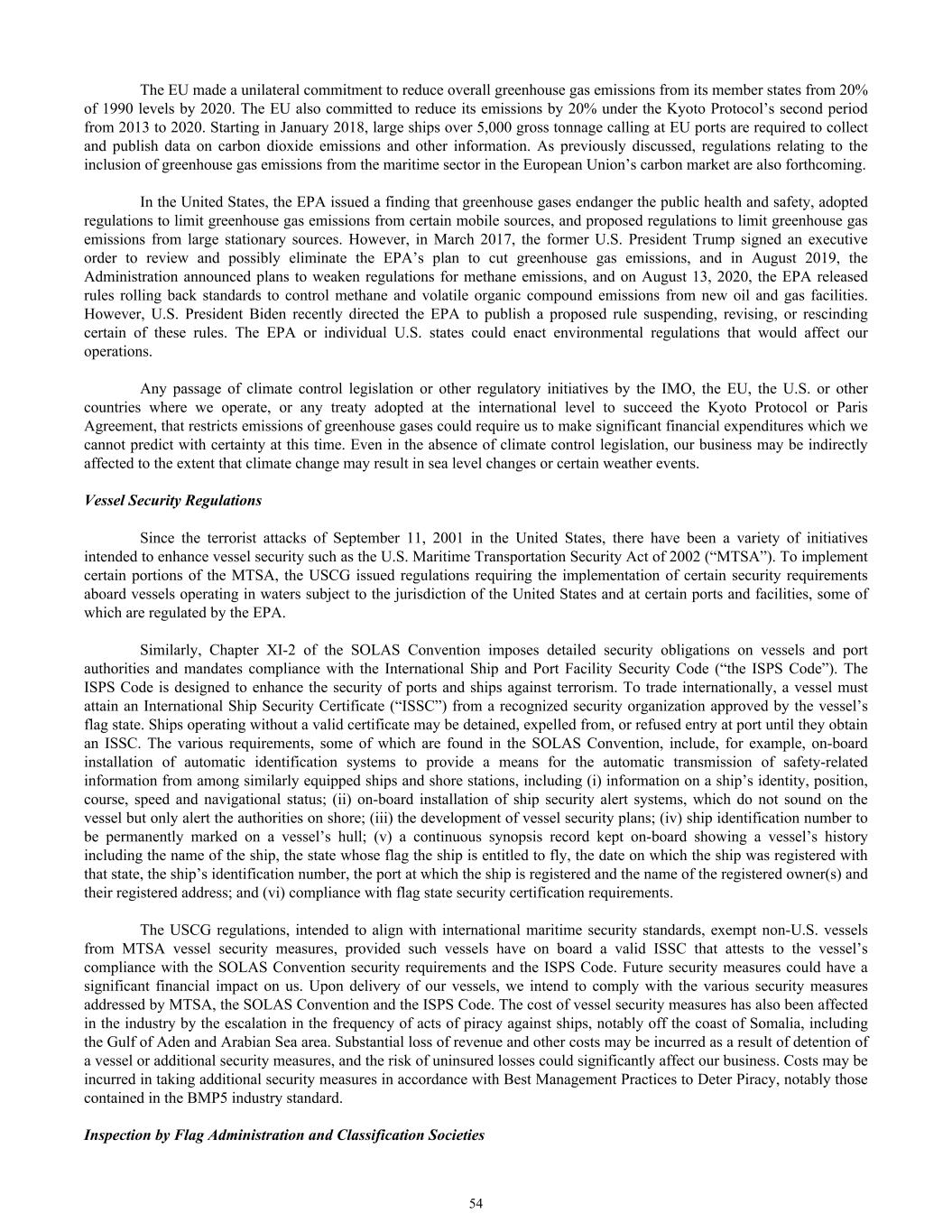
The EU made a unilateral commitment to reduce overall greenhouse gas emissions from its member states from 20% of 1990 levels by 2020. The EU also committed to reduce its emissions by 20% under the Kyoto Protocol’s second period from 2013 to 2020. Starting in January 2018, large ships over 5,000 gross tonnage calling at EU ports are required to collect and publish data on carbon dioxide emissions and other information. As previously discussed, regulations relating to the inclusion of greenhouse gas emissions from the maritime sector in the European Union’s carbon market are also forthcoming. In the United States, the EPA issued a finding that greenhouse gases endanger the public health and safety, adopted regulations to limit greenhouse gas emissions from certain mobile sources, and proposed regulations to limit greenhouse gas emissions from large stationary sources. However, in March 2017, the former U.S. President Trump signed an executive order to review and possibly eliminate the EPA’s plan to cut greenhouse gas emissions, and in August 2019, the Administration announced plans to weaken regulations for methane emissions, and on August 13, 2020, the EPA released rules rolling back standards to control methane and volatile organic compound emissions from new oil and gas facilities. However, U.S. President Biden recently directed the EPA to publish a proposed rule suspending, revising, or rescinding certain of these rules. The EPA or individual U.S. states could enact environmental regulations that would affect our operations. Any passage of climate control legislation or other regulatory initiatives by the IMO, the EU, the U.S. or other countries where we operate, or any treaty adopted at the international level to succeed the Kyoto Protocol or Paris Agreement, that restricts emissions of greenhouse gases could require us to make significant financial expenditures which we cannot predict with certainty at this time. Even in the absence of climate control legislation, our business may be indirectly affected to the extent that climate change may result in sea level changes or certain weather events. Vessel Security Regulations Since the terrorist attacks of September 11, 2001 in the United States, there have been a variety of initiatives intended to enhance vessel security such as the U.S. Maritime Transportation Security Act of 2002 (“MTSA”). To implement certain portions of the MTSA, the USCG issued regulations requiring the implementation of certain security requirements aboard vessels operating in waters subject to the jurisdiction of the United States and at certain ports and facilities, some of which are regulated by the EPA. Similarly, Chapter XI-2 of the SOLAS Convention imposes detailed security obligations on vessels and port authorities and mandates compliance with the International Ship and Port Facility Security Code (“the ISPS Code”). The ISPS Code is designed to enhance the security of ports and ships against terrorism. To trade internationally, a vessel must attain an International Ship Security Certificate (“ISSC”) from a recognized security organization approved by the vessel’s flag state. Ships operating without a valid certificate may be detained, expelled from, or refused entry at port until they obtain an ISSC. The various requirements, some of which are found in the SOLAS Convention, include, for example, on-board installation of automatic identification systems to provide a means for the automatic transmission of safety-related information from among similarly equipped ships and shore stations, including (i) information on a ship’s identity, position, course, speed and navigational status; (ii) on-board installation of ship security alert systems, which do not sound on the vessel but only alert the authorities on shore; (iii) the development of vessel security plans; (iv) ship identification number to be permanently marked on a vessel’s hull; (v) a continuous synopsis record kept on-board showing a vessel’s history including the name of the ship, the state whose flag the ship is entitled to fly, the date on which the ship was registered with that state, the ship’s identification number, the port at which the ship is registered and the name of the registered owner(s) and their registered address; and (vi) compliance with flag state security certification requirements. The USCG regulations, intended to align with international maritime security standards, exempt non-U.S. vessels from MTSA vessel security measures, provided such vessels have on board a valid ISSC that attests to the vessel’s compliance with the SOLAS Convention security requirements and the ISPS Code. Future security measures could have a significant financial impact on us. Upon delivery of our vessels, we intend to comply with the various security measures addressed by MTSA, the SOLAS Convention and the ISPS Code. The cost of vessel security measures has also been affected in the industry by the escalation in the frequency of acts of piracy against ships, notably off the coast of Somalia, including the Gulf of Aden and Arabian Sea area. Substantial loss of revenue and other costs may be incurred as a result of detention of a vessel or additional security measures, and the risk of uninsured losses could significantly affect our business. Costs may be incurred in taking additional security measures in accordance with Best Management Practices to Deter Piracy, notably those contained in the BMP5 industry standard. Inspection by Flag Administration and Classification Societies 54
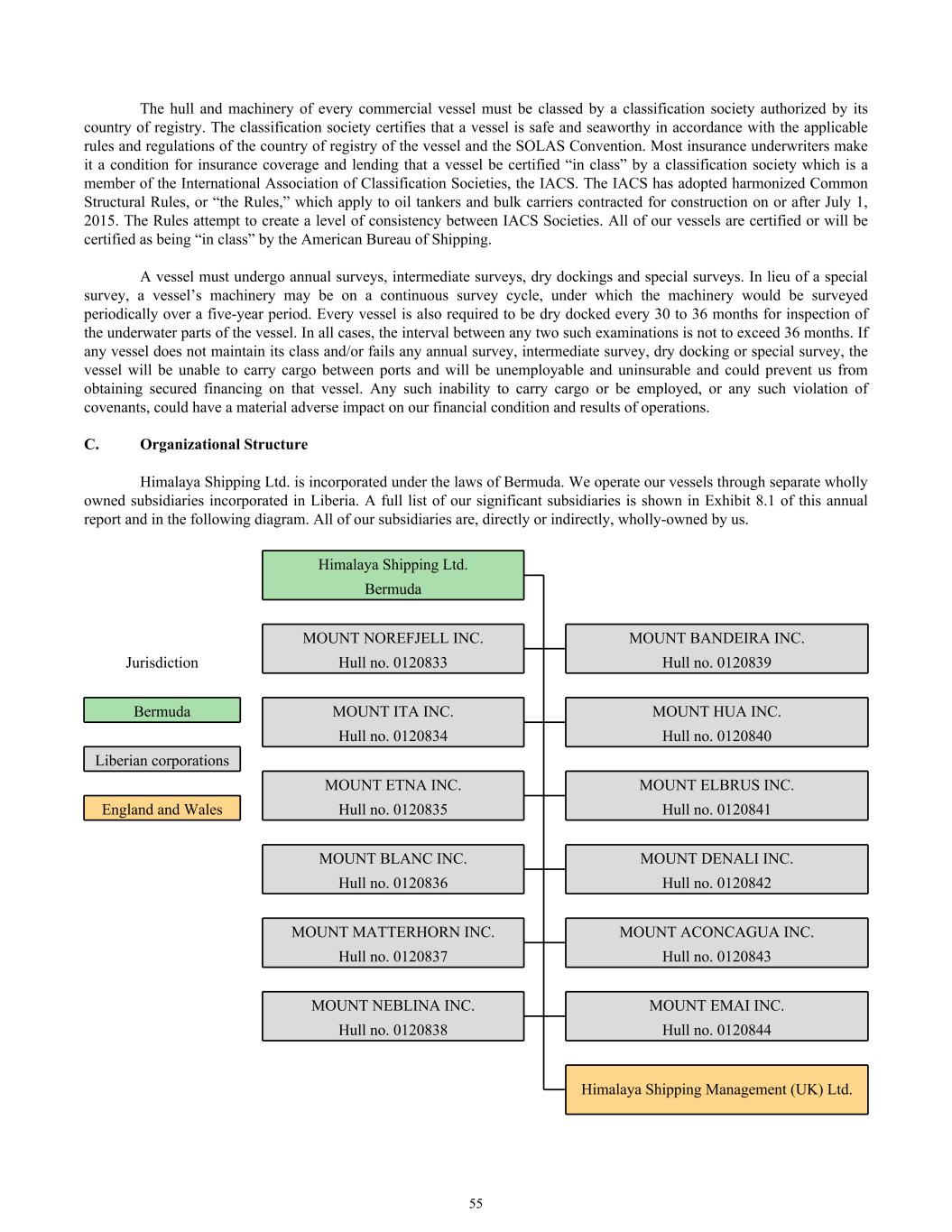
The hull and machinery of every commercial vessel must be classed by a classification society authorized by its country of registry. The classification society certifies that a vessel is safe and seaworthy in accordance with the applicable rules and regulations of the country of registry of the vessel and the SOLAS Convention. Most insurance underwriters make it a condition for insurance coverage and lending that a vessel be certified “in class” by a classification society which is a member of the International Association of Classification Societies, the IACS. The IACS has adopted harmonized Common Structural Rules, or “the Rules,” which apply to oil tankers and bulk carriers contracted for construction on or after July 1, 2015. The Rules attempt to create a level of consistency between IACS Societies. All of our vessels are certified or will be certified as being “in class” by the American Bureau of Shipping. A vessel must undergo annual surveys, intermediate surveys, dry dockings and special surveys. In lieu of a special survey, a vessel’s machinery may be on a continuous survey cycle, under which the machinery would be surveyed periodically over a five-year period. Every vessel is also required to be dry docked every 30 to 36 months for inspection of the underwater parts of the vessel. In all cases, the interval between any two such examinations is not to exceed 36 months. If any vessel does not maintain its class and/or fails any annual survey, intermediate survey, dry docking or special survey, the vessel will be unable to carry cargo between ports and will be unemployable and uninsurable and could prevent us from obtaining secured financing on that vessel. Any such inability to carry cargo or be employed, or any such violation of covenants, could have a material adverse impact on our financial condition and results of operations. C. Organizational Structure Himalaya Shipping Ltd. is incorporated under the laws of Bermuda. We operate our vessels through separate wholly owned subsidiaries incorporated in Liberia. A full list of our significant subsidiaries is shown in Exhibit 8.1 of this annual report and in the following diagram. All of our subsidiaries are, directly or indirectly, wholly-owned by us. Himalaya Shipping Ltd. Bermuda MOUNT NOREFJELL INC. MOUNT BANDEIRA INC. Jurisdiction Hull no. 0120833 Hull no. 0120839 Bermuda MOUNT ITA INC. MOUNT HUA INC. Hull no. 0120834 Hull no. 0120840 Liberian corporations MOUNT ETNA INC. MOUNT ELBRUS INC. England and Wales Hull no. 0120835 Hull no. 0120841 MOUNT BLANC INC. MOUNT DENALI INC. Hull no. 0120836 Hull no. 0120842 MOUNT MATTERHORN INC. MOUNT ACONCAGUA INC. Hull no. 0120837 Hull no. 0120843 MOUNT NEBLINA INC. MOUNT EMAI INC. Hull no. 0120838 Hull no. 0120844 Himalaya Shipping Management (UK) Ltd. 55
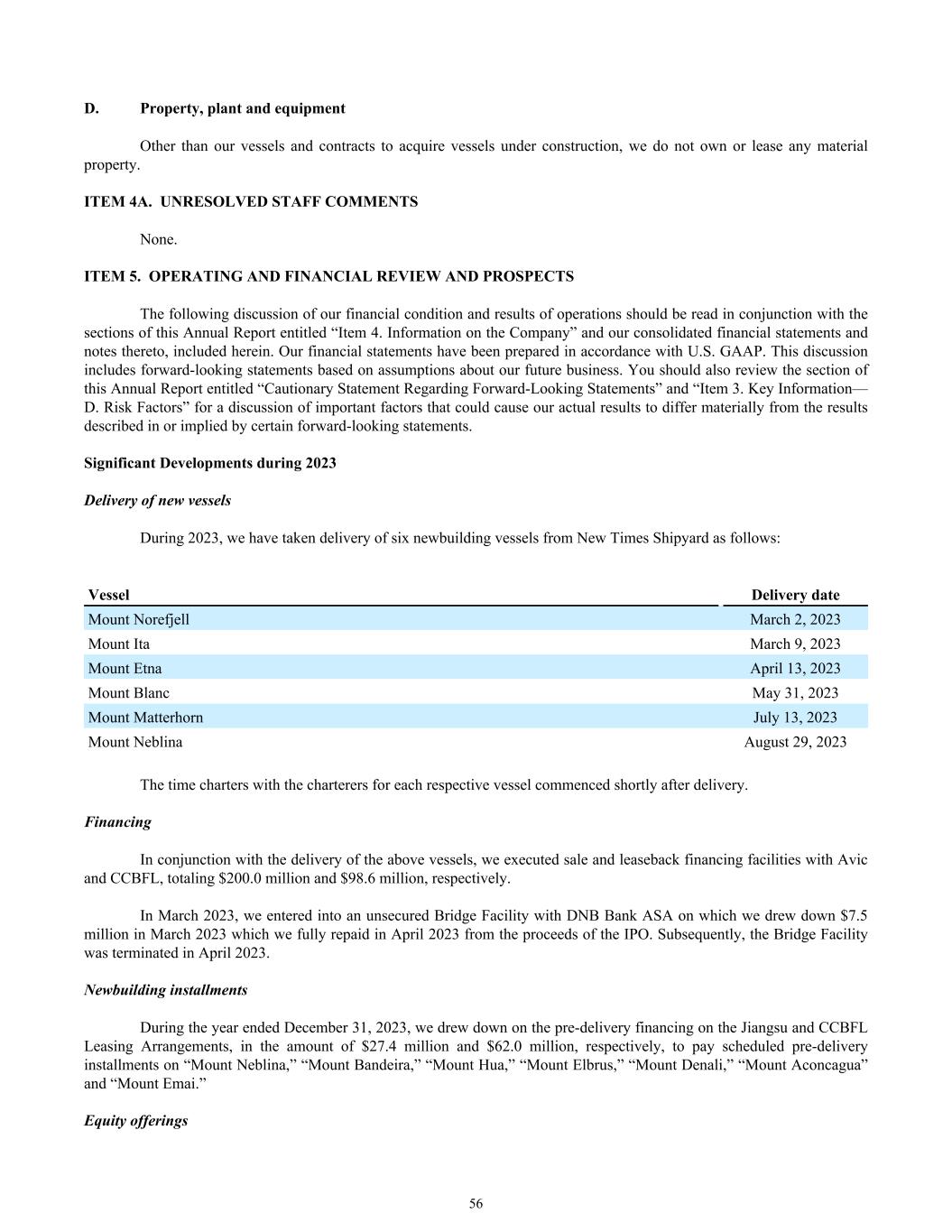
D. Property, plant and equipment Other than our vessels and contracts to acquire vessels under construction, we do not own or lease any material property. ITEM 4A. UNRESOLVED STAFF COMMENTS None. ITEM 5. OPERATING AND FINANCIAL REVIEW AND PROSPECTS The following discussion of our financial condition and results of operations should be read in conjunction with the sections of this Annual Report entitled “Item 4. Information on the Company” and our consolidated financial statements and notes thereto, included herein. Our financial statements have been prepared in accordance with U.S. GAAP. This discussion includes forward-looking statements based on assumptions about our future business. You should also review the section of this Annual Report entitled “Cautionary Statement Regarding Forward-Looking Statements” and “Item 3. Key Information— D. Risk Factors” for a discussion of important factors that could cause our actual results to differ materially from the results described in or implied by certain forward-looking statements. Significant Developments during 2023 Delivery of new vessels During 2023, we have taken delivery of six newbuilding vessels from New Times Shipyard as follows: Vessel Delivery date Mount Norefjell March 2, 2023 Mount Ita March 9, 2023 Mount Etna April 13, 2023 Mount Blanc May 31, 2023 Mount Matterhorn July 13, 2023 Mount Neblina August 29, 2023 The time charters with the charterers for each respective vessel commenced shortly after delivery. Financing In conjunction with the delivery of the above vessels, we executed sale and leaseback financing facilities with Avic and CCBFL, totaling $200.0 million and $98.6 million, respectively. In March 2023, we entered into an unsecured Bridge Facility with DNB Bank ASA on which we drew down $7.5 million in March 2023 which we fully repaid in April 2023 from the proceeds of the IPO. Subsequently, the Bridge Facility was terminated in April 2023. Newbuilding installments During the year ended December 31, 2023, we drew down on the pre-delivery financing on the Jiangsu and CCBFL Leasing Arrangements, in the amount of $27.4 million and $62.0 million, respectively, to pay scheduled pre-delivery installments on “Mount Neblina,” “Mount Bandeira,” “Mount Hua,” “Mount Elbrus,” “Mount Denali,” “Mount Aconcagua” and “Mount Emai.” Equity offerings 56
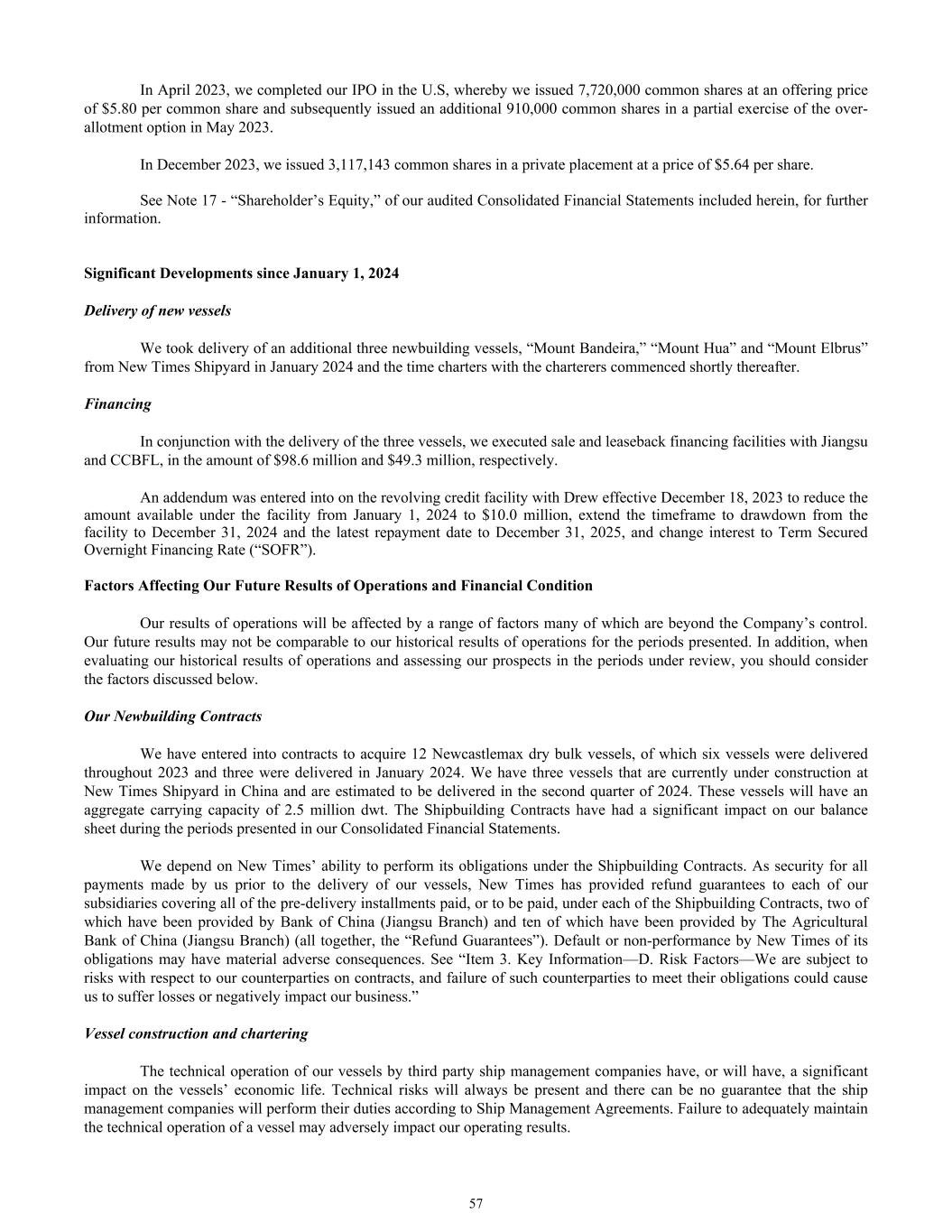
In April 2023, we completed our IPO in the U.S, whereby we issued 7,720,000 common shares at an offering price of $5.80 per common share and subsequently issued an additional 910,000 common shares in a partial exercise of the over- allotment option in May 2023. In December 2023, we issued 3,117,143 common shares in a private placement at a price of $5.64 per share. See Note 17 - “Shareholder’s Equity,” of our audited Consolidated Financial Statements included herein, for further information. Significant Developments since January 1, 2024 Delivery of new vessels We took delivery of an additional three newbuilding vessels, “Mount Bandeira,” “Mount Hua” and “Mount Elbrus” from New Times Shipyard in January 2024 and the time charters with the charterers commenced shortly thereafter. Financing In conjunction with the delivery of the three vessels, we executed sale and leaseback financing facilities with Jiangsu and CCBFL, in the amount of $98.6 million and $49.3 million, respectively. An addendum was entered into on the revolving credit facility with Drew effective December 18, 2023 to reduce the amount available under the facility from January 1, 2024 to $10.0 million, extend the timeframe to drawdown from the facility to December 31, 2024 and the latest repayment date to December 31, 2025, and change interest to Term Secured Overnight Financing Rate (“SOFR”). Factors Affecting Our Future Results of Operations and Financial Condition Our results of operations will be affected by a range of factors many of which are beyond the Company’s control. Our future results may not be comparable to our historical results of operations for the periods presented. In addition, when evaluating our historical results of operations and assessing our prospects in the periods under review, you should consider the factors discussed below. Our Newbuilding Contracts We have entered into contracts to acquire 12 Newcastlemax dry bulk vessels, of which six vessels were delivered throughout 2023 and three were delivered in January 2024. We have three vessels that are currently under construction at New Times Shipyard in China and are estimated to be delivered in the second quarter of 2024. These vessels will have an aggregate carrying capacity of 2.5 million dwt. The Shipbuilding Contracts have had a significant impact on our balance sheet during the periods presented in our Consolidated Financial Statements. We depend on New Times’ ability to perform its obligations under the Shipbuilding Contracts. As security for all payments made by us prior to the delivery of our vessels, New Times has provided refund guarantees to each of our subsidiaries covering all of the pre-delivery installments paid, or to be paid, under each of the Shipbuilding Contracts, two of which have been provided by Bank of China (Jiangsu Branch) and ten of which have been provided by The Agricultural Bank of China (Jiangsu Branch) (all together, the “Refund Guarantees”). Default or non-performance by New Times of its obligations may have material adverse consequences. See “Item 3. Key Information—D. Risk Factors—We are subject to risks with respect to our counterparties on contracts, and failure of such counterparties to meet their obligations could cause us to suffer losses or negatively impact our business.” Vessel construction and chartering The technical operation of our vessels by third party ship management companies have, or will have, a significant impact on the vessels’ economic life. Technical risks will always be present and there can be no guarantee that the ship management companies will perform their duties according to Ship Management Agreements. Failure to adequately maintain the technical operation of a vessel may adversely impact our operating results. 57
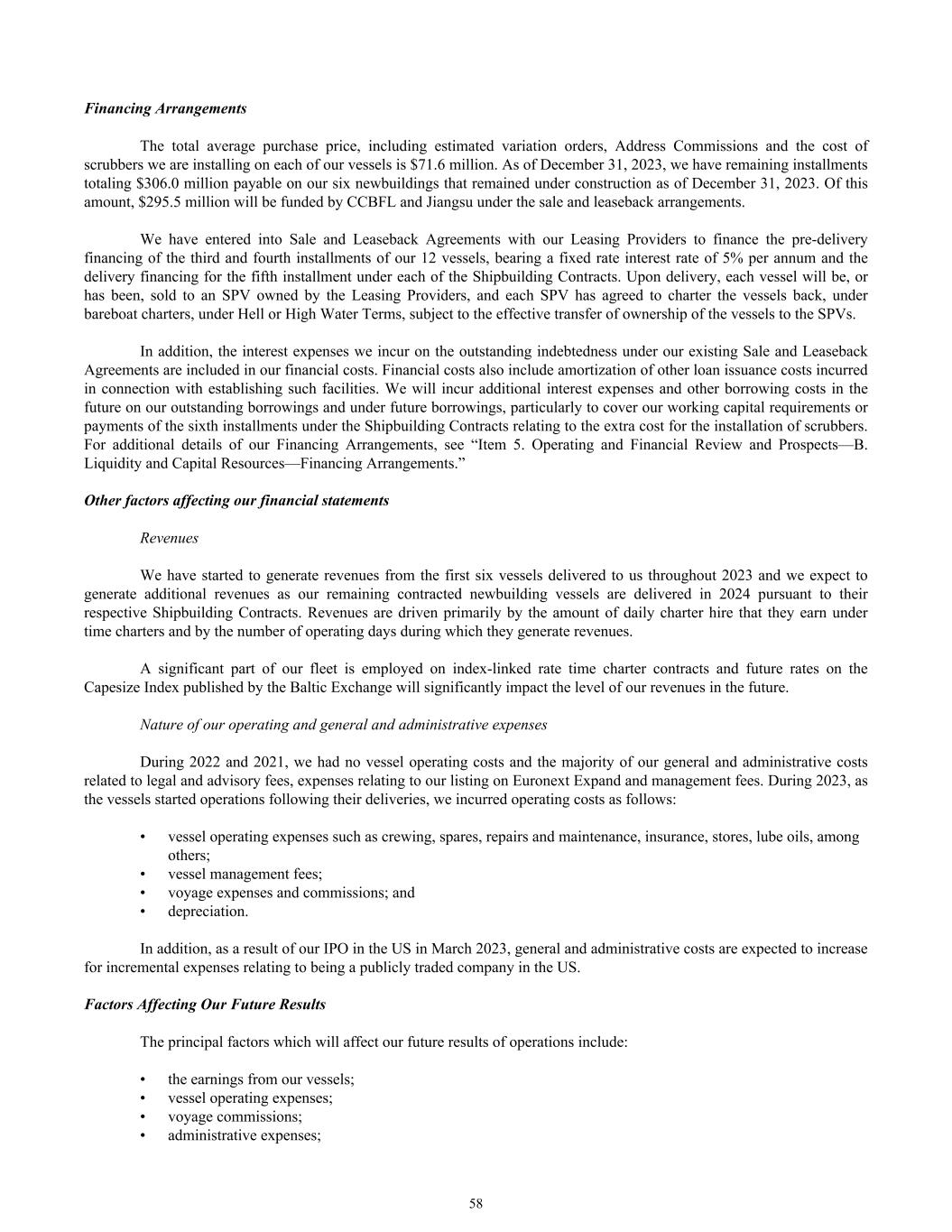
Financing Arrangements The total average purchase price, including estimated variation orders, Address Commissions and the cost of scrubbers we are installing on each of our vessels is $71.6 million. As of December 31, 2023, we have remaining installments totaling $306.0 million payable on our six newbuildings that remained under construction as of December 31, 2023. Of this amount, $295.5 million will be funded by CCBFL and Jiangsu under the sale and leaseback arrangements. We have entered into Sale and Leaseback Agreements with our Leasing Providers to finance the pre-delivery financing of the third and fourth installments of our 12 vessels, bearing a fixed rate interest rate of 5% per annum and the delivery financing for the fifth installment under each of the Shipbuilding Contracts. Upon delivery, each vessel will be, or has been, sold to an SPV owned by the Leasing Providers, and each SPV has agreed to charter the vessels back, under bareboat charters, under Hell or High Water Terms, subject to the effective transfer of ownership of the vessels to the SPVs. In addition, the interest expenses we incur on the outstanding indebtedness under our existing Sale and Leaseback Agreements are included in our financial costs. Financial costs also include amortization of other loan issuance costs incurred in connection with establishing such facilities. We will incur additional interest expenses and other borrowing costs in the future on our outstanding borrowings and under future borrowings, particularly to cover our working capital requirements or payments of the sixth installments under the Shipbuilding Contracts relating to the extra cost for the installation of scrubbers. For additional details of our Financing Arrangements, see “Item 5. Operating and Financial Review and Prospects—B. Liquidity and Capital Resources—Financing Arrangements.” Other factors affecting our financial statements Revenues We have started to generate revenues from the first six vessels delivered to us throughout 2023 and we expect to generate additional revenues as our remaining contracted newbuilding vessels are delivered in 2024 pursuant to their respective Shipbuilding Contracts. Revenues are driven primarily by the amount of daily charter hire that they earn under time charters and by the number of operating days during which they generate revenues. A significant part of our fleet is employed on index-linked rate time charter contracts and future rates on the Capesize Index published by the Baltic Exchange will significantly impact the level of our revenues in the future. Nature of our operating and general and administrative expenses During 2022 and 2021, we had no vessel operating costs and the majority of our general and administrative costs related to legal and advisory fees, expenses relating to our listing on Euronext Expand and management fees. During 2023, as the vessels started operations following their deliveries, we incurred operating costs as follows: • vessel operating expenses such as crewing, spares, repairs and maintenance, insurance, stores, lube oils, among others; • vessel management fees; • voyage expenses and commissions; and • depreciation. In addition, as a result of our IPO in the US in March 2023, general and administrative costs are expected to increase for incremental expenses relating to being a publicly traded company in the US. Factors Affecting Our Future Results The principal factors which will affect our future results of operations include: • the earnings from our vessels; • vessel operating expenses; • voyage commissions; • administrative expenses; 58
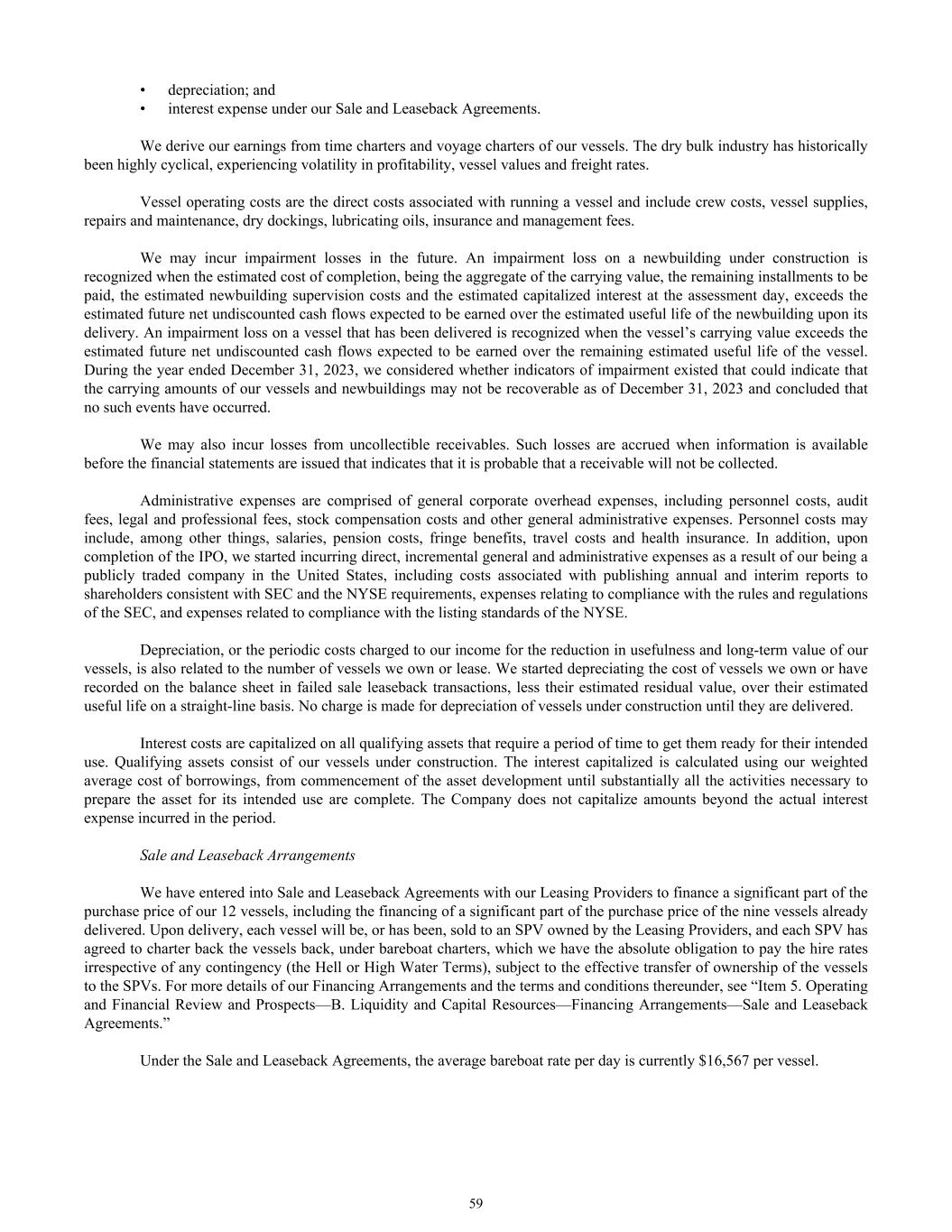
• depreciation; and • interest expense under our Sale and Leaseback Agreements. We derive our earnings from time charters and voyage charters of our vessels. The dry bulk industry has historically been highly cyclical, experiencing volatility in profitability, vessel values and freight rates. Vessel operating costs are the direct costs associated with running a vessel and include crew costs, vessel supplies, repairs and maintenance, dry dockings, lubricating oils, insurance and management fees. We may incur impairment losses in the future. An impairment loss on a newbuilding under construction is recognized when the estimated cost of completion, being the aggregate of the carrying value, the remaining installments to be paid, the estimated newbuilding supervision costs and the estimated capitalized interest at the assessment day, exceeds the estimated future net undiscounted cash flows expected to be earned over the estimated useful life of the newbuilding upon its delivery. An impairment loss on a vessel that has been delivered is recognized when the vessel’s carrying value exceeds the estimated future net undiscounted cash flows expected to be earned over the remaining estimated useful life of the vessel. During the year ended December 31, 2023, we considered whether indicators of impairment existed that could indicate that the carrying amounts of our vessels and newbuildings may not be recoverable as of December 31, 2023 and concluded that no such events have occurred. We may also incur losses from uncollectible receivables. Such losses are accrued when information is available before the financial statements are issued that indicates that it is probable that a receivable will not be collected. Administrative expenses are comprised of general corporate overhead expenses, including personnel costs, audit fees, legal and professional fees, stock compensation costs and other general administrative expenses. Personnel costs may include, among other things, salaries, pension costs, fringe benefits, travel costs and health insurance. In addition, upon completion of the IPO, we started incurring direct, incremental general and administrative expenses as a result of our being a publicly traded company in the United States, including costs associated with publishing annual and interim reports to shareholders consistent with SEC and the NYSE requirements, expenses relating to compliance with the rules and regulations of the SEC, and expenses related to compliance with the listing standards of the NYSE. Depreciation, or the periodic costs charged to our income for the reduction in usefulness and long-term value of our vessels, is also related to the number of vessels we own or lease. We started depreciating the cost of vessels we own or have recorded on the balance sheet in failed sale leaseback transactions, less their estimated residual value, over their estimated useful life on a straight-line basis. No charge is made for depreciation of vessels under construction until they are delivered. Interest costs are capitalized on all qualifying assets that require a period of time to get them ready for their intended use. Qualifying assets consist of our vessels under construction. The interest capitalized is calculated using our weighted average cost of borrowings, from commencement of the asset development until substantially all the activities necessary to prepare the asset for its intended use are complete. The Company does not capitalize amounts beyond the actual interest expense incurred in the period. Sale and Leaseback Arrangements We have entered into Sale and Leaseback Agreements with our Leasing Providers to finance a significant part of the purchase price of our 12 vessels, including the financing of a significant part of the purchase price of the nine vessels already delivered. Upon delivery, each vessel will be, or has been, sold to an SPV owned by the Leasing Providers, and each SPV has agreed to charter back the vessels back, under bareboat charters, which we have the absolute obligation to pay the hire rates irrespective of any contingency (the Hell or High Water Terms), subject to the effective transfer of ownership of the vessels to the SPVs. For more details of our Financing Arrangements and the terms and conditions thereunder, see “Item 5. Operating and Financial Review and Prospects—B. Liquidity and Capital Resources—Financing Arrangements—Sale and Leaseback Agreements.” Under the Sale and Leaseback Agreements, the average bareboat rate per day is currently $16,567 per vessel. 59
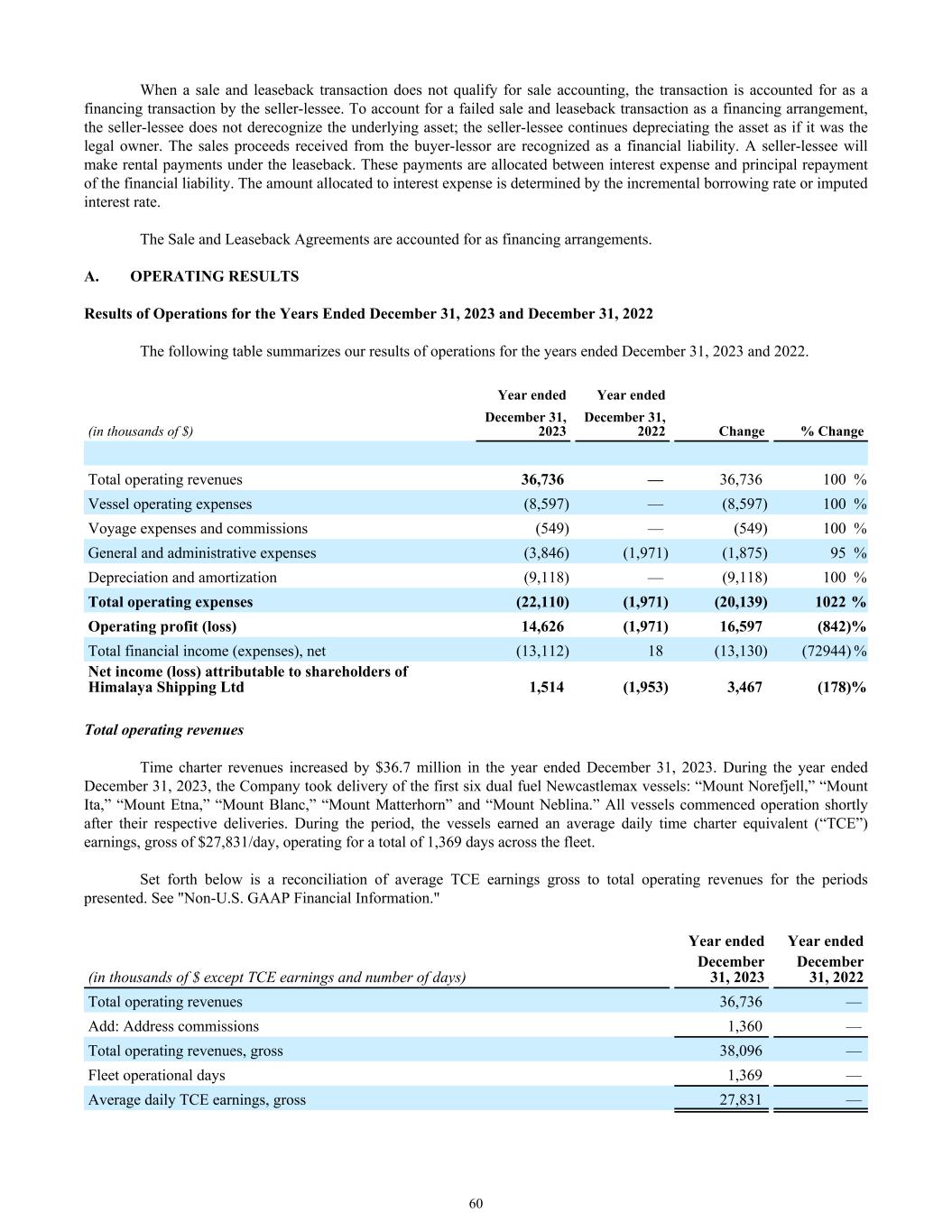
When a sale and leaseback transaction does not qualify for sale accounting, the transaction is accounted for as a financing transaction by the seller-lessee. To account for a failed sale and leaseback transaction as a financing arrangement, the seller-lessee does not derecognize the underlying asset; the seller-lessee continues depreciating the asset as if it was the legal owner. The sales proceeds received from the buyer-lessor are recognized as a financial liability. A seller-lessee will make rental payments under the leaseback. These payments are allocated between interest expense and principal repayment of the financial liability. The amount allocated to interest expense is determined by the incremental borrowing rate or imputed interest rate. The Sale and Leaseback Agreements are accounted for as financing arrangements. A. OPERATING RESULTS Results of Operations for the Years Ended December 31, 2023 and December 31, 2022 The following table summarizes our results of operations for the years ended December 31, 2023 and 2022. Year ended Year ended (in thousands of $) December 31, 2023 December 31, 2022 Change % Change Total operating revenues 36,736 — 36,736 100 % Vessel operating expenses (8,597) — (8,597) 100 % Voyage expenses and commissions (549) — (549) 100 % General and administrative expenses (3,846) (1,971) (1,875) 95 % Depreciation and amortization (9,118) — (9,118) 100 % Total operating expenses (22,110) (1,971) (20,139) 1022 % Operating profit (loss) 14,626 (1,971) 16,597 (842) % Total financial income (expenses), net (13,112) 18 (13,130) (72944) % Net income (loss) attributable to shareholders of Himalaya Shipping Ltd 1,514 (1,953) 3,467 (178) % Total operating revenues Time charter revenues increased by $36.7 million in the year ended December 31, 2023. During the year ended December 31, 2023, the Company took delivery of the first six dual fuel Newcastlemax vessels: “Mount Norefjell,” “Mount Ita,” “Mount Etna,” “Mount Blanc,” “Mount Matterhorn” and “Mount Neblina.” All vessels commenced operation shortly after their respective deliveries. During the period, the vessels earned an average daily time charter equivalent (“TCE”) earnings, gross of $27,831/day, operating for a total of 1,369 days across the fleet. Set forth below is a reconciliation of average TCE earnings gross to total operating revenues for the periods presented. See "Non-U.S. GAAP Financial Information." Year ended Year ended (in thousands of $ except TCE earnings and number of days) December 31, 2023 December 31, 2022 Total operating revenues 36,736 — Add: Address commissions 1,360 — Total operating revenues, gross 38,096 — Fleet operational days 1,369 — Average daily TCE earnings, gross 27,831 — 60
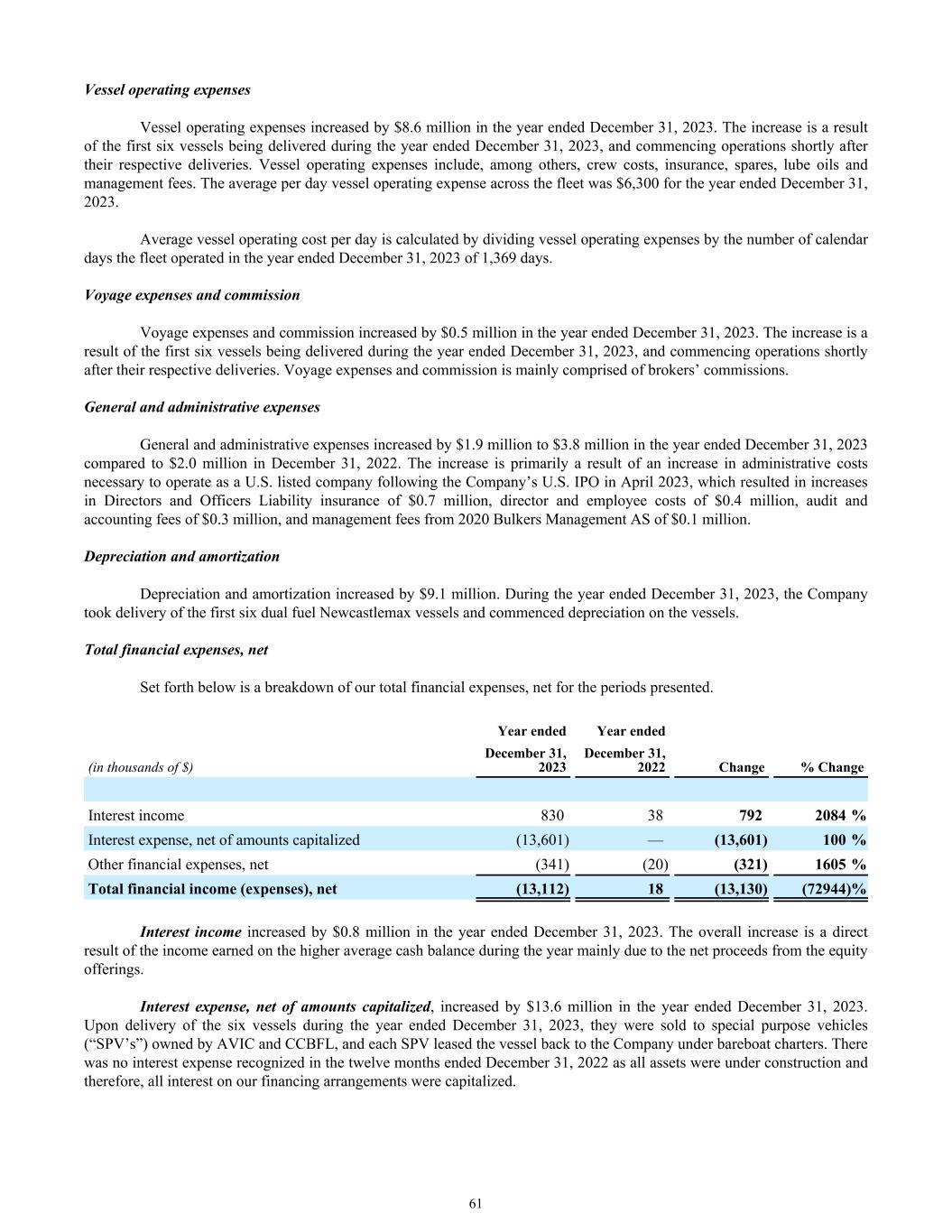
Vessel operating expenses Vessel operating expenses increased by $8.6 million in the year ended December 31, 2023. The increase is a result of the first six vessels being delivered during the year ended December 31, 2023, and commencing operations shortly after their respective deliveries. Vessel operating expenses include, among others, crew costs, insurance, spares, lube oils and management fees. The average per day vessel operating expense across the fleet was $6,300 for the year ended December 31, 2023. Average vessel operating cost per day is calculated by dividing vessel operating expenses by the number of calendar days the fleet operated in the year ended December 31, 2023 of 1,369 days. Voyage expenses and commission Voyage expenses and commission increased by $0.5 million in the year ended December 31, 2023. The increase is a result of the first six vessels being delivered during the year ended December 31, 2023, and commencing operations shortly after their respective deliveries. Voyage expenses and commission is mainly comprised of brokers’ commissions. General and administrative expenses General and administrative expenses increased by $1.9 million to $3.8 million in the year ended December 31, 2023 compared to $2.0 million in December 31, 2022. The increase is primarily a result of an increase in administrative costs necessary to operate as a U.S. listed company following the Company’s U.S. IPO in April 2023, which resulted in increases in Directors and Officers Liability insurance of $0.7 million, director and employee costs of $0.4 million, audit and accounting fees of $0.3 million, and management fees from 2020 Bulkers Management AS of $0.1 million. Depreciation and amortization Depreciation and amortization increased by $9.1 million. During the year ended December 31, 2023, the Company took delivery of the first six dual fuel Newcastlemax vessels and commenced depreciation on the vessels. Total financial expenses, net Set forth below is a breakdown of our total financial expenses, net for the periods presented. Year ended Year ended (in thousands of $) December 31, 2023 December 31, 2022 Change % Change Interest income 830 38 792 2084 % Interest expense, net of amounts capitalized (13,601) — (13,601) 100 % Other financial expenses, net (341) (20) (321) 1605 % Total financial income (expenses), net (13,112) 18 (13,130) (72944) % Interest income increased by $0.8 million in the year ended December 31, 2023. The overall increase is a direct result of the income earned on the higher average cash balance during the year mainly due to the net proceeds from the equity offerings. Interest expense, net of amounts capitalized, increased by $13.6 million in the year ended December 31, 2023. Upon delivery of the six vessels during the year ended December 31, 2023, they were sold to special purpose vehicles (“SPV’s”) owned by AVIC and CCBFL, and each SPV leased the vessel back to the Company under bareboat charters. There was no interest expense recognized in the twelve months ended December 31, 2022 as all assets were under construction and therefore, all interest on our financing arrangements were capitalized. 61
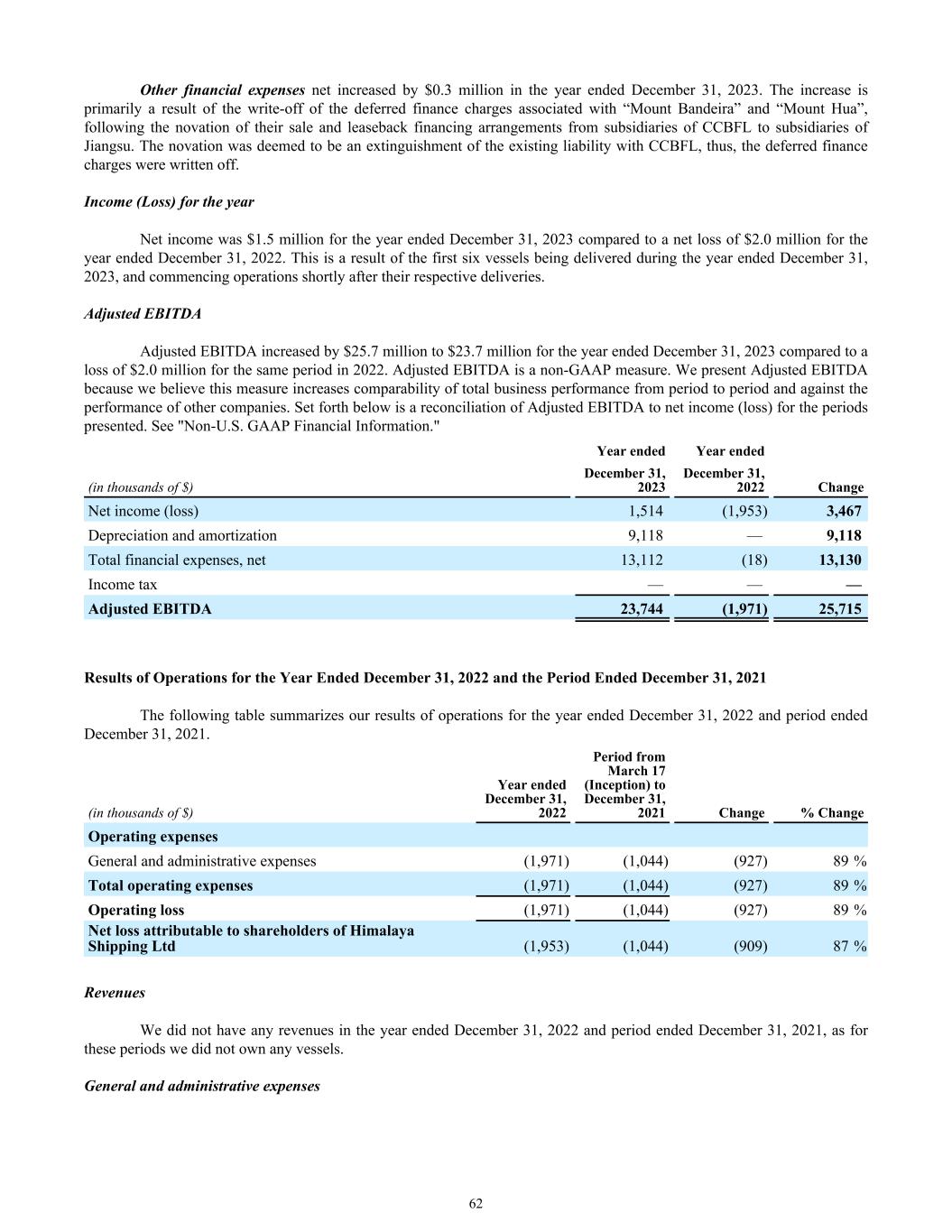
Other financial expenses net increased by $0.3 million in the year ended December 31, 2023. The increase is primarily a result of the write-off of the deferred finance charges associated with “Mount Bandeira” and “Mount Hua”, following the novation of their sale and leaseback financing arrangements from subsidiaries of CCBFL to subsidiaries of Jiangsu. The novation was deemed to be an extinguishment of the existing liability with CCBFL, thus, the deferred finance charges were written off. Income (Loss) for the year Net income was $1.5 million for the year ended December 31, 2023 compared to a net loss of $2.0 million for the year ended December 31, 2022. This is a result of the first six vessels being delivered during the year ended December 31, 2023, and commencing operations shortly after their respective deliveries. Adjusted EBITDA Adjusted EBITDA increased by $25.7 million to $23.7 million for the year ended December 31, 2023 compared to a loss of $2.0 million for the same period in 2022. Adjusted EBITDA is a non-GAAP measure. We present Adjusted EBITDA because we believe this measure increases comparability of total business performance from period to period and against the performance of other companies. Set forth below is a reconciliation of Adjusted EBITDA to net income (loss) for the periods presented. See "Non-U.S. GAAP Financial Information." Year ended Year ended (in thousands of $) December 31, 2023 December 31, 2022 Change Net income (loss) 1,514 (1,953) 3,467 Depreciation and amortization 9,118 — 9,118 Total financial expenses, net 13,112 (18) 13,130 Income tax — — — Adjusted EBITDA 23,744 (1,971) 25,715 Results of Operations for the Year Ended December 31, 2022 and the Period Ended December 31, 2021 The following table summarizes our results of operations for the year ended December 31, 2022 and period ended December 31, 2021. (in thousands of $) Year ended December 31, 2022 Period from March 17 (Inception) to December 31, 2021 Change % Change Operating expenses General and administrative expenses (1,971) (1,044) (927) 89 % Total operating expenses (1,971) (1,044) (927) 89 % Operating loss (1,971) (1,044) (927) 89 % Net loss attributable to shareholders of Himalaya Shipping Ltd (1,953) (1,044) (909) 87 % Revenues We did not have any revenues in the year ended December 31, 2022 and period ended December 31, 2021, as for these periods we did not own any vessels. General and administrative expenses 62
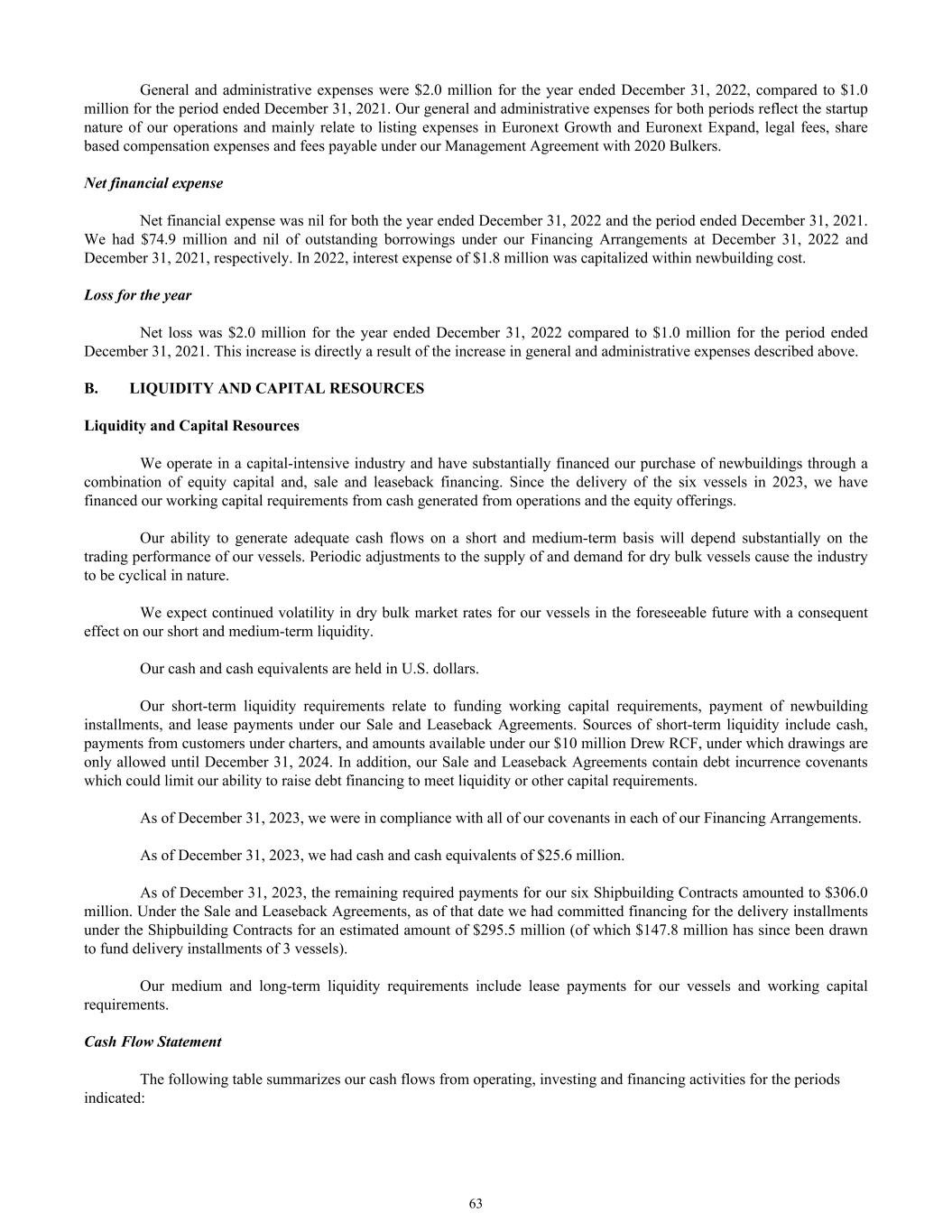
General and administrative expenses were $2.0 million for the year ended December 31, 2022, compared to $1.0 million for the period ended December 31, 2021. Our general and administrative expenses for both periods reflect the startup nature of our operations and mainly relate to listing expenses in Euronext Growth and Euronext Expand, legal fees, share based compensation expenses and fees payable under our Management Agreement with 2020 Bulkers. Net financial expense Net financial expense was nil for both the year ended December 31, 2022 and the period ended December 31, 2021. We had $74.9 million and nil of outstanding borrowings under our Financing Arrangements at December 31, 2022 and December 31, 2021, respectively. In 2022, interest expense of $1.8 million was capitalized within newbuilding cost. Loss for the year Net loss was $2.0 million for the year ended December 31, 2022 compared to $1.0 million for the period ended December 31, 2021. This increase is directly a result of the increase in general and administrative expenses described above. B. LIQUIDITY AND CAPITAL RESOURCES Liquidity and Capital Resources We operate in a capital-intensive industry and have substantially financed our purchase of newbuildings through a combination of equity capital and, sale and leaseback financing. Since the delivery of the six vessels in 2023, we have financed our working capital requirements from cash generated from operations and the equity offerings. Our ability to generate adequate cash flows on a short and medium-term basis will depend substantially on the trading performance of our vessels. Periodic adjustments to the supply of and demand for dry bulk vessels cause the industry to be cyclical in nature. We expect continued volatility in dry bulk market rates for our vessels in the foreseeable future with a consequent effect on our short and medium-term liquidity. Our cash and cash equivalents are held in U.S. dollars. Our short-term liquidity requirements relate to funding working capital requirements, payment of newbuilding installments, and lease payments under our Sale and Leaseback Agreements. Sources of short-term liquidity include cash, payments from customers under charters, and amounts available under our $10 million Drew RCF, under which drawings are only allowed until December 31, 2024. In addition, our Sale and Leaseback Agreements contain debt incurrence covenants which could limit our ability to raise debt financing to meet liquidity or other capital requirements. As of December 31, 2023, we were in compliance with all of our covenants in each of our Financing Arrangements. As of December 31, 2023, we had cash and cash equivalents of $25.6 million. As of December 31, 2023, the remaining required payments for our six Shipbuilding Contracts amounted to $306.0 million. Under the Sale and Leaseback Agreements, as of that date we had committed financing for the delivery installments under the Shipbuilding Contracts for an estimated amount of $295.5 million (of which $147.8 million has since been drawn to fund delivery installments of 3 vessels). Our medium and long-term liquidity requirements include lease payments for our vessels and working capital requirements. Cash Flow Statement The following table summarizes our cash flows from operating, investing and financing activities for the periods indicated: 63

(in millions of U.S. dollars) Year ended December 31, 2023 Year ended December 31, 2022 March 17 (Inception) to December 31, 2021 Net cash provided by (used in) operating activities 6,474 (1,446) (516) Net cash used in investing activities (413,055) (78,198) (68,800) Net cash provided by financing activities 431,871 68,623 80,600 Net increase/(decrease) in cash, cash equivalents and restricted cash 25,290 (11,021) 11,284 Cash and cash equivalents at the beginning of the period 263 11,284 — Cash and cash equivalents at the end of the period 25,553 263 11,284 Supplementary disclosure of cash flow information Non-cash settlement of debt — — (13,600) Non-cash share issuance — — 13,600 Non-cash additions in respect of newbuildings — (13,683) (13,600) Issuance of liabilities for newbuilding installments — 13,683 13,600 Interest paid, net of capitalized interest (12,992) — — Net cash provided by (used in) operating activities Net cash provided by operating activities was $6.5 million for the year ended December 31, 2023 compared to net cash used in operating activities of $1.4 million for 2022, primarily as a result of operating profits for 2023 of $14.6 million generated from the operations of our six vessels following their deliveries throughout 2023. This was partially offset by: • settlement of support fees under our Corporate Support Agreement with Magni Partners (Bermuda) Ltd. of $2.7 million due upon delivery of the first four vessels, which equals the aggregate agreed address commissions payable to our relevant subsidiaries in connection with the first four vessels, which were agreed with New Times Shipyard, before the company was opened to external investors; and • an increase in other current assets due to prepayment of interest on the sale leaseback financing associated with four of the vessels that have been delivered of $2.4 million, prepayment of insurance associated with the six vessels currently delivered and operating of $0.4 million and prepayment of Directors and Officers’ Liability insurance of $0.2 million, and $2.3 million of advanced funding to vessel managers. Net cash used in operating activities increased by $0.9 million to $1.4 million for the year ended December 31, 2022 compared to $0.5 million for the period ended December 31, 2021. The increase was primarily due to higher general and administrative expenses for the year ended December 31, 2022 compared to the period ended December 31, 2021. Net cash used in investing activities Net cash used in investing activities of $413.1 million for the year ended December 31, 2023 is comprised of: • $41.3 million for the third installment payments for “Mount Bandeira,” “Mount Hua,” “Mount Elbrus,” “Mount Denali,” “Mount Aconcagua” and “Mount Emai”; • $48.1 million for the fourth installment payments for “Mount Neblina,” “Mount Bandeira,” “Mount Hua,” “Mount Elbrus,” “Mount Denali,” “Mount Aconcagua” and “Mount Emai”; • $302.6 million for the fifth and sixth installment payments for “Mount Norefjell,” “Mount Ita,” “Mount Etna,” “Mount Blanc,” “Mount Matterhorn” and “Mount Neblina”; • payment of $5.1 million on “Mount Bandeira” and “Mount Hua” in advance of their delivery in January 2024 for costs which were not covered by the sale leaseback agreement with Jiangsu; and • $15.9 million in newbuilding supervision fees and capitalized interest. 64
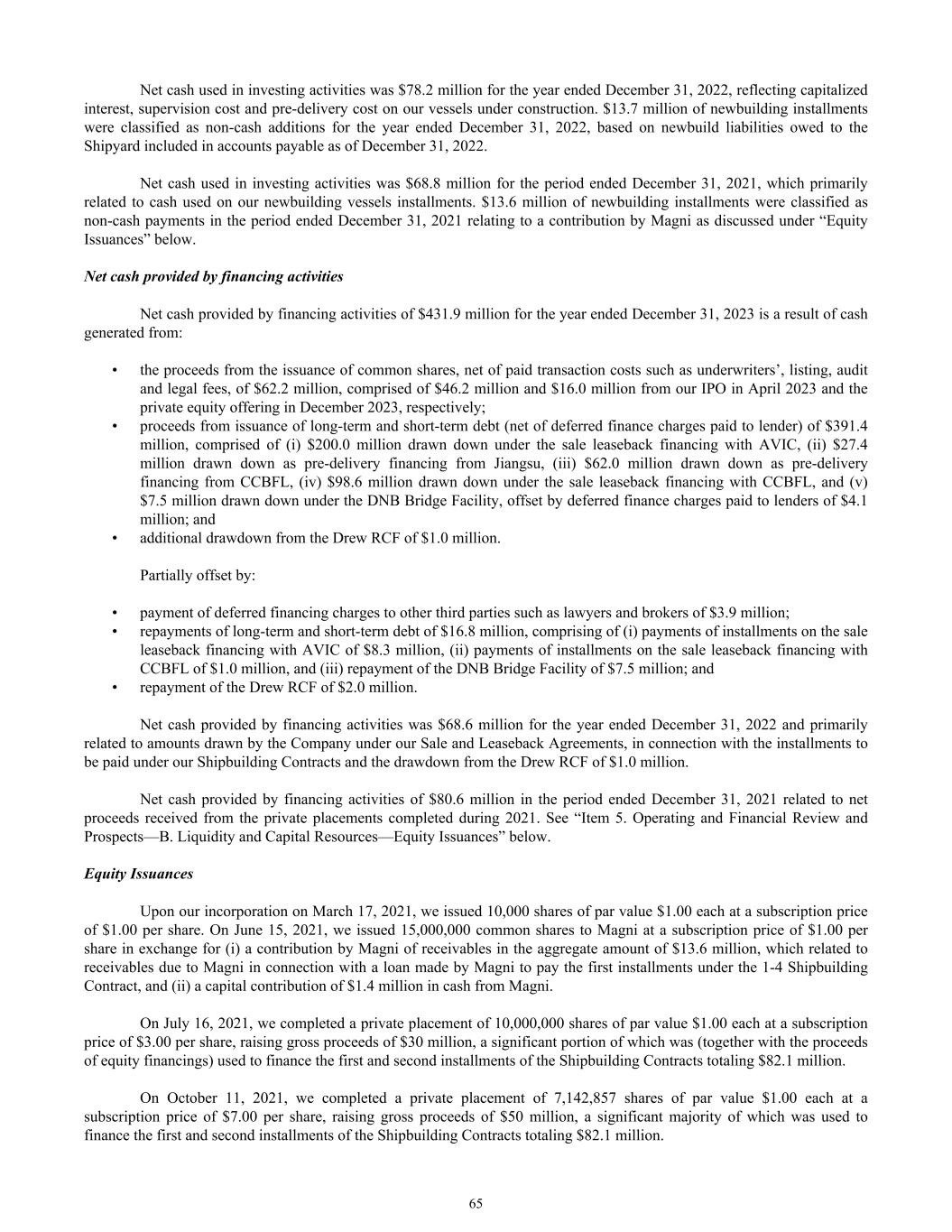
Net cash used in investing activities was $78.2 million for the year ended December 31, 2022, reflecting capitalized interest, supervision cost and pre-delivery cost on our vessels under construction. $13.7 million of newbuilding installments were classified as non-cash additions for the year ended December 31, 2022, based on newbuild liabilities owed to the Shipyard included in accounts payable as of December 31, 2022. Net cash used in investing activities was $68.8 million for the period ended December 31, 2021, which primarily related to cash used on our newbuilding vessels installments. $13.6 million of newbuilding installments were classified as non-cash payments in the period ended December 31, 2021 relating to a contribution by Magni as discussed under “Equity Issuances” below. Net cash provided by financing activities Net cash provided by financing activities of $431.9 million for the year ended December 31, 2023 is a result of cash generated from: • the proceeds from the issuance of common shares, net of paid transaction costs such as underwriters’, listing, audit and legal fees, of $62.2 million, comprised of $46.2 million and $16.0 million from our IPO in April 2023 and the private equity offering in December 2023, respectively; • proceeds from issuance of long-term and short-term debt (net of deferred finance charges paid to lender) of $391.4 million, comprised of (i) $200.0 million drawn down under the sale leaseback financing with AVIC, (ii) $27.4 million drawn down as pre-delivery financing from Jiangsu, (iii) $62.0 million drawn down as pre-delivery financing from CCBFL, (iv) $98.6 million drawn down under the sale leaseback financing with CCBFL, and (v) $7.5 million drawn down under the DNB Bridge Facility, offset by deferred finance charges paid to lenders of $4.1 million; and • additional drawdown from the Drew RCF of $1.0 million. Partially offset by: • payment of deferred financing charges to other third parties such as lawyers and brokers of $3.9 million; • repayments of long-term and short-term debt of $16.8 million, comprising of (i) payments of installments on the sale leaseback financing with AVIC of $8.3 million, (ii) payments of installments on the sale leaseback financing with CCBFL of $1.0 million, and (iii) repayment of the DNB Bridge Facility of $7.5 million; and • repayment of the Drew RCF of $2.0 million. Net cash provided by financing activities was $68.6 million for the year ended December 31, 2022 and primarily related to amounts drawn by the Company under our Sale and Leaseback Agreements, in connection with the installments to be paid under our Shipbuilding Contracts and the drawdown from the Drew RCF of $1.0 million. Net cash provided by financing activities of $80.6 million in the period ended December 31, 2021 related to net proceeds received from the private placements completed during 2021. See “Item 5. Operating and Financial Review and Prospects—B. Liquidity and Capital Resources—Equity Issuances” below. Equity Issuances Upon our incorporation on March 17, 2021, we issued 10,000 shares of par value $1.00 each at a subscription price of $1.00 per share. On June 15, 2021, we issued 15,000,000 common shares to Magni at a subscription price of $1.00 per share in exchange for (i) a contribution by Magni of receivables in the aggregate amount of $13.6 million, which related to receivables due to Magni in connection with a loan made by Magni to pay the first installments under the 1-4 Shipbuilding Contract, and (ii) a capital contribution of $1.4 million in cash from Magni. On July 16, 2021, we completed a private placement of 10,000,000 shares of par value $1.00 each at a subscription price of $3.00 per share, raising gross proceeds of $30 million, a significant portion of which was (together with the proceeds of equity financings) used to finance the first and second installments of the Shipbuilding Contracts totaling $82.1 million. On October 11, 2021, we completed a private placement of 7,142,857 shares of par value $1.00 each at a subscription price of $7.00 per share, raising gross proceeds of $50 million, a significant majority of which was used to finance the first and second installments of the Shipbuilding Contracts totaling $82.1 million. 65
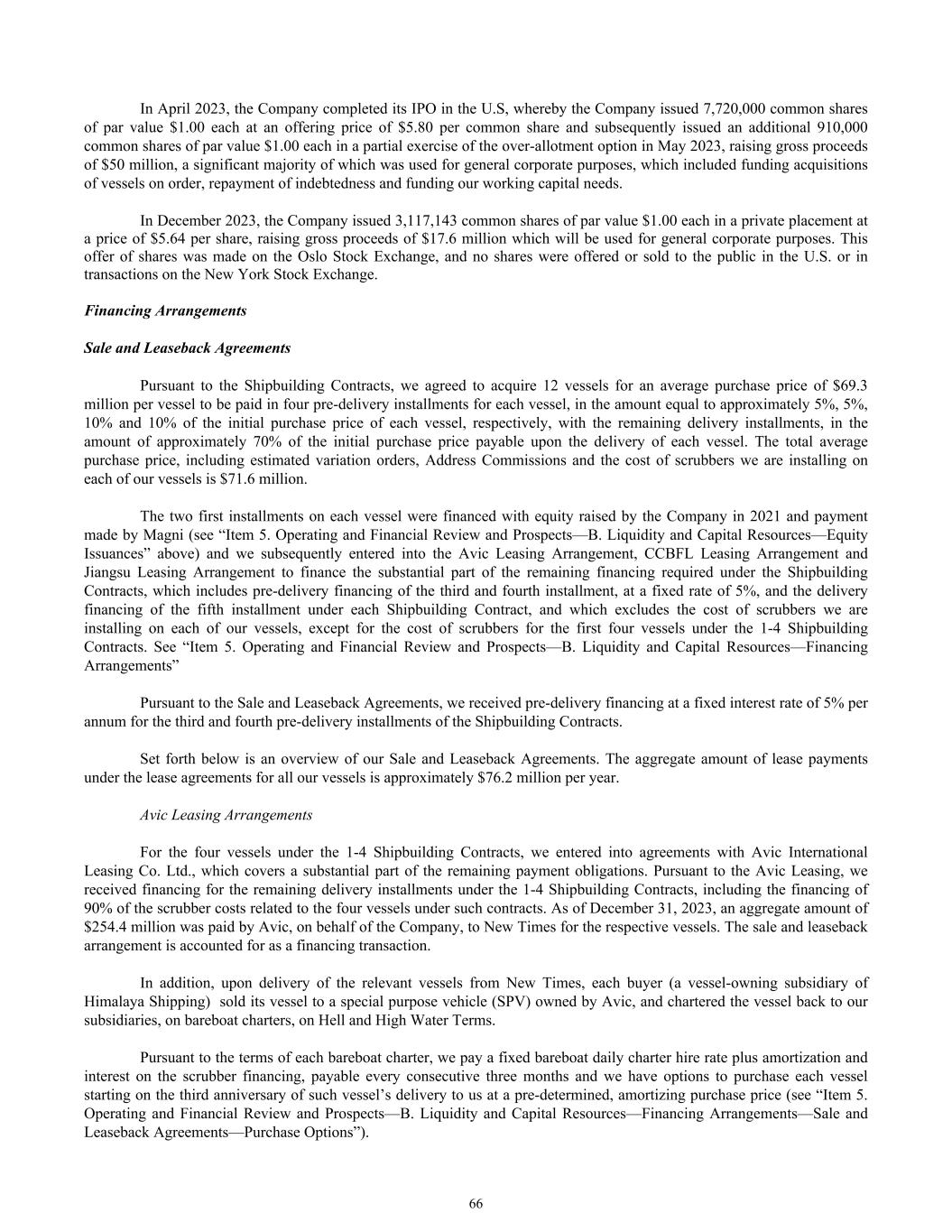
In April 2023, the Company completed its IPO in the U.S, whereby the Company issued 7,720,000 common shares of par value $1.00 each at an offering price of $5.80 per common share and subsequently issued an additional 910,000 common shares of par value $1.00 each in a partial exercise of the over-allotment option in May 2023, raising gross proceeds of $50 million, a significant majority of which was used for general corporate purposes, which included funding acquisitions of vessels on order, repayment of indebtedness and funding our working capital needs. In December 2023, the Company issued 3,117,143 common shares of par value $1.00 each in a private placement at a price of $5.64 per share, raising gross proceeds of $17.6 million which will be used for general corporate purposes. This offer of shares was made on the Oslo Stock Exchange, and no shares were offered or sold to the public in the U.S. or in transactions on the New York Stock Exchange. Financing Arrangements Sale and Leaseback Agreements Pursuant to the Shipbuilding Contracts, we agreed to acquire 12 vessels for an average purchase price of $69.3 million per vessel to be paid in four pre-delivery installments for each vessel, in the amount equal to approximately 5%, 5%, 10% and 10% of the initial purchase price of each vessel, respectively, with the remaining delivery installments, in the amount of approximately 70% of the initial purchase price payable upon the delivery of each vessel. The total average purchase price, including estimated variation orders, Address Commissions and the cost of scrubbers we are installing on each of our vessels is $71.6 million. The two first installments on each vessel were financed with equity raised by the Company in 2021 and payment made by Magni (see “Item 5. Operating and Financial Review and Prospects—B. Liquidity and Capital Resources—Equity Issuances” above) and we subsequently entered into the Avic Leasing Arrangement, CCBFL Leasing Arrangement and Jiangsu Leasing Arrangement to finance the substantial part of the remaining financing required under the Shipbuilding Contracts, which includes pre-delivery financing of the third and fourth installment, at a fixed rate of 5%, and the delivery financing of the fifth installment under each Shipbuilding Contract, and which excludes the cost of scrubbers we are installing on each of our vessels, except for the cost of scrubbers for the first four vessels under the 1-4 Shipbuilding Contracts. See “Item 5. Operating and Financial Review and Prospects—B. Liquidity and Capital Resources—Financing Arrangements” Pursuant to the Sale and Leaseback Agreements, we received pre-delivery financing at a fixed interest rate of 5% per annum for the third and fourth pre-delivery installments of the Shipbuilding Contracts. Set forth below is an overview of our Sale and Leaseback Agreements. The aggregate amount of lease payments under the lease agreements for all our vessels is approximately $76.2 million per year. Avic Leasing Arrangements For the four vessels under the 1-4 Shipbuilding Contracts, we entered into agreements with Avic International Leasing Co. Ltd., which covers a substantial part of the remaining payment obligations. Pursuant to the Avic Leasing, we received financing for the remaining delivery installments under the 1-4 Shipbuilding Contracts, including the financing of 90% of the scrubber costs related to the four vessels under such contracts. As of December 31, 2023, an aggregate amount of $254.4 million was paid by Avic, on behalf of the Company, to New Times for the respective vessels. The sale and leaseback arrangement is accounted for as a financing transaction. In addition, upon delivery of the relevant vessels from New Times, each buyer (a vessel-owning subsidiary of Himalaya Shipping) sold its vessel to a special purpose vehicle (SPV) owned by Avic, and chartered the vessel back to our subsidiaries, on bareboat charters, on Hell and High Water Terms. Pursuant to the terms of each bareboat charter, we pay a fixed bareboat daily charter hire rate plus amortization and interest on the scrubber financing, payable every consecutive three months and we have options to purchase each vessel starting on the third anniversary of such vessel’s delivery to us at a pre-determined, amortizing purchase price (see “Item 5. Operating and Financial Review and Prospects—B. Liquidity and Capital Resources—Financing Arrangements—Sale and Leaseback Agreements—Purchase Options”). 66
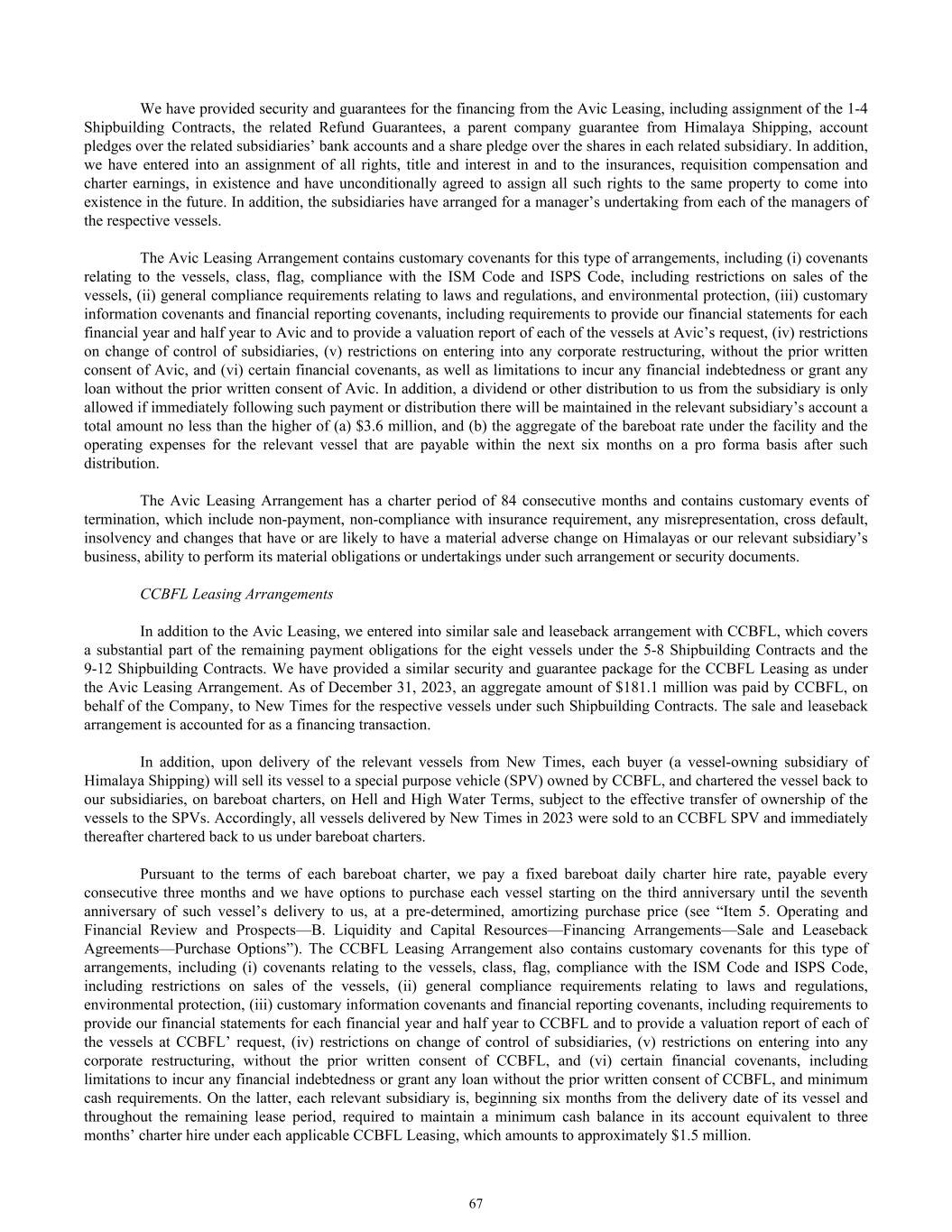
We have provided security and guarantees for the financing from the Avic Leasing, including assignment of the 1-4 Shipbuilding Contracts, the related Refund Guarantees, a parent company guarantee from Himalaya Shipping, account pledges over the related subsidiaries’ bank accounts and a share pledge over the shares in each related subsidiary. In addition, we have entered into an assignment of all rights, title and interest in and to the insurances, requisition compensation and charter earnings, in existence and have unconditionally agreed to assign all such rights to the same property to come into existence in the future. In addition, the subsidiaries have arranged for a manager’s undertaking from each of the managers of the respective vessels. The Avic Leasing Arrangement contains customary covenants for this type of arrangements, including (i) covenants relating to the vessels, class, flag, compliance with the ISM Code and ISPS Code, including restrictions on sales of the vessels, (ii) general compliance requirements relating to laws and regulations, and environmental protection, (iii) customary information covenants and financial reporting covenants, including requirements to provide our financial statements for each financial year and half year to Avic and to provide a valuation report of each of the vessels at Avic’s request, (iv) restrictions on change of control of subsidiaries, (v) restrictions on entering into any corporate restructuring, without the prior written consent of Avic, and (vi) certain financial covenants, as well as limitations to incur any financial indebtedness or grant any loan without the prior written consent of Avic. In addition, a dividend or other distribution to us from the subsidiary is only allowed if immediately following such payment or distribution there will be maintained in the relevant subsidiary’s account a total amount no less than the higher of (a) $3.6 million, and (b) the aggregate of the bareboat rate under the facility and the operating expenses for the relevant vessel that are payable within the next six months on a pro forma basis after such distribution. The Avic Leasing Arrangement has a charter period of 84 consecutive months and contains customary events of termination, which include non-payment, non-compliance with insurance requirement, any misrepresentation, cross default, insolvency and changes that have or are likely to have a material adverse change on Himalayas or our relevant subsidiary’s business, ability to perform its material obligations or undertakings under such arrangement or security documents. CCBFL Leasing Arrangements In addition to the Avic Leasing, we entered into similar sale and leaseback arrangement with CCBFL, which covers a substantial part of the remaining payment obligations for the eight vessels under the 5-8 Shipbuilding Contracts and the 9-12 Shipbuilding Contracts. We have provided a similar security and guarantee package for the CCBFL Leasing as under the Avic Leasing Arrangement. As of December 31, 2023, an aggregate amount of $181.1 million was paid by CCBFL, on behalf of the Company, to New Times for the respective vessels under such Shipbuilding Contracts. The sale and leaseback arrangement is accounted for as a financing transaction. In addition, upon delivery of the relevant vessels from New Times, each buyer (a vessel-owning subsidiary of Himalaya Shipping) will sell its vessel to a special purpose vehicle (SPV) owned by CCBFL, and chartered the vessel back to our subsidiaries, on bareboat charters, on Hell and High Water Terms, subject to the effective transfer of ownership of the vessels to the SPVs. Accordingly, all vessels delivered by New Times in 2023 were sold to an CCBFL SPV and immediately thereafter chartered back to us under bareboat charters. Pursuant to the terms of each bareboat charter, we pay a fixed bareboat daily charter hire rate, payable every consecutive three months and we have options to purchase each vessel starting on the third anniversary until the seventh anniversary of such vessel’s delivery to us, at a pre-determined, amortizing purchase price (see “Item 5. Operating and Financial Review and Prospects—B. Liquidity and Capital Resources—Financing Arrangements—Sale and Leaseback Agreements—Purchase Options”). The CCBFL Leasing Arrangement also contains customary covenants for this type of arrangements, including (i) covenants relating to the vessels, class, flag, compliance with the ISM Code and ISPS Code, including restrictions on sales of the vessels, (ii) general compliance requirements relating to laws and regulations, environmental protection, (iii) customary information covenants and financial reporting covenants, including requirements to provide our financial statements for each financial year and half year to CCBFL and to provide a valuation report of each of the vessels at CCBFL’ request, (iv) restrictions on change of control of subsidiaries, (v) restrictions on entering into any corporate restructuring, without the prior written consent of CCBFL, and (vi) certain financial covenants, including limitations to incur any financial indebtedness or grant any loan without the prior written consent of CCBFL, and minimum cash requirements. On the latter, each relevant subsidiary is, beginning six months from the delivery date of its vessel and throughout the remaining lease period, required to maintain a minimum cash balance in its account equivalent to three months’ charter hire under each applicable CCBFL Leasing, which amounts to approximately $1.5 million. 67
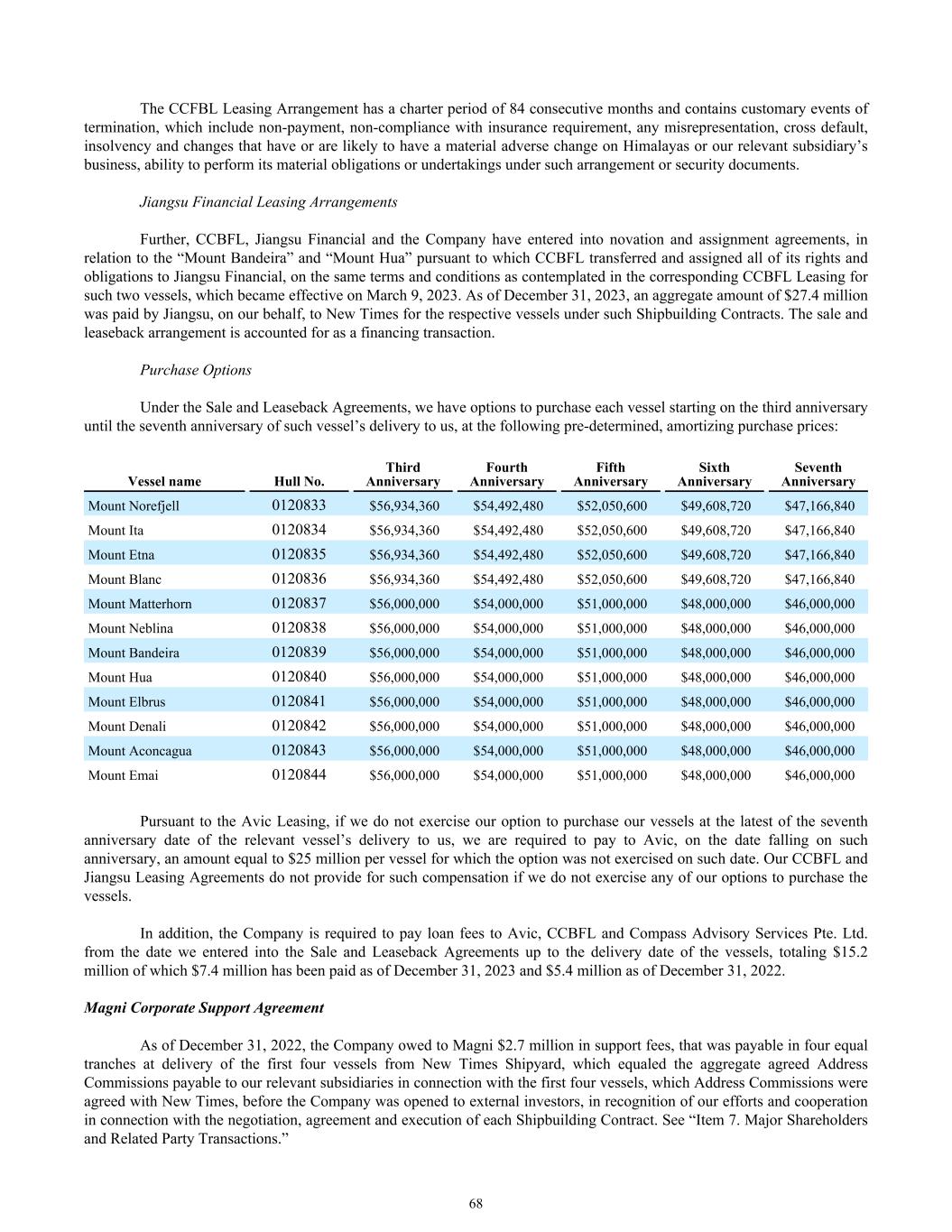
The CCFBL Leasing Arrangement has a charter period of 84 consecutive months and contains customary events of termination, which include non-payment, non-compliance with insurance requirement, any misrepresentation, cross default, insolvency and changes that have or are likely to have a material adverse change on Himalayas or our relevant subsidiary’s business, ability to perform its material obligations or undertakings under such arrangement or security documents. Jiangsu Financial Leasing Arrangements Further, CCBFL, Jiangsu Financial and the Company have entered into novation and assignment agreements, in relation to the “Mount Bandeira” and “Mount Hua” pursuant to which CCBFL transferred and assigned all of its rights and obligations to Jiangsu Financial, on the same terms and conditions as contemplated in the corresponding CCBFL Leasing for such two vessels, which became effective on March 9, 2023. As of December 31, 2023, an aggregate amount of $27.4 million was paid by Jiangsu, on our behalf, to New Times for the respective vessels under such Shipbuilding Contracts. The sale and leaseback arrangement is accounted for as a financing transaction. Purchase Options Under the Sale and Leaseback Agreements, we have options to purchase each vessel starting on the third anniversary until the seventh anniversary of such vessel’s delivery to us, at the following pre-determined, amortizing purchase prices: Vessel name Hull No. Third Anniversary Fourth Anniversary Fifth Anniversary Sixth Anniversary Seventh Anniversary Mount Norefjell 0120833 $56,934,360 $54,492,480 $52,050,600 $49,608,720 $47,166,840 Mount Ita 0120834 $56,934,360 $54,492,480 $52,050,600 $49,608,720 $47,166,840 Mount Etna 0120835 $56,934,360 $54,492,480 $52,050,600 $49,608,720 $47,166,840 Mount Blanc 0120836 $56,934,360 $54,492,480 $52,050,600 $49,608,720 $47,166,840 Mount Matterhorn 0120837 $56,000,000 $54,000,000 $51,000,000 $48,000,000 $46,000,000 Mount Neblina 0120838 $56,000,000 $54,000,000 $51,000,000 $48,000,000 $46,000,000 Mount Bandeira 0120839 $56,000,000 $54,000,000 $51,000,000 $48,000,000 $46,000,000 Mount Hua 0120840 $56,000,000 $54,000,000 $51,000,000 $48,000,000 $46,000,000 Mount Elbrus 0120841 $56,000,000 $54,000,000 $51,000,000 $48,000,000 $46,000,000 Mount Denali 0120842 $56,000,000 $54,000,000 $51,000,000 $48,000,000 $46,000,000 Mount Aconcagua 0120843 $56,000,000 $54,000,000 $51,000,000 $48,000,000 $46,000,000 Mount Emai 0120844 $56,000,000 $54,000,000 $51,000,000 $48,000,000 $46,000,000 Pursuant to the Avic Leasing, if we do not exercise our option to purchase our vessels at the latest of the seventh anniversary date of the relevant vessel’s delivery to us, we are required to pay to Avic, on the date falling on such anniversary, an amount equal to $25 million per vessel for which the option was not exercised on such date. Our CCBFL and Jiangsu Leasing Agreements do not provide for such compensation if we do not exercise any of our options to purchase the vessels. In addition, the Company is required to pay loan fees to Avic, CCBFL and Compass Advisory Services Pte. Ltd. from the date we entered into the Sale and Leaseback Agreements up to the delivery date of the vessels, totaling $15.2 million of which $7.4 million has been paid as of December 31, 2023 and $5.4 million as of December 31, 2022. Magni Corporate Support Agreement As of December 31, 2022, the Company owed to Magni $2.7 million in support fees, that was payable in four equal tranches at delivery of the first four vessels from New Times Shipyard, which equaled the aggregate agreed Address Commissions payable to our relevant subsidiaries in connection with the first four vessels, which Address Commissions were agreed with New Times, before the Company was opened to external investors, in recognition of our efforts and cooperation in connection with the negotiation, agreement and execution of each Shipbuilding Contract. See “Item 7. Major Shareholders and Related Party Transactions.” 68
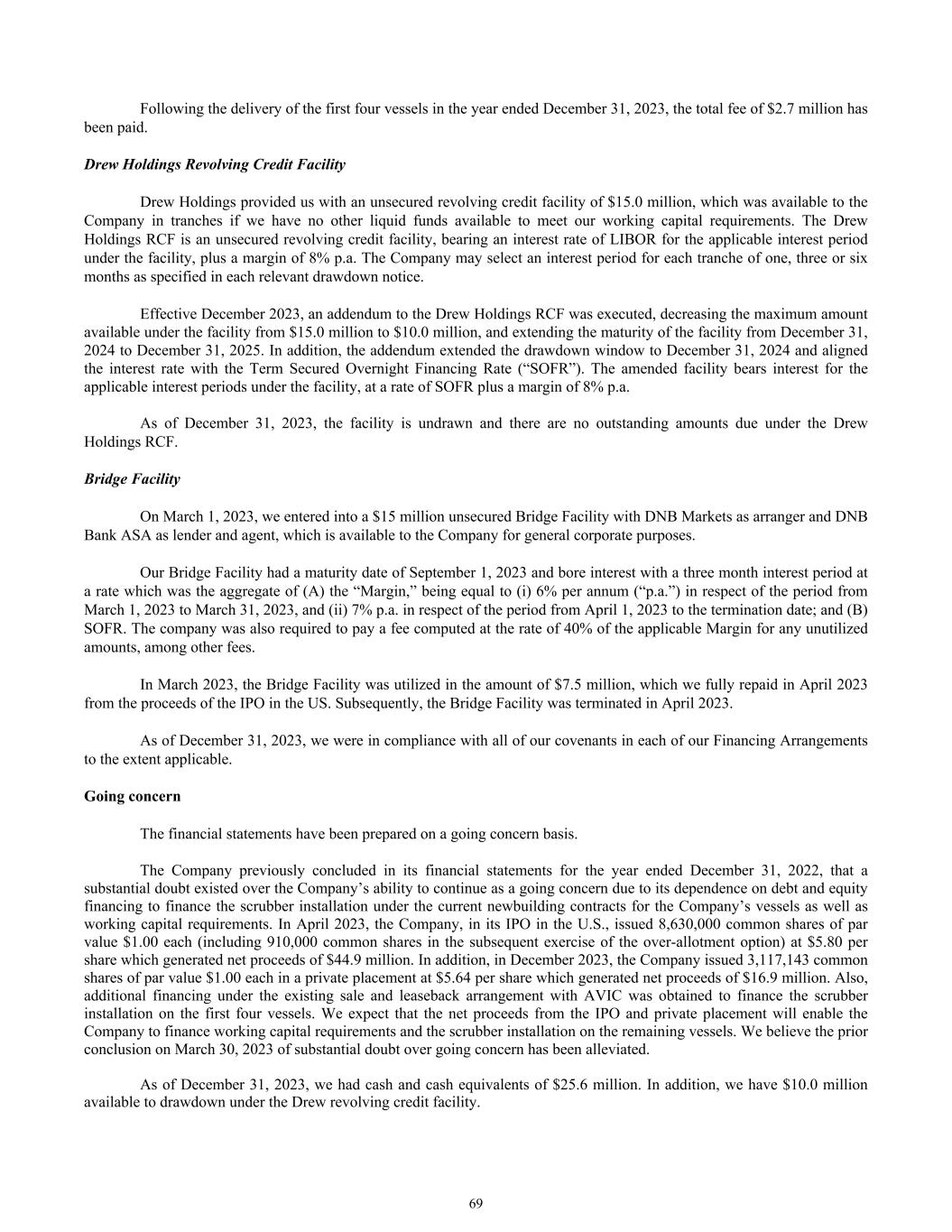
Following the delivery of the first four vessels in the year ended December 31, 2023, the total fee of $2.7 million has been paid. Drew Holdings Revolving Credit Facility Drew Holdings provided us with an unsecured revolving credit facility of $15.0 million, which was available to the Company in tranches if we have no other liquid funds available to meet our working capital requirements. The Drew Holdings RCF is an unsecured revolving credit facility, bearing an interest rate of LIBOR for the applicable interest period under the facility, plus a margin of 8% p.a. The Company may select an interest period for each tranche of one, three or six months as specified in each relevant drawdown notice. Effective December 2023, an addendum to the Drew Holdings RCF was executed, decreasing the maximum amount available under the facility from $15.0 million to $10.0 million, and extending the maturity of the facility from December 31, 2024 to December 31, 2025. In addition, the addendum extended the drawdown window to December 31, 2024 and aligned the interest rate with the Term Secured Overnight Financing Rate (“SOFR”). The amended facility bears interest for the applicable interest periods under the facility, at a rate of SOFR plus a margin of 8% p.a. As of December 31, 2023, the facility is undrawn and there are no outstanding amounts due under the Drew Holdings RCF. Bridge Facility On March 1, 2023, we entered into a $15 million unsecured Bridge Facility with DNB Markets as arranger and DNB Bank ASA as lender and agent, which is available to the Company for general corporate purposes. Our Bridge Facility had a maturity date of September 1, 2023 and bore interest with a three month interest period at a rate which was the aggregate of (A) the “Margin,” being equal to (i) 6% per annum (“p.a.”) in respect of the period from March 1, 2023 to March 31, 2023, and (ii) 7% p.a. in respect of the period from April 1, 2023 to the termination date; and (B) SOFR. The company was also required to pay a fee computed at the rate of 40% of the applicable Margin for any unutilized amounts, among other fees. In March 2023, the Bridge Facility was utilized in the amount of $7.5 million, which we fully repaid in April 2023 from the proceeds of the IPO in the US. Subsequently, the Bridge Facility was terminated in April 2023. As of December 31, 2023, we were in compliance with all of our covenants in each of our Financing Arrangements to the extent applicable. Going concern The financial statements have been prepared on a going concern basis. The Company previously concluded in its financial statements for the year ended December 31, 2022, that a substantial doubt existed over the Company’s ability to continue as a going concern due to its dependence on debt and equity financing to finance the scrubber installation under the current newbuilding contracts for the Company’s vessels as well as working capital requirements. In April 2023, the Company, in its IPO in the U.S., issued 8,630,000 common shares of par value $1.00 each (including 910,000 common shares in the subsequent exercise of the over-allotment option) at $5.80 per share which generated net proceeds of $44.9 million. In addition, in December 2023, the Company issued 3,117,143 common shares of par value $1.00 each in a private placement at $5.64 per share which generated net proceeds of $16.9 million. Also, additional financing under the existing sale and leaseback arrangement with AVIC was obtained to finance the scrubber installation on the first four vessels. We expect that the net proceeds from the IPO and private placement will enable the Company to finance working capital requirements and the scrubber installation on the remaining vessels. We believe the prior conclusion on March 30, 2023 of substantial doubt over going concern has been alleviated. As of December 31, 2023, we had cash and cash equivalents of $25.6 million. In addition, we have $10.0 million available to drawdown under the Drew revolving credit facility. 69
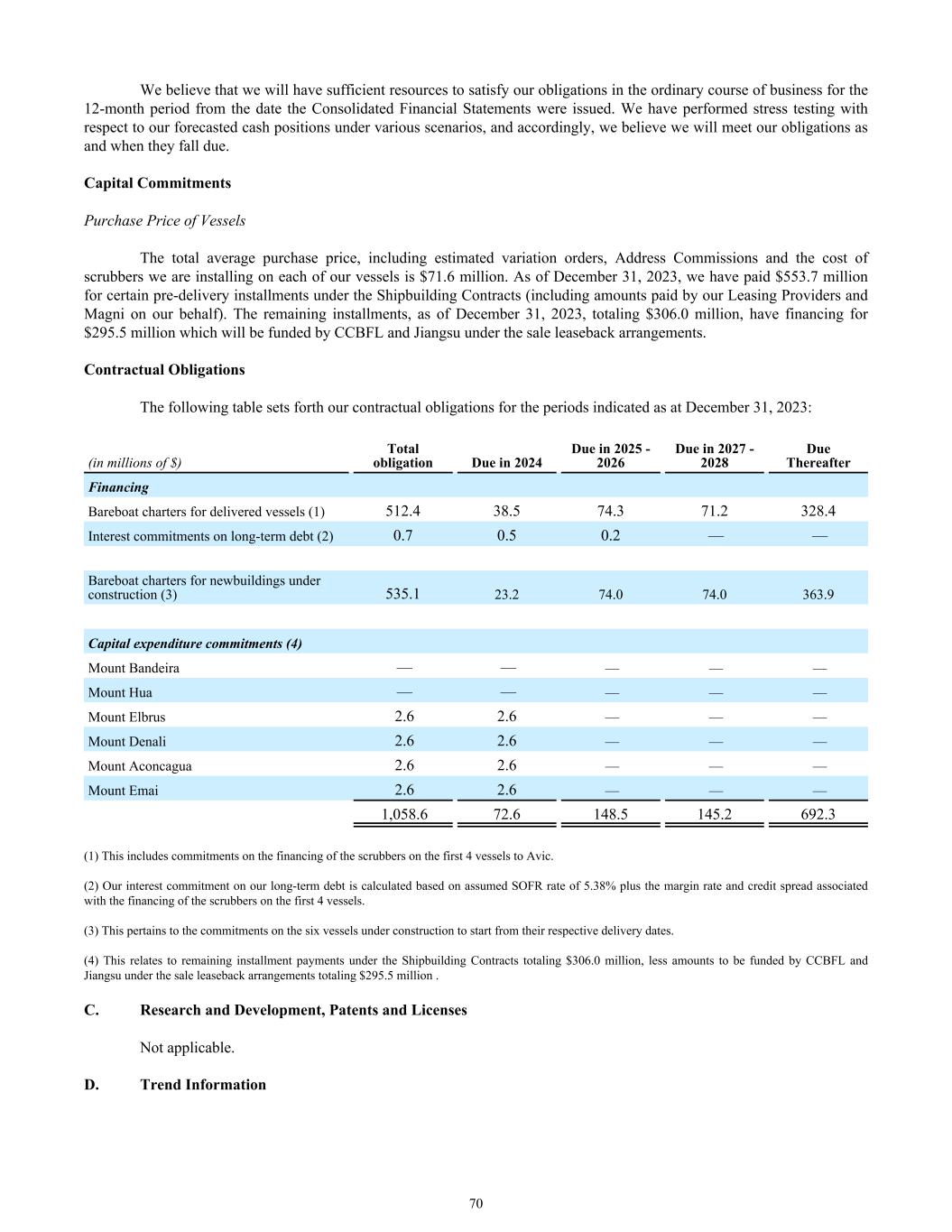
We believe that we will have sufficient resources to satisfy our obligations in the ordinary course of business for the 12-month period from the date the Consolidated Financial Statements were issued. We have performed stress testing with respect to our forecasted cash positions under various scenarios, and accordingly, we believe we will meet our obligations as and when they fall due. Capital Commitments Purchase Price of Vessels The total average purchase price, including estimated variation orders, Address Commissions and the cost of scrubbers we are installing on each of our vessels is $71.6 million. As of December 31, 2023, we have paid $553.7 million for certain pre-delivery installments under the Shipbuilding Contracts (including amounts paid by our Leasing Providers and Magni on our behalf). The remaining installments, as of December 31, 2023, totaling $306.0 million, have financing for $295.5 million which will be funded by CCBFL and Jiangsu under the sale leaseback arrangements. Contractual Obligations The following table sets forth our contractual obligations for the periods indicated as at December 31, 2023: (in millions of $) Total obligation Due in 2024 Due in 2025 - 2026 Due in 2027 - 2028 Due Thereafter Financing Bareboat charters for delivered vessels (1) 512.4 38.5 74.3 71.2 328.4 Interest commitments on long-term debt (2) 0.7 0.5 0.2 — — Bareboat charters for newbuildings under construction (3) 535.1 23.2 74.0 74.0 363.9 Capital expenditure commitments (4) Mount Bandeira — — — — — Mount Hua — — — — — Mount Elbrus 2.6 2.6 — — — Mount Denali 2.6 2.6 — — — Mount Aconcagua 2.6 2.6 — — — Mount Emai 2.6 2.6 — — — 1,058.6 72.6 148.5 145.2 692.3 (1) This includes commitments on the financing of the scrubbers on the first 4 vessels to Avic. (2) Our interest commitment on our long-term debt is calculated based on assumed SOFR rate of 5.38% plus the margin rate and credit spread associated with the financing of the scrubbers on the first 4 vessels. (3) This pertains to the commitments on the six vessels under construction to start from their respective delivery dates. (4) This relates to remaining installment payments under the Shipbuilding Contracts totaling $306.0 million, less amounts to be funded by CCBFL and Jiangsu under the sale leaseback arrangements totaling $295.5 million . C. Research and Development, Patents and Licenses Not applicable. D. Trend Information 70
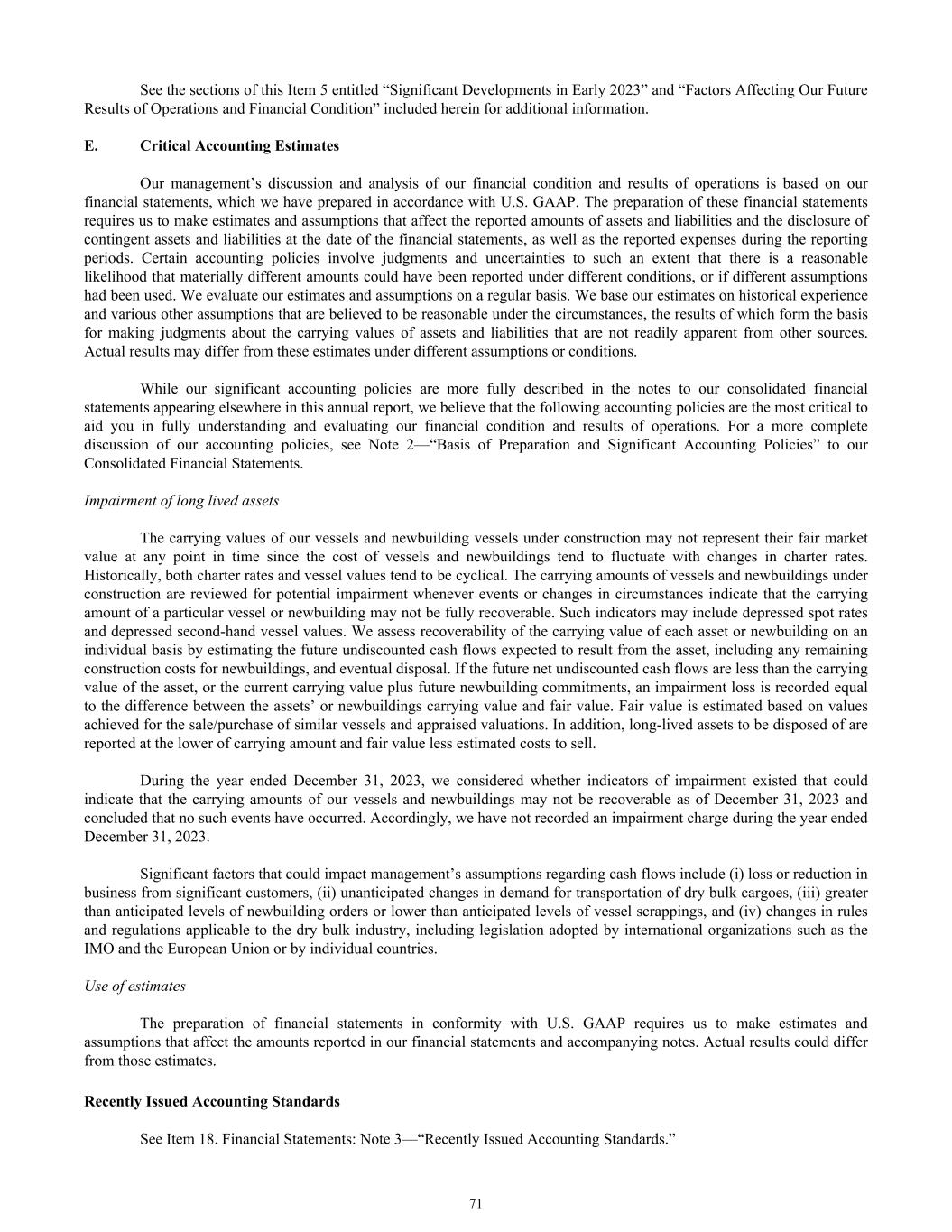
See the sections of this Item 5 entitled “Significant Developments in Early 2023” and “Factors Affecting Our Future Results of Operations and Financial Condition” included herein for additional information. E. Critical Accounting Estimates Our management’s discussion and analysis of our financial condition and results of operations is based on our financial statements, which we have prepared in accordance with U.S. GAAP. The preparation of these financial statements requires us to make estimates and assumptions that affect the reported amounts of assets and liabilities and the disclosure of contingent assets and liabilities at the date of the financial statements, as well as the reported expenses during the reporting periods. Certain accounting policies involve judgments and uncertainties to such an extent that there is a reasonable likelihood that materially different amounts could have been reported under different conditions, or if different assumptions had been used. We evaluate our estimates and assumptions on a regular basis. We base our estimates on historical experience and various other assumptions that are believed to be reasonable under the circumstances, the results of which form the basis for making judgments about the carrying values of assets and liabilities that are not readily apparent from other sources. Actual results may differ from these estimates under different assumptions or conditions. While our significant accounting policies are more fully described in the notes to our consolidated financial statements appearing elsewhere in this annual report, we believe that the following accounting policies are the most critical to aid you in fully understanding and evaluating our financial condition and results of operations. For a more complete discussion of our accounting policies, see Note 2—“Basis of Preparation and Significant Accounting Policies” to our Consolidated Financial Statements. Impairment of long lived assets The carrying values of our vessels and newbuilding vessels under construction may not represent their fair market value at any point in time since the cost of vessels and newbuildings tend to fluctuate with changes in charter rates. Historically, both charter rates and vessel values tend to be cyclical. The carrying amounts of vessels and newbuildings under construction are reviewed for potential impairment whenever events or changes in circumstances indicate that the carrying amount of a particular vessel or newbuilding may not be fully recoverable. Such indicators may include depressed spot rates and depressed second-hand vessel values. We assess recoverability of the carrying value of each asset or newbuilding on an individual basis by estimating the future undiscounted cash flows expected to result from the asset, including any remaining construction costs for newbuildings, and eventual disposal. If the future net undiscounted cash flows are less than the carrying value of the asset, or the current carrying value plus future newbuilding commitments, an impairment loss is recorded equal to the difference between the assets’ or newbuildings carrying value and fair value. Fair value is estimated based on values achieved for the sale/purchase of similar vessels and appraised valuations. In addition, long-lived assets to be disposed of are reported at the lower of carrying amount and fair value less estimated costs to sell. During the year ended December 31, 2023, we considered whether indicators of impairment existed that could indicate that the carrying amounts of our vessels and newbuildings may not be recoverable as of December 31, 2023 and concluded that no such events have occurred. Accordingly, we have not recorded an impairment charge during the year ended December 31, 2023. Significant factors that could impact management’s assumptions regarding cash flows include (i) loss or reduction in business from significant customers, (ii) unanticipated changes in demand for transportation of dry bulk cargoes, (iii) greater than anticipated levels of newbuilding orders or lower than anticipated levels of vessel scrappings, and (iv) changes in rules and regulations applicable to the dry bulk industry, including legislation adopted by international organizations such as the IMO and the European Union or by individual countries. Use of estimates The preparation of financial statements in conformity with U.S. GAAP requires us to make estimates and assumptions that affect the amounts reported in our financial statements and accompanying notes. Actual results could differ from those estimates. Recently Issued Accounting Standards See Item 18. Financial Statements: Note 3—“Recently Issued Accounting Standards.” 71
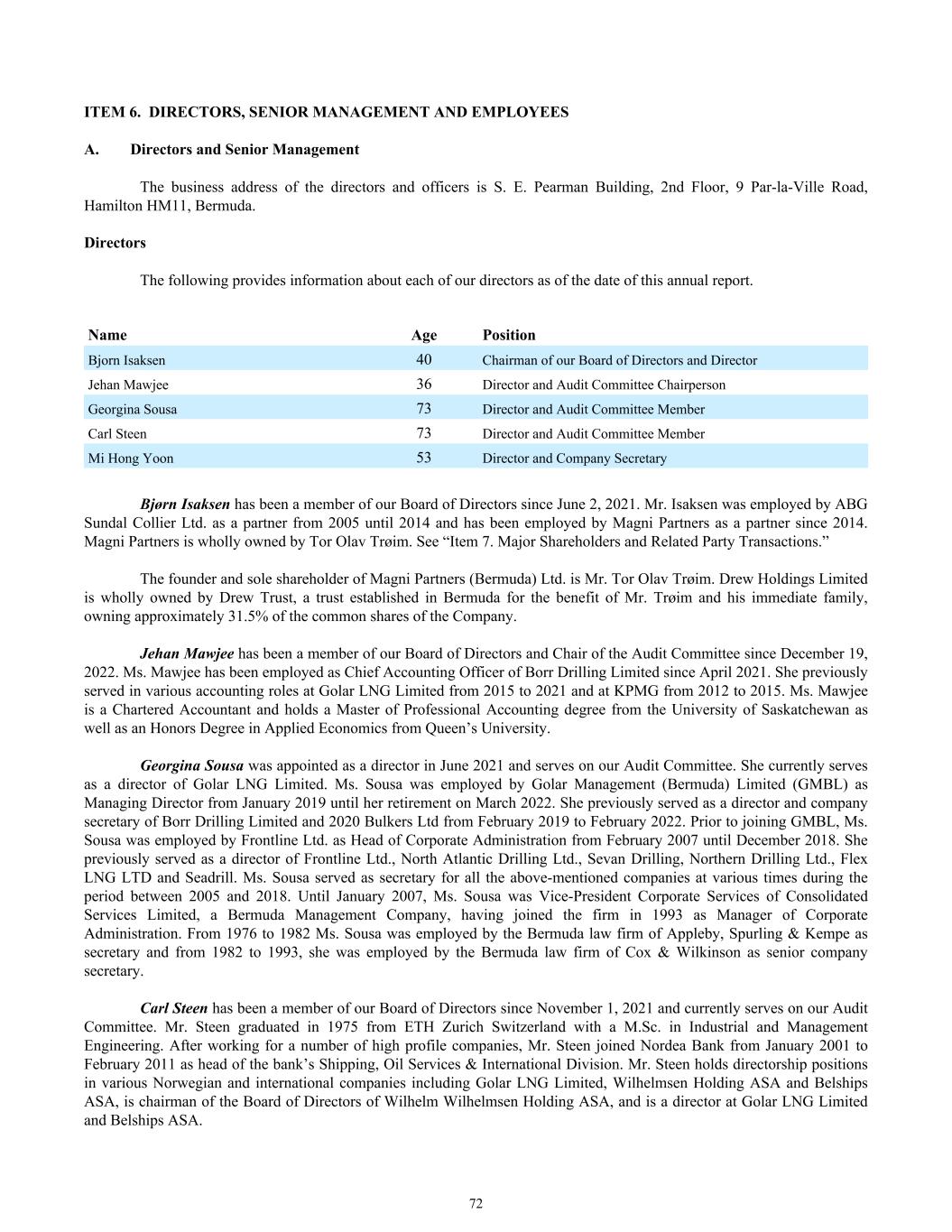
ITEM 6. DIRECTORS, SENIOR MANAGEMENT AND EMPLOYEES A. Directors and Senior Management The business address of the directors and officers is S. E. Pearman Building, 2nd Floor, 9 Par-la-Ville Road, Hamilton HM11, Bermuda. Directors The following provides information about each of our directors as of the date of this annual report. Name Age Position Bjorn Isaksen 40 Chairman of our Board of Directors and Director Jehan Mawjee 36 Director and Audit Committee Chairperson Georgina Sousa 73 Director and Audit Committee Member Carl Steen 73 Director and Audit Committee Member Mi Hong Yoon 53 Director and Company Secretary Bjørn Isaksen has been a member of our Board of Directors since June 2, 2021. Mr. Isaksen was employed by ABG Sundal Collier Ltd. as a partner from 2005 until 2014 and has been employed by Magni Partners as a partner since 2014. Magni Partners is wholly owned by Tor Olav Trøim. See “Item 7. Major Shareholders and Related Party Transactions.” The founder and sole shareholder of Magni Partners (Bermuda) Ltd. is Mr. Tor Olav Trøim. Drew Holdings Limited is wholly owned by Drew Trust, a trust established in Bermuda for the benefit of Mr. Trøim and his immediate family, owning approximately 31.5% of the common shares of the Company. Jehan Mawjee has been a member of our Board of Directors and Chair of the Audit Committee since December 19, 2022. Ms. Mawjee has been employed as Chief Accounting Officer of Borr Drilling Limited since April 2021. She previously served in various accounting roles at Golar LNG Limited from 2015 to 2021 and at KPMG from 2012 to 2015. Ms. Mawjee is a Chartered Accountant and holds a Master of Professional Accounting degree from the University of Saskatchewan as well as an Honors Degree in Applied Economics from Queen’s University. Georgina Sousa was appointed as a director in June 2021 and serves on our Audit Committee. She currently serves as a director of Golar LNG Limited. Ms. Sousa was employed by Golar Management (Bermuda) Limited (GMBL) as Managing Director from January 2019 until her retirement on March 2022. She previously served as a director and company secretary of Borr Drilling Limited and 2020 Bulkers Ltd from February 2019 to February 2022. Prior to joining GMBL, Ms. Sousa was employed by Frontline Ltd. as Head of Corporate Administration from February 2007 until December 2018. She previously served as a director of Frontline Ltd., North Atlantic Drilling Ltd., Sevan Drilling, Northern Drilling Ltd., Flex LNG LTD and Seadrill. Ms. Sousa served as secretary for all the above-mentioned companies at various times during the period between 2005 and 2018. Until January 2007, Ms. Sousa was Vice-President Corporate Services of Consolidated Services Limited, a Bermuda Management Company, having joined the firm in 1993 as Manager of Corporate Administration. From 1976 to 1982 Ms. Sousa was employed by the Bermuda law firm of Appleby, Spurling & Kempe as secretary and from 1982 to 1993, she was employed by the Bermuda law firm of Cox & Wilkinson as senior company secretary. Carl Steen has been a member of our Board of Directors since November 1, 2021 and currently serves on our Audit Committee. Mr. Steen graduated in 1975 from ETH Zurich Switzerland with a M.Sc. in Industrial and Management Engineering. After working for a number of high profile companies, Mr. Steen joined Nordea Bank from January 2001 to February 2011 as head of the bank’s Shipping, Oil Services & International Division. Mr. Steen holds directorship positions in various Norwegian and international companies including Golar LNG Limited, Wilhelmsen Holding ASA and Belships ASA, is chairman of the Board of Directors of Wilhelm Wilhelmsen Holding ASA, and is a director at Golar LNG Limited and Belships ASA. 72
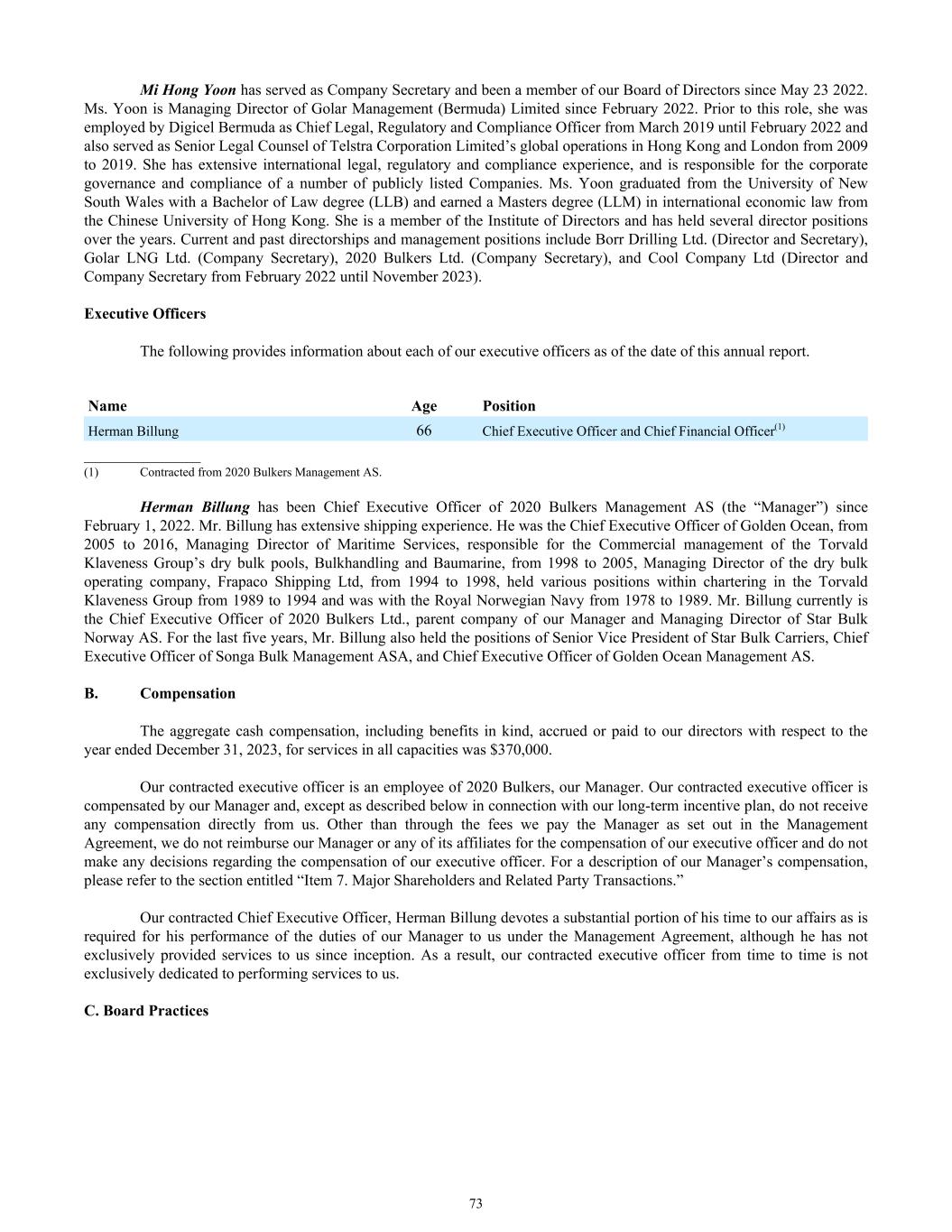
Mi Hong Yoon has served as Company Secretary and been a member of our Board of Directors since May 23 2022. Ms. Yoon is Managing Director of Golar Management (Bermuda) Limited since February 2022. Prior to this role, she was employed by Digicel Bermuda as Chief Legal, Regulatory and Compliance Officer from March 2019 until February 2022 and also served as Senior Legal Counsel of Telstra Corporation Limited’s global operations in Hong Kong and London from 2009 to 2019. She has extensive international legal, regulatory and compliance experience, and is responsible for the corporate governance and compliance of a number of publicly listed Companies. Ms. Yoon graduated from the University of New South Wales with a Bachelor of Law degree (LLB) and earned a Masters degree (LLM) in international economic law from the Chinese University of Hong Kong. She is a member of the Institute of Directors and has held several director positions over the years. Current and past directorships and management positions include Borr Drilling Ltd. (Director and Secretary), Golar LNG Ltd. (Company Secretary), 2020 Bulkers Ltd. (Company Secretary), and Cool Company Ltd (Director and Company Secretary from February 2022 until November 2023). Executive Officers The following provides information about each of our executive officers as of the date of this annual report. Name Age Position Herman Billung 66 Chief Executive Officer and Chief Financial Officer(1) _______________ (1) Contracted from 2020 Bulkers Management AS. Herman Billung has been Chief Executive Officer of 2020 Bulkers Management AS (the “Manager”) since February 1, 2022. Mr. Billung has extensive shipping experience. He was the Chief Executive Officer of Golden Ocean, from 2005 to 2016, Managing Director of Maritime Services, responsible for the Commercial management of the Torvald Klaveness Group’s dry bulk pools, Bulkhandling and Baumarine, from 1998 to 2005, Managing Director of the dry bulk operating company, Frapaco Shipping Ltd, from 1994 to 1998, held various positions within chartering in the Torvald Klaveness Group from 1989 to 1994 and was with the Royal Norwegian Navy from 1978 to 1989. Mr. Billung currently is the Chief Executive Officer of 2020 Bulkers Ltd., parent company of our Manager and Managing Director of Star Bulk Norway AS. For the last five years, Mr. Billung also held the positions of Senior Vice President of Star Bulk Carriers, Chief Executive Officer of Songa Bulk Management ASA, and Chief Executive Officer of Golden Ocean Management AS. B. Compensation The aggregate cash compensation, including benefits in kind, accrued or paid to our directors with respect to the year ended December 31, 2023, for services in all capacities was $370,000. Our contracted executive officer is an employee of 2020 Bulkers, our Manager. Our contracted executive officer is compensated by our Manager and, except as described below in connection with our long-term incentive plan, do not receive any compensation directly from us. Other than through the fees we pay the Manager as set out in the Management Agreement, we do not reimburse our Manager or any of its affiliates for the compensation of our executive officer and do not make any decisions regarding the compensation of our executive officer. For a description of our Manager’s compensation, please refer to the section entitled “Item 7. Major Shareholders and Related Party Transactions.” Our contracted Chief Executive Officer, Herman Billung devotes a substantial portion of his time to our affairs as is required for his performance of the duties of our Manager to us under the Management Agreement, although he has not exclusively provided services to us since inception. As a result, our contracted executive officer from time to time is not exclusively dedicated to performing services to us. C. Board Practices 73

Our Board of Directors is composed of five directors. A director is not required to hold any shares in our Company by way of qualification. A director who is in any way, whether directly or indirectly, interested in a contract or proposed contract with our Company is required to declare the nature of his interest at a meeting of our directors. A director may vote in respect of any contract, proposed contract, or arrangement notwithstanding that he or she may be interested therein, and if he or she does so, their vote shall be counted and may be counted in the quorum at any meeting of our directors at which any such contract or proposed contract or arrangement is considered. The directors may exercise all of our powers to borrow money, mortgage our undertaking, property and uncalled capital, and issue debentures or other securities whenever money is borrowed or as security for any of our obligations or of any third party. In addition, under Bermuda common law, members of the board of directors of a Bermuda company owe a fiduciary duty to the company to act in good faith in their dealings with or on behalf of the company and exercise their powers and fulfill the duties of their office honestly. This duty includes the following essential elements: • a duty to act in good faith in the best interests of the company; • a duty not to make a personal profit from opportunities that arise from the office of director; • a duty to avoid conflicts of interest; and • a duty to exercise powers for the purpose for which such powers were intended. The Companies Act imposes a duty on directors of a Bermuda company to act honestly and in good faith with a view to the best interests of the company, and to exercise the care, diligence and skill that a reasonably prudent person would exercise in comparable circumstances. In addition, the Companies Act imposes various duties on directors and officers of a company with respect to certain matters of management and administration of the company. Directors and officers generally owe fiduciary duties to the company, and not to the company’s individual shareholders. Our Board of Directors is elected annually by a vote of a majority of the common shares represented at the meeting at which at least two shareholders, present in person or by proxy, and entitled to vote (whatever the number of shares held by them) constitutes a quorum. In addition, the maximum and minimum number of directors is determined by a resolution of our shareholders, but no less than two directors shall serve at any given time. Each director shall hold office until the next annual general meeting or until his or her successor is elected. There are no service contracts between us and any member of our Board of Directors providing for the accrual of benefits, compensation or otherwise, upon termination of their employment or service. Our Board of Directors has determined that a majority of our directors are considered “independent” under the Stock Exchange independence standards. Committees Audit Committee The audit committee, which consists of Jehan Mawjee, Carl Steen and Georgina Sousa, assists the Board of Directors in overseeing our accounting and financial reporting processes and the audits of our Consolidated Financial Statements. In addition, the audit committee is directly responsible for the appointment, compensation, retention and oversight of the work of our independent registered public accounting firm. The audit committee is also responsible for reviewing and determining whether to approve certain transactions with related parties. See “Item 7. Major Shareholders and Related Party Transactions.” The Board of Directors has determined that Jehan Mawjee qualifies as “audit committee financial expert,” as such term is defined in the rules of the SEC, and all members of the audit committee are independent, as independence is defined under the rules of the SEC and the Stock Exchange applicable to foreign private issuers. Jehan Mawjee is chairperson of our audit committee. Compensation Committee The NYSE requires U.S. listed companies to have a compensation committee composed entirely of independent directors and a committee charter addressing the purpose, responsibility, rights and performance evaluation of the committee. We will rely on home country practice in Bermuda to be exempted from certain of the corporate governance requirements of the NYSE, such that we do not have a standing compensation committee. In lieu of a compensation committee, our Board is responsible for establishing the executive officers’ compensation and benefits including our equity compensation plan. 74
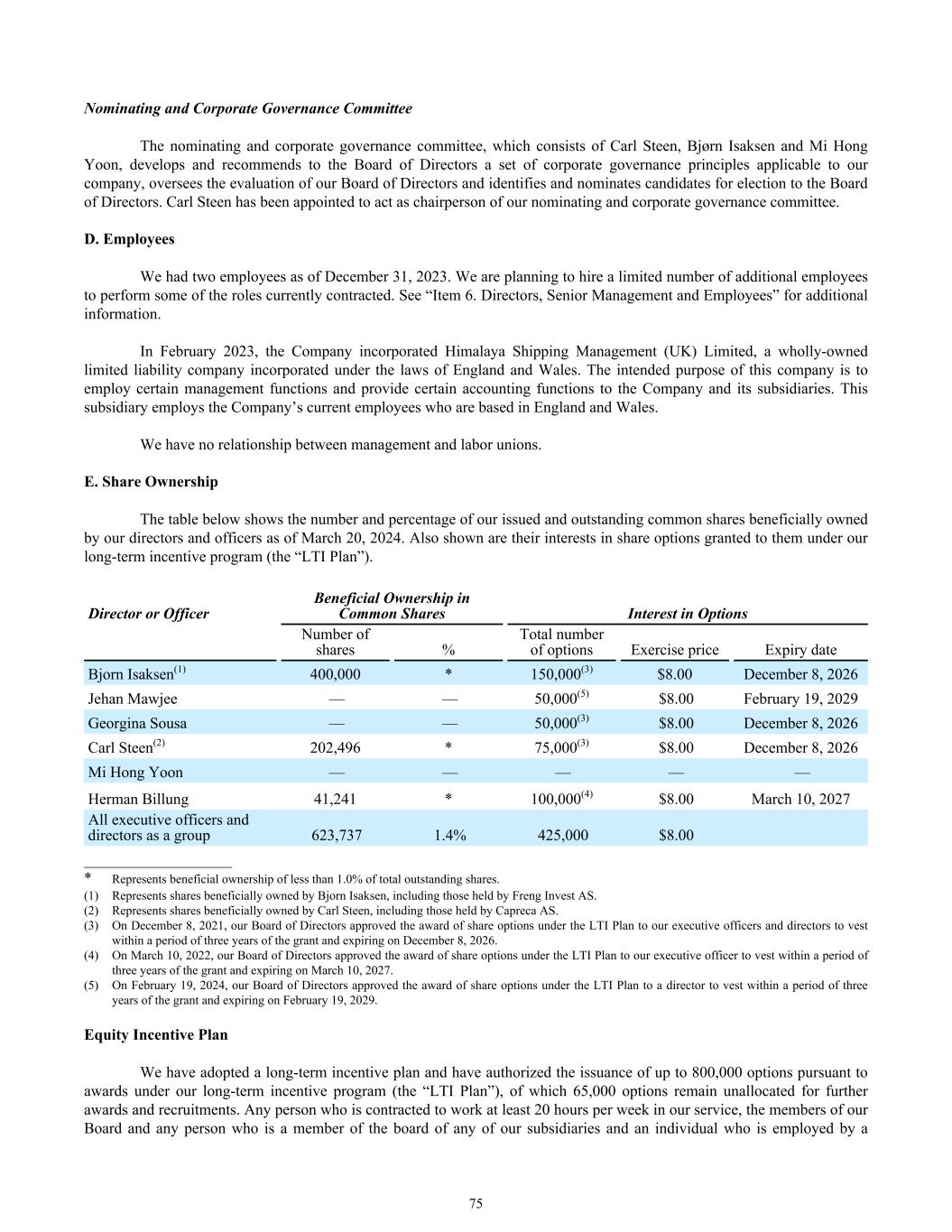
Nominating and Corporate Governance Committee The nominating and corporate governance committee, which consists of Carl Steen, Bjørn Isaksen and Mi Hong Yoon, develops and recommends to the Board of Directors a set of corporate governance principles applicable to our company, oversees the evaluation of our Board of Directors and identifies and nominates candidates for election to the Board of Directors. Carl Steen has been appointed to act as chairperson of our nominating and corporate governance committee. D. Employees We had two employees as of December 31, 2023. We are planning to hire a limited number of additional employees to perform some of the roles currently contracted. See “Item 6. Directors, Senior Management and Employees” for additional information. In February 2023, the Company incorporated Himalaya Shipping Management (UK) Limited, a wholly-owned limited liability company incorporated under the laws of England and Wales. The intended purpose of this company is to employ certain management functions and provide certain accounting functions to the Company and its subsidiaries. This subsidiary employs the Company’s current employees who are based in England and Wales. We have no relationship between management and labor unions. E. Share Ownership The table below shows the number and percentage of our issued and outstanding common shares beneficially owned by our directors and officers as of March 20, 2024. Also shown are their interests in share options granted to them under our long-term incentive program (the “LTI Plan”). Director or Officer Beneficial Ownership in Common Shares Interest in Options Number of shares % Total number of options Exercise price Expiry date Bjorn Isaksen(1) 400,000 * 150,000(3) $8.00 December 8, 2026 Jehan Mawjee — — 50,000(5) $8.00 February 19, 2029 Georgina Sousa — — 50,000(3) $8.00 December 8, 2026 Carl Steen(2) 202,496 * 75,000(3) $8.00 December 8, 2026 Mi Hong Yoon — — — — — Herman Billung 41,241 * 100,000(4) $8.00 March 10, 2027 All executive officers and directors as a group 623,737 1.4% 425,000 $8.00 ___________________ * Represents beneficial ownership of less than 1.0% of total outstanding shares. (1) Represents shares beneficially owned by Bjorn Isaksen, including those held by Freng Invest AS. (2) Represents shares beneficially owned by Carl Steen, including those held by Capreca AS. (3) On December 8, 2021, our Board of Directors approved the award of share options under the LTI Plan to our executive officers and directors to vest within a period of three years of the grant and expiring on December 8, 2026. (4) On March 10, 2022, our Board of Directors approved the award of share options under the LTI Plan to our executive officer to vest within a period of three years of the grant and expiring on March 10, 2027. (5) On February 19, 2024, our Board of Directors approved the award of share options under the LTI Plan to a director to vest within a period of three years of the grant and expiring on February 19, 2029. Equity Incentive Plan We have adopted a long-term incentive plan and have authorized the issuance of up to 800,000 options pursuant to awards under our long-term incentive program (the “LTI Plan”), of which 65,000 options remain unallocated for further awards and recruitments. Any person who is contracted to work at least 20 hours per week in our service, the members of our Board and any person who is a member of the board of any of our subsidiaries and an individual who is employed by a 75
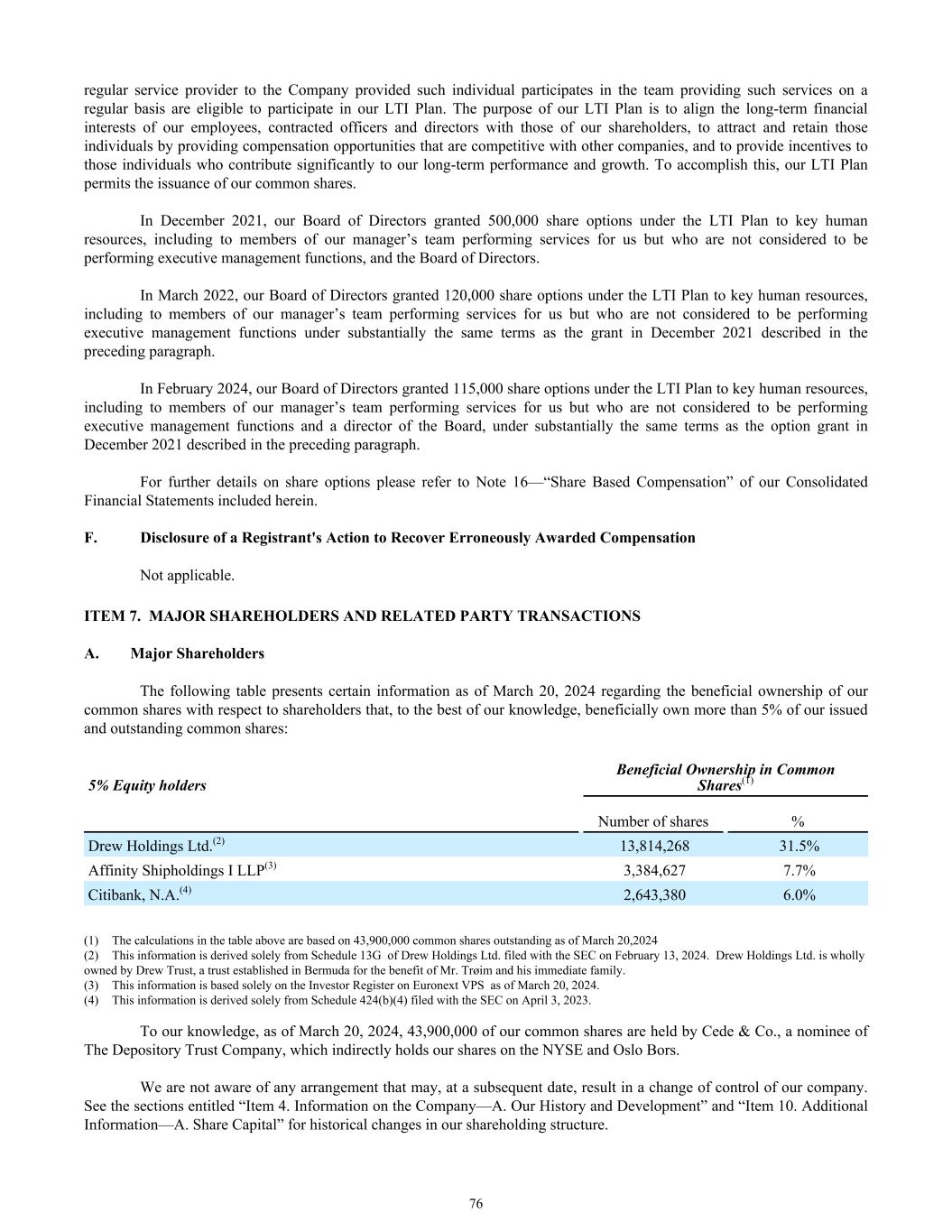
regular service provider to the Company provided such individual participates in the team providing such services on a regular basis are eligible to participate in our LTI Plan. The purpose of our LTI Plan is to align the long-term financial interests of our employees, contracted officers and directors with those of our shareholders, to attract and retain those individuals by providing compensation opportunities that are competitive with other companies, and to provide incentives to those individuals who contribute significantly to our long-term performance and growth. To accomplish this, our LTI Plan permits the issuance of our common shares. In December 2021, our Board of Directors granted 500,000 share options under the LTI Plan to key human resources, including to members of our manager’s team performing services for us but who are not considered to be performing executive management functions, and the Board of Directors. In March 2022, our Board of Directors granted 120,000 share options under the LTI Plan to key human resources, including to members of our manager’s team performing services for us but who are not considered to be performing executive management functions under substantially the same terms as the grant in December 2021 described in the preceding paragraph. In February 2024, our Board of Directors granted 115,000 share options under the LTI Plan to key human resources, including to members of our manager’s team performing services for us but who are not considered to be performing executive management functions and a director of the Board, under substantially the same terms as the option grant in December 2021 described in the preceding paragraph. For further details on share options please refer to Note 16—“Share Based Compensation” of our Consolidated Financial Statements included herein. F. Disclosure of a Registrant's Action to Recover Erroneously Awarded Compensation Not applicable. ITEM 7. MAJOR SHAREHOLDERS AND RELATED PARTY TRANSACTIONS A. Major Shareholders The following table presents certain information as of March 20, 2024 regarding the beneficial ownership of our common shares with respect to shareholders that, to the best of our knowledge, beneficially own more than 5% of our issued and outstanding common shares: 5% Equity holders Beneficial Ownership in Common Shares(1) Number of shares % Drew Holdings Ltd.(2) 13,814,268 31.5% Affinity Shipholdings I LLP(3) 3,384,627 7.7% Citibank, N.A.(4) 2,643,380 6.0% (1) The calculations in the table above are based on 43,900,000 common shares outstanding as of March 20,2024 (2) This information is derived solely from Schedule 13G of Drew Holdings Ltd. filed with the SEC on February 13, 2024. Drew Holdings Ltd. is wholly owned by Drew Trust, a trust established in Bermuda for the benefit of Mr. Trøim and his immediate family. (3) This information is based solely on the Investor Register on Euronext VPS as of March 20, 2024. (4) This information is derived solely from Schedule 424(b)(4) filed with the SEC on April 3, 2023. To our knowledge, as of March 20, 2024, 43,900,000 of our common shares are held by Cede & Co., a nominee of The Depository Trust Company, which indirectly holds our shares on the NYSE and Oslo Bors. We are not aware of any arrangement that may, at a subsequent date, result in a change of control of our company. See the sections entitled “Item 4. Information on the Company—A. Our History and Development” and “Item 10. Additional Information—A. Share Capital” for historical changes in our shareholding structure. 76
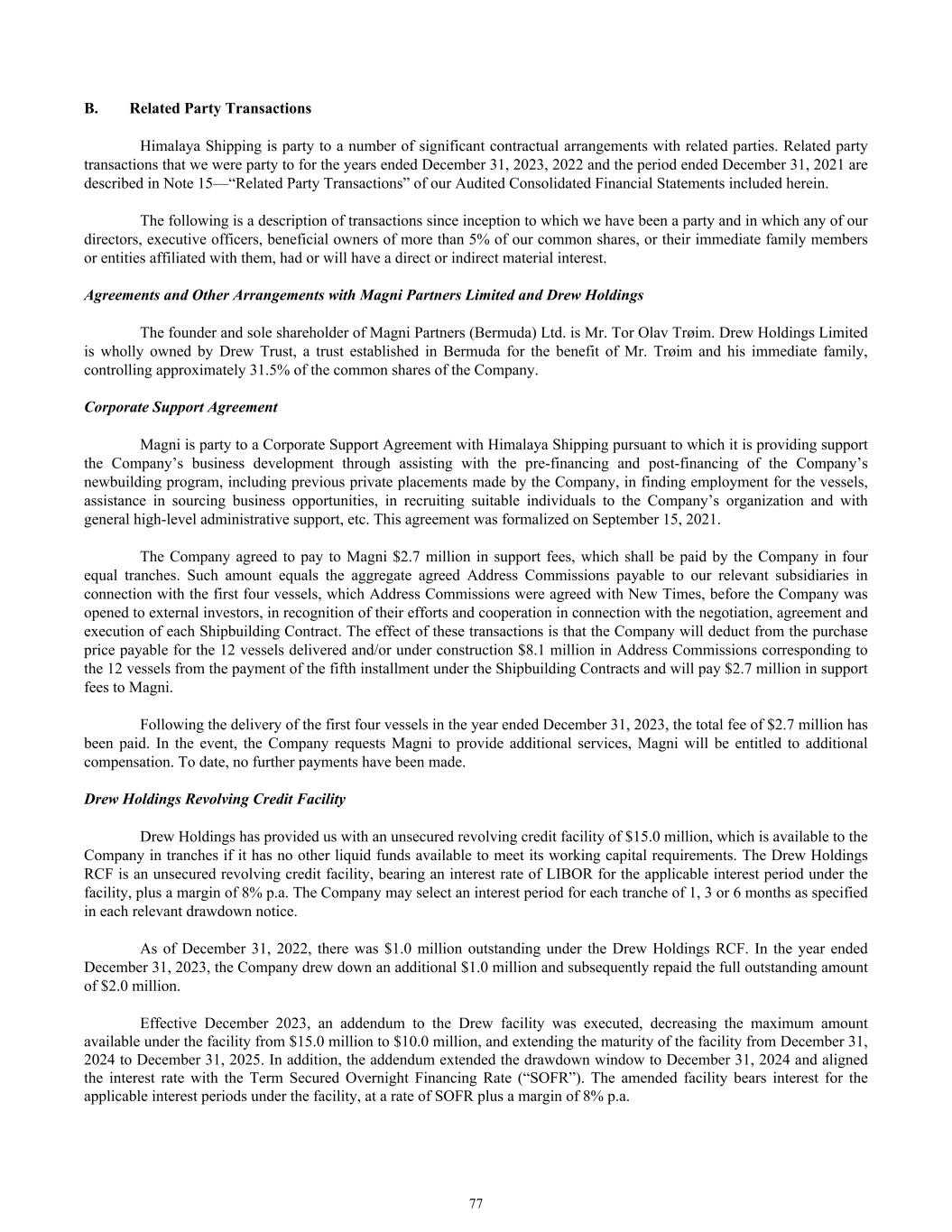
B. Related Party Transactions Himalaya Shipping is party to a number of significant contractual arrangements with related parties. Related party transactions that we were party to for the years ended December 31, 2023, 2022 and the period ended December 31, 2021 are described in Note 15—“Related Party Transactions” of our Audited Consolidated Financial Statements included herein. The following is a description of transactions since inception to which we have been a party and in which any of our directors, executive officers, beneficial owners of more than 5% of our common shares, or their immediate family members or entities affiliated with them, had or will have a direct or indirect material interest. Agreements and Other Arrangements with Magni Partners Limited and Drew Holdings The founder and sole shareholder of Magni Partners (Bermuda) Ltd. is Mr. Tor Olav Trøim. Drew Holdings Limited is wholly owned by Drew Trust, a trust established in Bermuda for the benefit of Mr. Trøim and his immediate family, controlling approximately 31.5% of the common shares of the Company. Corporate Support Agreement Magni is party to a Corporate Support Agreement with Himalaya Shipping pursuant to which it is providing support the Company’s business development through assisting with the pre-financing and post-financing of the Company’s newbuilding program, including previous private placements made by the Company, in finding employment for the vessels, assistance in sourcing business opportunities, in recruiting suitable individuals to the Company’s organization and with general high-level administrative support, etc. This agreement was formalized on September 15, 2021. The Company agreed to pay to Magni $2.7 million in support fees, which shall be paid by the Company in four equal tranches. Such amount equals the aggregate agreed Address Commissions payable to our relevant subsidiaries in connection with the first four vessels, which Address Commissions were agreed with New Times, before the Company was opened to external investors, in recognition of their efforts and cooperation in connection with the negotiation, agreement and execution of each Shipbuilding Contract. The effect of these transactions is that the Company will deduct from the purchase price payable for the 12 vessels delivered and/or under construction $8.1 million in Address Commissions corresponding to the 12 vessels from the payment of the fifth installment under the Shipbuilding Contracts and will pay $2.7 million in support fees to Magni. Following the delivery of the first four vessels in the year ended December 31, 2023, the total fee of $2.7 million has been paid. In the event, the Company requests Magni to provide additional services, Magni will be entitled to additional compensation. To date, no further payments have been made. Drew Holdings Revolving Credit Facility Drew Holdings has provided us with an unsecured revolving credit facility of $15.0 million, which is available to the Company in tranches if it has no other liquid funds available to meet its working capital requirements. The Drew Holdings RCF is an unsecured revolving credit facility, bearing an interest rate of LIBOR for the applicable interest period under the facility, plus a margin of 8% p.a. The Company may select an interest period for each tranche of 1, 3 or 6 months as specified in each relevant drawdown notice. As of December 31, 2022, there was $1.0 million outstanding under the Drew Holdings RCF. In the year ended December 31, 2023, the Company drew down an additional $1.0 million and subsequently repaid the full outstanding amount of $2.0 million. Effective December 2023, an addendum to the Drew facility was executed, decreasing the maximum amount available under the facility from $15.0 million to $10.0 million, and extending the maturity of the facility from December 31, 2024 to December 31, 2025. In addition, the addendum extended the drawdown window to December 31, 2024 and aligned the interest rate with the Term Secured Overnight Financing Rate (“SOFR”). The amended facility bears interest for the applicable interest periods under the facility, at a rate of SOFR plus a margin of 8% p.a. 77
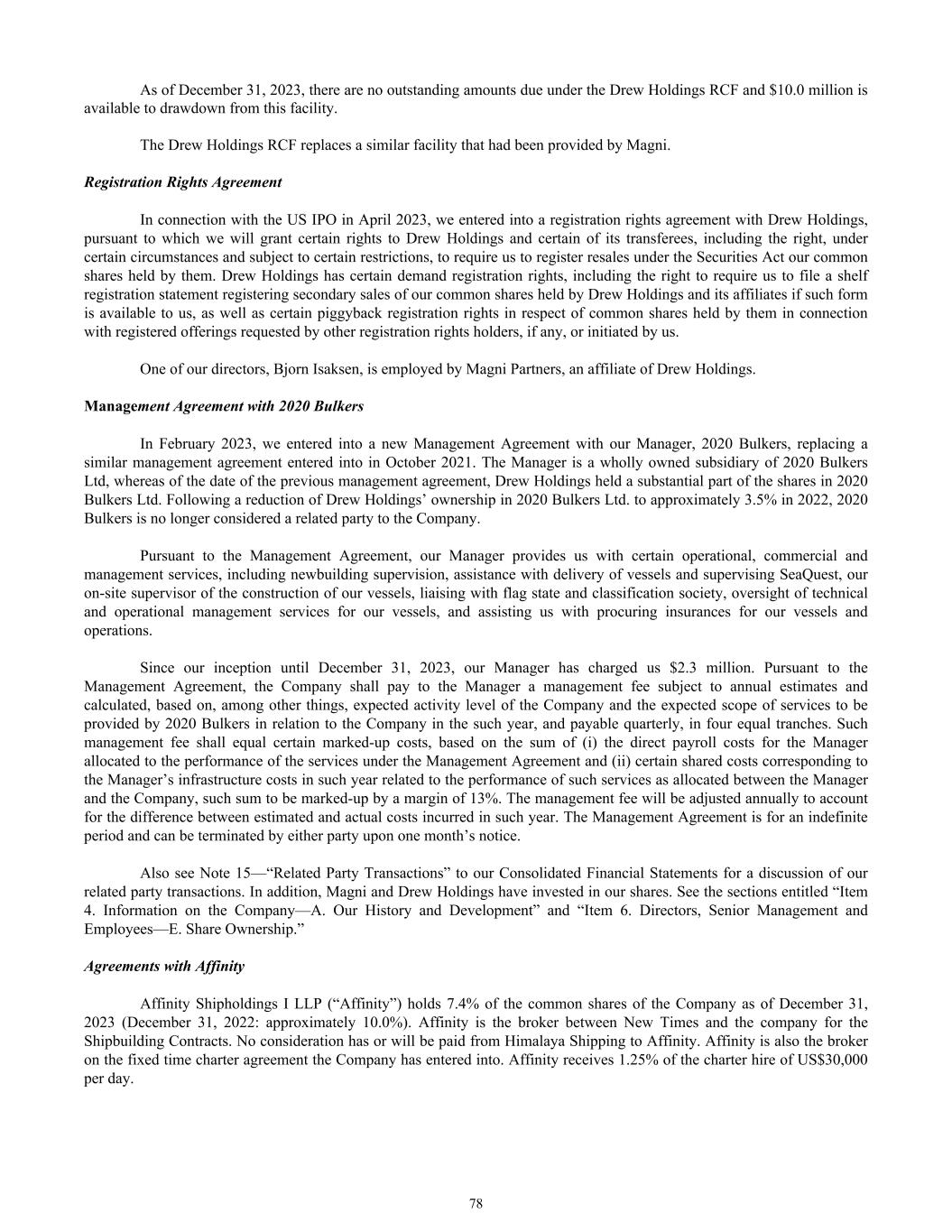
As of December 31, 2023, there are no outstanding amounts due under the Drew Holdings RCF and $10.0 million is available to drawdown from this facility. The Drew Holdings RCF replaces a similar facility that had been provided by Magni. Registration Rights Agreement In connection with the US IPO in April 2023, we entered into a registration rights agreement with Drew Holdings, pursuant to which we will grant certain rights to Drew Holdings and certain of its transferees, including the right, under certain circumstances and subject to certain restrictions, to require us to register resales under the Securities Act our common shares held by them. Drew Holdings has certain demand registration rights, including the right to require us to file a shelf registration statement registering secondary sales of our common shares held by Drew Holdings and its affiliates if such form is available to us, as well as certain piggyback registration rights in respect of common shares held by them in connection with registered offerings requested by other registration rights holders, if any, or initiated by us. One of our directors, Bjorn Isaksen, is employed by Magni Partners, an affiliate of Drew Holdings. Management Agreement with 2020 Bulkers In February 2023, we entered into a new Management Agreement with our Manager, 2020 Bulkers, replacing a similar management agreement entered into in October 2021. The Manager is a wholly owned subsidiary of 2020 Bulkers Ltd, whereas of the date of the previous management agreement, Drew Holdings held a substantial part of the shares in 2020 Bulkers Ltd. Following a reduction of Drew Holdings’ ownership in 2020 Bulkers Ltd. to approximately 3.5% in 2022, 2020 Bulkers is no longer considered a related party to the Company. Pursuant to the Management Agreement, our Manager provides us with certain operational, commercial and management services, including newbuilding supervision, assistance with delivery of vessels and supervising SeaQuest, our on-site supervisor of the construction of our vessels, liaising with flag state and classification society, oversight of technical and operational management services for our vessels, and assisting us with procuring insurances for our vessels and operations. Since our inception until December 31, 2023, our Manager has charged us $2.3 million. Pursuant to the Management Agreement, the Company shall pay to the Manager a management fee subject to annual estimates and calculated, based on, among other things, expected activity level of the Company and the expected scope of services to be provided by 2020 Bulkers in relation to the Company in the such year, and payable quarterly, in four equal tranches. Such management fee shall equal certain marked-up costs, based on the sum of (i) the direct payroll costs for the Manager allocated to the performance of the services under the Management Agreement and (ii) certain shared costs corresponding to the Manager’s infrastructure costs in such year related to the performance of such services as allocated between the Manager and the Company, such sum to be marked-up by a margin of 13%. The management fee will be adjusted annually to account for the difference between estimated and actual costs incurred in such year. The Management Agreement is for an indefinite period and can be terminated by either party upon one month’s notice. Also see Note 15—“Related Party Transactions” to our Consolidated Financial Statements for a discussion of our related party transactions. In addition, Magni and Drew Holdings have invested in our shares. See the sections entitled “Item 4. Information on the Company—A. Our History and Development” and “Item 6. Directors, Senior Management and Employees—E. Share Ownership.” Agreements with Affinity Affinity Shipholdings I LLP (“Affinity”) holds 7.4% of the common shares of the Company as of December 31, 2023 (December 31, 2022: approximately 10.0%). Affinity is the broker between New Times and the company for the Shipbuilding Contracts. No consideration has or will be paid from Himalaya Shipping to Affinity. Affinity is also the broker on the fixed time charter agreement the Company has entered into. Affinity receives 1.25% of the charter hire of US$30,000 per day. 78

C. Interests of Experts and Counsel Not applicable. ITEM 8. FINANCIAL INFORMATION A. Consolidated Financial Statements and Other Financial Information See “Item 18. Financial Statements” Legal proceedings and claims We may, from time to time, be involved in various legal proceedings, claims, lawsuits and complaints that arise in the ordinary course of business. We will recognize a contingent liability in our financial statements if the contingency has occurred at the date of the financial statements, where we believe that the likelihood of a loss was probable and the amounts can be reasonably estimated. If we determine that the reasonable estimate of the loss is a range and there is no best estimate within the range, we will provide the lower amount within the range. Dividend policy Under our bye-laws, our Board of Directors may declare cash dividends or distributions. We are subject to Bermuda legal constraints that may affect our ability to pay dividends on our common shares and make other payments. Under Bermuda law, a company may not declare or pay dividends if there are reasonable grounds for believing that: (i) the company is, or would after the payment be, unable to pay its liabilities as they become due; or (ii) the realizable value of its assets would thereby be less than its liabilities. Since we are a holding company with no material assets other than the shares of our subsidiaries through which we conduct our operations, our ability to pay dividends will depend on our subsidiaries distributing their earnings and cash flow to us. See “Item 5. Operating and Financial Review and Prospects—B. Liquidity and Capital Resources—Financing Arrangements.” Our Board of Directors has adopted a dividend policy to distribute monthly dividends to our shareholders once our vessels generate sufficient cash flow allowing such payments. Any future determination related to our dividend policy will be subject to the discretion of our Board of Directors, requirements of Bermuda law and other applicable laws, our results of operation, financial condition, cash requirements and availability, including requirements under capital expenditure programs, market prospects, contractual restrictions under our Financing Arrangements, the ability of our subsidiaries to distribute funds to us and other factors deemed relevant by our Board of Directors. We have not adopted a separate written dividend policy to reflect our Board’s policy. Although we are incorporated in Bermuda, we are classified as a non-resident of Bermuda for exchange control purposes by the Bermuda Monetary Authority. Other than transferring Bermuda Dollars out of Bermuda, there are no restrictions on our ability to transfer funds into or out of Bermuda to pay dividends to U.S. residents who are holders of our common shares or other non-resident holders of our common shares in currency other than Bermuda Dollars. B. Significant Changes Significant changes since the date of our consolidated financial statements are discussed on “Item 5. Operating and Financial Review and Prospects” and further disclosed in Note 18—“Subsequent Events” of our consolidated financial statements included herein. ITEM 9. THE OFFER AND LISTING A. Offer and Listing Details 79
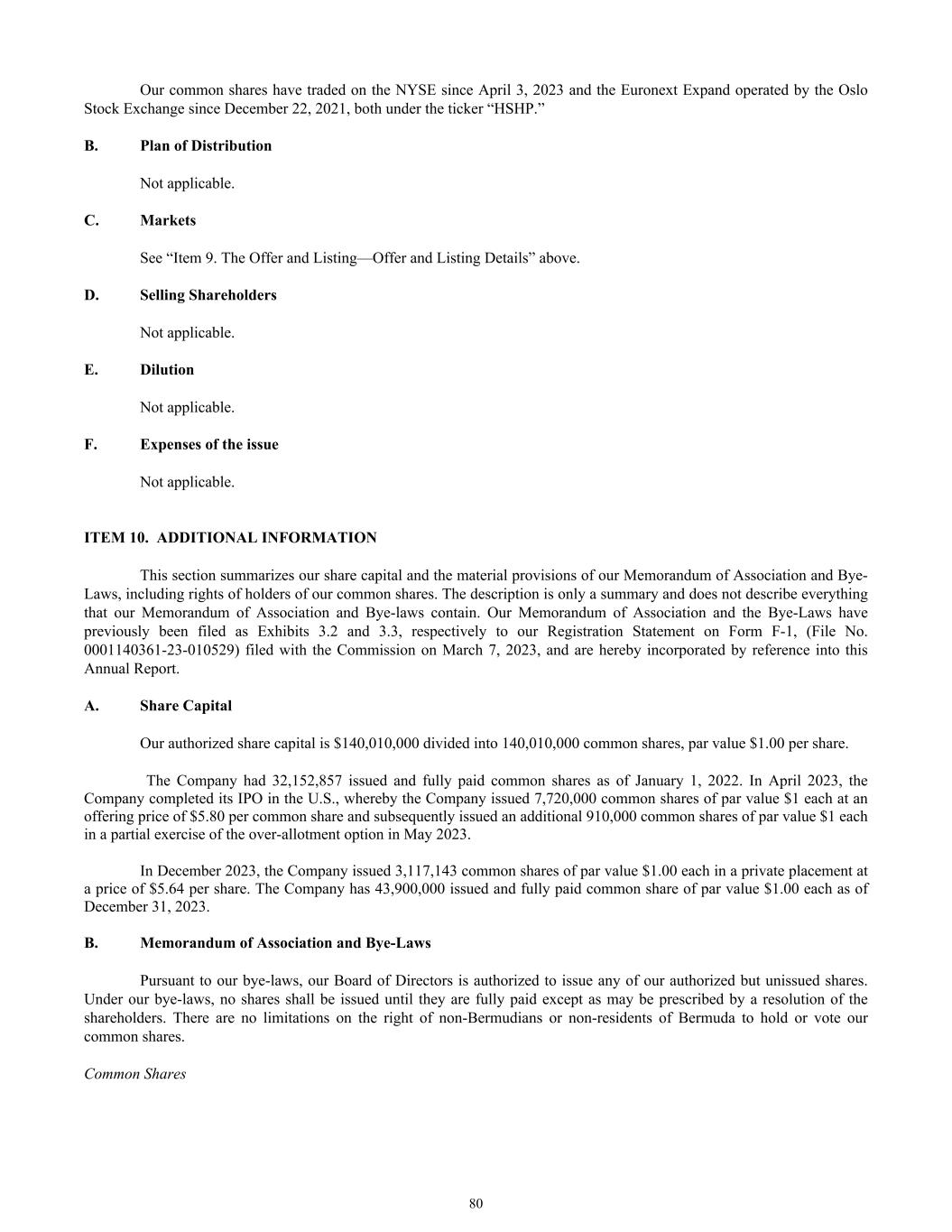
Our common shares have traded on the NYSE since April 3, 2023 and the Euronext Expand operated by the Oslo Stock Exchange since December 22, 2021, both under the ticker “HSHP.” B. Plan of Distribution Not applicable. C. Markets See “Item 9. The Offer and Listing—Offer and Listing Details” above. D. Selling Shareholders Not applicable. E. Dilution Not applicable. F. Expenses of the issue Not applicable. ITEM 10. ADDITIONAL INFORMATION This section summarizes our share capital and the material provisions of our Memorandum of Association and Bye- Laws, including rights of holders of our common shares. The description is only a summary and does not describe everything that our Memorandum of Association and Bye-laws contain. Our Memorandum of Association and the Bye-Laws have previously been filed as Exhibits 3.2 and 3.3, respectively to our Registration Statement on Form F-1, (File No. 0001140361-23-010529) filed with the Commission on March 7, 2023, and are hereby incorporated by reference into this Annual Report. A. Share Capital Our authorized share capital is $140,010,000 divided into 140,010,000 common shares, par value $1.00 per share. The Company had 32,152,857 issued and fully paid common shares as of January 1, 2022. In April 2023, the Company completed its IPO in the U.S., whereby the Company issued 7,720,000 common shares of par value $1 each at an offering price of $5.80 per common share and subsequently issued an additional 910,000 common shares of par value $1 each in a partial exercise of the over-allotment option in May 2023. In December 2023, the Company issued 3,117,143 common shares of par value $1.00 each in a private placement at a price of $5.64 per share. The Company has 43,900,000 issued and fully paid common share of par value $1.00 each as of December 31, 2023. B. Memorandum of Association and Bye-Laws Pursuant to our bye-laws, our Board of Directors is authorized to issue any of our authorized but unissued shares. Under our bye-laws, no shares shall be issued until they are fully paid except as may be prescribed by a resolution of the shareholders. There are no limitations on the right of non-Bermudians or non-residents of Bermuda to hold or vote our common shares. Common Shares 80
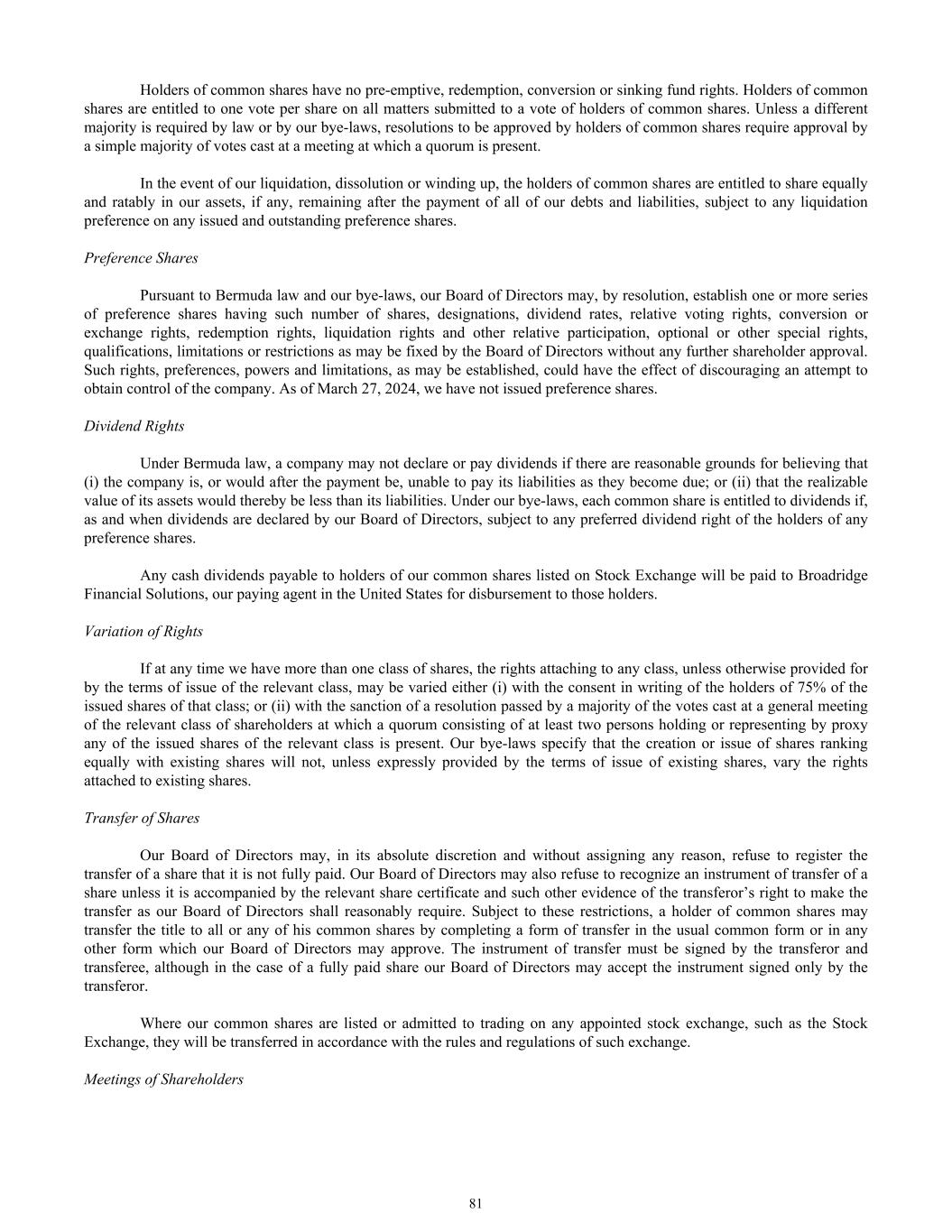
Holders of common shares have no pre-emptive, redemption, conversion or sinking fund rights. Holders of common shares are entitled to one vote per share on all matters submitted to a vote of holders of common shares. Unless a different majority is required by law or by our bye-laws, resolutions to be approved by holders of common shares require approval by a simple majority of votes cast at a meeting at which a quorum is present. In the event of our liquidation, dissolution or winding up, the holders of common shares are entitled to share equally and ratably in our assets, if any, remaining after the payment of all of our debts and liabilities, subject to any liquidation preference on any issued and outstanding preference shares. Preference Shares Pursuant to Bermuda law and our bye-laws, our Board of Directors may, by resolution, establish one or more series of preference shares having such number of shares, designations, dividend rates, relative voting rights, conversion or exchange rights, redemption rights, liquidation rights and other relative participation, optional or other special rights, qualifications, limitations or restrictions as may be fixed by the Board of Directors without any further shareholder approval. Such rights, preferences, powers and limitations, as may be established, could have the effect of discouraging an attempt to obtain control of the company. As of March 27, 2024, we have not issued preference shares. Dividend Rights Under Bermuda law, a company may not declare or pay dividends if there are reasonable grounds for believing that (i) the company is, or would after the payment be, unable to pay its liabilities as they become due; or (ii) that the realizable value of its assets would thereby be less than its liabilities. Under our bye-laws, each common share is entitled to dividends if, as and when dividends are declared by our Board of Directors, subject to any preferred dividend right of the holders of any preference shares. Any cash dividends payable to holders of our common shares listed on Stock Exchange will be paid to Broadridge Financial Solutions, our paying agent in the United States for disbursement to those holders. Variation of Rights If at any time we have more than one class of shares, the rights attaching to any class, unless otherwise provided for by the terms of issue of the relevant class, may be varied either (i) with the consent in writing of the holders of 75% of the issued shares of that class; or (ii) with the sanction of a resolution passed by a majority of the votes cast at a general meeting of the relevant class of shareholders at which a quorum consisting of at least two persons holding or representing by proxy any of the issued shares of the relevant class is present. Our bye-laws specify that the creation or issue of shares ranking equally with existing shares will not, unless expressly provided by the terms of issue of existing shares, vary the rights attached to existing shares. Transfer of Shares Our Board of Directors may, in its absolute discretion and without assigning any reason, refuse to register the transfer of a share that it is not fully paid. Our Board of Directors may also refuse to recognize an instrument of transfer of a share unless it is accompanied by the relevant share certificate and such other evidence of the transferor’s right to make the transfer as our Board of Directors shall reasonably require. Subject to these restrictions, a holder of common shares may transfer the title to all or any of his common shares by completing a form of transfer in the usual common form or in any other form which our Board of Directors may approve. The instrument of transfer must be signed by the transferor and transferee, although in the case of a fully paid share our Board of Directors may accept the instrument signed only by the transferor. Where our common shares are listed or admitted to trading on any appointed stock exchange, such as the Stock Exchange, they will be transferred in accordance with the rules and regulations of such exchange. Meetings of Shareholders 81
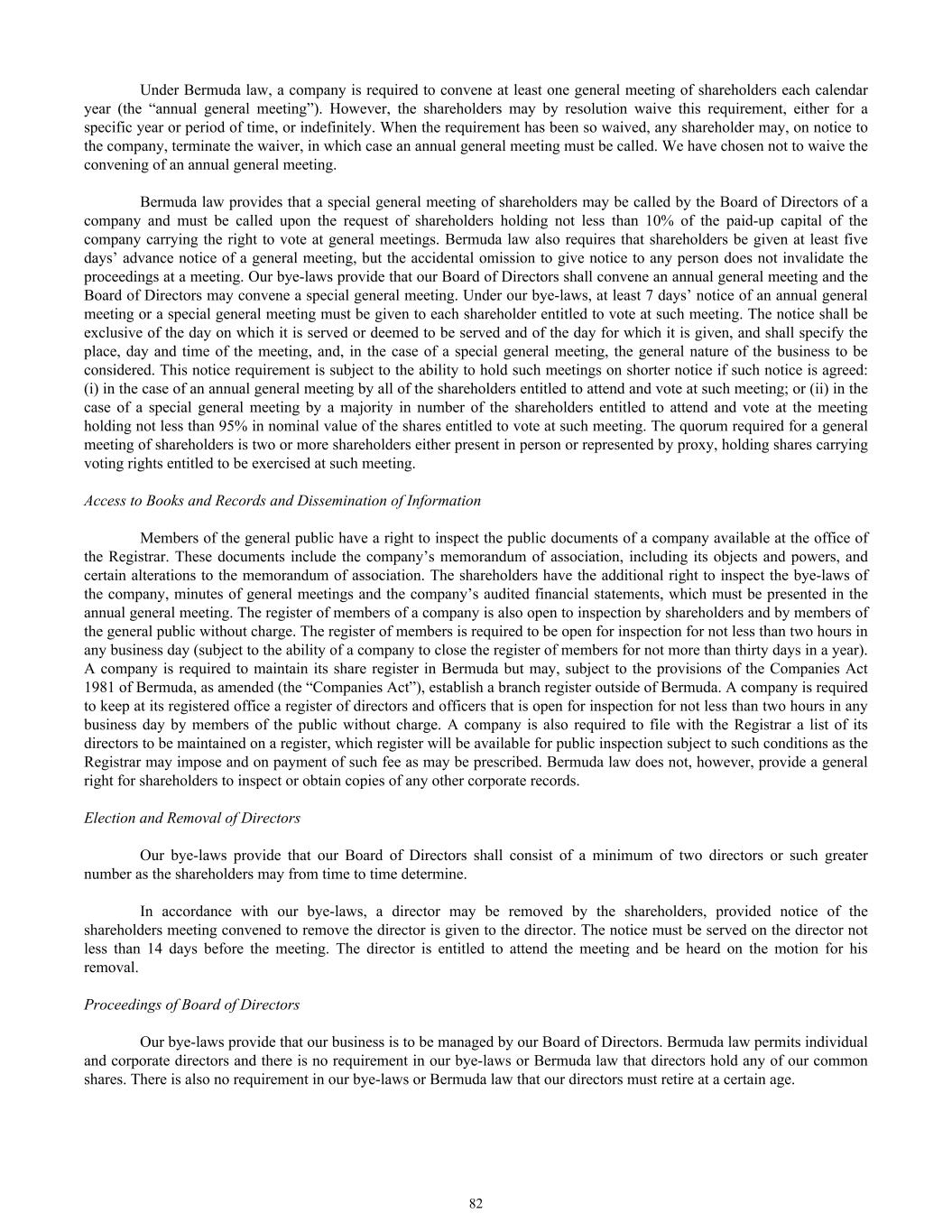
Under Bermuda law, a company is required to convene at least one general meeting of shareholders each calendar year (the “annual general meeting”). However, the shareholders may by resolution waive this requirement, either for a specific year or period of time, or indefinitely. When the requirement has been so waived, any shareholder may, on notice to the company, terminate the waiver, in which case an annual general meeting must be called. We have chosen not to waive the convening of an annual general meeting. Bermuda law provides that a special general meeting of shareholders may be called by the Board of Directors of a company and must be called upon the request of shareholders holding not less than 10% of the paid-up capital of the company carrying the right to vote at general meetings. Bermuda law also requires that shareholders be given at least five days’ advance notice of a general meeting, but the accidental omission to give notice to any person does not invalidate the proceedings at a meeting. Our bye-laws provide that our Board of Directors shall convene an annual general meeting and the Board of Directors may convene a special general meeting. Under our bye-laws, at least 7 days’ notice of an annual general meeting or a special general meeting must be given to each shareholder entitled to vote at such meeting. The notice shall be exclusive of the day on which it is served or deemed to be served and of the day for which it is given, and shall specify the place, day and time of the meeting, and, in the case of a special general meeting, the general nature of the business to be considered. This notice requirement is subject to the ability to hold such meetings on shorter notice if such notice is agreed: (i) in the case of an annual general meeting by all of the shareholders entitled to attend and vote at such meeting; or (ii) in the case of a special general meeting by a majority in number of the shareholders entitled to attend and vote at the meeting holding not less than 95% in nominal value of the shares entitled to vote at such meeting. The quorum required for a general meeting of shareholders is two or more shareholders either present in person or represented by proxy, holding shares carrying voting rights entitled to be exercised at such meeting. Access to Books and Records and Dissemination of Information Members of the general public have a right to inspect the public documents of a company available at the office of the Registrar. These documents include the company’s memorandum of association, including its objects and powers, and certain alterations to the memorandum of association. The shareholders have the additional right to inspect the bye-laws of the company, minutes of general meetings and the company’s audited financial statements, which must be presented in the annual general meeting. The register of members of a company is also open to inspection by shareholders and by members of the general public without charge. The register of members is required to be open for inspection for not less than two hours in any business day (subject to the ability of a company to close the register of members for not more than thirty days in a year). A company is required to maintain its share register in Bermuda but may, subject to the provisions of the Companies Act 1981 of Bermuda, as amended (the “Companies Act”), establish a branch register outside of Bermuda. A company is required to keep at its registered office a register of directors and officers that is open for inspection for not less than two hours in any business day by members of the public without charge. A company is also required to file with the Registrar a list of its directors to be maintained on a register, which register will be available for public inspection subject to such conditions as the Registrar may impose and on payment of such fee as may be prescribed. Bermuda law does not, however, provide a general right for shareholders to inspect or obtain copies of any other corporate records. Election and Removal of Directors Our bye-laws provide that our Board of Directors shall consist of a minimum of two directors or such greater number as the shareholders may from time to time determine. In accordance with our bye-laws, a director may be removed by the shareholders, provided notice of the shareholders meeting convened to remove the director is given to the director. The notice must be served on the director not less than 14 days before the meeting. The director is entitled to attend the meeting and be heard on the motion for his removal. Proceedings of Board of Directors Our bye-laws provide that our business is to be managed by our Board of Directors. Bermuda law permits individual and corporate directors and there is no requirement in our bye-laws or Bermuda law that directors hold any of our common shares. There is also no requirement in our bye-laws or Bermuda law that our directors must retire at a certain age. 82
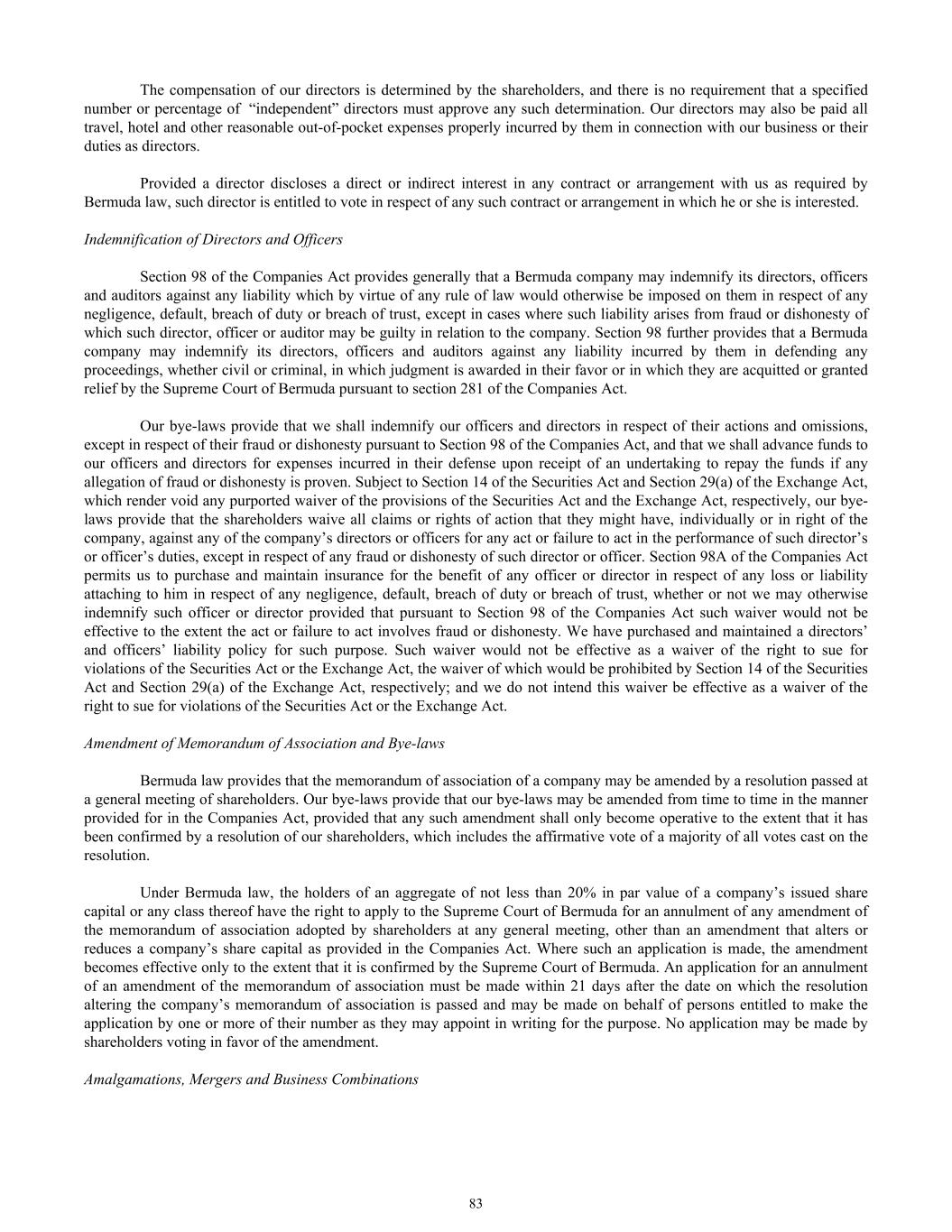
The compensation of our directors is determined by the shareholders, and there is no requirement that a specified number or percentage of “independent” directors must approve any such determination. Our directors may also be paid all travel, hotel and other reasonable out-of-pocket expenses properly incurred by them in connection with our business or their duties as directors. Provided a director discloses a direct or indirect interest in any contract or arrangement with us as required by Bermuda law, such director is entitled to vote in respect of any such contract or arrangement in which he or she is interested. Indemnification of Directors and Officers Section 98 of the Companies Act provides generally that a Bermuda company may indemnify its directors, officers and auditors against any liability which by virtue of any rule of law would otherwise be imposed on them in respect of any negligence, default, breach of duty or breach of trust, except in cases where such liability arises from fraud or dishonesty of which such director, officer or auditor may be guilty in relation to the company. Section 98 further provides that a Bermuda company may indemnify its directors, officers and auditors against any liability incurred by them in defending any proceedings, whether civil or criminal, in which judgment is awarded in their favor or in which they are acquitted or granted relief by the Supreme Court of Bermuda pursuant to section 281 of the Companies Act. Our bye-laws provide that we shall indemnify our officers and directors in respect of their actions and omissions, except in respect of their fraud or dishonesty pursuant to Section 98 of the Companies Act, and that we shall advance funds to our officers and directors for expenses incurred in their defense upon receipt of an undertaking to repay the funds if any allegation of fraud or dishonesty is proven. Subject to Section 14 of the Securities Act and Section 29(a) of the Exchange Act, which render void any purported waiver of the provisions of the Securities Act and the Exchange Act, respectively, our bye- laws provide that the shareholders waive all claims or rights of action that they might have, individually or in right of the company, against any of the company’s directors or officers for any act or failure to act in the performance of such director’s or officer’s duties, except in respect of any fraud or dishonesty of such director or officer. Section 98A of the Companies Act permits us to purchase and maintain insurance for the benefit of any officer or director in respect of any loss or liability attaching to him in respect of any negligence, default, breach of duty or breach of trust, whether or not we may otherwise indemnify such officer or director provided that pursuant to Section 98 of the Companies Act such waiver would not be effective to the extent the act or failure to act involves fraud or dishonesty. We have purchased and maintained a directors’ and officers’ liability policy for such purpose. Such waiver would not be effective as a waiver of the right to sue for violations of the Securities Act or the Exchange Act, the waiver of which would be prohibited by Section 14 of the Securities Act and Section 29(a) of the Exchange Act, respectively; and we do not intend this waiver be effective as a waiver of the right to sue for violations of the Securities Act or the Exchange Act. Amendment of Memorandum of Association and Bye-laws Bermuda law provides that the memorandum of association of a company may be amended by a resolution passed at a general meeting of shareholders. Our bye-laws provide that our bye-laws may be amended from time to time in the manner provided for in the Companies Act, provided that any such amendment shall only become operative to the extent that it has been confirmed by a resolution of our shareholders, which includes the affirmative vote of a majority of all votes cast on the resolution. Under Bermuda law, the holders of an aggregate of not less than 20% in par value of a company’s issued share capital or any class thereof have the right to apply to the Supreme Court of Bermuda for an annulment of any amendment of the memorandum of association adopted by shareholders at any general meeting, other than an amendment that alters or reduces a company’s share capital as provided in the Companies Act. Where such an application is made, the amendment becomes effective only to the extent that it is confirmed by the Supreme Court of Bermuda. An application for an annulment of an amendment of the memorandum of association must be made within 21 days after the date on which the resolution altering the company’s memorandum of association is passed and may be made on behalf of persons entitled to make the application by one or more of their number as they may appoint in writing for the purpose. No application may be made by shareholders voting in favor of the amendment. Amalgamations, Mergers and Business Combinations 83
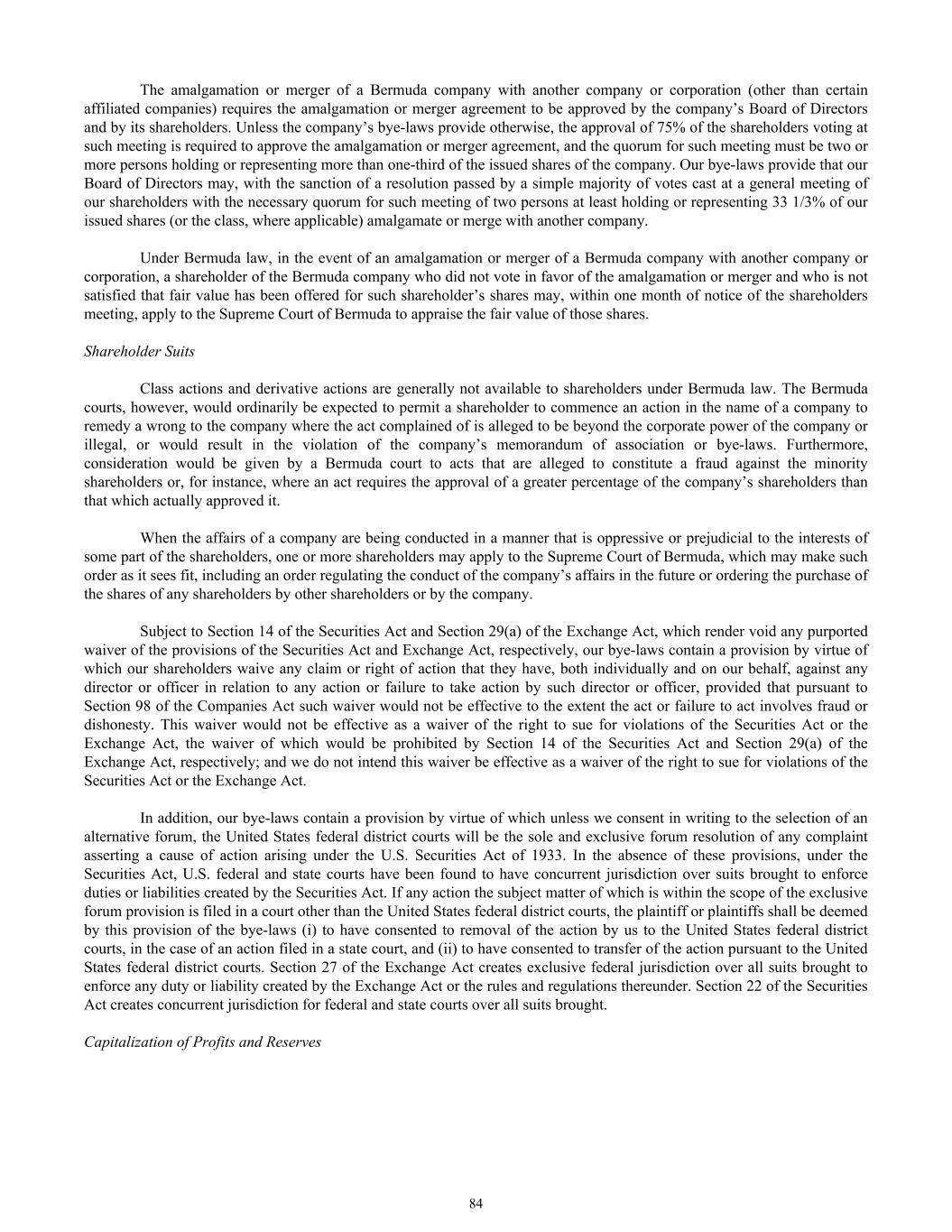
The amalgamation or merger of a Bermuda company with another company or corporation (other than certain affiliated companies) requires the amalgamation or merger agreement to be approved by the company’s Board of Directors and by its shareholders. Unless the company’s bye-laws provide otherwise, the approval of 75% of the shareholders voting at such meeting is required to approve the amalgamation or merger agreement, and the quorum for such meeting must be two or more persons holding or representing more than one-third of the issued shares of the company. Our bye-laws provide that our Board of Directors may, with the sanction of a resolution passed by a simple majority of votes cast at a general meeting of our shareholders with the necessary quorum for such meeting of two persons at least holding or representing 33 1/3% of our issued shares (or the class, where applicable) amalgamate or merge with another company. Under Bermuda law, in the event of an amalgamation or merger of a Bermuda company with another company or corporation, a shareholder of the Bermuda company who did not vote in favor of the amalgamation or merger and who is not satisfied that fair value has been offered for such shareholder’s shares may, within one month of notice of the shareholders meeting, apply to the Supreme Court of Bermuda to appraise the fair value of those shares. Shareholder Suits Class actions and derivative actions are generally not available to shareholders under Bermuda law. The Bermuda courts, however, would ordinarily be expected to permit a shareholder to commence an action in the name of a company to remedy a wrong to the company where the act complained of is alleged to be beyond the corporate power of the company or illegal, or would result in the violation of the company’s memorandum of association or bye-laws. Furthermore, consideration would be given by a Bermuda court to acts that are alleged to constitute a fraud against the minority shareholders or, for instance, where an act requires the approval of a greater percentage of the company’s shareholders than that which actually approved it. When the affairs of a company are being conducted in a manner that is oppressive or prejudicial to the interests of some part of the shareholders, one or more shareholders may apply to the Supreme Court of Bermuda, which may make such order as it sees fit, including an order regulating the conduct of the company’s affairs in the future or ordering the purchase of the shares of any shareholders by other shareholders or by the company. Subject to Section 14 of the Securities Act and Section 29(a) of the Exchange Act, which render void any purported waiver of the provisions of the Securities Act and Exchange Act, respectively, our bye-laws contain a provision by virtue of which our shareholders waive any claim or right of action that they have, both individually and on our behalf, against any director or officer in relation to any action or failure to take action by such director or officer, provided that pursuant to Section 98 of the Companies Act such waiver would not be effective to the extent the act or failure to act involves fraud or dishonesty. This waiver would not be effective as a waiver of the right to sue for violations of the Securities Act or the Exchange Act, the waiver of which would be prohibited by Section 14 of the Securities Act and Section 29(a) of the Exchange Act, respectively; and we do not intend this waiver be effective as a waiver of the right to sue for violations of the Securities Act or the Exchange Act. In addition, our bye-laws contain a provision by virtue of which unless we consent in writing to the selection of an alternative forum, the United States federal district courts will be the sole and exclusive forum resolution of any complaint asserting a cause of action arising under the U.S. Securities Act of 1933. In the absence of these provisions, under the Securities Act, U.S. federal and state courts have been found to have concurrent jurisdiction over suits brought to enforce duties or liabilities created by the Securities Act. If any action the subject matter of which is within the scope of the exclusive forum provision is filed in a court other than the United States federal district courts, the plaintiff or plaintiffs shall be deemed by this provision of the bye-laws (i) to have consented to removal of the action by us to the United States federal district courts, in the case of an action filed in a state court, and (ii) to have consented to transfer of the action pursuant to the United States federal district courts. Section 27 of the Exchange Act creates exclusive federal jurisdiction over all suits brought to enforce any duty or liability created by the Exchange Act or the rules and regulations thereunder. Section 22 of the Securities Act creates concurrent jurisdiction for federal and state courts over all suits brought. Capitalization of Profits and Reserves 84
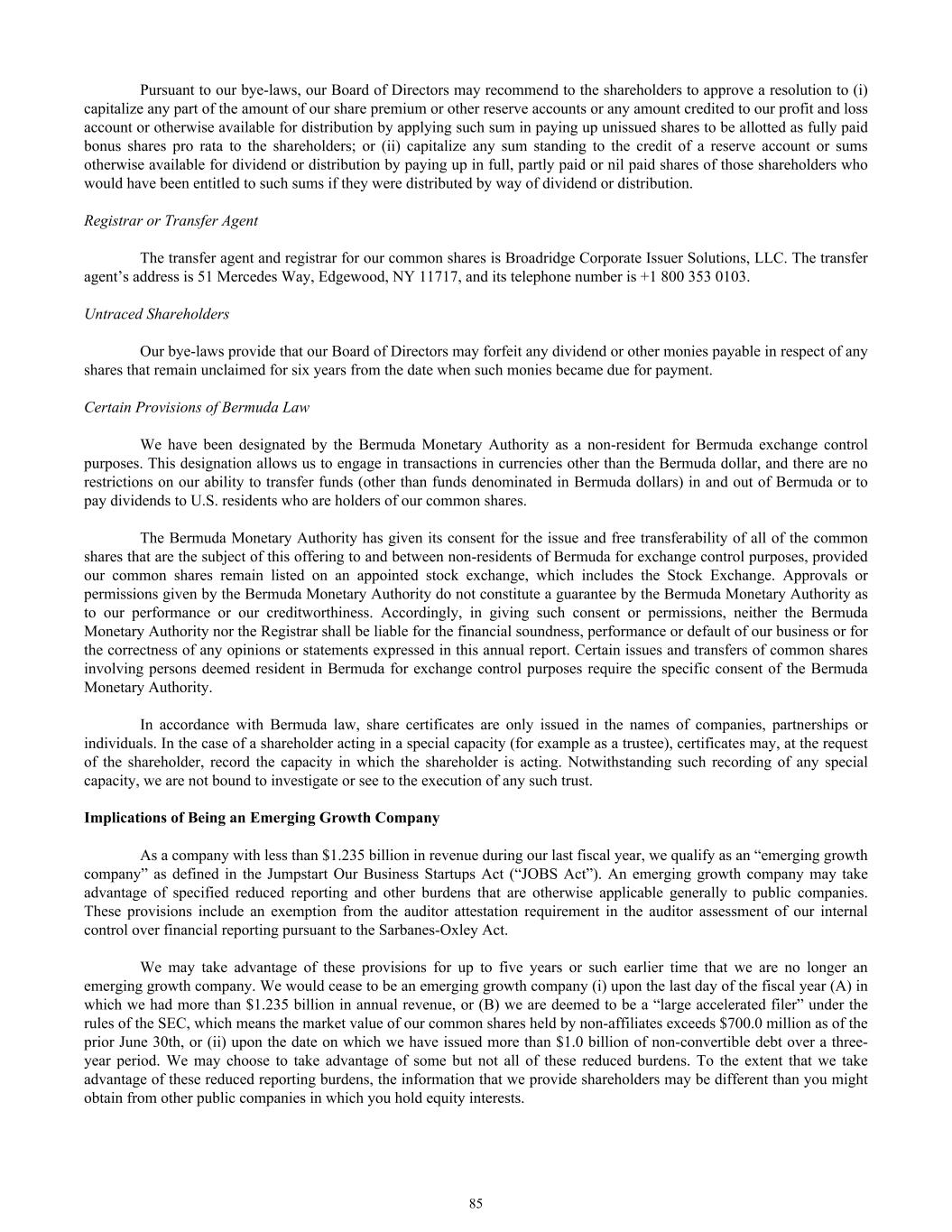
Pursuant to our bye-laws, our Board of Directors may recommend to the shareholders to approve a resolution to (i) capitalize any part of the amount of our share premium or other reserve accounts or any amount credited to our profit and loss account or otherwise available for distribution by applying such sum in paying up unissued shares to be allotted as fully paid bonus shares pro rata to the shareholders; or (ii) capitalize any sum standing to the credit of a reserve account or sums otherwise available for dividend or distribution by paying up in full, partly paid or nil paid shares of those shareholders who would have been entitled to such sums if they were distributed by way of dividend or distribution. Registrar or Transfer Agent The transfer agent and registrar for our common shares is Broadridge Corporate Issuer Solutions, LLC. The transfer agent’s address is 51 Mercedes Way, Edgewood, NY 11717, and its telephone number is +1 800 353 0103. Untraced Shareholders Our bye-laws provide that our Board of Directors may forfeit any dividend or other monies payable in respect of any shares that remain unclaimed for six years from the date when such monies became due for payment. Certain Provisions of Bermuda Law We have been designated by the Bermuda Monetary Authority as a non-resident for Bermuda exchange control purposes. This designation allows us to engage in transactions in currencies other than the Bermuda dollar, and there are no restrictions on our ability to transfer funds (other than funds denominated in Bermuda dollars) in and out of Bermuda or to pay dividends to U.S. residents who are holders of our common shares. The Bermuda Monetary Authority has given its consent for the issue and free transferability of all of the common shares that are the subject of this offering to and between non-residents of Bermuda for exchange control purposes, provided our common shares remain listed on an appointed stock exchange, which includes the Stock Exchange. Approvals or permissions given by the Bermuda Monetary Authority do not constitute a guarantee by the Bermuda Monetary Authority as to our performance or our creditworthiness. Accordingly, in giving such consent or permissions, neither the Bermuda Monetary Authority nor the Registrar shall be liable for the financial soundness, performance or default of our business or for the correctness of any opinions or statements expressed in this annual report. Certain issues and transfers of common shares involving persons deemed resident in Bermuda for exchange control purposes require the specific consent of the Bermuda Monetary Authority. In accordance with Bermuda law, share certificates are only issued in the names of companies, partnerships or individuals. In the case of a shareholder acting in a special capacity (for example as a trustee), certificates may, at the request of the shareholder, record the capacity in which the shareholder is acting. Notwithstanding such recording of any special capacity, we are not bound to investigate or see to the execution of any such trust. Implications of Being an Emerging Growth Company As a company with less than $1.235 billion in revenue during our last fiscal year, we qualify as an “emerging growth company” as defined in the Jumpstart Our Business Startups Act (“JOBS Act”). An emerging growth company may take advantage of specified reduced reporting and other burdens that are otherwise applicable generally to public companies. These provisions include an exemption from the auditor attestation requirement in the auditor assessment of our internal control over financial reporting pursuant to the Sarbanes-Oxley Act. We may take advantage of these provisions for up to five years or such earlier time that we are no longer an emerging growth company. We would cease to be an emerging growth company (i) upon the last day of the fiscal year (A) in which we had more than $1.235 billion in annual revenue, or (B) we are deemed to be a “large accelerated filer” under the rules of the SEC, which means the market value of our common shares held by non-affiliates exceeds $700.0 million as of the prior June 30th, or (ii) upon the date on which we have issued more than $1.0 billion of non-convertible debt over a three- year period. We may choose to take advantage of some but not all of these reduced burdens. To the extent that we take advantage of these reduced reporting burdens, the information that we provide shareholders may be different than you might obtain from other public companies in which you hold equity interests. 85
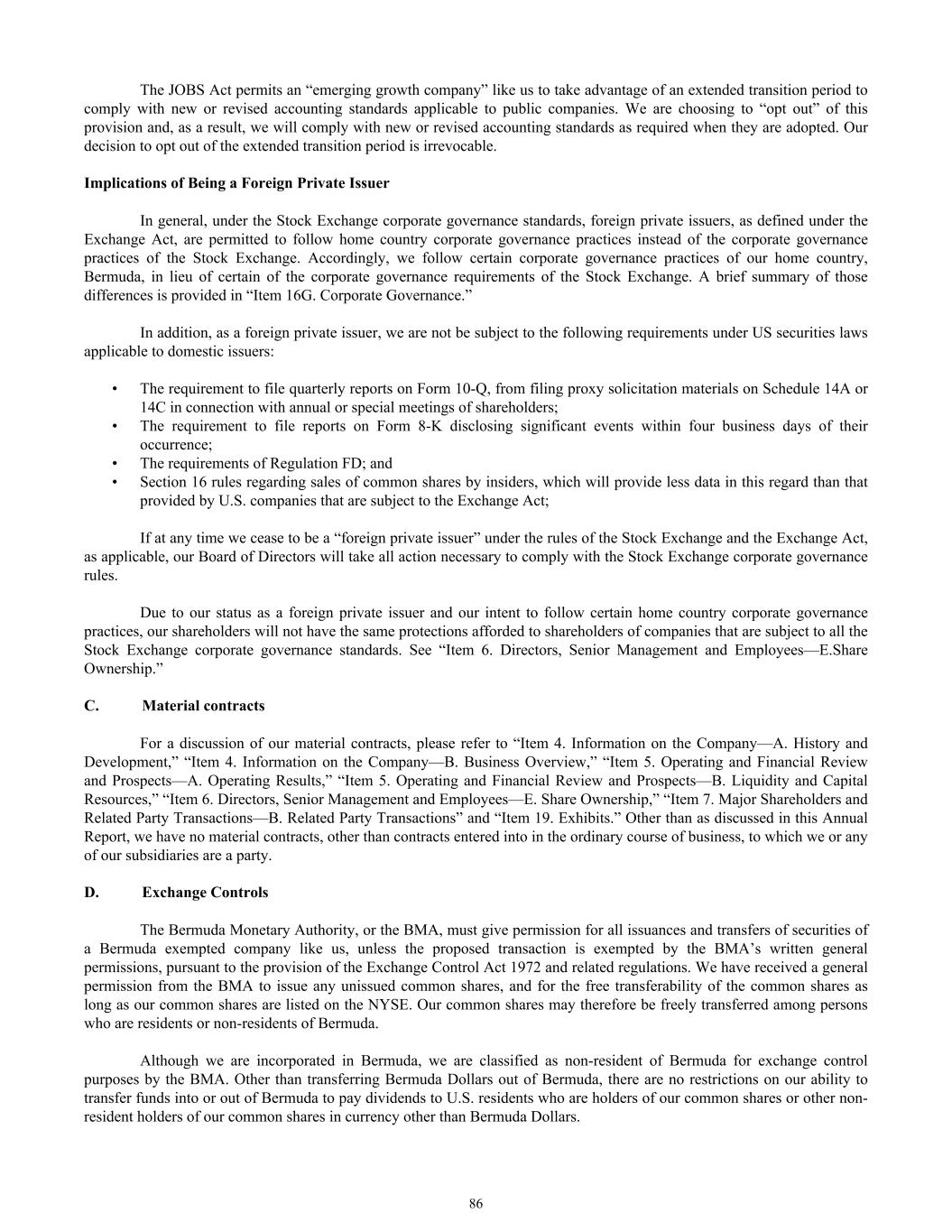
The JOBS Act permits an “emerging growth company” like us to take advantage of an extended transition period to comply with new or revised accounting standards applicable to public companies. We are choosing to “opt out” of this provision and, as a result, we will comply with new or revised accounting standards as required when they are adopted. Our decision to opt out of the extended transition period is irrevocable. Implications of Being a Foreign Private Issuer In general, under the Stock Exchange corporate governance standards, foreign private issuers, as defined under the Exchange Act, are permitted to follow home country corporate governance practices instead of the corporate governance practices of the Stock Exchange. Accordingly, we follow certain corporate governance practices of our home country, Bermuda, in lieu of certain of the corporate governance requirements of the Stock Exchange. A brief summary of those differences is provided in “Item 16G. Corporate Governance.” In addition, as a foreign private issuer, we are not be subject to the following requirements under US securities laws applicable to domestic issuers: • The requirement to file quarterly reports on Form 10-Q, from filing proxy solicitation materials on Schedule 14A or 14C in connection with annual or special meetings of shareholders; • The requirement to file reports on Form 8-K disclosing significant events within four business days of their occurrence; • The requirements of Regulation FD; and • Section 16 rules regarding sales of common shares by insiders, which will provide less data in this regard than that provided by U.S. companies that are subject to the Exchange Act; If at any time we cease to be a “foreign private issuer” under the rules of the Stock Exchange and the Exchange Act, as applicable, our Board of Directors will take all action necessary to comply with the Stock Exchange corporate governance rules. Due to our status as a foreign private issuer and our intent to follow certain home country corporate governance practices, our shareholders will not have the same protections afforded to shareholders of companies that are subject to all the Stock Exchange corporate governance standards. See “Item 6. Directors, Senior Management and Employees—E.Share Ownership.” C. Material contracts For a discussion of our material contracts, please refer to “Item 4. Information on the Company—A. History and Development,” “Item 4. Information on the Company—B. Business Overview,” “Item 5. Operating and Financial Review and Prospects—A. Operating Results,” “Item 5. Operating and Financial Review and Prospects—B. Liquidity and Capital Resources,” “Item 6. Directors, Senior Management and Employees—E. Share Ownership,” “Item 7. Major Shareholders and Related Party Transactions—B. Related Party Transactions” and “Item 19. Exhibits.” Other than as discussed in this Annual Report, we have no material contracts, other than contracts entered into in the ordinary course of business, to which we or any of our subsidiaries are a party. D. Exchange Controls The Bermuda Monetary Authority, or the BMA, must give permission for all issuances and transfers of securities of a Bermuda exempted company like us, unless the proposed transaction is exempted by the BMA’s written general permissions, pursuant to the provision of the Exchange Control Act 1972 and related regulations. We have received a general permission from the BMA to issue any unissued common shares, and for the free transferability of the common shares as long as our common shares are listed on the NYSE. Our common shares may therefore be freely transferred among persons who are residents or non-residents of Bermuda. Although we are incorporated in Bermuda, we are classified as non-resident of Bermuda for exchange control purposes by the BMA. Other than transferring Bermuda Dollars out of Bermuda, there are no restrictions on our ability to transfer funds into or out of Bermuda to pay dividends to U.S. residents who are holders of our common shares or other non- resident holders of our common shares in currency other than Bermuda Dollars. 86

E. Taxation Bermuda Tax Considerations At the present time, there is no Bermuda income or profits tax, withholding tax, capital gains tax, capital transfer tax, estate duty or inheritance tax payable by us or by our shareholders in respect of our common shares. However, on December 27, 2023, Bermuda enacted the Corporate Income Tax Act (the “CIT Act”). Entities subject to tax under the CIT Act are the Bermuda constituent entities of multi-national groups. A multi-national group is defined under the CIT Act as a group with entities in more than one jurisdiction with consolidated revenues of at least EUR750mm for two out of the last four fiscal years. If Bermuda constituent entities of a multi-national group are subject to tax under the CIT Act, for taxable years beginning on or after January 1, 2025, Bermuda will impose a 15% corporate income tax, as determined in accordance with and subject to the adjustments set out in the CIT Act (including in respect of foreign tax credits applicable to the Bermuda constituent entities). The Minister of Finance in Bermuda has granted us a tax exempt status until March 31, 2035, under which no income taxes or other taxes (other than duty on goods imported into Bermuda and payroll tax in respect of any Bermuda- resident employees) are payable by us in Bermuda. While we have such tax assurance under the Exempted Undertakings Tax Protection Act 1966 (the “EUTP Act”), Bermuda specifically provided that the CIT Act applies notwithstanding any assurance given pursuant to the EUTP Act. Based on a number of operational, economic and regulatory assumptions, we do not expect to have consolidated revenue sufficient for us to fall within scope of the CIT Act in the near future. We will monitor the developments on the Bermuda internal regulations with regards to the CIT Act implementation. To the extent our consolidated revenue is sufficient for us to be within the CIT Act thresholds, we may be subject to taxation in Bermuda. Liberian Tax Considerations Our Liberian subsidiaries are non-resident Liberian corporations which, under the Liberia Revenue Code of 2000, as amended (including by the Consolidated Tax Amendments Act of 2011), are exempt from Liberian taxation. U.S. Federal Income Tax Considerations The following is a summary of U.S. federal income tax considerations generally applicable to the ownership and disposition of our common shares by U.S. Holders (as defined below) that hold our common shares as “capital assets” (generally, property held for investment) for U.S. federal income tax purposes. This summary is based on the U.S. Internal Revenue Code of 1986, as amended (the “Code”), U.S. Treasury Regulations promulgated thereunder (“Regulations”), administrative pronouncements, judicial decisions and other relevant authorities, all as in effect as of the date hereof and all of which are subject to change, possibly with retroactive effect. This discussion does not address all aspects of U.S. federal income taxation that may be relevant to a particular U.S. Holder in light of its particular circumstances or that may be relevant to U.S. Holders subject to special rules under U.S. federal income tax law, such as • banks and other financial institutions; • real estate investment trusts; • regulated investment companies; • insurance companies; • dealers in securities; • traders in securities that elect to use a mark-to-market method of accounting; • persons holding our common shares as part of a hedge, straddle, conversion, constructive sale or other integrated transaction; • persons whose functional currency is not the U.S. dollar; • tax-exempt entities; • persons who acquire our common shares pursuant to any employee share option or otherwise as compensation; or • persons who actually or constructively own ten percent or more of our common shares by vote or value. This discussion, moreover, does not address U.S. federal estate, gift or other non-income tax considerations, the alternative minimum taxes, the Medicare tax on certain net investment income, or any state, local or non-U.S. tax considerations. 87
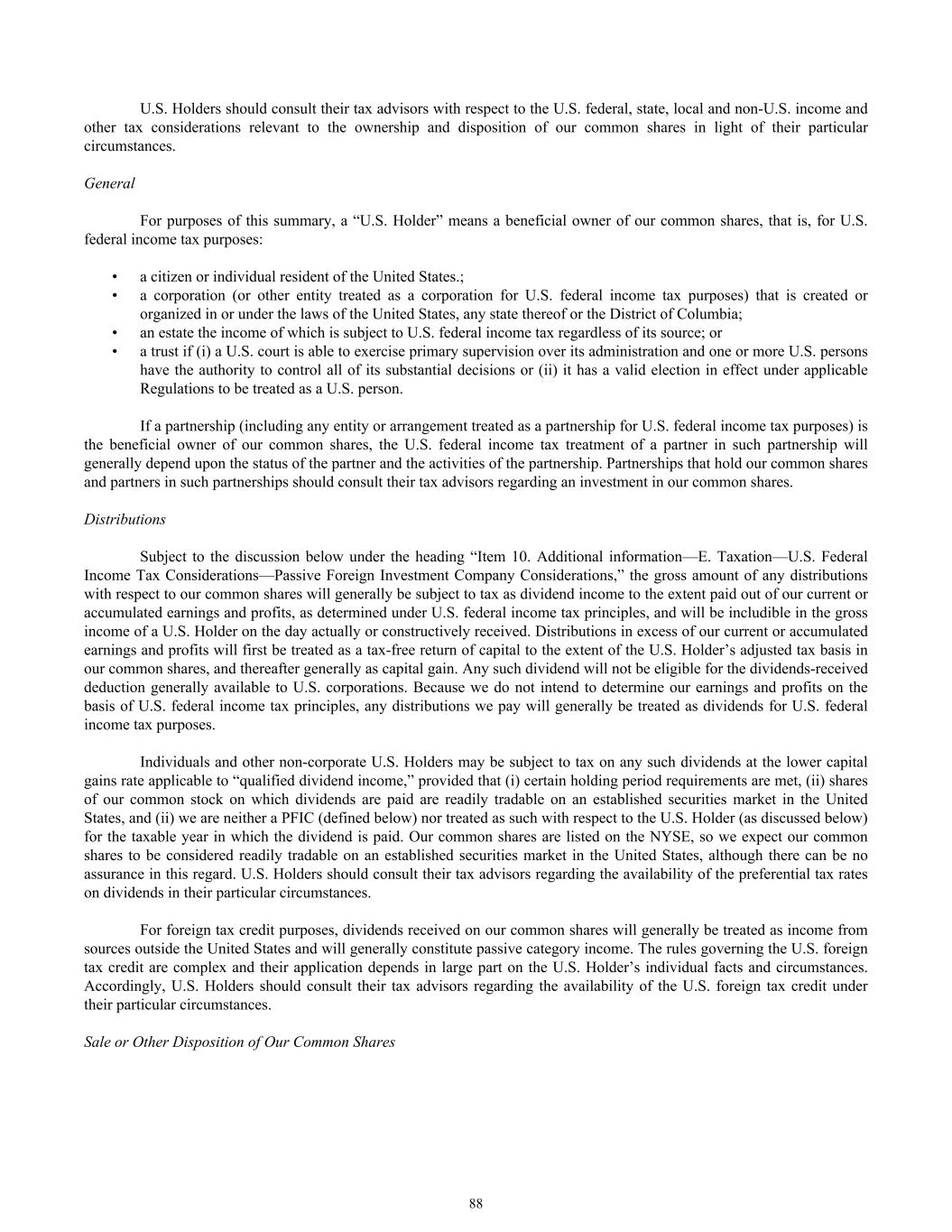
U.S. Holders should consult their tax advisors with respect to the U.S. federal, state, local and non-U.S. income and other tax considerations relevant to the ownership and disposition of our common shares in light of their particular circumstances. General For purposes of this summary, a “U.S. Holder” means a beneficial owner of our common shares, that is, for U.S. federal income tax purposes: • a citizen or individual resident of the United States.; • a corporation (or other entity treated as a corporation for U.S. federal income tax purposes) that is created or organized in or under the laws of the United States, any state thereof or the District of Columbia; • an estate the income of which is subject to U.S. federal income tax regardless of its source; or • a trust if (i) a U.S. court is able to exercise primary supervision over its administration and one or more U.S. persons have the authority to control all of its substantial decisions or (ii) it has a valid election in effect under applicable Regulations to be treated as a U.S. person. If a partnership (including any entity or arrangement treated as a partnership for U.S. federal income tax purposes) is the beneficial owner of our common shares, the U.S. federal income tax treatment of a partner in such partnership will generally depend upon the status of the partner and the activities of the partnership. Partnerships that hold our common shares and partners in such partnerships should consult their tax advisors regarding an investment in our common shares. Distributions Subject to the discussion below under the heading “Item 10. Additional information—E. Taxation—U.S. Federal Income Tax Considerations—Passive Foreign Investment Company Considerations,” the gross amount of any distributions with respect to our common shares will generally be subject to tax as dividend income to the extent paid out of our current or accumulated earnings and profits, as determined under U.S. federal income tax principles, and will be includible in the gross income of a U.S. Holder on the day actually or constructively received. Distributions in excess of our current or accumulated earnings and profits will first be treated as a tax-free return of capital to the extent of the U.S. Holder’s adjusted tax basis in our common shares, and thereafter generally as capital gain. Any such dividend will not be eligible for the dividends-received deduction generally available to U.S. corporations. Because we do not intend to determine our earnings and profits on the basis of U.S. federal income tax principles, any distributions we pay will generally be treated as dividends for U.S. federal income tax purposes. Individuals and other non-corporate U.S. Holders may be subject to tax on any such dividends at the lower capital gains rate applicable to “qualified dividend income,” provided that (i) certain holding period requirements are met, (ii) shares of our common stock on which dividends are paid are readily tradable on an established securities market in the United States, and (ii) we are neither a PFIC (defined below) nor treated as such with respect to the U.S. Holder (as discussed below) for the taxable year in which the dividend is paid. Our common shares are listed on the NYSE, so we expect our common shares to be considered readily tradable on an established securities market in the United States, although there can be no assurance in this regard. U.S. Holders should consult their tax advisors regarding the availability of the preferential tax rates on dividends in their particular circumstances. For foreign tax credit purposes, dividends received on our common shares will generally be treated as income from sources outside the United States and will generally constitute passive category income. The rules governing the U.S. foreign tax credit are complex and their application depends in large part on the U.S. Holder’s individual facts and circumstances. Accordingly, U.S. Holders should consult their tax advisors regarding the availability of the U.S. foreign tax credit under their particular circumstances. Sale or Other Disposition of Our Common Shares 88
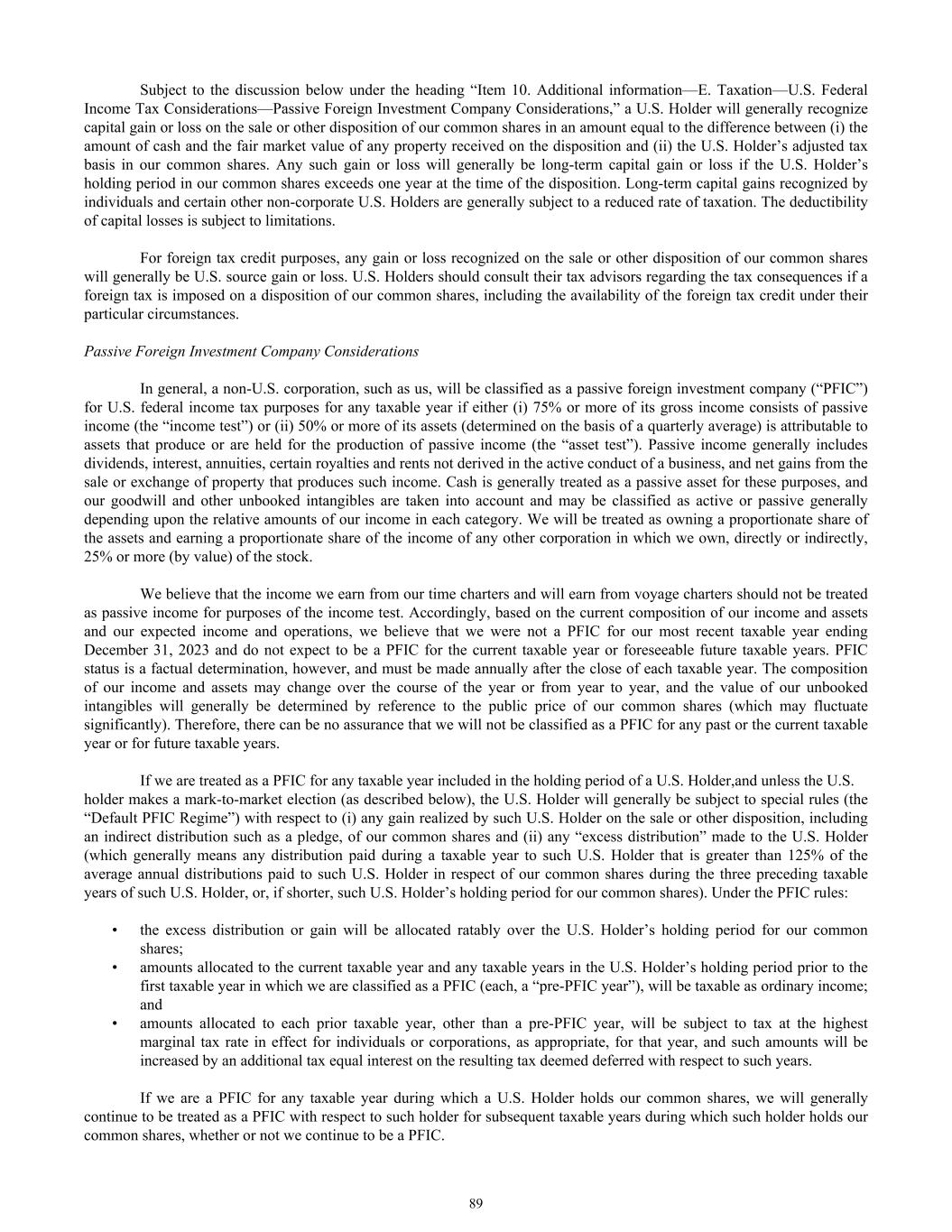
Subject to the discussion below under the heading “Item 10. Additional information—E. Taxation—U.S. Federal Income Tax Considerations—Passive Foreign Investment Company Considerations,” a U.S. Holder will generally recognize capital gain or loss on the sale or other disposition of our common shares in an amount equal to the difference between (i) the amount of cash and the fair market value of any property received on the disposition and (ii) the U.S. Holder’s adjusted tax basis in our common shares. Any such gain or loss will generally be long-term capital gain or loss if the U.S. Holder’s holding period in our common shares exceeds one year at the time of the disposition. Long-term capital gains recognized by individuals and certain other non-corporate U.S. Holders are generally subject to a reduced rate of taxation. The deductibility of capital losses is subject to limitations. For foreign tax credit purposes, any gain or loss recognized on the sale or other disposition of our common shares will generally be U.S. source gain or loss. U.S. Holders should consult their tax advisors regarding the tax consequences if a foreign tax is imposed on a disposition of our common shares, including the availability of the foreign tax credit under their particular circumstances. Passive Foreign Investment Company Considerations In general, a non-U.S. corporation, such as us, will be classified as a passive foreign investment company (“PFIC”) for U.S. federal income tax purposes for any taxable year if either (i) 75% or more of its gross income consists of passive income (the “income test”) or (ii) 50% or more of its assets (determined on the basis of a quarterly average) is attributable to assets that produce or are held for the production of passive income (the “asset test”). Passive income generally includes dividends, interest, annuities, certain royalties and rents not derived in the active conduct of a business, and net gains from the sale or exchange of property that produces such income. Cash is generally treated as a passive asset for these purposes, and our goodwill and other unbooked intangibles are taken into account and may be classified as active or passive generally depending upon the relative amounts of our income in each category. We will be treated as owning a proportionate share of the assets and earning a proportionate share of the income of any other corporation in which we own, directly or indirectly, 25% or more (by value) of the stock. We believe that the income we earn from our time charters and will earn from voyage charters should not be treated as passive income for purposes of the income test. Accordingly, based on the current composition of our income and assets and our expected income and operations, we believe that we were not a PFIC for our most recent taxable year ending December 31, 2023 and do not expect to be a PFIC for the current taxable year or foreseeable future taxable years. PFIC status is a factual determination, however, and must be made annually after the close of each taxable year. The composition of our income and assets may change over the course of the year or from year to year, and the value of our unbooked intangibles will generally be determined by reference to the public price of our common shares (which may fluctuate significantly). Therefore, there can be no assurance that we will not be classified as a PFIC for any past or the current taxable year or for future taxable years. If we are treated as a PFIC for any taxable year included in the holding period of a U.S. Holder,and unless the U.S. holder makes a mark-to-market election (as described below), the U.S. Holder will generally be subject to special rules (the “Default PFIC Regime”) with respect to (i) any gain realized by such U.S. Holder on the sale or other disposition, including an indirect distribution such as a pledge, of our common shares and (ii) any “excess distribution” made to the U.S. Holder (which generally means any distribution paid during a taxable year to such U.S. Holder that is greater than 125% of the average annual distributions paid to such U.S. Holder in respect of our common shares during the three preceding taxable years of such U.S. Holder, or, if shorter, such U.S. Holder’s holding period for our common shares). Under the PFIC rules: • the excess distribution or gain will be allocated ratably over the U.S. Holder’s holding period for our common shares; • amounts allocated to the current taxable year and any taxable years in the U.S. Holder’s holding period prior to the first taxable year in which we are classified as a PFIC (each, a “pre-PFIC year”), will be taxable as ordinary income; and • amounts allocated to each prior taxable year, other than a pre-PFIC year, will be subject to tax at the highest marginal tax rate in effect for individuals or corporations, as appropriate, for that year, and such amounts will be increased by an additional tax equal interest on the resulting tax deemed deferred with respect to such years. If we are a PFIC for any taxable year during which a U.S. Holder holds our common shares, we will generally continue to be treated as a PFIC with respect to such holder for subsequent taxable years during which such holder holds our common shares, whether or not we continue to be a PFIC. 89
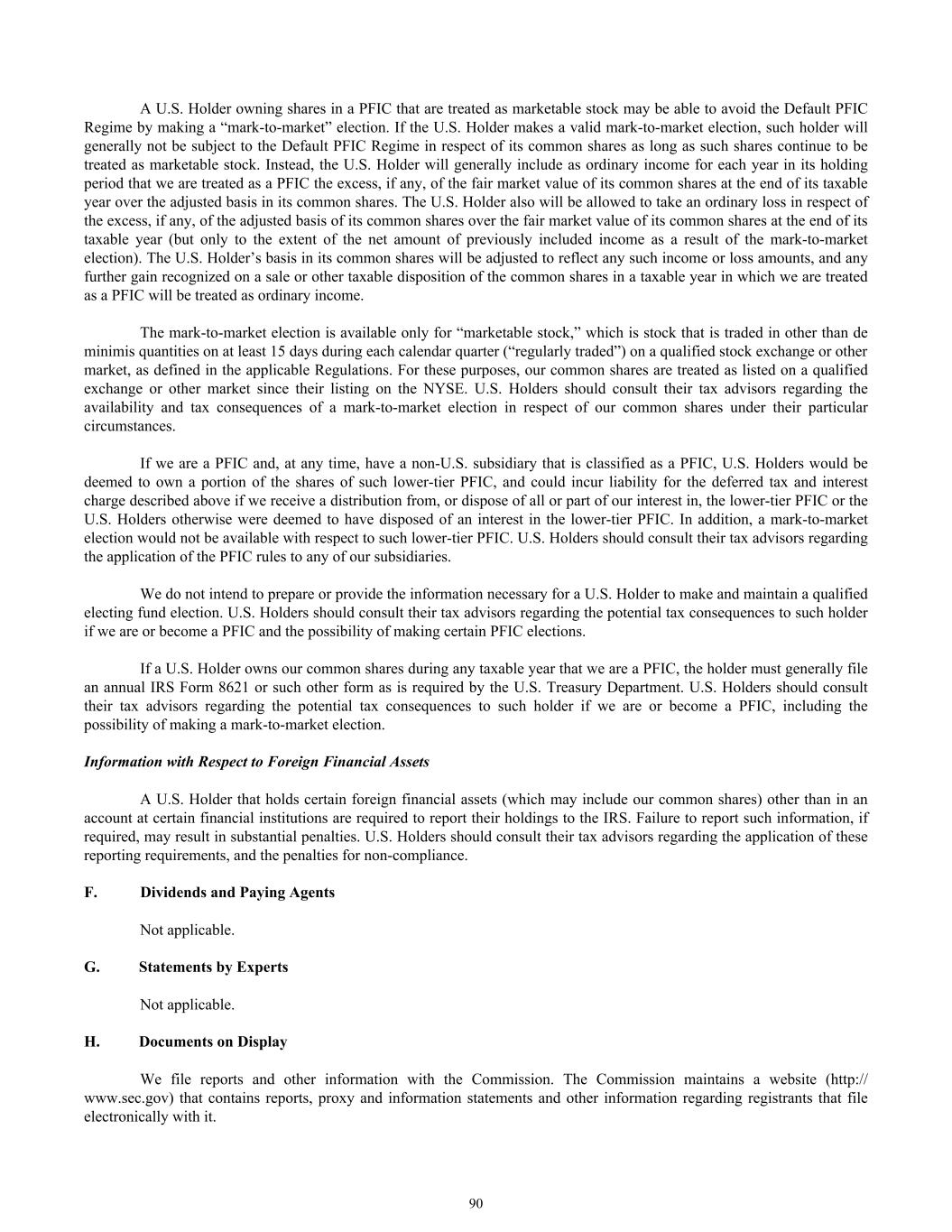
A U.S. Holder owning shares in a PFIC that are treated as marketable stock may be able to avoid the Default PFIC Regime by making a “mark-to-market” election. If the U.S. Holder makes a valid mark-to-market election, such holder will generally not be subject to the Default PFIC Regime in respect of its common shares as long as such shares continue to be treated as marketable stock. Instead, the U.S. Holder will generally include as ordinary income for each year in its holding period that we are treated as a PFIC the excess, if any, of the fair market value of its common shares at the end of its taxable year over the adjusted basis in its common shares. The U.S. Holder also will be allowed to take an ordinary loss in respect of the excess, if any, of the adjusted basis of its common shares over the fair market value of its common shares at the end of its taxable year (but only to the extent of the net amount of previously included income as a result of the mark-to-market election). The U.S. Holder’s basis in its common shares will be adjusted to reflect any such income or loss amounts, and any further gain recognized on a sale or other taxable disposition of the common shares in a taxable year in which we are treated as a PFIC will be treated as ordinary income. The mark-to-market election is available only for “marketable stock,” which is stock that is traded in other than de minimis quantities on at least 15 days during each calendar quarter (“regularly traded”) on a qualified stock exchange or other market, as defined in the applicable Regulations. For these purposes, our common shares are treated as listed on a qualified exchange or other market since their listing on the NYSE. U.S. Holders should consult their tax advisors regarding the availability and tax consequences of a mark-to-market election in respect of our common shares under their particular circumstances. If we are a PFIC and, at any time, have a non-U.S. subsidiary that is classified as a PFIC, U.S. Holders would be deemed to own a portion of the shares of such lower-tier PFIC, and could incur liability for the deferred tax and interest charge described above if we receive a distribution from, or dispose of all or part of our interest in, the lower-tier PFIC or the U.S. Holders otherwise were deemed to have disposed of an interest in the lower-tier PFIC. In addition, a mark-to-market election would not be available with respect to such lower-tier PFIC. U.S. Holders should consult their tax advisors regarding the application of the PFIC rules to any of our subsidiaries. We do not intend to prepare or provide the information necessary for a U.S. Holder to make and maintain a qualified electing fund election. U.S. Holders should consult their tax advisors regarding the potential tax consequences to such holder if we are or become a PFIC and the possibility of making certain PFIC elections. If a U.S. Holder owns our common shares during any taxable year that we are a PFIC, the holder must generally file an annual IRS Form 8621 or such other form as is required by the U.S. Treasury Department. U.S. Holders should consult their tax advisors regarding the potential tax consequences to such holder if we are or become a PFIC, including the possibility of making a mark-to-market election. Information with Respect to Foreign Financial Assets A U.S. Holder that holds certain foreign financial assets (which may include our common shares) other than in an account at certain financial institutions are required to report their holdings to the IRS. Failure to report such information, if required, may result in substantial penalties. U.S. Holders should consult their tax advisors regarding the application of these reporting requirements, and the penalties for non-compliance. F. Dividends and Paying Agents Not applicable. G. Statements by Experts Not applicable. H. Documents on Display We file reports and other information with the Commission. The Commission maintains a website (http:// www.sec.gov) that contains reports, proxy and information statements and other information regarding registrants that file electronically with it. 90
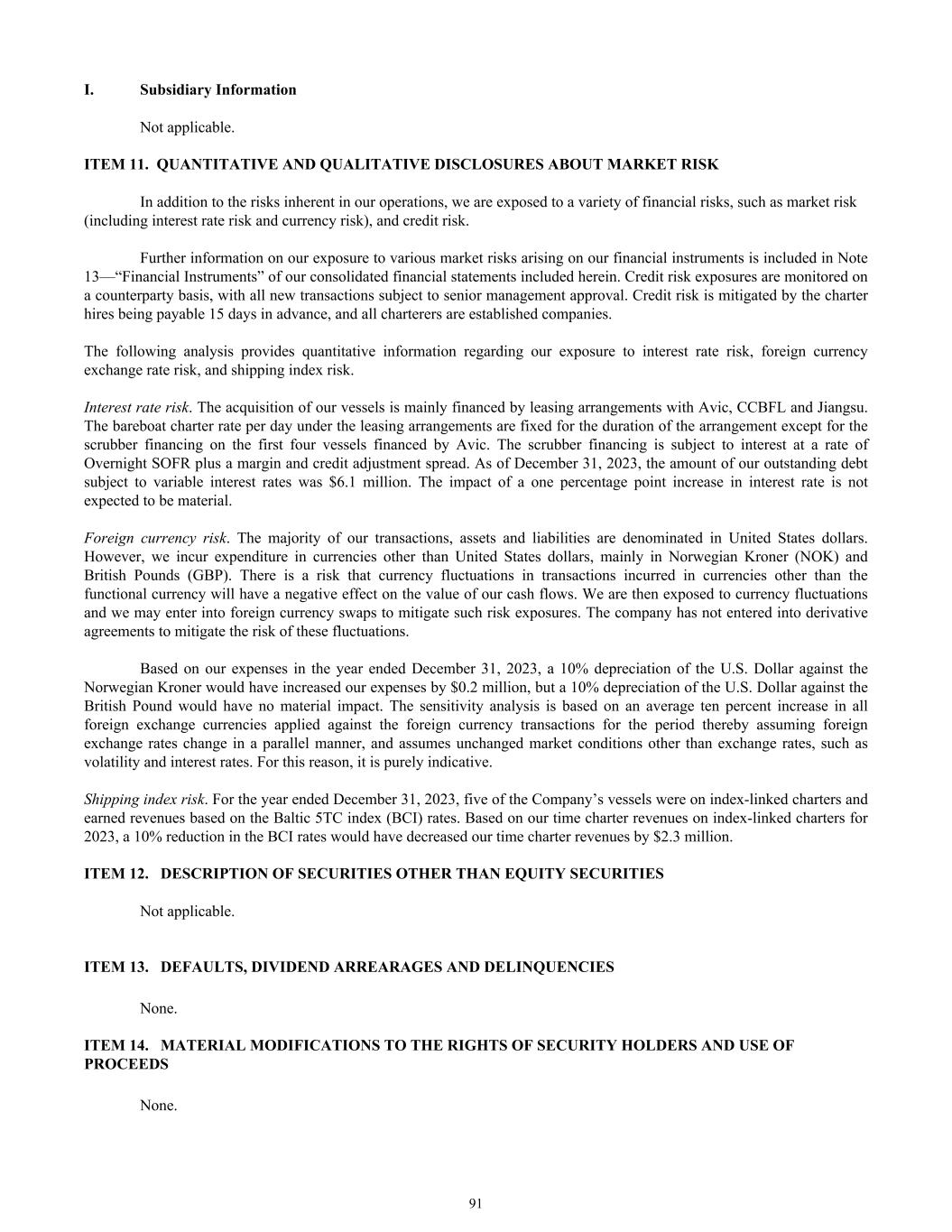
I. Subsidiary Information Not applicable. ITEM 11. QUANTITATIVE AND QUALITATIVE DISCLOSURES ABOUT MARKET RISK In addition to the risks inherent in our operations, we are exposed to a variety of financial risks, such as market risk (including interest rate risk and currency risk), and credit risk. Further information on our exposure to various market risks arising on our financial instruments is included in Note 13—“Financial Instruments” of our consolidated financial statements included herein. Credit risk exposures are monitored on a counterparty basis, with all new transactions subject to senior management approval. Credit risk is mitigated by the charter hires being payable 15 days in advance, and all charterers are established companies. The following analysis provides quantitative information regarding our exposure to interest rate risk, foreign currency exchange rate risk, and shipping index risk. Interest rate risk. The acquisition of our vessels is mainly financed by leasing arrangements with Avic, CCBFL and Jiangsu. The bareboat charter rate per day under the leasing arrangements are fixed for the duration of the arrangement except for the scrubber financing on the first four vessels financed by Avic. The scrubber financing is subject to interest at a rate of Overnight SOFR plus a margin and credit adjustment spread. As of December 31, 2023, the amount of our outstanding debt subject to variable interest rates was $6.1 million. The impact of a one percentage point increase in interest rate is not expected to be material. Foreign currency risk. The majority of our transactions, assets and liabilities are denominated in United States dollars. However, we incur expenditure in currencies other than United States dollars, mainly in Norwegian Kroner (NOK) and British Pounds (GBP). There is a risk that currency fluctuations in transactions incurred in currencies other than the functional currency will have a negative effect on the value of our cash flows. We are then exposed to currency fluctuations and we may enter into foreign currency swaps to mitigate such risk exposures. The company has not entered into derivative agreements to mitigate the risk of these fluctuations. Based on our expenses in the year ended December 31, 2023, a 10% depreciation of the U.S. Dollar against the Norwegian Kroner would have increased our expenses by $0.2 million, but a 10% depreciation of the U.S. Dollar against the British Pound would have no material impact. The sensitivity analysis is based on an average ten percent increase in all foreign exchange currencies applied against the foreign currency transactions for the period thereby assuming foreign exchange rates change in a parallel manner, and assumes unchanged market conditions other than exchange rates, such as volatility and interest rates. For this reason, it is purely indicative. Shipping index risk. For the year ended December 31, 2023, five of the Company’s vessels were on index-linked charters and earned revenues based on the Baltic 5TC index (BCI) rates. Based on our time charter revenues on index-linked charters for 2023, a 10% reduction in the BCI rates would have decreased our time charter revenues by $2.3 million. ITEM 12. DESCRIPTION OF SECURITIES OTHER THAN EQUITY SECURITIES Not applicable. ITEM 13. DEFAULTS, DIVIDEND ARREARAGES AND DELINQUENCIES None. ITEM 14. MATERIAL MODIFICATIONS TO THE RIGHTS OF SECURITY HOLDERS AND USE OF PROCEEDS None. 91
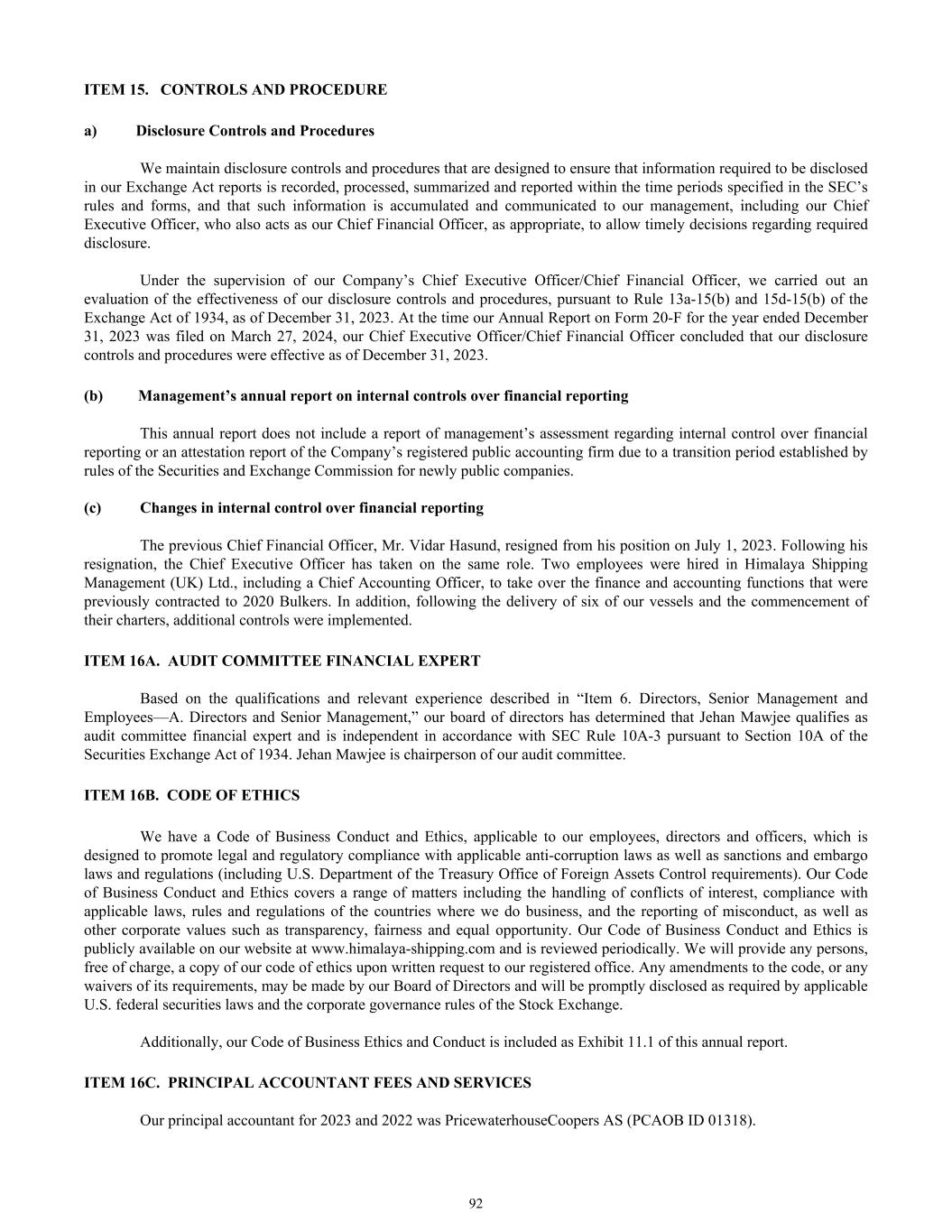
ITEM 15. CONTROLS AND PROCEDURE a) Disclosure Controls and Procedures We maintain disclosure controls and procedures that are designed to ensure that information required to be disclosed in our Exchange Act reports is recorded, processed, summarized and reported within the time periods specified in the SEC’s rules and forms, and that such information is accumulated and communicated to our management, including our Chief Executive Officer, who also acts as our Chief Financial Officer, as appropriate, to allow timely decisions regarding required disclosure. Under the supervision of our Company’s Chief Executive Officer/Chief Financial Officer, we carried out an evaluation of the effectiveness of our disclosure controls and procedures, pursuant to Rule 13a-15(b) and 15d-15(b) of the Exchange Act of 1934, as of December 31, 2023. At the time our Annual Report on Form 20-F for the year ended December 31, 2023 was filed on March 27, 2024, our Chief Executive Officer/Chief Financial Officer concluded that our disclosure controls and procedures were effective as of December 31, 2023. (b) Management’s annual report on internal controls over financial reporting This annual report does not include a report of management’s assessment regarding internal control over financial reporting or an attestation report of the Company’s registered public accounting firm due to a transition period established by rules of the Securities and Exchange Commission for newly public companies. (c) Changes in internal control over financial reporting The previous Chief Financial Officer, Mr. Vidar Hasund, resigned from his position on July 1, 2023. Following his resignation, the Chief Executive Officer has taken on the same role. Two employees were hired in Himalaya Shipping Management (UK) Ltd., including a Chief Accounting Officer, to take over the finance and accounting functions that were previously contracted to 2020 Bulkers. In addition, following the delivery of six of our vessels and the commencement of their charters, additional controls were implemented. ITEM 16A. AUDIT COMMITTEE FINANCIAL EXPERT Based on the qualifications and relevant experience described in “Item 6. Directors, Senior Management and Employees—A. Directors and Senior Management,” our board of directors has determined that Jehan Mawjee qualifies as audit committee financial expert and is independent in accordance with SEC Rule 10A-3 pursuant to Section 10A of the Securities Exchange Act of 1934. Jehan Mawjee is chairperson of our audit committee. ITEM 16B. CODE OF ETHICS We have a Code of Business Conduct and Ethics, applicable to our employees, directors and officers, which is designed to promote legal and regulatory compliance with applicable anti-corruption laws as well as sanctions and embargo laws and regulations (including U.S. Department of the Treasury Office of Foreign Assets Control requirements). Our Code of Business Conduct and Ethics covers a range of matters including the handling of conflicts of interest, compliance with applicable laws, rules and regulations of the countries where we do business, and the reporting of misconduct, as well as other corporate values such as transparency, fairness and equal opportunity. Our Code of Business Conduct and Ethics is publicly available on our website at www.himalaya-shipping.com and is reviewed periodically. We will provide any persons, free of charge, a copy of our code of ethics upon written request to our registered office. Any amendments to the code, or any waivers of its requirements, may be made by our Board of Directors and will be promptly disclosed as required by applicable U.S. federal securities laws and the corporate governance rules of the Stock Exchange. Additionally, our Code of Business Ethics and Conduct is included as Exhibit 11.1 of this annual report. ITEM 16C. PRINCIPAL ACCOUNTANT FEES AND SERVICES Our principal accountant for 2023 and 2022 was PricewaterhouseCoopers AS (PCAOB ID 01318). 92

(a) Audit Fees The following table sets forth, for the two most recent fiscal years, the aggregate fees billed for professional services rendered by the principal accountant, PricewaterhouseCoopers AS for the audit of our annual financial statements and services provided by the principal accountant in connection with statutory and regulatory filings or engagements. (in thousands of $) Fiscal year ended December 31, 2023 773 Fiscal year ended December 31, 2022 294 (b) Audit-Related Fees The following table sets forth, for the two most recent fiscal years, the aggregate fees billed for assurance and related services, not included under “(a) Audit Fees,” rendered by the principal accountant. (in thousands of $) Fiscal year ended December 31, 2023 — Fiscal year ended December 31, 2022 — (c) Audit Committee’s Pre-Approval Policies and Procedures Our board of directors has adopted pre-approval policies and procedures in compliance with paragraph (c)(7)(i) of Rule 2-01 of Regulation S-X that require our board of directors to approve the appointment of our independent auditor before such auditor is engaged and to approve each of the audit and non-audit related services to be provided by such auditor. All services provided by the principal auditor in 2023 and 2022 were approved by our board of directors pursuant to the pre- approval policy. ITEM 16D. EXEMPTIONS FROM THE LISTING STANDARDS FOR AUDIT COMMITTEES Not applicable. ITEM 16E. PURCHASES OF EQUITY SECURITIES BY THE ISSUER AND AFFILIATED PURCHASERS Not applicable. ITEM 16F. CHANGE IN REGISTRANT’S CERTIFYING ACCOUNTANT Not applicable. ITEM 16G. CORPORATE GOVERNANCE In general, under the Stock Exchange corporate governance standards, foreign private issuers, as defined under the Exchange Act, are permitted to follow home country corporate governance practices instead of the corporate governance practices of the Stock Exchange. Accordingly, we follow certain corporate governance practices of our home country, Bermuda, in lieu of certain of the corporate governance requirements of the Stock Exchange. A brief summary of those differences is provided as follows: • The NYSE requires U.S. listed companies to have a compensation committee composed entirely of independent directors and a committee charter addressing the purpose, responsibility, rights and performance evaluation of the committee. We will rely on home country practice in Bermuda to be exempted from certain of the corporate governance requirements of the NYSE, such that we do not have a standing compensation committee. In lieu of a compensation committee, our Board is responsible for establishing the executive officers’ compensation and benefits including our equity compensation plan. 93
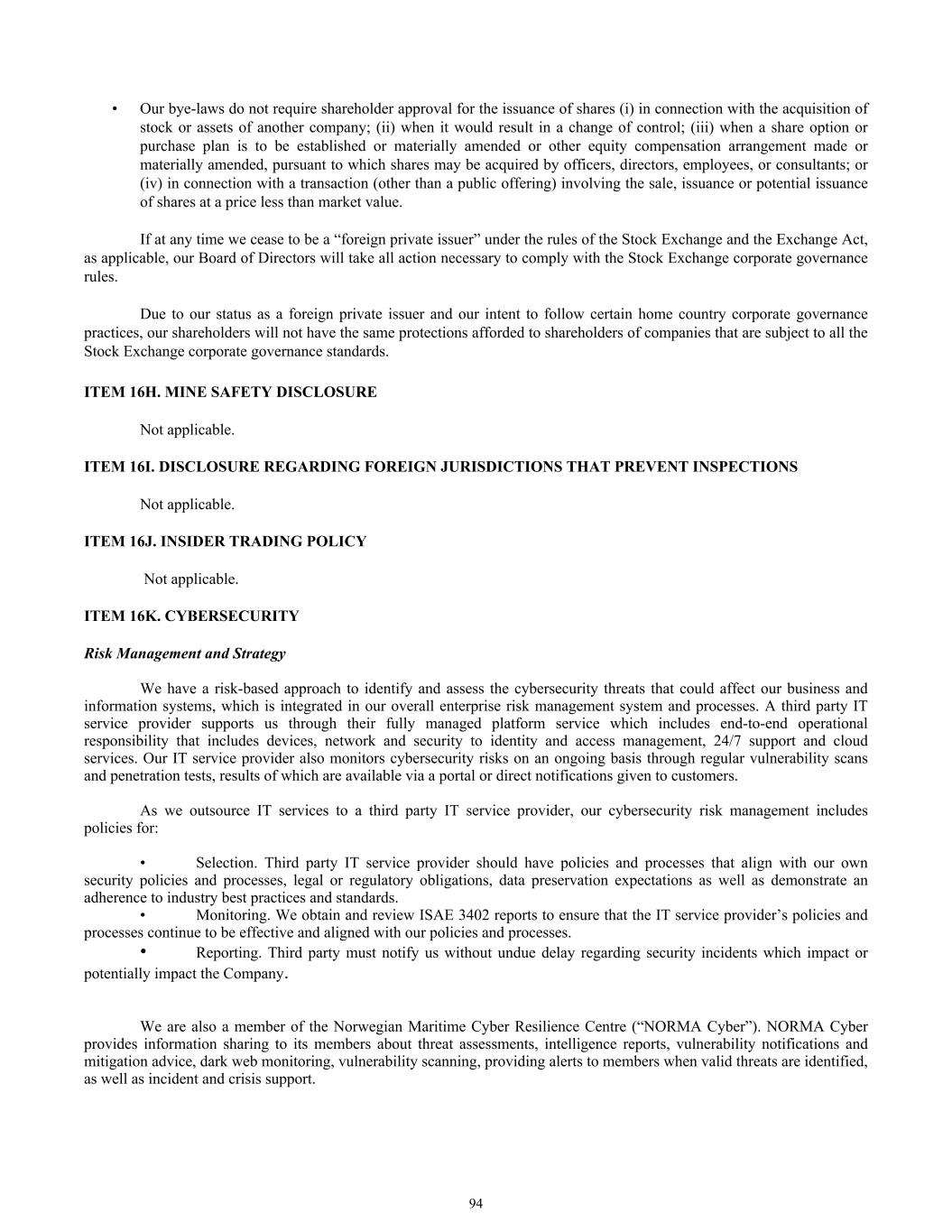
• Our bye-laws do not require shareholder approval for the issuance of shares (i) in connection with the acquisition of stock or assets of another company; (ii) when it would result in a change of control; (iii) when a share option or purchase plan is to be established or materially amended or other equity compensation arrangement made or materially amended, pursuant to which shares may be acquired by officers, directors, employees, or consultants; or (iv) in connection with a transaction (other than a public offering) involving the sale, issuance or potential issuance of shares at a price less than market value. If at any time we cease to be a “foreign private issuer” under the rules of the Stock Exchange and the Exchange Act, as applicable, our Board of Directors will take all action necessary to comply with the Stock Exchange corporate governance rules. Due to our status as a foreign private issuer and our intent to follow certain home country corporate governance practices, our shareholders will not have the same protections afforded to shareholders of companies that are subject to all the Stock Exchange corporate governance standards. ITEM 16H. MINE SAFETY DISCLOSURE Not applicable. ITEM 16I. DISCLOSURE REGARDING FOREIGN JURISDICTIONS THAT PREVENT INSPECTIONS Not applicable. ITEM 16J. INSIDER TRADING POLICY Not applicable. ITEM 16K. CYBERSECURITY Risk Management and Strategy We have a risk-based approach to identify and assess the cybersecurity threats that could affect our business and information systems, which is integrated in our overall enterprise risk management system and processes. A third party IT service provider supports us through their fully managed platform service which includes end-to-end operational responsibility that includes devices, network and security to identity and access management, 24/7 support and cloud services. Our IT service provider also monitors cybersecurity risks on an ongoing basis through regular vulnerability scans and penetration tests, results of which are available via a portal or direct notifications given to customers. As we outsource IT services to a third party IT service provider, our cybersecurity risk management includes policies for: • Selection. Third party IT service provider should have policies and processes that align with our own security policies and processes, legal or regulatory obligations, data preservation expectations as well as demonstrate an adherence to industry best practices and standards. • Monitoring. We obtain and review ISAE 3402 reports to ensure that the IT service provider’s policies and processes continue to be effective and aligned with our policies and processes. • Reporting. Third party must notify us without undue delay regarding security incidents which impact or potentially impact the Company. We are also a member of the Norwegian Maritime Cyber Resilience Centre (“NORMA Cyber”). NORMA Cyber provides information sharing to its members about threat assessments, intelligence reports, vulnerability notifications and mitigation advice, dark web monitoring, vulnerability scanning, providing alerts to members when valid threats are identified, as well as incident and crisis support. 94

Based on the information we have, cybersecurity threats have not materially affected and we believe are not reasonably likely to materially affect us, including our business strategy, results of operations or financial condition. However, we cannot predict the scope and impact of any future incident. See “Item 3. Key Information—D. Risk Factors” for more information on cybersecurity risks. Governance Our board of directors oversees the Company’s risk management process, including on cybersecurity risks, directly. The board oversees the Company’s risk management program, which focuses on the most significant risks the Company faces in the short-, intermediate-, and long-term timeframe. The Company takes a risk-based approach to cybersecurity and has implemented cybersecurity policies throughout its operations that are designed to address cybersecurity threats and incidents. In particular, our management team is responsible for the selection and monitoring of our IT service provider. Our management team also assesses any cybersecurity risks identified by our IT service provider and NORMA Cyber by monitoring and reviewing any specific incident report and general information shared about threat assessments and vulnerability notifications. In addition, the management team communicates these with the Board on a quarterly basis. PART III ITEM 17. FINANCIAL STATEMENTS See Item 18. ITEM 18. FINANCIAL STATEMENTS The following financial statements listed below and set forth on pages F-1 through to F-28 are filed as part of this Annual Report. ITEM 19. EXHIBITS The following exhibits are filed as part of this Annual Report: 95
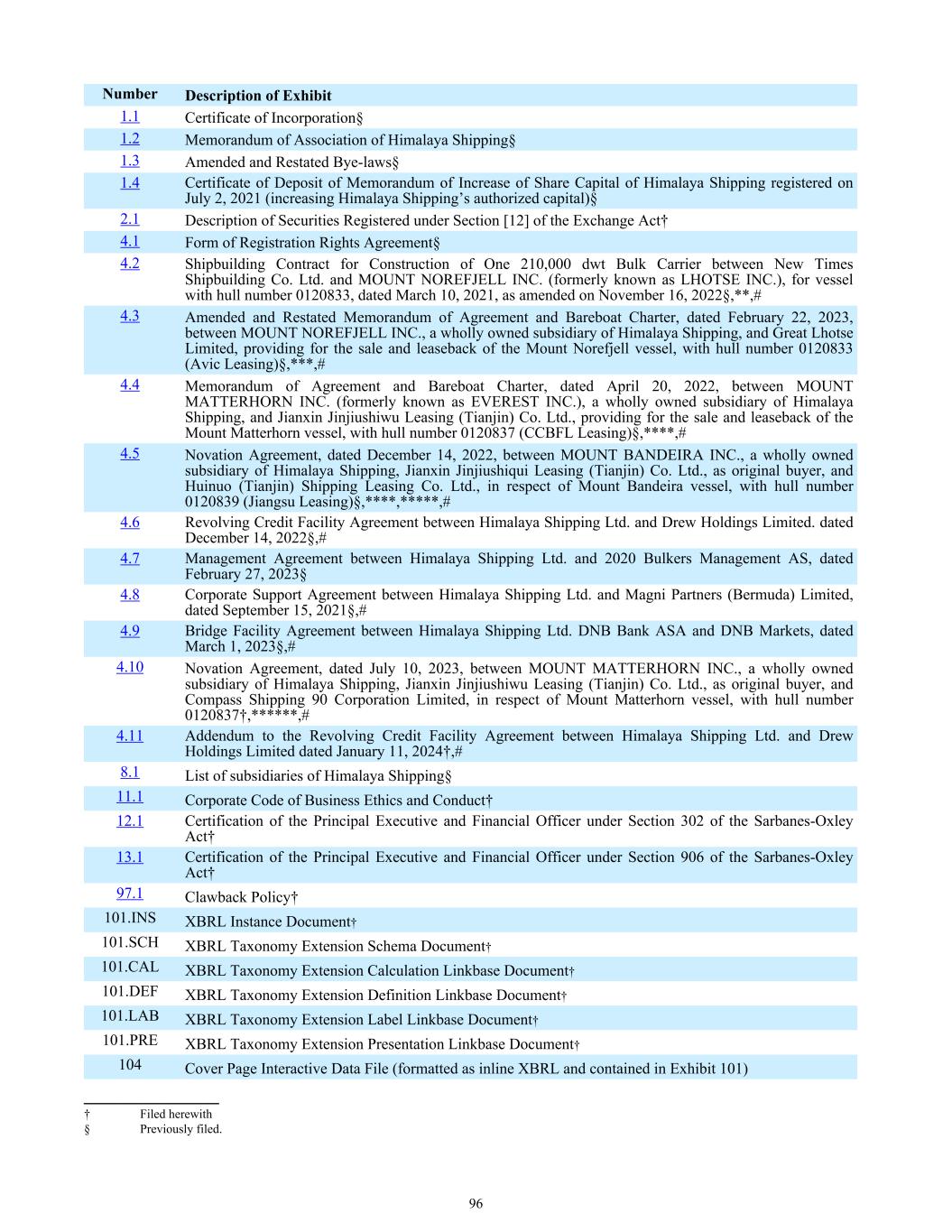
Number Description of Exhibit 1.1 Certificate of Incorporation§ 1.2 Memorandum of Association of Himalaya Shipping§ 1.3 Amended and Restated Bye-laws§ 1.4 Certificate of Deposit of Memorandum of Increase of Share Capital of Himalaya Shipping registered on July 2, 2021 (increasing Himalaya Shipping’s authorized capital)§ 2.1 Description of Securities Registered under Section [12] of the Exchange Act† 4.1 Form of Registration Rights Agreement§ 4.2 Shipbuilding Contract for Construction of One 210,000 dwt Bulk Carrier between New Times Shipbuilding Co. Ltd. and MOUNT NOREFJELL INC. (formerly known as LHOTSE INC.), for vessel with hull number 0120833, dated March 10, 2021, as amended on November 16, 2022§,**,# 4.3 Amended and Restated Memorandum of Agreement and Bareboat Charter, dated February 22, 2023, between MOUNT NOREFJELL INC., a wholly owned subsidiary of Himalaya Shipping, and Great Lhotse Limited, providing for the sale and leaseback of the Mount Norefjell vessel, with hull number 0120833 (Avic Leasing)§,***,# 4.4 Memorandum of Agreement and Bareboat Charter, dated April 20, 2022, between MOUNT MATTERHORN INC. (formerly known as EVEREST INC.), a wholly owned subsidiary of Himalaya Shipping, and Jianxin Jinjiushiwu Leasing (Tianjin) Co. Ltd., providing for the sale and leaseback of the Mount Matterhorn vessel, with hull number 0120837 (CCBFL Leasing)§,****,# 4.5 Novation Agreement, dated December 14, 2022, between MOUNT BANDEIRA INC., a wholly owned subsidiary of Himalaya Shipping, Jianxin Jinjiushiqui Leasing (Tianjin) Co. Ltd., as original buyer, and Huinuo (Tianjin) Shipping Leasing Co. Ltd., in respect of Mount Bandeira vessel, with hull number 0120839 (Jiangsu Leasing)§,****,*****,# 4.6 Revolving Credit Facility Agreement between Himalaya Shipping Ltd. and Drew Holdings Limited. dated December 14, 2022§,# 4.7 Management Agreement between Himalaya Shipping Ltd. and 2020 Bulkers Management AS, dated February 27, 2023§ 4.8 Corporate Support Agreement between Himalaya Shipping Ltd. and Magni Partners (Bermuda) Limited, dated September 15, 2021§,# 4.9 Bridge Facility Agreement between Himalaya Shipping Ltd. DNB Bank ASA and DNB Markets, dated March 1, 2023§,# 4.10 Novation Agreement, dated July 10, 2023, between MOUNT MATTERHORN INC., a wholly owned subsidiary of Himalaya Shipping, Jianxin Jinjiushiwu Leasing (Tianjin) Co. Ltd., as original buyer, and Compass Shipping 90 Corporation Limited, in respect of Mount Matterhorn vessel, with hull number 0120837†,******,# 4.11 Addendum to the Revolving Credit Facility Agreement between Himalaya Shipping Ltd. and Drew Holdings Limited dated January 11, 2024†,# 8.1 List of subsidiaries of Himalaya Shipping§ 11.1 Corporate Code of Business Ethics and Conduct† 12.1 Certification of the Principal Executive and Financial Officer under Section 302 of the Sarbanes-Oxley Act† 13.1 Certification of the Principal Executive and Financial Officer under Section 906 of the Sarbanes-Oxley Act† 97.1 Clawback Policy† 101.INS XBRL Instance Document† 101.SCH XBRL Taxonomy Extension Schema Document† 101.CAL XBRL Taxonomy Extension Calculation Linkbase Document† 101.DEF XBRL Taxonomy Extension Definition Linkbase Document† 101.LAB XBRL Taxonomy Extension Label Linkbase Document† 101.PRE XBRL Taxonomy Extension Presentation Linkbase Document† 104 Cover Page Interactive Data File (formatted as inline XBRL and contained in Exhibit 101) _____________ † Filed herewith § Previously filed. 96
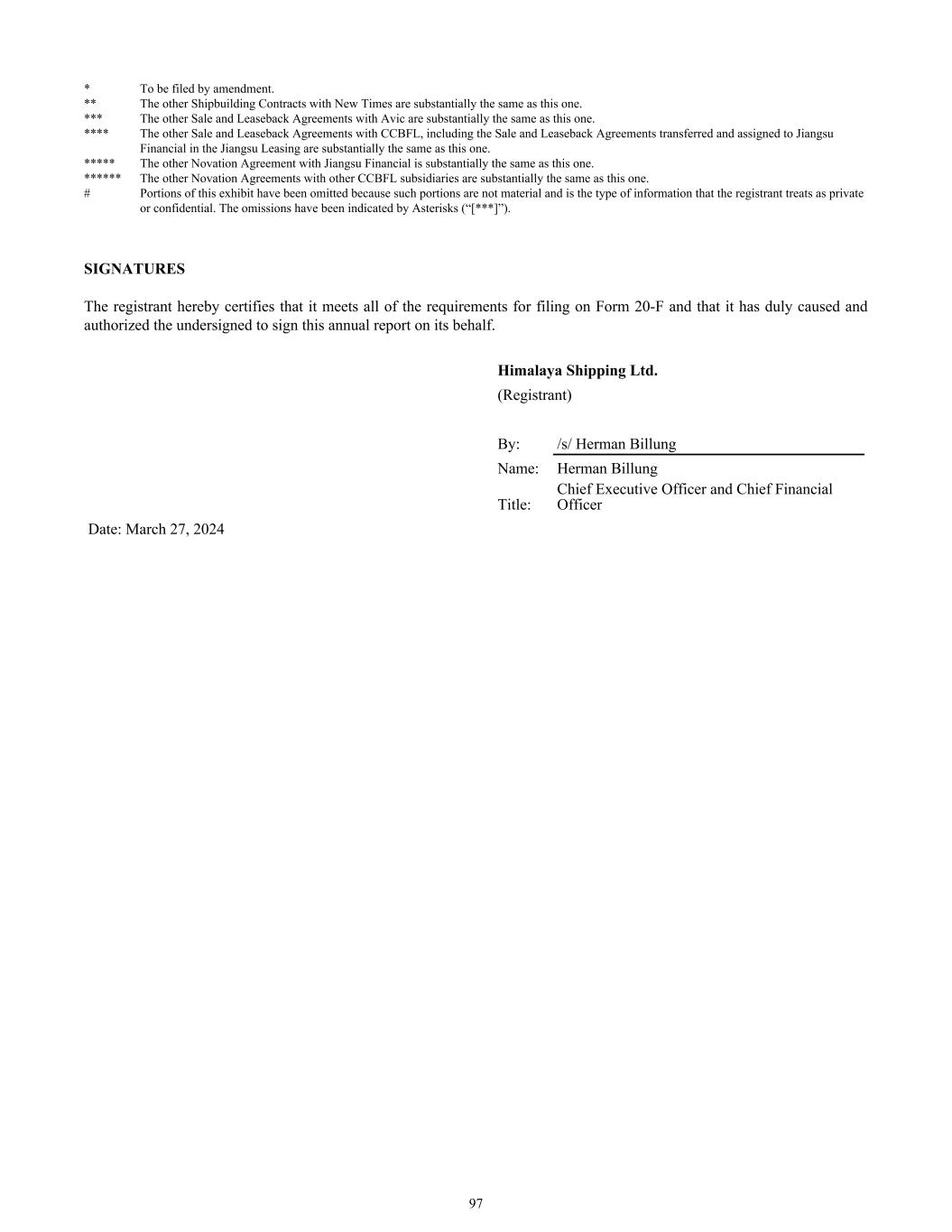
* To be filed by amendment. ** The other Shipbuilding Contracts with New Times are substantially the same as this one. *** The other Sale and Leaseback Agreements with Avic are substantially the same as this one. **** The other Sale and Leaseback Agreements with CCBFL, including the Sale and Leaseback Agreements transferred and assigned to Jiangsu Financial in the Jiangsu Leasing are substantially the same as this one. ***** The other Novation Agreement with Jiangsu Financial is substantially the same as this one. ****** The other Novation Agreements with other CCBFL subsidiaries are substantially the same as this one. # Portions of this exhibit have been omitted because such portions are not material and is the type of information that the registrant treats as private or confidential. The omissions have been indicated by Asterisks (“[***]”). SIGNATURES The registrant hereby certifies that it meets all of the requirements for filing on Form 20-F and that it has duly caused and authorized the undersigned to sign this annual report on its behalf. Himalaya Shipping Ltd. (Registrant) By: /s/ Herman Billung Name: Herman Billung Title: Chief Executive Officer and Chief Financial Officer Date: March 27, 2024 97
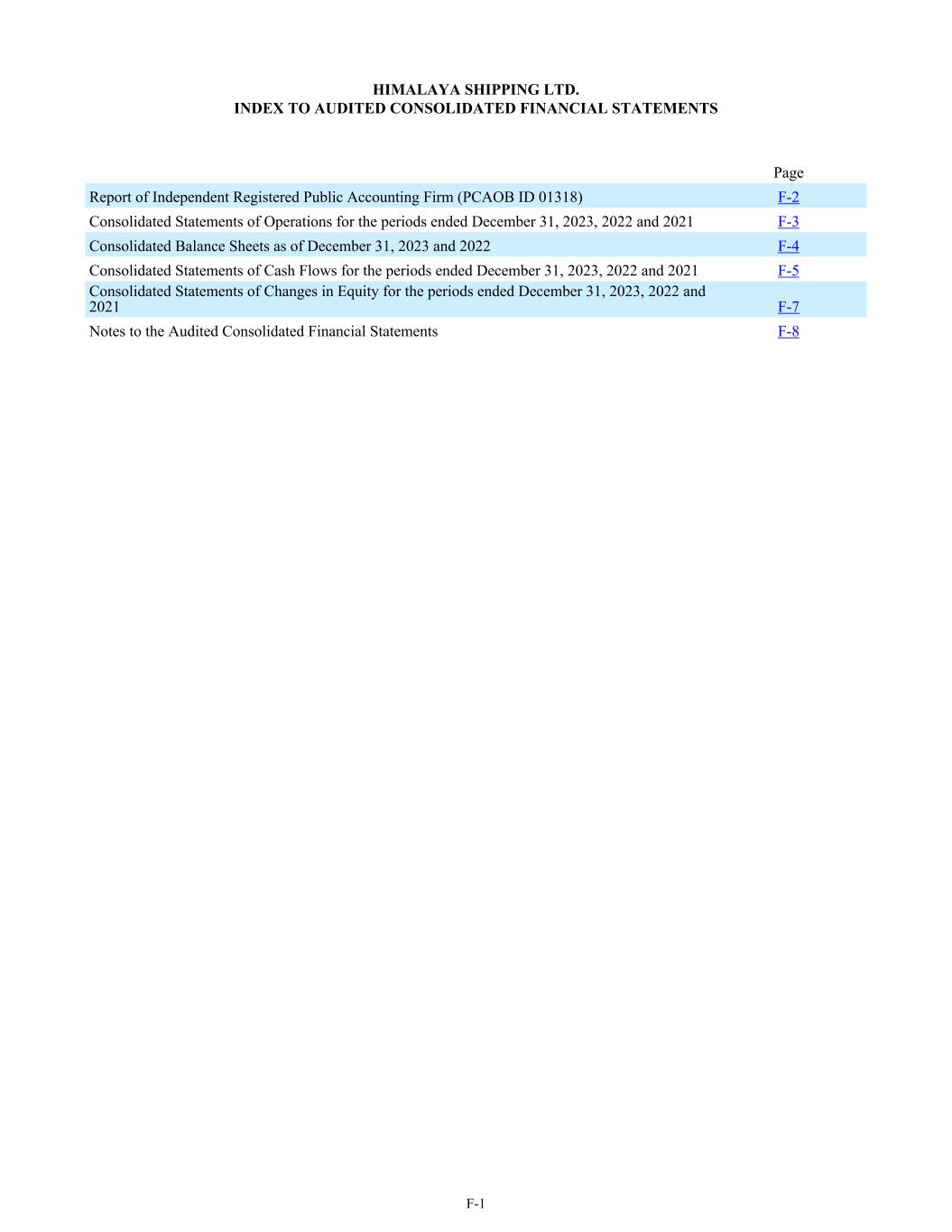
HIMALAYA SHIPPING LTD. INDEX TO AUDITED CONSOLIDATED FINANCIAL STATEMENTS Page Report of Independent Registered Public Accounting Firm (PCAOB ID 01318) F-2 Consolidated Statements of Operations for the periods ended December 31, 2023, 2022 and 2021 F-3 Consolidated Balance Sheets as of December 31, 2023 and 2022 F-4 Consolidated Statements of Cash Flows for the periods ended December 31, 2023, 2022 and 2021 F-5 Consolidated Statements of Changes in Equity for the periods ended December 31, 2023, 2022 and 2021 F-7 Notes to the Audited Consolidated Financial Statements F-8 F-1

REPORT OF INDEPENDENT REGISTERED PUBLIC ACCOUNTING FIRM To the Board of Directors and Shareholders of Himalaya Shipping Ltd. Opinion on the Financial Statements We have audited the accompanying consolidated balance sheets of Himalaya Shipping Ltd. and its subsidiaries (the “Company”) as of December 31, 2023 and December 31, 2022, and the related consolidated statements of operations, of changes in shareholders’ equity and of cash flows for each of the years ended December 31, 2023 and December 31, 2022 and the period from March 17, 2021 to December 31, 2021, including the related notes (collectively referred to as the “consolidated financial statements”). In our opinion, the consolidated financial statements present fairly, in all material respects, the financial position of the Company as of December 31, 2023 and December 31, 2022, and the results of its operations and its cash flows for each of the years ended December 31, 2023 and December 31, 2022 and the period from March 17, 2021 to December 31, 2021 in conformity with accounting principles generally accepted in the United States of America. Basis for Opinion These consolidated financial statements are the responsibility of the Company’s management. Our responsibility is to express an opinion on the Company’s consolidated financial statements based on our audits. We are a public accounting firm registered with the Public Company Accounting Oversight Board (United States) (PCAOB) and are required to be independent with respect to the Company in accordance with the U.S. federal securities laws and the applicable rules and regulations of the Securities and Exchange Commission and the PCAOB. We conducted our audits of these consolidated financial statements in accordance with the standards of the PCAOB. Those standards require that we plan and perform the audit to obtain reasonable assurance about whether the consolidated financial statements are free of material misstatement, whether due to error or fraud. Our audits included performing procedures to assess the risks of material misstatement of the consolidated financial statements, whether due to error or fraud, and performing procedures that respond to those risks. Such procedures included examining, on a test basis, evidence regarding the amounts and disclosures in the consolidated financial statements. Our audits also included evaluating the accounting principles used and significant estimates made by management, as well as evaluating the overall presentation of the consolidated financial statements. We believe that our audits provide a reasonable basis for our opinion. /s/ PricewaterhouseCoopers AS Oslo, Norway March 27, 2024 We have served as the Company's auditor since 2021. F-2
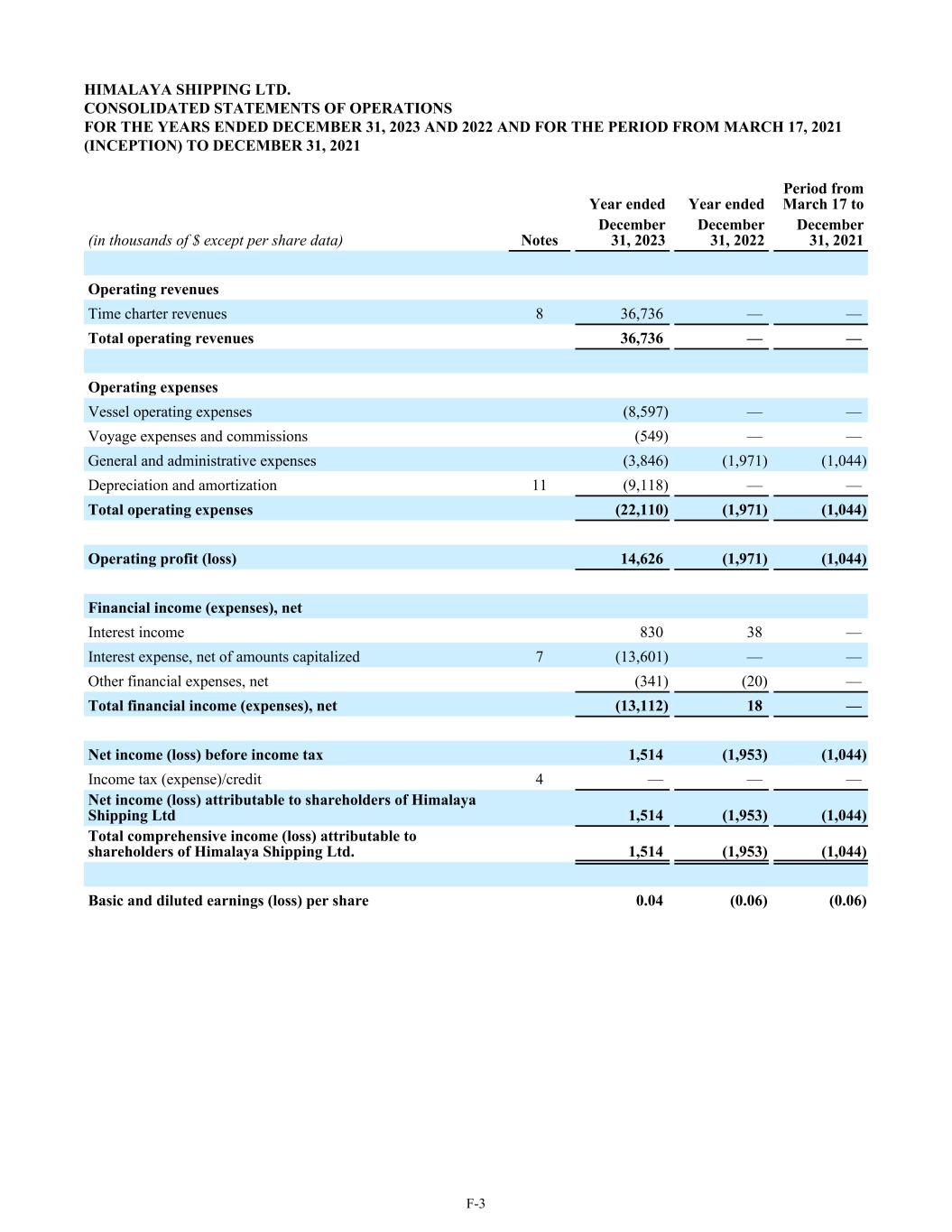
HIMALAYA SHIPPING LTD. CONSOLIDATED STATEMENTS OF OPERATIONS FOR THE YEARS ENDED DECEMBER 31, 2023 AND 2022 AND FOR THE PERIOD FROM MARCH 17, 2021 (INCEPTION) TO DECEMBER 31, 2021 Year ended Year ended Period from March 17 to (in thousands of $ except per share data) Notes December 31, 2023 December 31, 2022 December 31, 2021 Operating revenues Time charter revenues 8 36,736 — — Total operating revenues 36,736 — — Operating expenses Vessel operating expenses (8,597) — — Voyage expenses and commissions (549) — — General and administrative expenses (3,846) (1,971) (1,044) Depreciation and amortization 11 (9,118) — — Total operating expenses (22,110) (1,971) (1,044) Operating profit (loss) 14,626 (1,971) (1,044) Financial income (expenses), net Interest income 830 38 — Interest expense, net of amounts capitalized 7 (13,601) — — Other financial expenses, net (341) (20) — Total financial income (expenses), net (13,112) 18 — Net income (loss) before income tax 1,514 (1,953) (1,044) Income tax (expense)/credit 4 — — — Net income (loss) attributable to shareholders of Himalaya Shipping Ltd 1,514 (1,953) (1,044) Total comprehensive income (loss) attributable to shareholders of Himalaya Shipping Ltd. 1,514 (1,953) (1,044) Basic and diluted earnings (loss) per share 0.04 (0.06) (0.06) F-3
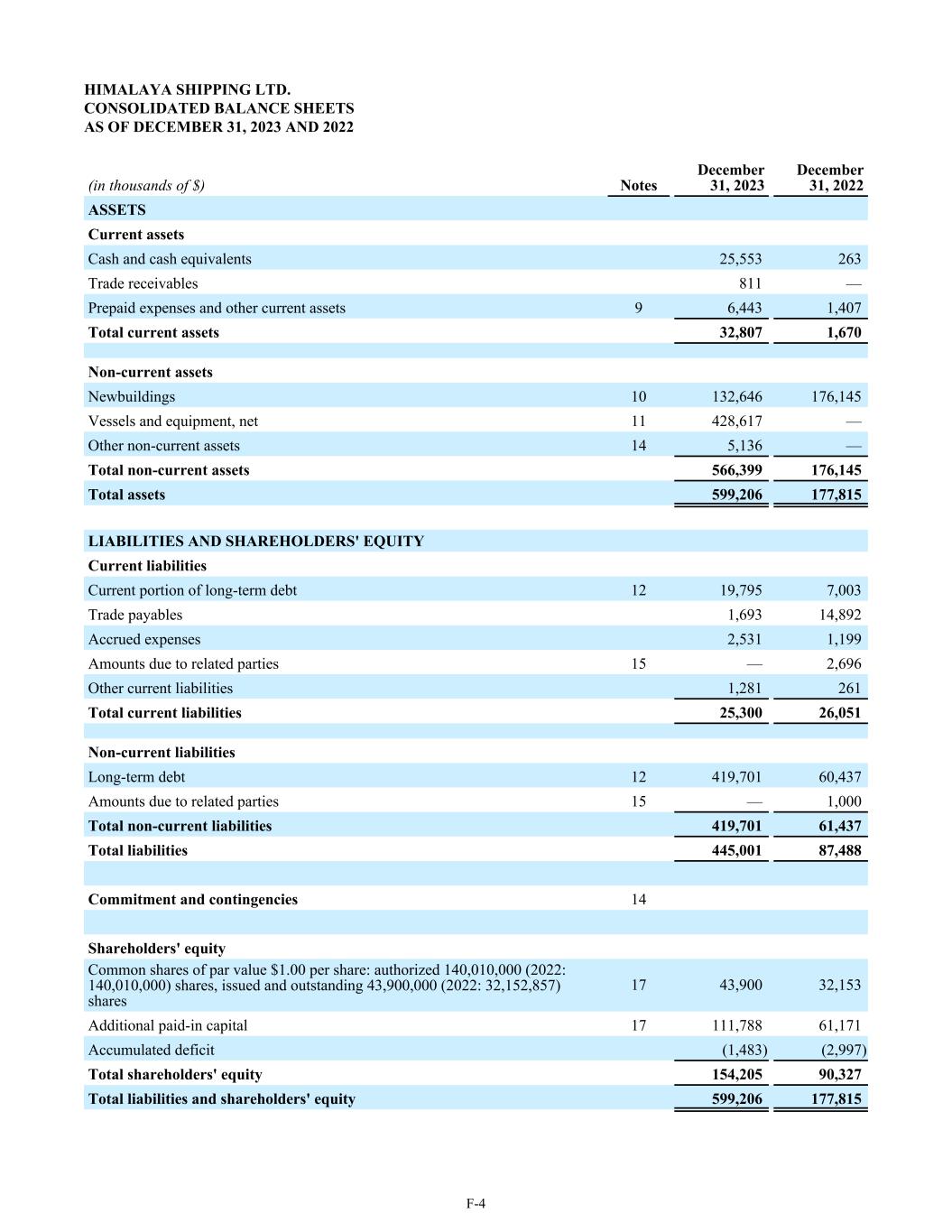
HIMALAYA SHIPPING LTD. CONSOLIDATED BALANCE SHEETS AS OF DECEMBER 31, 2023 AND 2022 (in thousands of $) Notes December 31, 2023 December 31, 2022 ASSETS Current assets Cash and cash equivalents 25,553 263 Trade receivables 811 — Prepaid expenses and other current assets 9 6,443 1,407 Total current assets 32,807 1,670 Non-current assets Newbuildings 10 132,646 176,145 Vessels and equipment, net 11 428,617 — Other non-current assets 14 5,136 — Total non-current assets 566,399 176,145 Total assets 599,206 177,815 LIABILITIES AND SHAREHOLDERS' EQUITY Current liabilities Current portion of long-term debt 12 19,795 7,003 Trade payables 1,693 14,892 Accrued expenses 2,531 1,199 Amounts due to related parties 15 — 2,696 Other current liabilities 1,281 261 Total current liabilities 25,300 26,051 Non-current liabilities Long-term debt 12 419,701 60,437 Amounts due to related parties 15 — 1,000 Total non-current liabilities 419,701 61,437 Total liabilities 445,001 87,488 Commitment and contingencies 14 Shareholders' equity Common shares of par value $1.00 per share: authorized 140,010,000 (2022: 140,010,000) shares, issued and outstanding 43,900,000 (2022: 32,152,857) shares 17 43,900 32,153 Additional paid-in capital 17 111,788 61,171 Accumulated deficit (1,483) (2,997) Total shareholders' equity 154,205 90,327 Total liabilities and shareholders' equity 599,206 177,815 F-4
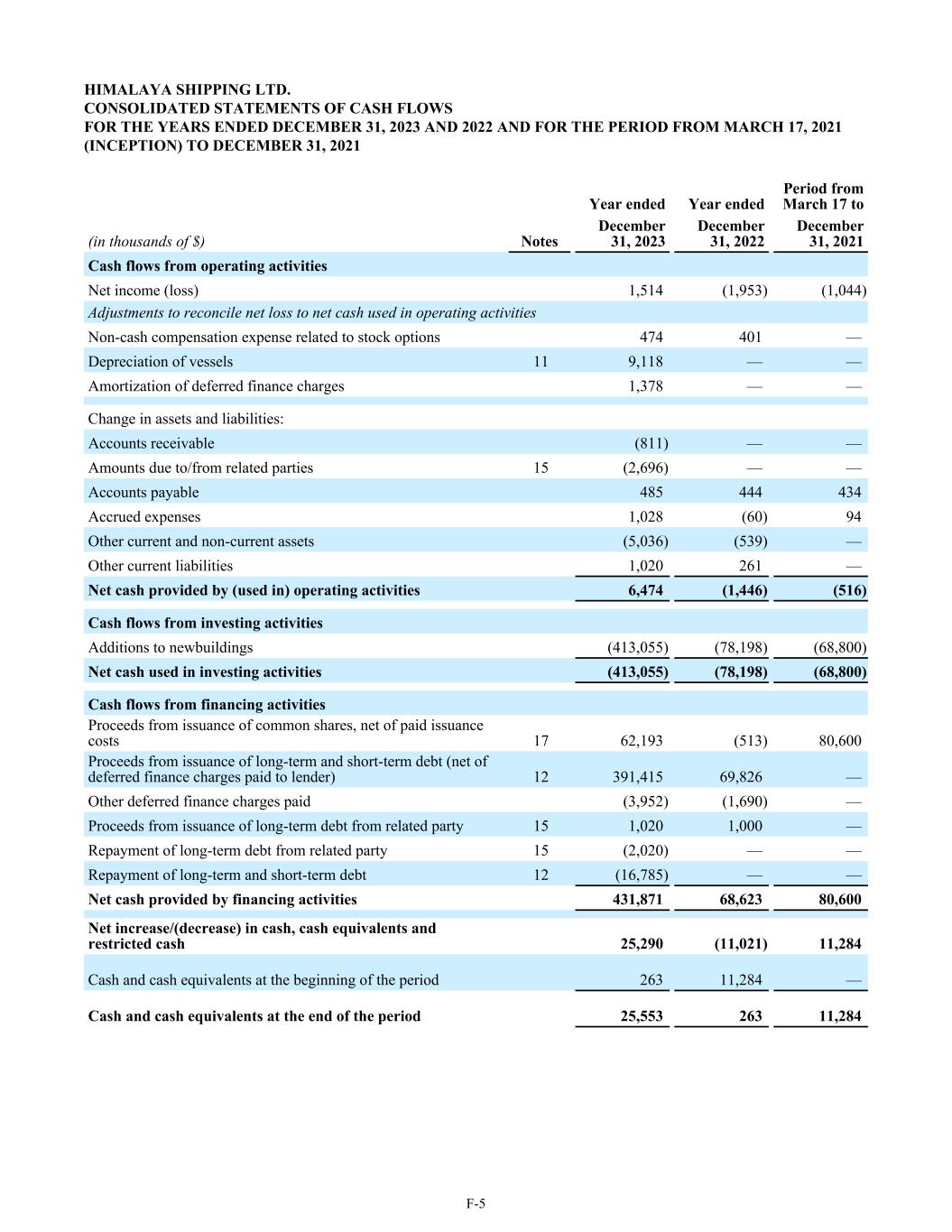
HIMALAYA SHIPPING LTD. CONSOLIDATED STATEMENTS OF CASH FLOWS FOR THE YEARS ENDED DECEMBER 31, 2023 AND 2022 AND FOR THE PERIOD FROM MARCH 17, 2021 (INCEPTION) TO DECEMBER 31, 2021 Year ended Year ended Period from March 17 to (in thousands of $) Notes December 31, 2023 December 31, 2022 December 31, 2021 Cash flows from operating activities Net income (loss) 1,514 (1,953) (1,044) Adjustments to reconcile net loss to net cash used in operating activities Non-cash compensation expense related to stock options 474 401 — Depreciation of vessels 11 9,118 — — Amortization of deferred finance charges 1,378 — — Change in assets and liabilities: Accounts receivable (811) — — Amounts due to/from related parties 15 (2,696) — — Accounts payable 485 444 434 Accrued expenses 1,028 (60) 94 Other current and non-current assets (5,036) (539) — Other current liabilities 1,020 261 — Net cash provided by (used in) operating activities 6,474 (1,446) (516) Cash flows from investing activities Additions to newbuildings (413,055) (78,198) (68,800) Net cash used in investing activities (413,055) (78,198) (68,800) Cash flows from financing activities Proceeds from issuance of common shares, net of paid issuance costs 17 62,193 (513) 80,600 Proceeds from issuance of long-term and short-term debt (net of deferred finance charges paid to lender) 12 391,415 69,826 — Other deferred finance charges paid (3,952) (1,690) — Proceeds from issuance of long-term debt from related party 15 1,020 1,000 — Repayment of long-term debt from related party 15 (2,020) — — Repayment of long-term and short-term debt 12 (16,785) — — Net cash provided by financing activities 431,871 68,623 80,600 Net increase/(decrease) in cash, cash equivalents and restricted cash 25,290 (11,021) 11,284 Cash and cash equivalents at the beginning of the period 263 11,284 — Cash and cash equivalents at the end of the period 25,553 263 11,284 F-5
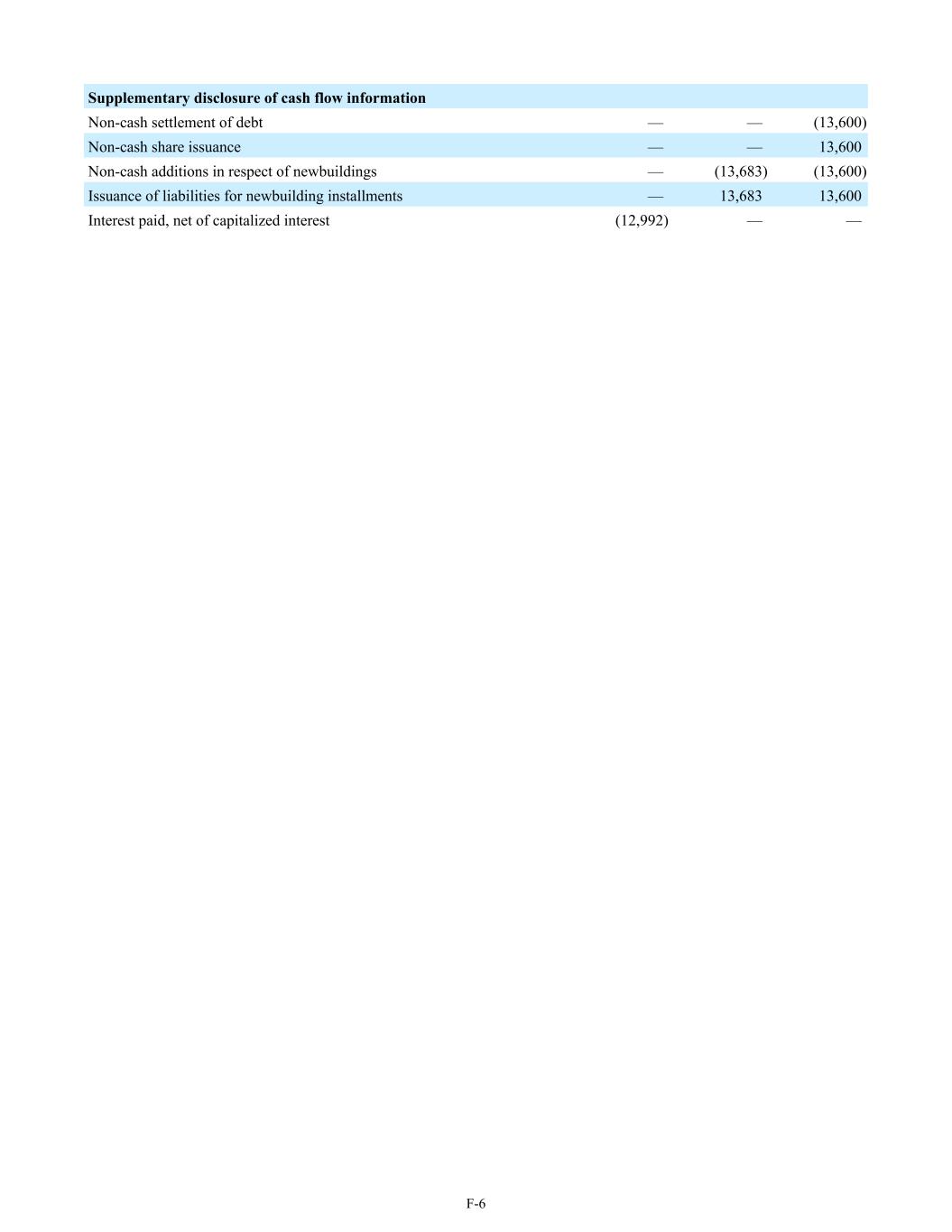
Supplementary disclosure of cash flow information Non-cash settlement of debt — — (13,600) Non-cash share issuance — — 13,600 Non-cash additions in respect of newbuildings — (13,683) (13,600) Issuance of liabilities for newbuilding installments — 13,683 13,600 Interest paid, net of capitalized interest (12,992) — — F-6
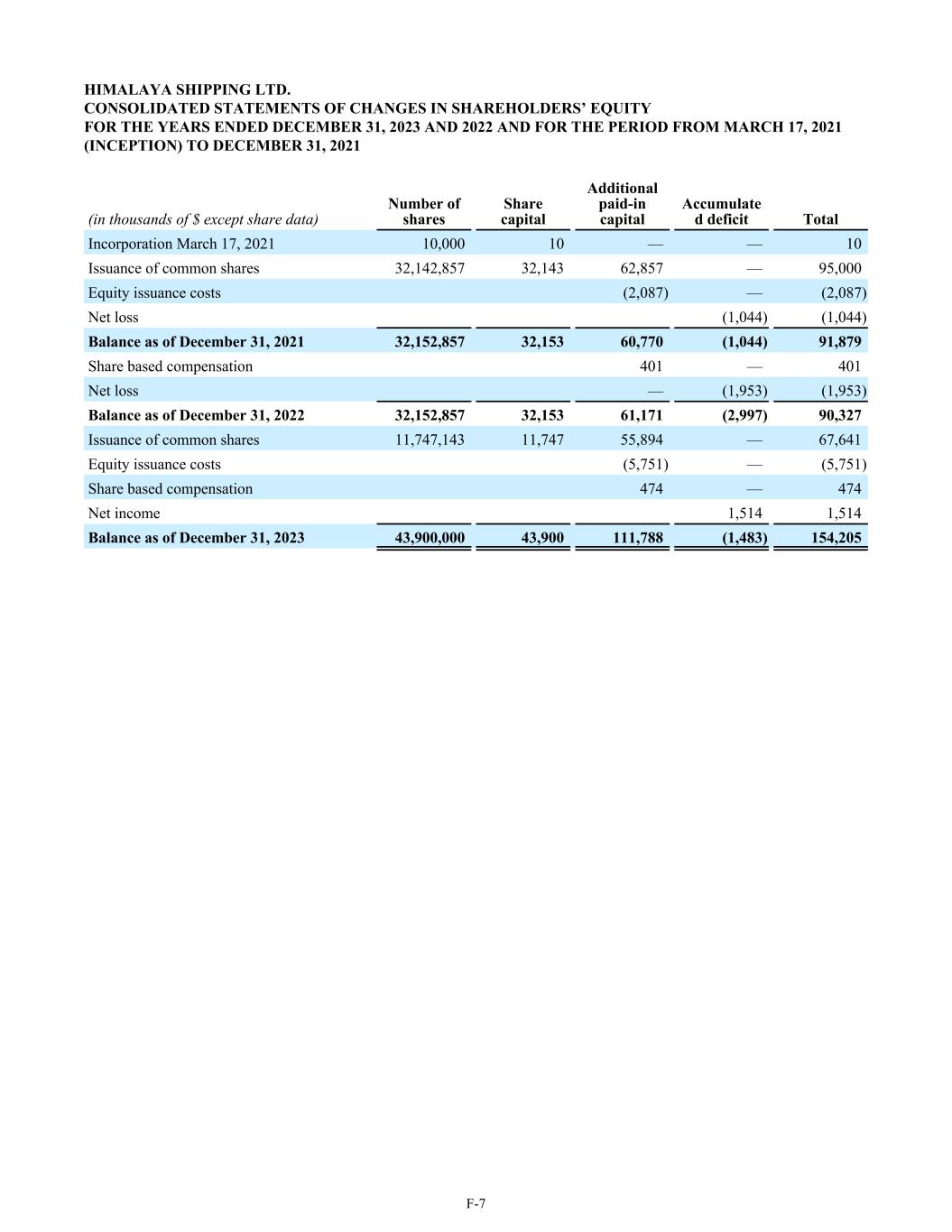
HIMALAYA SHIPPING LTD. CONSOLIDATED STATEMENTS OF CHANGES IN SHAREHOLDERS’ EQUITY FOR THE YEARS ENDED DECEMBER 31, 2023 AND 2022 AND FOR THE PERIOD FROM MARCH 17, 2021 (INCEPTION) TO DECEMBER 31, 2021 (in thousands of $ except share data) Number of shares Share capital Additional paid-in capital Accumulate d deficit Total Incorporation March 17, 2021 10,000 10 — — 10 Issuance of common shares 32,142,857 32,143 62,857 — 95,000 Equity issuance costs (2,087) — (2,087) Net loss (1,044) (1,044) Balance as of December 31, 2021 32,152,857 32,153 60,770 (1,044) 91,879 Share based compensation 401 — 401 Net loss — (1,953) (1,953) Balance as of December 31, 2022 32,152,857 32,153 61,171 (2,997) 90,327 Issuance of common shares 11,747,143 11,747 55,894 — 67,641 Equity issuance costs (5,751) — (5,751) Share based compensation 474 — 474 Net income 1,514 1,514 Balance as of December 31, 2023 43,900,000 43,900 111,788 (1,483) 154,205 F-7
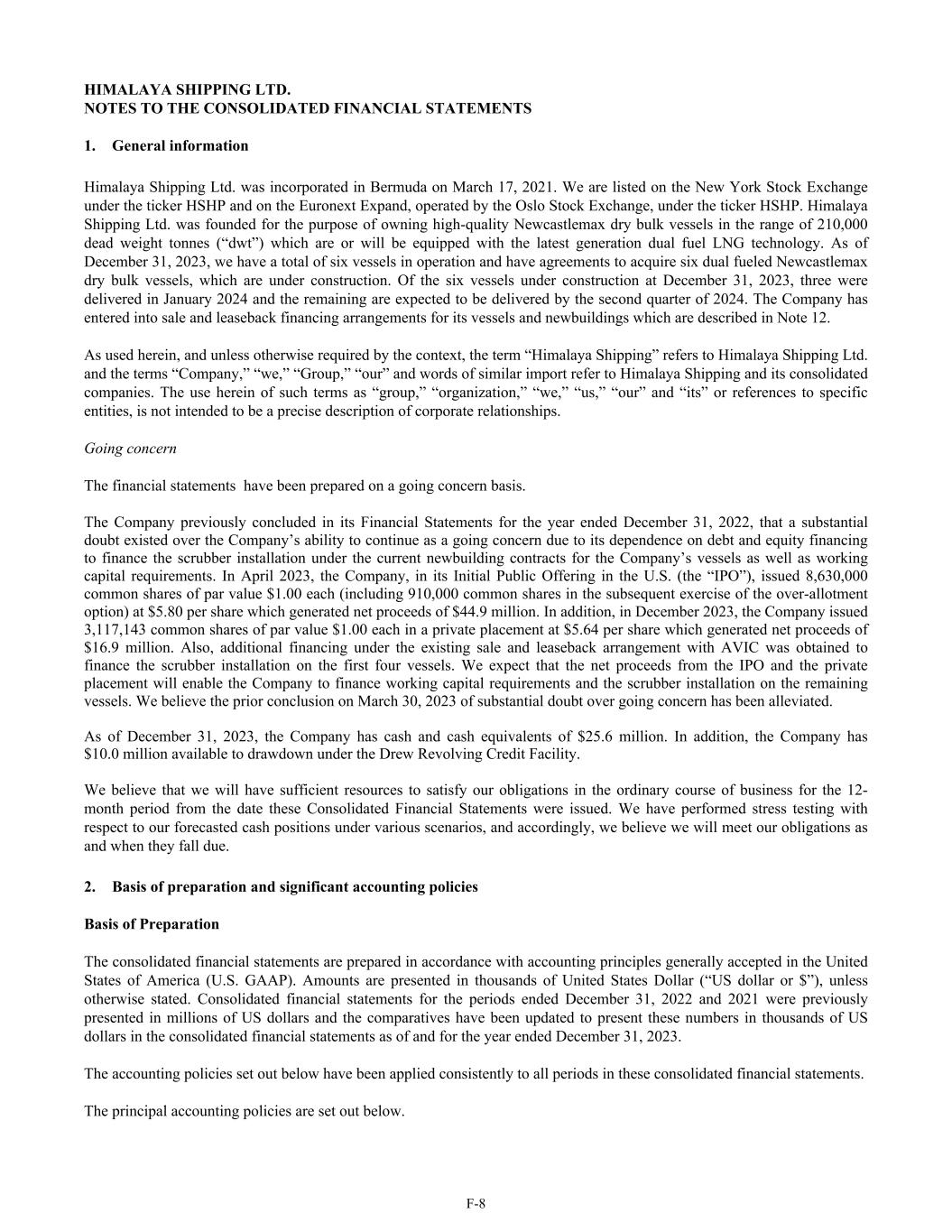
HIMALAYA SHIPPING LTD. NOTES TO THE CONSOLIDATED FINANCIAL STATEMENTS 1. General information Himalaya Shipping Ltd. was incorporated in Bermuda on March 17, 2021. We are listed on the New York Stock Exchange under the ticker HSHP and on the Euronext Expand, operated by the Oslo Stock Exchange, under the ticker HSHP. Himalaya Shipping Ltd. was founded for the purpose of owning high-quality Newcastlemax dry bulk vessels in the range of 210,000 dead weight tonnes (“dwt”) which are or will be equipped with the latest generation dual fuel LNG technology. As of December 31, 2023, we have a total of six vessels in operation and have agreements to acquire six dual fueled Newcastlemax dry bulk vessels, which are under construction. Of the six vessels under construction at December 31, 2023, three were delivered in January 2024 and the remaining are expected to be delivered by the second quarter of 2024. The Company has entered into sale and leaseback financing arrangements for its vessels and newbuildings which are described in Note 12. As used herein, and unless otherwise required by the context, the term “Himalaya Shipping” refers to Himalaya Shipping Ltd. and the terms “Company,” “we,” “Group,” “our” and words of similar import refer to Himalaya Shipping and its consolidated companies. The use herein of such terms as “group,” “organization,” “we,” “us,” “our” and “its” or references to specific entities, is not intended to be a precise description of corporate relationships. Going concern The financial statements have been prepared on a going concern basis. The Company previously concluded in its Financial Statements for the year ended December 31, 2022, that a substantial doubt existed over the Company’s ability to continue as a going concern due to its dependence on debt and equity financing to finance the scrubber installation under the current newbuilding contracts for the Company’s vessels as well as working capital requirements. In April 2023, the Company, in its Initial Public Offering in the U.S. (the “IPO”), issued 8,630,000 common shares of par value $1.00 each (including 910,000 common shares in the subsequent exercise of the over-allotment option) at $5.80 per share which generated net proceeds of $44.9 million. In addition, in December 2023, the Company issued 3,117,143 common shares of par value $1.00 each in a private placement at $5.64 per share which generated net proceeds of $16.9 million. Also, additional financing under the existing sale and leaseback arrangement with AVIC was obtained to finance the scrubber installation on the first four vessels. We expect that the net proceeds from the IPO and the private placement will enable the Company to finance working capital requirements and the scrubber installation on the remaining vessels. We believe the prior conclusion on March 30, 2023 of substantial doubt over going concern has been alleviated. As of December 31, 2023, the Company has cash and cash equivalents of $25.6 million. In addition, the Company has $10.0 million available to drawdown under the Drew Revolving Credit Facility. We believe that we will have sufficient resources to satisfy our obligations in the ordinary course of business for the 12- month period from the date these Consolidated Financial Statements were issued. We have performed stress testing with respect to our forecasted cash positions under various scenarios, and accordingly, we believe we will meet our obligations as and when they fall due. 2. Basis of preparation and significant accounting policies Basis of Preparation The consolidated financial statements are prepared in accordance with accounting principles generally accepted in the United States of America (U.S. GAAP). Amounts are presented in thousands of United States Dollar (“US dollar or $”), unless otherwise stated. Consolidated financial statements for the periods ended December 31, 2022 and 2021 were previously presented in millions of US dollars and the comparatives have been updated to present these numbers in thousands of US dollars in the consolidated financial statements as of and for the year ended December 31, 2023. The accounting policies set out below have been applied consistently to all periods in these consolidated financial statements. The principal accounting policies are set out below. F-8
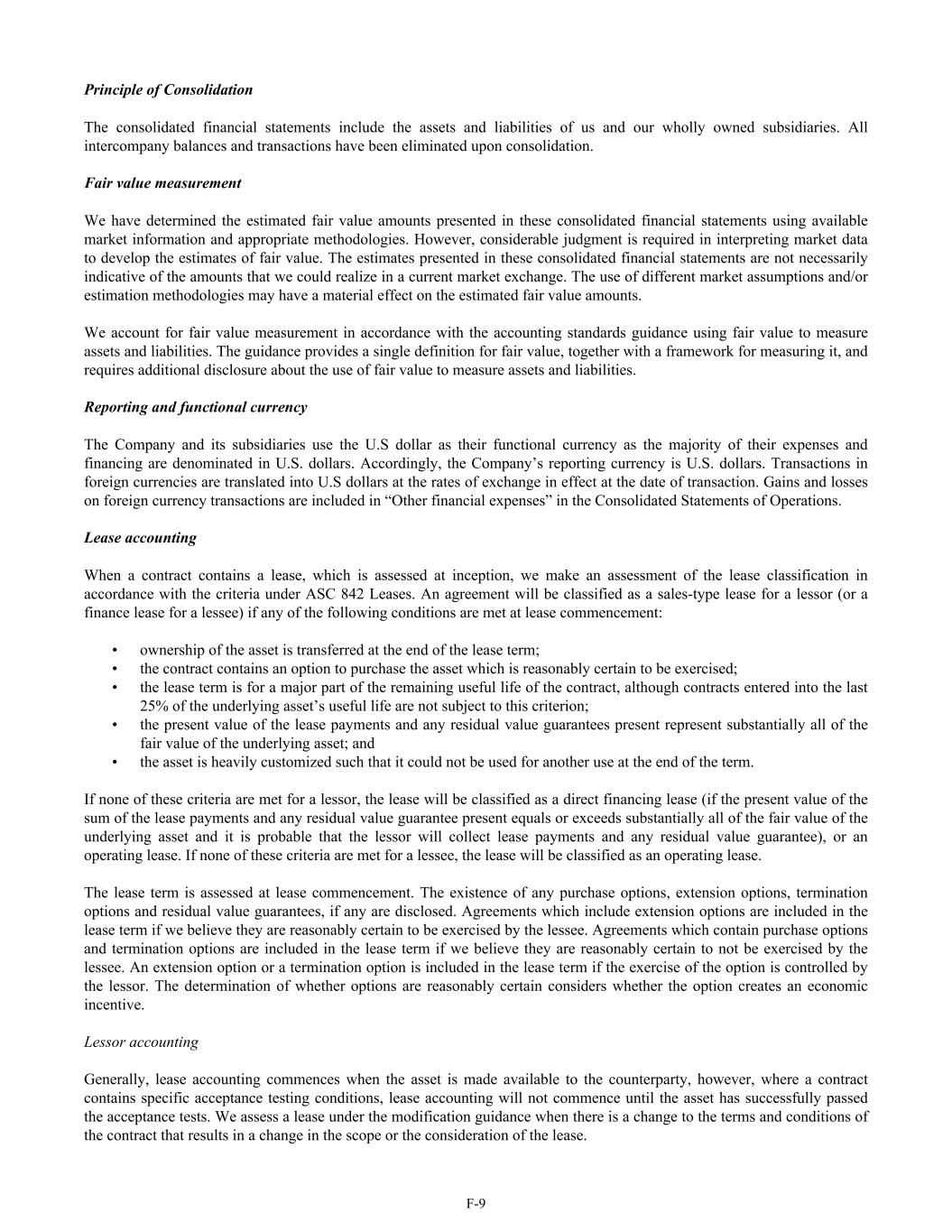
Principle of Consolidation The consolidated financial statements include the assets and liabilities of us and our wholly owned subsidiaries. All intercompany balances and transactions have been eliminated upon consolidation. Fair value measurement We have determined the estimated fair value amounts presented in these consolidated financial statements using available market information and appropriate methodologies. However, considerable judgment is required in interpreting market data to develop the estimates of fair value. The estimates presented in these consolidated financial statements are not necessarily indicative of the amounts that we could realize in a current market exchange. The use of different market assumptions and/or estimation methodologies may have a material effect on the estimated fair value amounts. We account for fair value measurement in accordance with the accounting standards guidance using fair value to measure assets and liabilities. The guidance provides a single definition for fair value, together with a framework for measuring it, and requires additional disclosure about the use of fair value to measure assets and liabilities. Reporting and functional currency The Company and its subsidiaries use the U.S dollar as their functional currency as the majority of their expenses and financing are denominated in U.S. dollars. Accordingly, the Company’s reporting currency is U.S. dollars. Transactions in foreign currencies are translated into U.S dollars at the rates of exchange in effect at the date of transaction. Gains and losses on foreign currency transactions are included in “Other financial expenses” in the Consolidated Statements of Operations. Lease accounting When a contract contains a lease, which is assessed at inception, we make an assessment of the lease classification in accordance with the criteria under ASC 842 Leases. An agreement will be classified as a sales-type lease for a lessor (or a finance lease for a lessee) if any of the following conditions are met at lease commencement: • ownership of the asset is transferred at the end of the lease term; • the contract contains an option to purchase the asset which is reasonably certain to be exercised; • the lease term is for a major part of the remaining useful life of the contract, although contracts entered into the last 25% of the underlying asset’s useful life are not subject to this criterion; • the present value of the lease payments and any residual value guarantees present represent substantially all of the fair value of the underlying asset; and • the asset is heavily customized such that it could not be used for another use at the end of the term. If none of these criteria are met for a lessor, the lease will be classified as a direct financing lease (if the present value of the sum of the lease payments and any residual value guarantee present equals or exceeds substantially all of the fair value of the underlying asset and it is probable that the lessor will collect lease payments and any residual value guarantee), or an operating lease. If none of these criteria are met for a lessee, the lease will be classified as an operating lease. The lease term is assessed at lease commencement. The existence of any purchase options, extension options, termination options and residual value guarantees, if any are disclosed. Agreements which include extension options are included in the lease term if we believe they are reasonably certain to be exercised by the lessee. Agreements which contain purchase options and termination options are included in the lease term if we believe they are reasonably certain to not be exercised by the lessee. An extension option or a termination option is included in the lease term if the exercise of the option is controlled by the lessor. The determination of whether options are reasonably certain considers whether the option creates an economic incentive. Lessor accounting Generally, lease accounting commences when the asset is made available to the counterparty, however, where a contract contains specific acceptance testing conditions, lease accounting will not commence until the asset has successfully passed the acceptance tests. We assess a lease under the modification guidance when there is a change to the terms and conditions of the contract that results in a change in the scope or the consideration of the lease. F-9
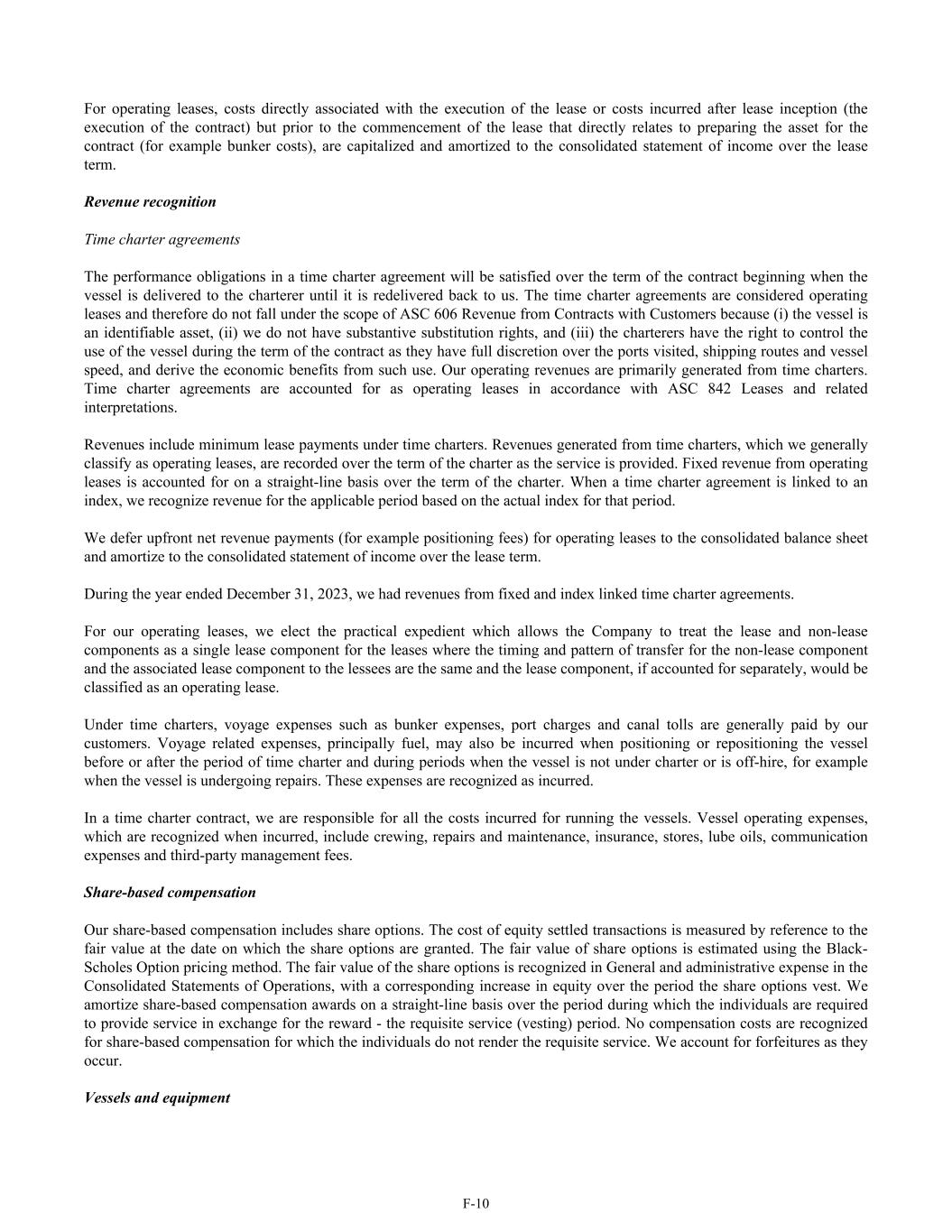
For operating leases, costs directly associated with the execution of the lease or costs incurred after lease inception (the execution of the contract) but prior to the commencement of the lease that directly relates to preparing the asset for the contract (for example bunker costs), are capitalized and amortized to the consolidated statement of income over the lease term. Revenue recognition Time charter agreements The performance obligations in a time charter agreement will be satisfied over the term of the contract beginning when the vessel is delivered to the charterer until it is redelivered back to us. The time charter agreements are considered operating leases and therefore do not fall under the scope of ASC 606 Revenue from Contracts with Customers because (i) the vessel is an identifiable asset, (ii) we do not have substantive substitution rights, and (iii) the charterers have the right to control the use of the vessel during the term of the contract as they have full discretion over the ports visited, shipping routes and vessel speed, and derive the economic benefits from such use. Our operating revenues are primarily generated from time charters. Time charter agreements are accounted for as operating leases in accordance with ASC 842 Leases and related interpretations. Revenues include minimum lease payments under time charters. Revenues generated from time charters, which we generally classify as operating leases, are recorded over the term of the charter as the service is provided. Fixed revenue from operating leases is accounted for on a straight-line basis over the term of the charter. When a time charter agreement is linked to an index, we recognize revenue for the applicable period based on the actual index for that period. We defer upfront net revenue payments (for example positioning fees) for operating leases to the consolidated balance sheet and amortize to the consolidated statement of income over the lease term. During the year ended December 31, 2023, we had revenues from fixed and index linked time charter agreements. For our operating leases, we elect the practical expedient which allows the Company to treat the lease and non-lease components as a single lease component for the leases where the timing and pattern of transfer for the non-lease component and the associated lease component to the lessees are the same and the lease component, if accounted for separately, would be classified as an operating lease. Under time charters, voyage expenses such as bunker expenses, port charges and canal tolls are generally paid by our customers. Voyage related expenses, principally fuel, may also be incurred when positioning or repositioning the vessel before or after the period of time charter and during periods when the vessel is not under charter or is off-hire, for example when the vessel is undergoing repairs. These expenses are recognized as incurred. In a time charter contract, we are responsible for all the costs incurred for running the vessels. Vessel operating expenses, which are recognized when incurred, include crewing, repairs and maintenance, insurance, stores, lube oils, communication expenses and third-party management fees. Share-based compensation Our share-based compensation includes share options. The cost of equity settled transactions is measured by reference to the fair value at the date on which the share options are granted. The fair value of share options is estimated using the Black- Scholes Option pricing method. The fair value of the share options is recognized in General and administrative expense in the Consolidated Statements of Operations, with a corresponding increase in equity over the period the share options vest. We amortize share-based compensation awards on a straight-line basis over the period during which the individuals are required to provide service in exchange for the reward - the requisite service (vesting) period. No compensation costs are recognized for share-based compensation for which the individuals do not render the requisite service. We account for forfeitures as they occur. Vessels and equipment F-10
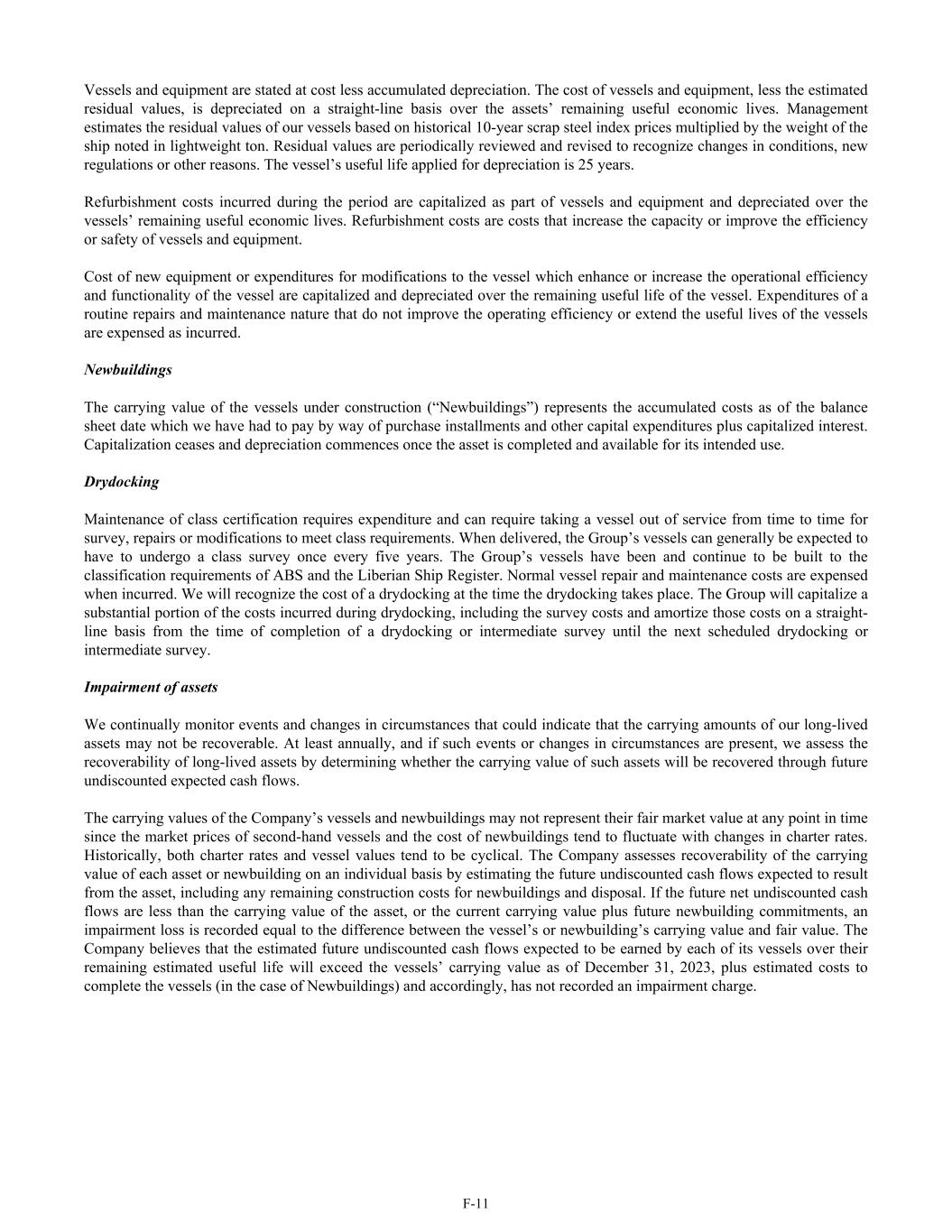
Vessels and equipment are stated at cost less accumulated depreciation. The cost of vessels and equipment, less the estimated residual values, is depreciated on a straight-line basis over the assets’ remaining useful economic lives. Management estimates the residual values of our vessels based on historical 10-year scrap steel index prices multiplied by the weight of the ship noted in lightweight ton. Residual values are periodically reviewed and revised to recognize changes in conditions, new regulations or other reasons. The vessel’s useful life applied for depreciation is 25 years. Refurbishment costs incurred during the period are capitalized as part of vessels and equipment and depreciated over the vessels’ remaining useful economic lives. Refurbishment costs are costs that increase the capacity or improve the efficiency or safety of vessels and equipment. Cost of new equipment or expenditures for modifications to the vessel which enhance or increase the operational efficiency and functionality of the vessel are capitalized and depreciated over the remaining useful life of the vessel. Expenditures of a routine repairs and maintenance nature that do not improve the operating efficiency or extend the useful lives of the vessels are expensed as incurred. Newbuildings The carrying value of the vessels under construction (“Newbuildings”) represents the accumulated costs as of the balance sheet date which we have had to pay by way of purchase installments and other capital expenditures plus capitalized interest. Capitalization ceases and depreciation commences once the asset is completed and available for its intended use. Drydocking Maintenance of class certification requires expenditure and can require taking a vessel out of service from time to time for survey, repairs or modifications to meet class requirements. When delivered, the Group’s vessels can generally be expected to have to undergo a class survey once every five years. The Group’s vessels have been and continue to be built to the classification requirements of ABS and the Liberian Ship Register. Normal vessel repair and maintenance costs are expensed when incurred. We will recognize the cost of a drydocking at the time the drydocking takes place. The Group will capitalize a substantial portion of the costs incurred during drydocking, including the survey costs and amortize those costs on a straight- line basis from the time of completion of a drydocking or intermediate survey until the next scheduled drydocking or intermediate survey. Impairment of assets We continually monitor events and changes in circumstances that could indicate that the carrying amounts of our long-lived assets may not be recoverable. At least annually, and if such events or changes in circumstances are present, we assess the recoverability of long-lived assets by determining whether the carrying value of such assets will be recovered through future undiscounted expected cash flows. The carrying values of the Company’s vessels and newbuildings may not represent their fair market value at any point in time since the market prices of second-hand vessels and the cost of newbuildings tend to fluctuate with changes in charter rates. Historically, both charter rates and vessel values tend to be cyclical. The Company assesses recoverability of the carrying value of each asset or newbuilding on an individual basis by estimating the future undiscounted cash flows expected to result from the asset, including any remaining construction costs for newbuildings and disposal. If the future net undiscounted cash flows are less than the carrying value of the asset, or the current carrying value plus future newbuilding commitments, an impairment loss is recorded equal to the difference between the vessel’s or newbuilding’s carrying value and fair value. The Company believes that the estimated future undiscounted cash flows expected to be earned by each of its vessels over their remaining estimated useful life will exceed the vessels’ carrying value as of December 31, 2023, plus estimated costs to complete the vessels (in the case of Newbuildings) and accordingly, has not recorded an impairment charge. F-11
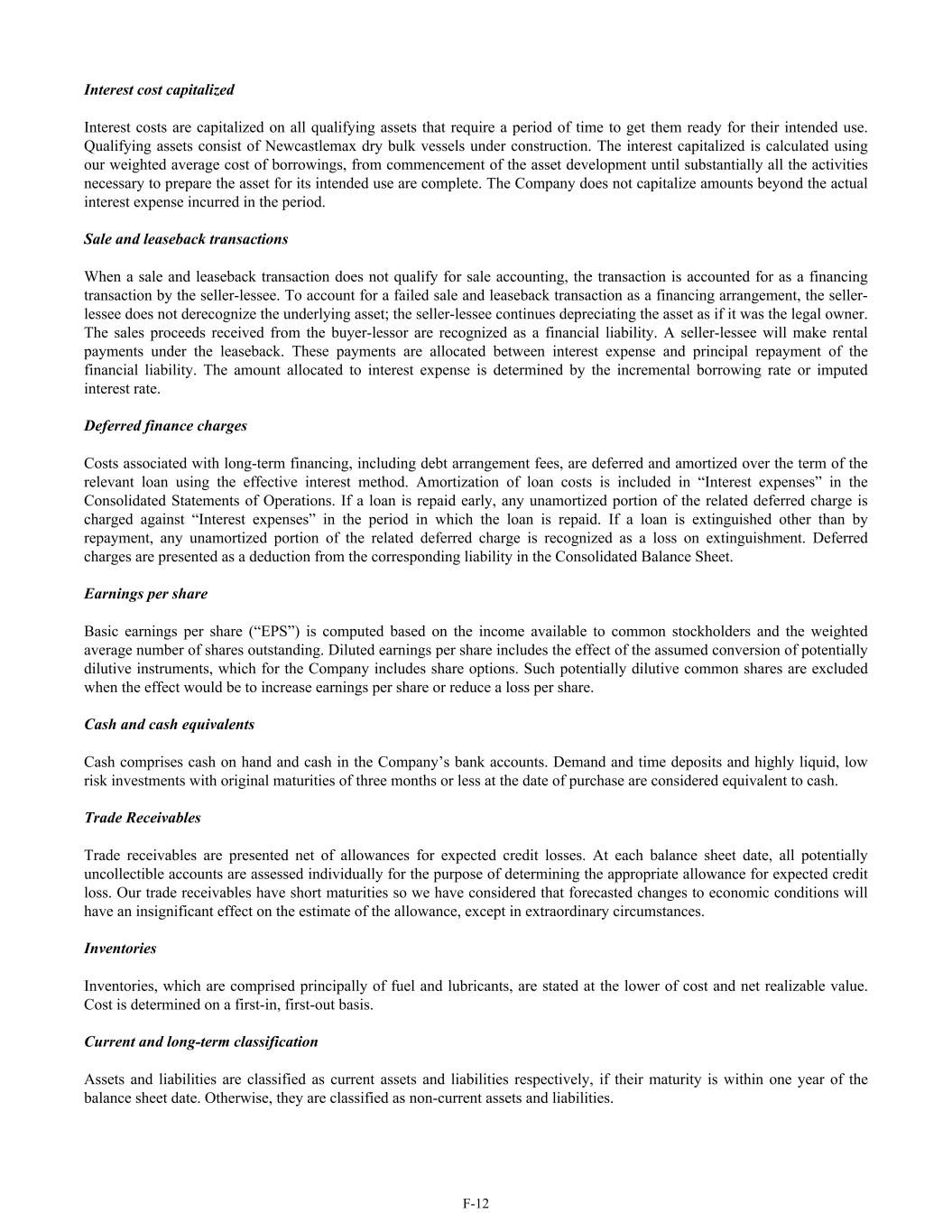
Interest cost capitalized Interest costs are capitalized on all qualifying assets that require a period of time to get them ready for their intended use. Qualifying assets consist of Newcastlemax dry bulk vessels under construction. The interest capitalized is calculated using our weighted average cost of borrowings, from commencement of the asset development until substantially all the activities necessary to prepare the asset for its intended use are complete. The Company does not capitalize amounts beyond the actual interest expense incurred in the period. Sale and leaseback transactions When a sale and leaseback transaction does not qualify for sale accounting, the transaction is accounted for as a financing transaction by the seller-lessee. To account for a failed sale and leaseback transaction as a financing arrangement, the seller- lessee does not derecognize the underlying asset; the seller-lessee continues depreciating the asset as if it was the legal owner. The sales proceeds received from the buyer-lessor are recognized as a financial liability. A seller-lessee will make rental payments under the leaseback. These payments are allocated between interest expense and principal repayment of the financial liability. The amount allocated to interest expense is determined by the incremental borrowing rate or imputed interest rate. Deferred finance charges Costs associated with long-term financing, including debt arrangement fees, are deferred and amortized over the term of the relevant loan using the effective interest method. Amortization of loan costs is included in “Interest expenses” in the Consolidated Statements of Operations. If a loan is repaid early, any unamortized portion of the related deferred charge is charged against “Interest expenses” in the period in which the loan is repaid. If a loan is extinguished other than by repayment, any unamortized portion of the related deferred charge is recognized as a loss on extinguishment. Deferred charges are presented as a deduction from the corresponding liability in the Consolidated Balance Sheet. Earnings per share Basic earnings per share (“EPS”) is computed based on the income available to common stockholders and the weighted average number of shares outstanding. Diluted earnings per share includes the effect of the assumed conversion of potentially dilutive instruments, which for the Company includes share options. Such potentially dilutive common shares are excluded when the effect would be to increase earnings per share or reduce a loss per share. Cash and cash equivalents Cash comprises cash on hand and cash in the Company’s bank accounts. Demand and time deposits and highly liquid, low risk investments with original maturities of three months or less at the date of purchase are considered equivalent to cash. Trade Receivables Trade receivables are presented net of allowances for expected credit losses. At each balance sheet date, all potentially uncollectible accounts are assessed individually for the purpose of determining the appropriate allowance for expected credit loss. Our trade receivables have short maturities so we have considered that forecasted changes to economic conditions will have an insignificant effect on the estimate of the allowance, except in extraordinary circumstances. Inventories Inventories, which are comprised principally of fuel and lubricants, are stated at the lower of cost and net realizable value. Cost is determined on a first-in, first-out basis. Current and long-term classification Assets and liabilities are classified as current assets and liabilities respectively, if their maturity is within one year of the balance sheet date. Otherwise, they are classified as non-current assets and liabilities. F-12
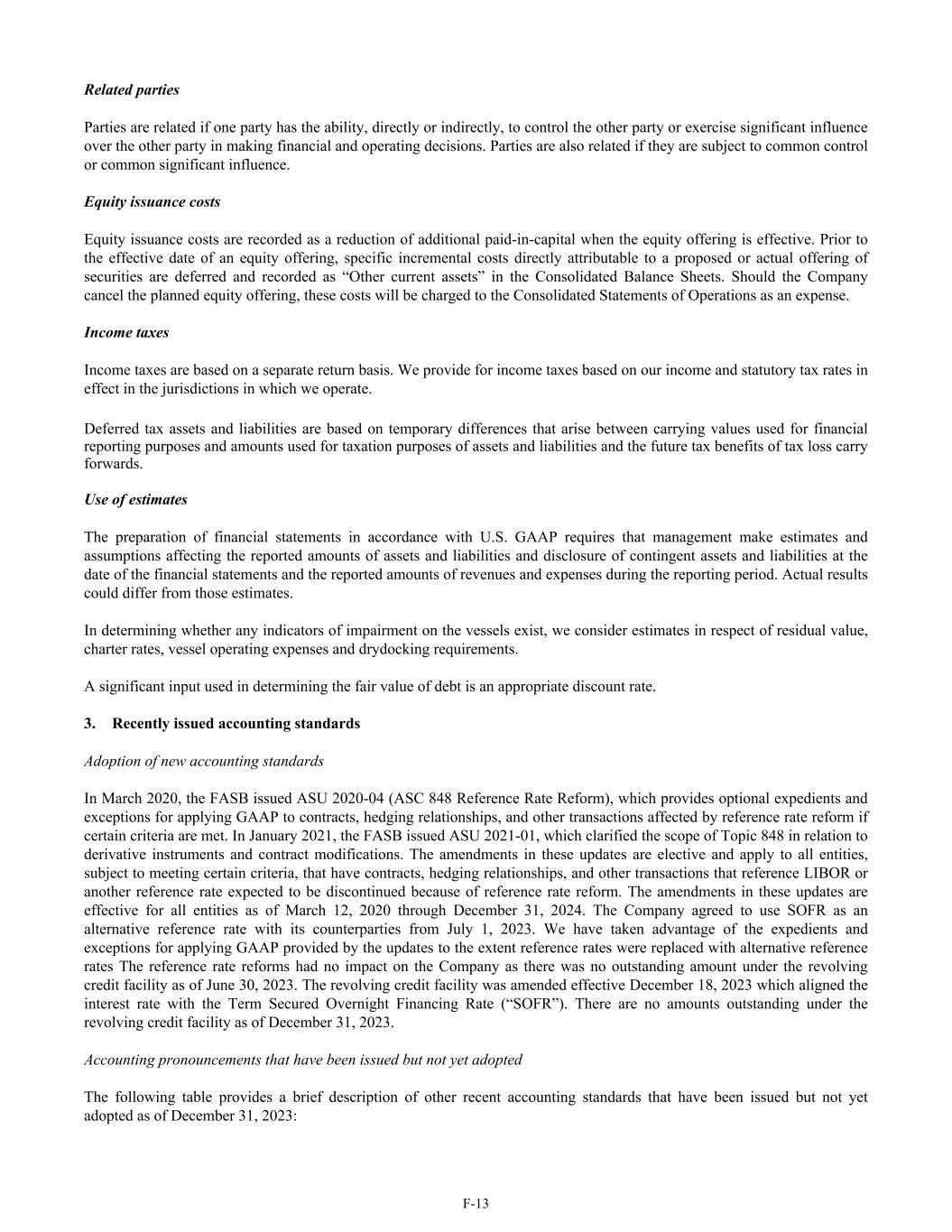
Related parties Parties are related if one party has the ability, directly or indirectly, to control the other party or exercise significant influence over the other party in making financial and operating decisions. Parties are also related if they are subject to common control or common significant influence. Equity issuance costs Equity issuance costs are recorded as a reduction of additional paid-in-capital when the equity offering is effective. Prior to the effective date of an equity offering, specific incremental costs directly attributable to a proposed or actual offering of securities are deferred and recorded as “Other current assets” in the Consolidated Balance Sheets. Should the Company cancel the planned equity offering, these costs will be charged to the Consolidated Statements of Operations as an expense. Income taxes Income taxes are based on a separate return basis. We provide for income taxes based on our income and statutory tax rates in effect in the jurisdictions in which we operate. Deferred tax assets and liabilities are based on temporary differences that arise between carrying values used for financial reporting purposes and amounts used for taxation purposes of assets and liabilities and the future tax benefits of tax loss carry forwards. Use of estimates The preparation of financial statements in accordance with U.S. GAAP requires that management make estimates and assumptions affecting the reported amounts of assets and liabilities and disclosure of contingent assets and liabilities at the date of the financial statements and the reported amounts of revenues and expenses during the reporting period. Actual results could differ from those estimates. In determining whether any indicators of impairment on the vessels exist, we consider estimates in respect of residual value, charter rates, vessel operating expenses and drydocking requirements. A significant input used in determining the fair value of debt is an appropriate discount rate. 3. Recently issued accounting standards Adoption of new accounting standards In March 2020, the FASB issued ASU 2020-04 (ASC 848 Reference Rate Reform), which provides optional expedients and exceptions for applying GAAP to contracts, hedging relationships, and other transactions affected by reference rate reform if certain criteria are met. In January 2021, the FASB issued ASU 2021-01, which clarified the scope of Topic 848 in relation to derivative instruments and contract modifications. The amendments in these updates are elective and apply to all entities, subject to meeting certain criteria, that have contracts, hedging relationships, and other transactions that reference LIBOR or another reference rate expected to be discontinued because of reference rate reform. The amendments in these updates are effective for all entities as of March 12, 2020 through December 31, 2024. The Company agreed to use SOFR as an alternative reference rate with its counterparties from July 1, 2023. We have taken advantage of the expedients and exceptions for applying GAAP provided by the updates to the extent reference rates were replaced with alternative reference rates The reference rate reforms had no impact on the Company as there was no outstanding amount under the revolving credit facility as of June 30, 2023. The revolving credit facility was amended effective December 18, 2023 which aligned the interest rate with the Term Secured Overnight Financing Rate (“SOFR”). There are no amounts outstanding under the revolving credit facility as of December 31, 2023. Accounting pronouncements that have been issued but not yet adopted The following table provides a brief description of other recent accounting standards that have been issued but not yet adopted as of December 31, 2023: F-13
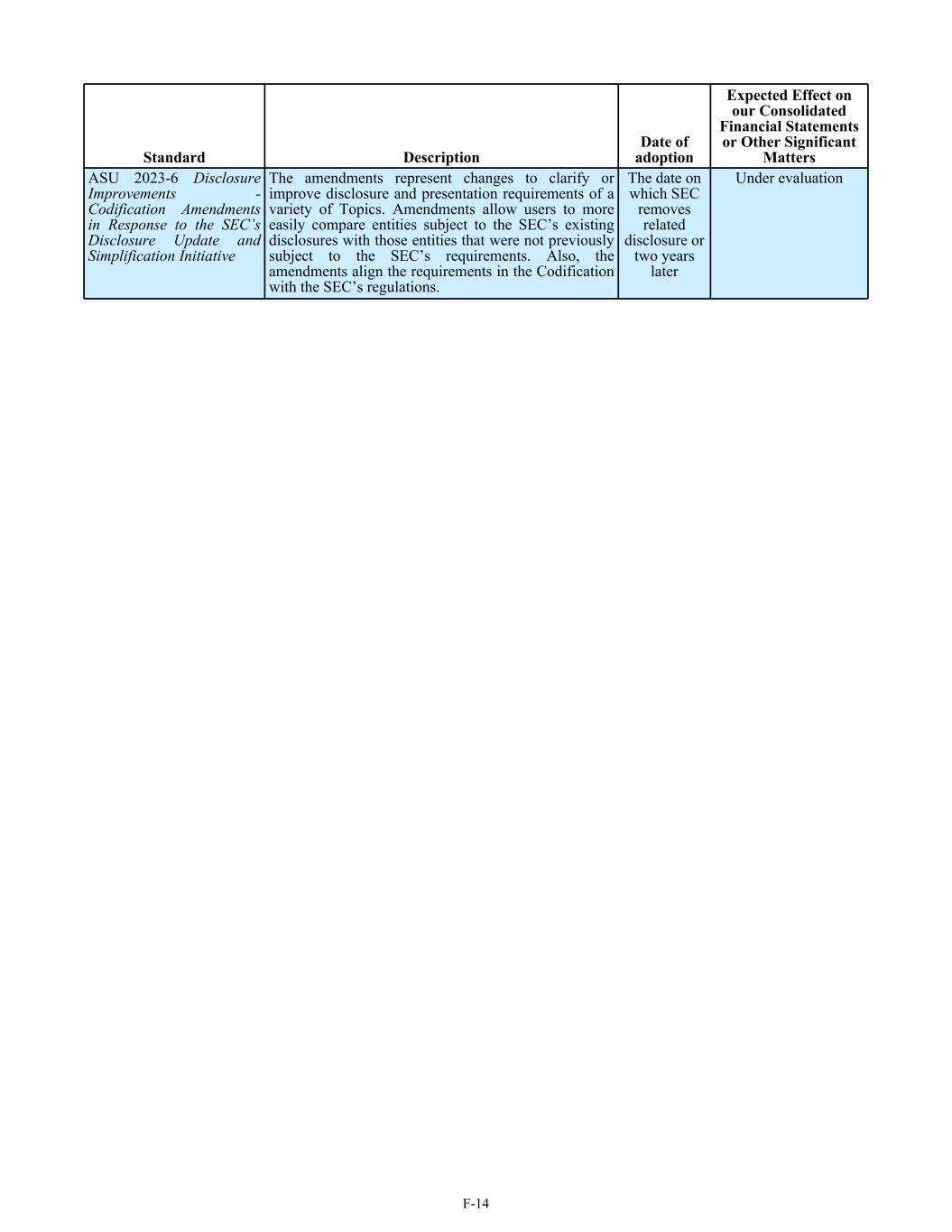
Standard Description Date of adoption Expected Effect on our Consolidated Financial Statements or Other Significant Matters ASU 2023-6 Disclosure Improvements - Codification Amendments in Response to the SEC’s Disclosure Update and Simplification Initiative The amendments represent changes to clarify or improve disclosure and presentation requirements of a variety of Topics. Amendments allow users to more easily compare entities subject to the SEC’s existing disclosures with those entities that were not previously subject to the SEC’s requirements. Also, the amendments align the requirements in the Codification with the SEC’s regulations. The date on which SEC removes related disclosure or two years later Under evaluation F-14
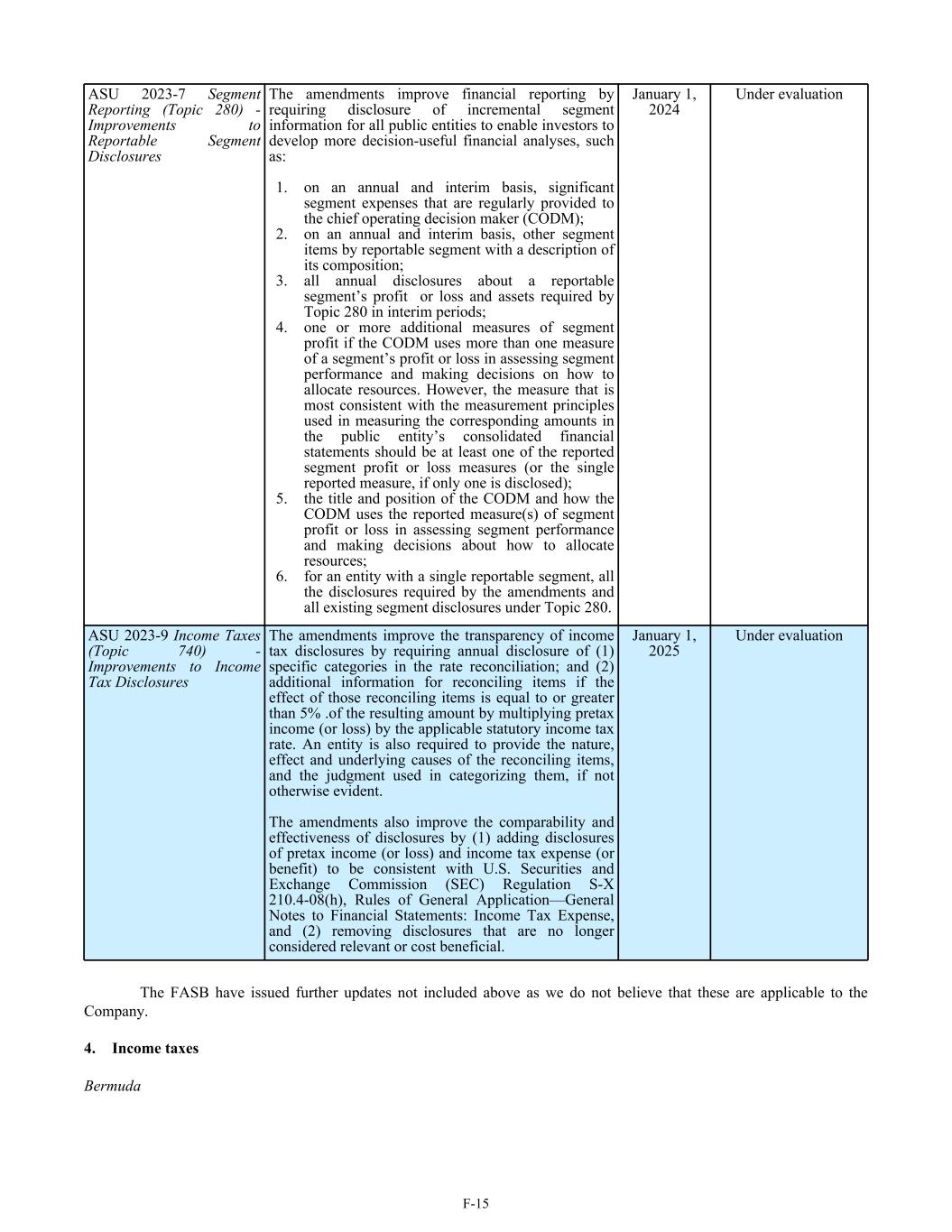
ASU 2023-7 Segment Reporting (Topic 280) - Improvements to Reportable Segment Disclosures The amendments improve financial reporting by requiring disclosure of incremental segment information for all public entities to enable investors to develop more decision-useful financial analyses, such as: 1. on an annual and interim basis, significant segment expenses that are regularly provided to the chief operating decision maker (CODM); 2. on an annual and interim basis, other segment items by reportable segment with a description of its composition; 3. all annual disclosures about a reportable segment’s profit or loss and assets required by Topic 280 in interim periods; 4. one or more additional measures of segment profit if the CODM uses more than one measure of a segment’s profit or loss in assessing segment performance and making decisions on how to allocate resources. However, the measure that is most consistent with the measurement principles used in measuring the corresponding amounts in the public entity’s consolidated financial statements should be at least one of the reported segment profit or loss measures (or the single reported measure, if only one is disclosed); 5. the title and position of the CODM and how the CODM uses the reported measure(s) of segment profit or loss in assessing segment performance and making decisions about how to allocate resources; 6. for an entity with a single reportable segment, all the disclosures required by the amendments and all existing segment disclosures under Topic 280. January 1, 2024 Under evaluation ASU 2023-9 Income Taxes (Topic 740) - Improvements to Income Tax Disclosures The amendments improve the transparency of income tax disclosures by requiring annual disclosure of (1) specific categories in the rate reconciliation; and (2) additional information for reconciling items if the effect of those reconciling items is equal to or greater than 5% .of the resulting amount by multiplying pretax income (or loss) by the applicable statutory income tax rate. An entity is also required to provide the nature, effect and underlying causes of the reconciling items, and the judgment used in categorizing them, if not otherwise evident. The amendments also improve the comparability and effectiveness of disclosures by (1) adding disclosures of pretax income (or loss) and income tax expense (or benefit) to be consistent with U.S. Securities and Exchange Commission (SEC) Regulation S-X 210.4-08(h), Rules of General Application—General Notes to Financial Statements: Income Tax Expense, and (2) removing disclosures that are no longer considered relevant or cost beneficial. January 1, 2025 Under evaluation The FASB have issued further updates not included above as we do not believe that these are applicable to the Company. 4. Income taxes Bermuda F-15
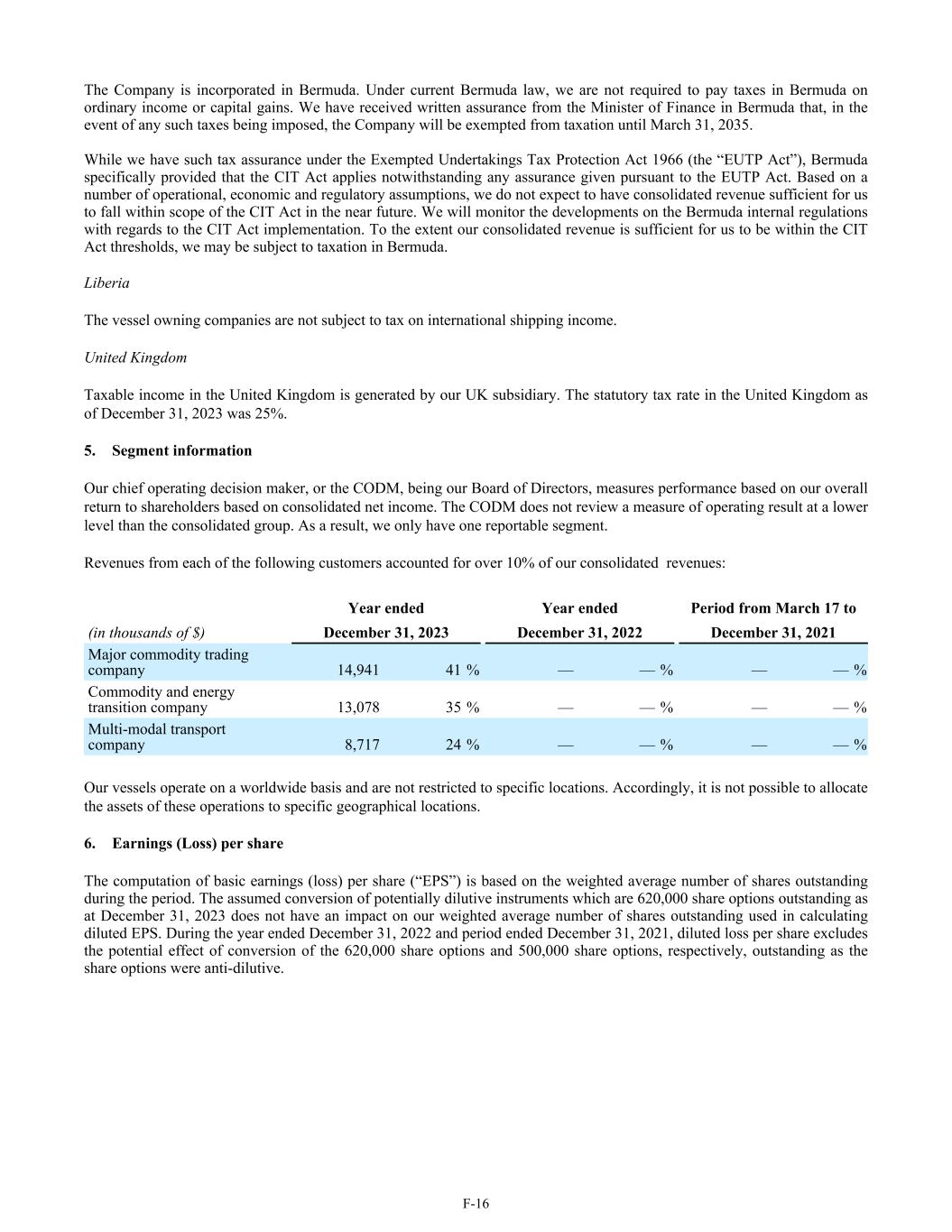
The Company is incorporated in Bermuda. Under current Bermuda law, we are not required to pay taxes in Bermuda on ordinary income or capital gains. We have received written assurance from the Minister of Finance in Bermuda that, in the event of any such taxes being imposed, the Company will be exempted from taxation until March 31, 2035. While we have such tax assurance under the Exempted Undertakings Tax Protection Act 1966 (the “EUTP Act”), Bermuda specifically provided that the CIT Act applies notwithstanding any assurance given pursuant to the EUTP Act. Based on a number of operational, economic and regulatory assumptions, we do not expect to have consolidated revenue sufficient for us to fall within scope of the CIT Act in the near future. We will monitor the developments on the Bermuda internal regulations with regards to the CIT Act implementation. To the extent our consolidated revenue is sufficient for us to be within the CIT Act thresholds, we may be subject to taxation in Bermuda. Liberia The vessel owning companies are not subject to tax on international shipping income. United Kingdom Taxable income in the United Kingdom is generated by our UK subsidiary. The statutory tax rate in the United Kingdom as of December 31, 2023 was 25%. 5. Segment information Our chief operating decision maker, or the CODM, being our Board of Directors, measures performance based on our overall return to shareholders based on consolidated net income. The CODM does not review a measure of operating result at a lower level than the consolidated group. As a result, we only have one reportable segment. Revenues from each of the following customers accounted for over 10% of our consolidated revenues: Year ended Year ended Period from March 17 to (in thousands of $) December 31, 2023 December 31, 2022 December 31, 2021 Major commodity trading company 14,941 41 % — — % — — % Commodity and energy transition company 13,078 35 % — — % — — % Multi-modal transport company 8,717 24 % — — % — — % Our vessels operate on a worldwide basis and are not restricted to specific locations. Accordingly, it is not possible to allocate the assets of these operations to specific geographical locations. 6. Earnings (Loss) per share The computation of basic earnings (loss) per share (“EPS”) is based on the weighted average number of shares outstanding during the period. The assumed conversion of potentially dilutive instruments which are 620,000 share options outstanding as at December 31, 2023 does not have an impact on our weighted average number of shares outstanding used in calculating diluted EPS. During the year ended December 31, 2022 and period ended December 31, 2021, diluted loss per share excludes the potential effect of conversion of the 620,000 share options and 500,000 share options, respectively, outstanding as the share options were anti-dilutive. F-16
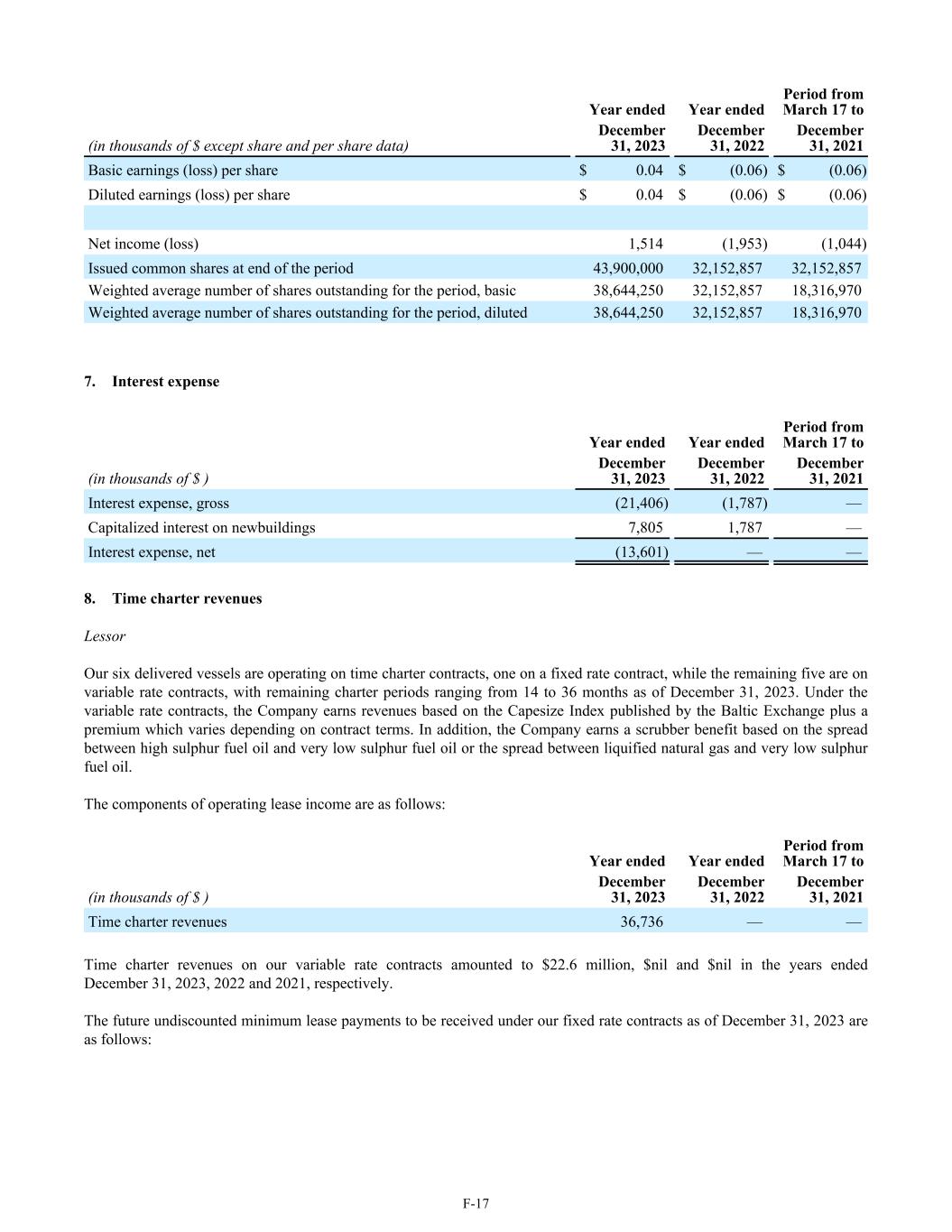
Year ended Year ended Period from March 17 to (in thousands of $ except share and per share data) December 31, 2023 December 31, 2022 December 31, 2021 Basic earnings (loss) per share $ 0.04 $ (0.06) $ (0.06) Diluted earnings (loss) per share $ 0.04 $ (0.06) $ (0.06) Net income (loss) 1,514 (1,953) (1,044) Issued common shares at end of the period 43,900,000 32,152,857 32,152,857 Weighted average number of shares outstanding for the period, basic 38,644,250 32,152,857 18,316,970 Weighted average number of shares outstanding for the period, diluted 38,644,250 32,152,857 18,316,970 7. Interest expense Year ended Year ended Period from March 17 to (in thousands of $ ) December 31, 2023 December 31, 2022 December 31, 2021 Interest expense, gross (21,406) (1,787) — Capitalized interest on newbuildings 7,805 1,787 — Interest expense, net (13,601) — — 8. Time charter revenues Lessor Our six delivered vessels are operating on time charter contracts, one on a fixed rate contract, while the remaining five are on variable rate contracts, with remaining charter periods ranging from 14 to 36 months as of December 31, 2023. Under the variable rate contracts, the Company earns revenues based on the Capesize Index published by the Baltic Exchange plus a premium which varies depending on contract terms. In addition, the Company earns a scrubber benefit based on the spread between high sulphur fuel oil and very low sulphur fuel oil or the spread between liquified natural gas and very low sulphur fuel oil. The components of operating lease income are as follows: Year ended Year ended Period from March 17 to (in thousands of $ ) December 31, 2023 December 31, 2022 December 31, 2021 Time charter revenues 36,736 — — Time charter revenues on our variable rate contracts amounted to $22.6 million, $nil and $nil in the years ended December 31, 2023, 2022 and 2021, respectively. The future undiscounted minimum lease payments to be received under our fixed rate contracts as of December 31, 2023 are as follows: F-17

(in thousands of $) 2024(1) 19,614 2025 1,920 Total 21,534 (1) This includes index linked charters that were converted to fixed rate time charters for varying periods from December 1, 2023 to March 31, 2024. Subsequent to the year-end, index linked charters for three vessels were converted to fixed rate time charters for varying periods from February 1, 2024 to December 31, 2024, the impact of which has been excluded from this table. 9. Prepaid expenses and other current assets Prepaid expenses and other current assets comprise of: (in thousands of $) December 31, 2023 December 31, 2022 Prepaid interest (1) 2,410 426 Other prepaid expenses (2) 997 123 Inventory 634 — Other current assets (3) 2,402 — Prepaid listing costs (4) — 858 6,443 1,407 (1) Prepaid interest pertains to interest paid in advance for "Mount Norefjell,” “Mount Ita,” “Mount Etna” and “Mount Blanc.” These vessels were delivered during the year ended December 31, 2023 and bareboat payments on the lease were paid in advance. (2) Other prepaid expenses are comprised primarily of prepaid insurance on the six delivered vessels “Mount Norefjell,” “Mount Ita,” “Mount Etna,” “Mount Blanc,” “Mount Matterhorn” and “Mount Neblina” and Directors and Officers Liability insurance. (3) Other current assets primarily relates to funding advanced to vessel managers. (4) Equity issuance costs as of December 31, 2022 were recognized as “Prepaid expenses and other current assets” in the Consolidated Balance Sheets. Upon completion of the IPO in 2023, these costs were netted off against the proceeds from the offering and recognized under additional paid-in capital. 10. Newbuildings The table below sets forth the carrying value of our newbuildings: (in thousands of $) 2023 2022 As of January 1 176,145 83,479 Installment payments(1) 378,305 88,542 Capitalized interest 7,805 1,780 Other capitalized costs(2) 8,126 2,344 Reclassification to Vessels and equipment(3) (437,735) — As of December 31 132,646 176,145 (1) Installment payments in the year ended December 31, 2023 include $75.7 million for the third and /or fourth installments to New Times Shipyard for newbuildings “Mount Neblina,” “Mount Bandeira,” “Mount Hua,” “Mount Elbrus,” “Mount Denali,” “Mount Aconcagua” and “Mount Emai”, and $302.6 million for the fifth and sixth installments net of address commissions to New Times Shipyard for newbuildings “Mount Norefjell,” “Mount Ita,” “Mount Etna,” “Mount Blanc,” “Mount Matterhorn” and “Mount Neblina.” F-18
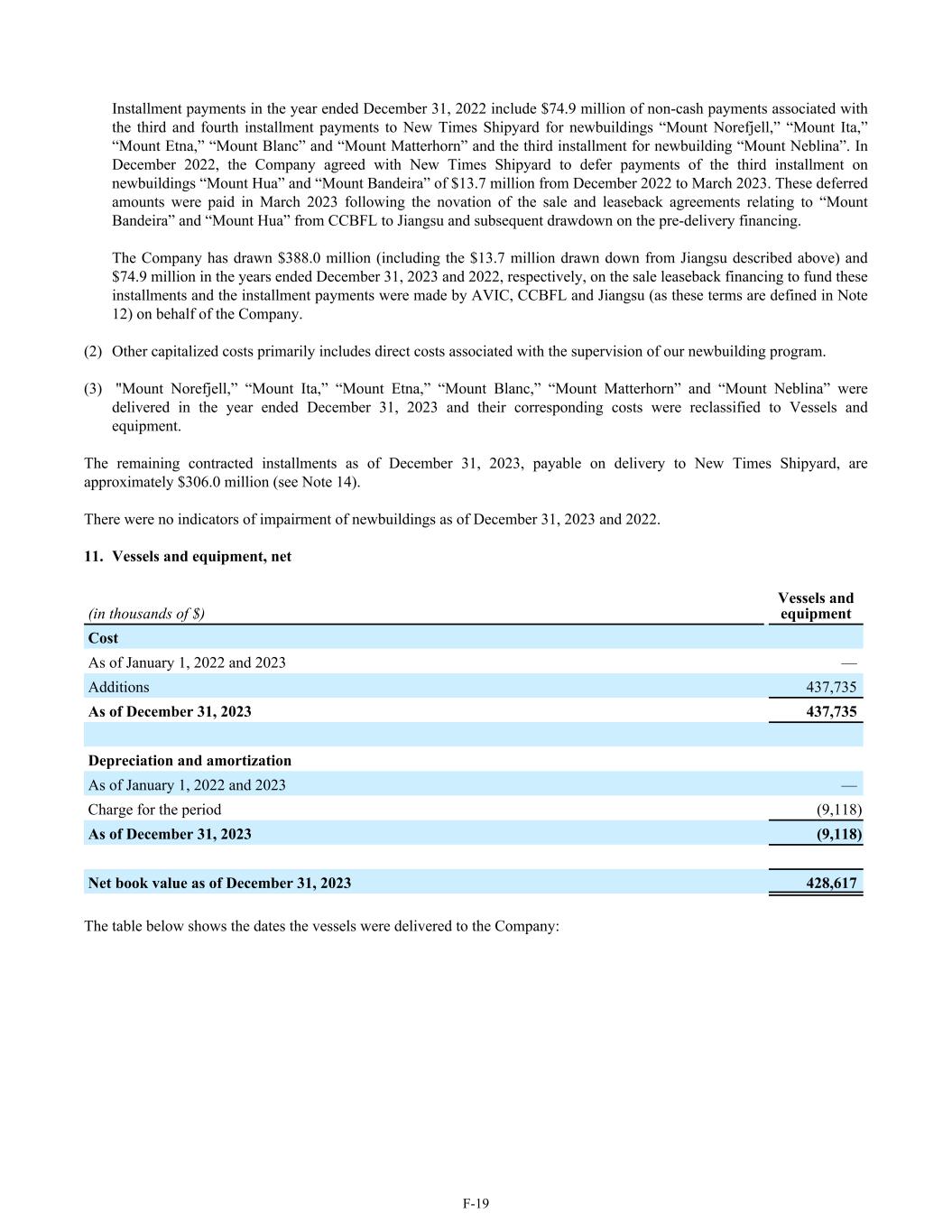
Installment payments in the year ended December 31, 2022 include $74.9 million of non-cash payments associated with the third and fourth installment payments to New Times Shipyard for newbuildings “Mount Norefjell,” “Mount Ita,” “Mount Etna,” “Mount Blanc” and “Mount Matterhorn” and the third installment for newbuilding “Mount Neblina”. In December 2022, the Company agreed with New Times Shipyard to defer payments of the third installment on newbuildings “Mount Hua” and “Mount Bandeira” of $13.7 million from December 2022 to March 2023. These deferred amounts were paid in March 2023 following the novation of the sale and leaseback agreements relating to “Mount Bandeira” and “Mount Hua” from CCBFL to Jiangsu and subsequent drawdown on the pre-delivery financing. The Company has drawn $388.0 million (including the $13.7 million drawn down from Jiangsu described above) and $74.9 million in the years ended December 31, 2023 and 2022, respectively, on the sale leaseback financing to fund these installments and the installment payments were made by AVIC, CCBFL and Jiangsu (as these terms are defined in Note 12) on behalf of the Company. (2) Other capitalized costs primarily includes direct costs associated with the supervision of our newbuilding program. (3) "Mount Norefjell,” “Mount Ita,” “Mount Etna,” “Mount Blanc,” “Mount Matterhorn” and “Mount Neblina” were delivered in the year ended December 31, 2023 and their corresponding costs were reclassified to Vessels and equipment. The remaining contracted installments as of December 31, 2023, payable on delivery to New Times Shipyard, are approximately $306.0 million (see Note 14). There were no indicators of impairment of newbuildings as of December 31, 2023 and 2022. 11. Vessels and equipment, net (in thousands of $) Vessels and equipment Cost As of January 1, 2022 and 2023 — Additions 437,735 As of December 31, 2023 437,735 Depreciation and amortization As of January 1, 2022 and 2023 — Charge for the period (9,118) As of December 31, 2023 (9,118) Net book value as of December 31, 2023 428,617 The table below shows the dates the vessels were delivered to the Company: F-19
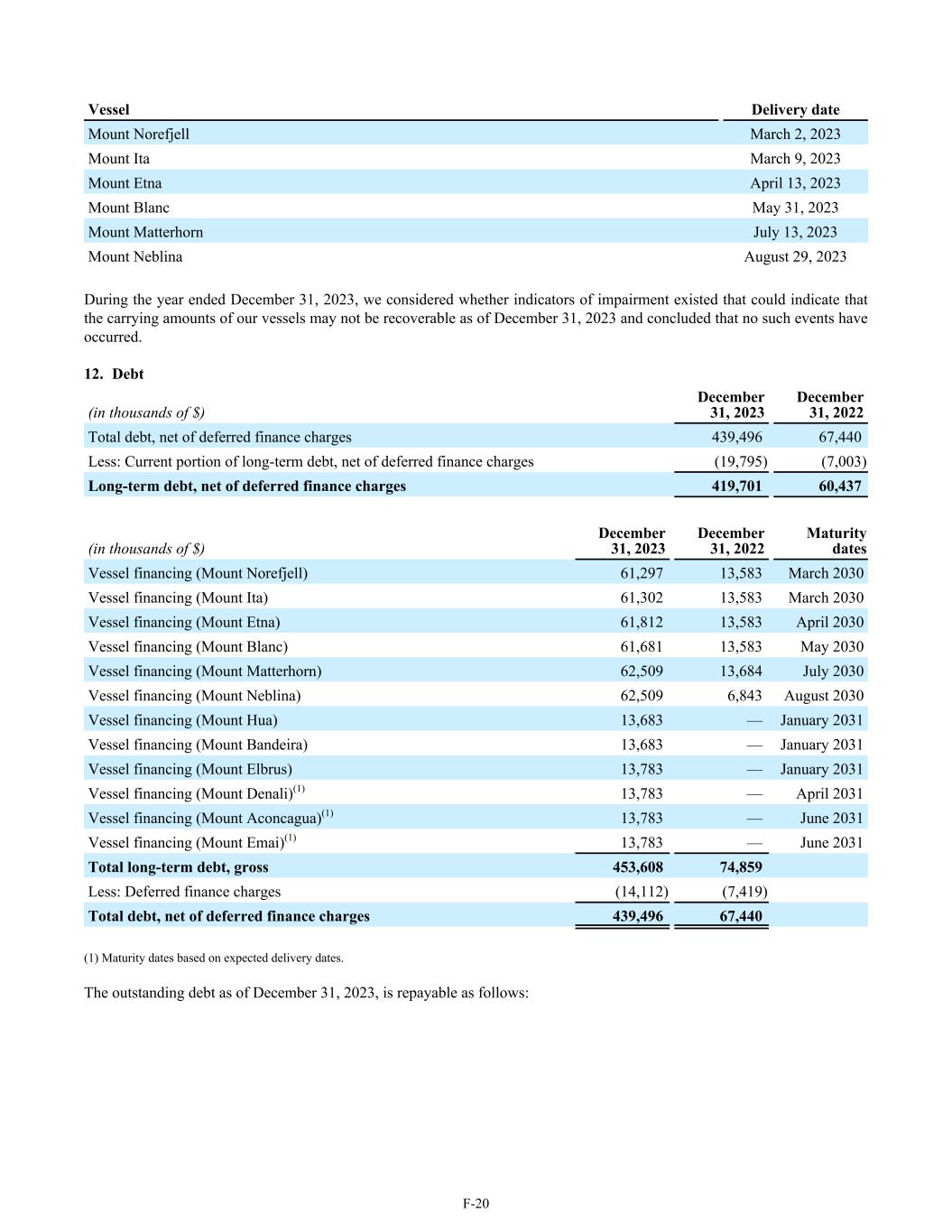
Vessel Delivery date Mount Norefjell March 2, 2023 Mount Ita March 9, 2023 Mount Etna April 13, 2023 Mount Blanc May 31, 2023 Mount Matterhorn July 13, 2023 Mount Neblina August 29, 2023 During the year ended December 31, 2023, we considered whether indicators of impairment existed that could indicate that the carrying amounts of our vessels may not be recoverable as of December 31, 2023 and concluded that no such events have occurred. 12. Debt (in thousands of $) December 31, 2023 December 31, 2022 Total debt, net of deferred finance charges 439,496 67,440 Less: Current portion of long-term debt, net of deferred finance charges (19,795) (7,003) Long-term debt, net of deferred finance charges 419,701 60,437 (in thousands of $) December 31, 2023 December 31, 2022 Maturity dates Vessel financing (Mount Norefjell) 61,297 13,583 March 2030 Vessel financing (Mount Ita) 61,302 13,583 March 2030 Vessel financing (Mount Etna) 61,812 13,583 April 2030 Vessel financing (Mount Blanc) 61,681 13,583 May 2030 Vessel financing (Mount Matterhorn) 62,509 13,684 July 2030 Vessel financing (Mount Neblina) 62,509 6,843 August 2030 Vessel financing (Mount Hua) 13,683 — January 2031 Vessel financing (Mount Bandeira) 13,683 — January 2031 Vessel financing (Mount Elbrus) 13,783 — January 2031 Vessel financing (Mount Denali)(1) 13,783 — April 2031 Vessel financing (Mount Aconcagua)(1) 13,783 — June 2031 Vessel financing (Mount Emai)(1) 13,783 — June 2031 Total long-term debt, gross 453,608 74,859 Less: Deferred finance charges (14,112) (7,419) Total debt, net of deferred finance charges 439,496 67,440 (1) Maturity dates based on expected delivery dates. The outstanding debt as of December 31, 2023, is repayable as follows: F-20
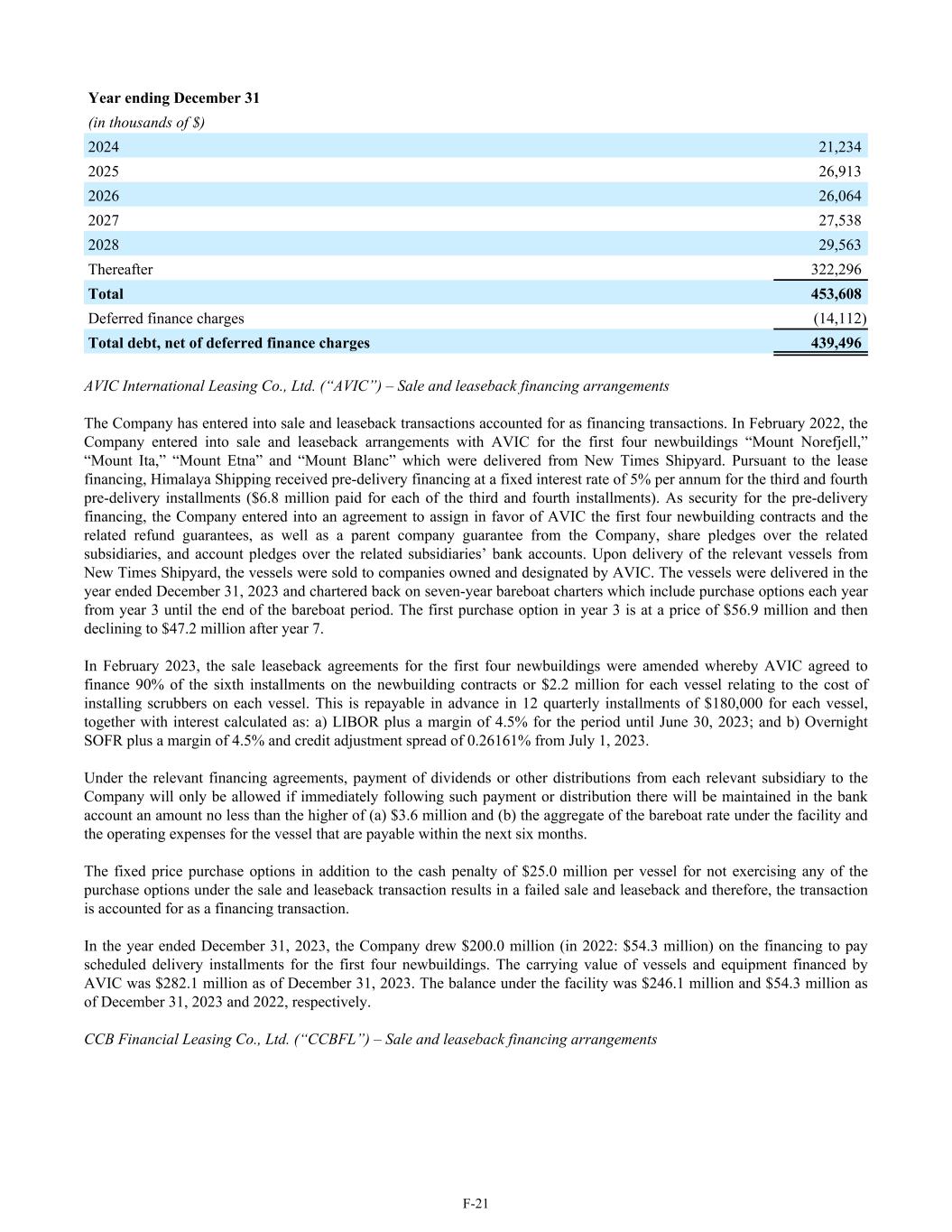
Year ending December 31 (in thousands of $) 2024 21,234 2025 26,913 2026 26,064 2027 27,538 2028 29,563 Thereafter 322,296 Total 453,608 Deferred finance charges (14,112) Total debt, net of deferred finance charges 439,496 AVIC International Leasing Co., Ltd. (“AVIC”) – Sale and leaseback financing arrangements The Company has entered into sale and leaseback transactions accounted for as financing transactions. In February 2022, the Company entered into sale and leaseback arrangements with AVIC for the first four newbuildings “Mount Norefjell,” “Mount Ita,” “Mount Etna” and “Mount Blanc” which were delivered from New Times Shipyard. Pursuant to the lease financing, Himalaya Shipping received pre-delivery financing at a fixed interest rate of 5% per annum for the third and fourth pre-delivery installments ($6.8 million paid for each of the third and fourth installments). As security for the pre-delivery financing, the Company entered into an agreement to assign in favor of AVIC the first four newbuilding contracts and the related refund guarantees, as well as a parent company guarantee from the Company, share pledges over the related subsidiaries, and account pledges over the related subsidiaries’ bank accounts. Upon delivery of the relevant vessels from New Times Shipyard, the vessels were sold to companies owned and designated by AVIC. The vessels were delivered in the year ended December 31, 2023 and chartered back on seven-year bareboat charters which include purchase options each year from year 3 until the end of the bareboat period. The first purchase option in year 3 is at a price of $56.9 million and then declining to $47.2 million after year 7. In February 2023, the sale leaseback agreements for the first four newbuildings were amended whereby AVIC agreed to finance 90% of the sixth installments on the newbuilding contracts or $2.2 million for each vessel relating to the cost of installing scrubbers on each vessel. This is repayable in advance in 12 quarterly installments of $180,000 for each vessel, together with interest calculated as: a) LIBOR plus a margin of 4.5% for the period until June 30, 2023; and b) Overnight SOFR plus a margin of 4.5% and credit adjustment spread of 0.26161% from July 1, 2023. Under the relevant financing agreements, payment of dividends or other distributions from each relevant subsidiary to the Company will only be allowed if immediately following such payment or distribution there will be maintained in the bank account an amount no less than the higher of (a) $3.6 million and (b) the aggregate of the bareboat rate under the facility and the operating expenses for the vessel that are payable within the next six months. The fixed price purchase options in addition to the cash penalty of $25.0 million per vessel for not exercising any of the purchase options under the sale and leaseback transaction results in a failed sale and leaseback and therefore, the transaction is accounted for as a financing transaction. In the year ended December 31, 2023, the Company drew $200.0 million (in 2022: $54.3 million) on the financing to pay scheduled delivery installments for the first four newbuildings. The carrying value of vessels and equipment financed by AVIC was $282.1 million as of December 31, 2023. The balance under the facility was $246.1 million and $54.3 million as of December 31, 2023 and 2022, respectively. CCB Financial Leasing Co., Ltd. (“CCBFL”) – Sale and leaseback financing arrangements F-21
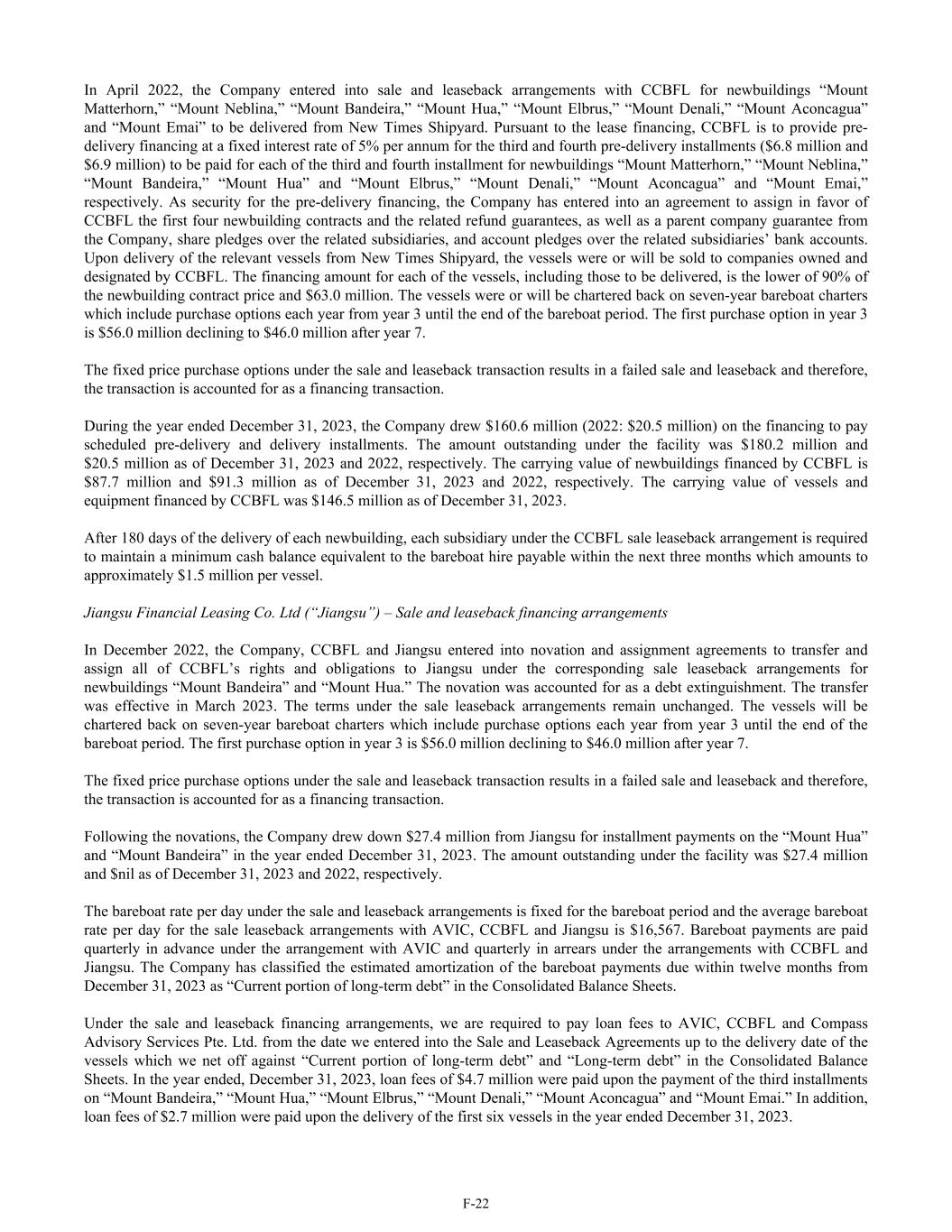
In April 2022, the Company entered into sale and leaseback arrangements with CCBFL for newbuildings “Mount Matterhorn,” “Mount Neblina,” “Mount Bandeira,” “Mount Hua,” “Mount Elbrus,” “Mount Denali,” “Mount Aconcagua” and “Mount Emai” to be delivered from New Times Shipyard. Pursuant to the lease financing, CCBFL is to provide pre- delivery financing at a fixed interest rate of 5% per annum for the third and fourth pre-delivery installments ($6.8 million and $6.9 million) to be paid for each of the third and fourth installment for newbuildings “Mount Matterhorn,” “Mount Neblina,” “Mount Bandeira,” “Mount Hua” and “Mount Elbrus,” “Mount Denali,” “Mount Aconcagua” and “Mount Emai,” respectively. As security for the pre-delivery financing, the Company has entered into an agreement to assign in favor of CCBFL the first four newbuilding contracts and the related refund guarantees, as well as a parent company guarantee from the Company, share pledges over the related subsidiaries, and account pledges over the related subsidiaries’ bank accounts. Upon delivery of the relevant vessels from New Times Shipyard, the vessels were or will be sold to companies owned and designated by CCBFL. The financing amount for each of the vessels, including those to be delivered, is the lower of 90% of the newbuilding contract price and $63.0 million. The vessels were or will be chartered back on seven-year bareboat charters which include purchase options each year from year 3 until the end of the bareboat period. The first purchase option in year 3 is $56.0 million declining to $46.0 million after year 7. The fixed price purchase options under the sale and leaseback transaction results in a failed sale and leaseback and therefore, the transaction is accounted for as a financing transaction. During the year ended December 31, 2023, the Company drew $160.6 million (2022: $20.5 million) on the financing to pay scheduled pre-delivery and delivery installments. The amount outstanding under the facility was $180.2 million and $20.5 million as of December 31, 2023 and 2022, respectively. The carrying value of newbuildings financed by CCBFL is $87.7 million and $91.3 million as of December 31, 2023 and 2022, respectively. The carrying value of vessels and equipment financed by CCBFL was $146.5 million as of December 31, 2023. After 180 days of the delivery of each newbuilding, each subsidiary under the CCBFL sale leaseback arrangement is required to maintain a minimum cash balance equivalent to the bareboat hire payable within the next three months which amounts to approximately $1.5 million per vessel. Jiangsu Financial Leasing Co. Ltd (“Jiangsu”) – Sale and leaseback financing arrangements In December 2022, the Company, CCBFL and Jiangsu entered into novation and assignment agreements to transfer and assign all of CCBFL’s rights and obligations to Jiangsu under the corresponding sale leaseback arrangements for newbuildings “Mount Bandeira” and “Mount Hua.” The novation was accounted for as a debt extinguishment. The transfer was effective in March 2023. The terms under the sale leaseback arrangements remain unchanged. The vessels will be chartered back on seven-year bareboat charters which include purchase options each year from year 3 until the end of the bareboat period. The first purchase option in year 3 is $56.0 million declining to $46.0 million after year 7. The fixed price purchase options under the sale and leaseback transaction results in a failed sale and leaseback and therefore, the transaction is accounted for as a financing transaction. Following the novations, the Company drew down $27.4 million from Jiangsu for installment payments on the “Mount Hua” and “Mount Bandeira” in the year ended December 31, 2023. The amount outstanding under the facility was $27.4 million and $nil as of December 31, 2023 and 2022, respectively. The bareboat rate per day under the sale and leaseback arrangements is fixed for the bareboat period and the average bareboat rate per day for the sale leaseback arrangements with AVIC, CCBFL and Jiangsu is $16,567. Bareboat payments are paid quarterly in advance under the arrangement with AVIC and quarterly in arrears under the arrangements with CCBFL and Jiangsu. The Company has classified the estimated amortization of the bareboat payments due within twelve months from December 31, 2023 as “Current portion of long-term debt” in the Consolidated Balance Sheets. Under the sale and leaseback financing arrangements, we are required to pay loan fees to AVIC, CCBFL and Compass Advisory Services Pte. Ltd. from the date we entered into the Sale and Leaseback Agreements up to the delivery date of the vessels which we net off against “Current portion of long-term debt” and “Long-term debt” in the Consolidated Balance Sheets. In the year ended, December 31, 2023, loan fees of $4.7 million were paid upon the payment of the third installments on “Mount Bandeira,” “Mount Hua,” “Mount Elbrus,” “Mount Denali,” “Mount Aconcagua” and “Mount Emai.” In addition, loan fees of $2.7 million were paid upon the delivery of the first six vessels in the year ended December 31, 2023. F-22
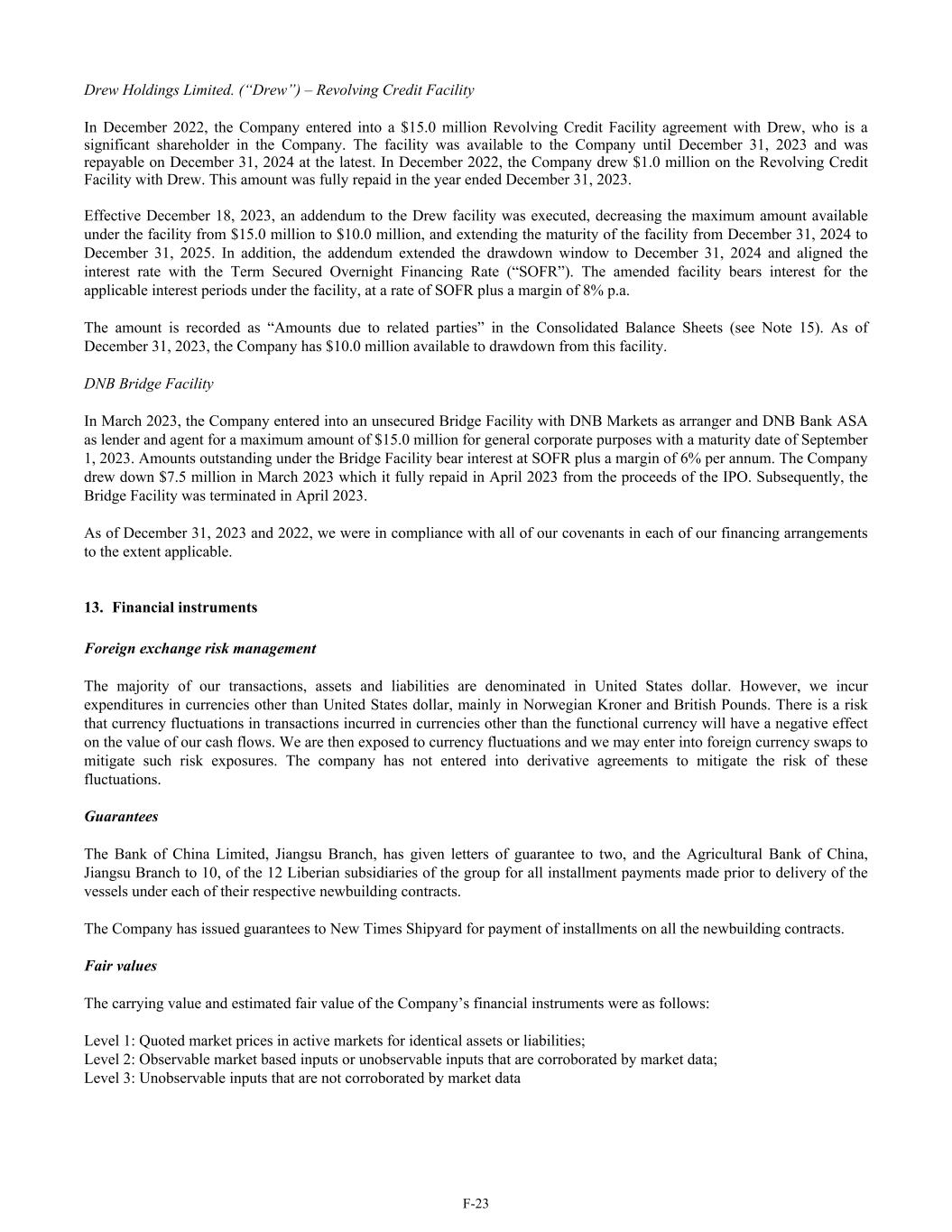
Drew Holdings Limited. (“Drew”) – Revolving Credit Facility In December 2022, the Company entered into a $15.0 million Revolving Credit Facility agreement with Drew, who is a significant shareholder in the Company. The facility was available to the Company until December 31, 2023 and was repayable on December 31, 2024 at the latest. In December 2022, the Company drew $1.0 million on the Revolving Credit Facility with Drew. This amount was fully repaid in the year ended December 31, 2023. Effective December 18, 2023, an addendum to the Drew facility was executed, decreasing the maximum amount available under the facility from $15.0 million to $10.0 million, and extending the maturity of the facility from December 31, 2024 to December 31, 2025. In addition, the addendum extended the drawdown window to December 31, 2024 and aligned the interest rate with the Term Secured Overnight Financing Rate (“SOFR”). The amended facility bears interest for the applicable interest periods under the facility, at a rate of SOFR plus a margin of 8% p.a. The amount is recorded as “Amounts due to related parties” in the Consolidated Balance Sheets (see Note 15). As of December 31, 2023, the Company has $10.0 million available to drawdown from this facility. DNB Bridge Facility In March 2023, the Company entered into an unsecured Bridge Facility with DNB Markets as arranger and DNB Bank ASA as lender and agent for a maximum amount of $15.0 million for general corporate purposes with a maturity date of September 1, 2023. Amounts outstanding under the Bridge Facility bear interest at SOFR plus a margin of 6% per annum. The Company drew down $7.5 million in March 2023 which it fully repaid in April 2023 from the proceeds of the IPO. Subsequently, the Bridge Facility was terminated in April 2023. As of December 31, 2023 and 2022, we were in compliance with all of our covenants in each of our financing arrangements to the extent applicable. 13. Financial instruments Foreign exchange risk management The majority of our transactions, assets and liabilities are denominated in United States dollar. However, we incur expenditures in currencies other than United States dollar, mainly in Norwegian Kroner and British Pounds. There is a risk that currency fluctuations in transactions incurred in currencies other than the functional currency will have a negative effect on the value of our cash flows. We are then exposed to currency fluctuations and we may enter into foreign currency swaps to mitigate such risk exposures. The company has not entered into derivative agreements to mitigate the risk of these fluctuations. Guarantees The Bank of China Limited, Jiangsu Branch, has given letters of guarantee to two, and the Agricultural Bank of China, Jiangsu Branch to 10, of the 12 Liberian subsidiaries of the group for all installment payments made prior to delivery of the vessels under each of their respective newbuilding contracts. The Company has issued guarantees to New Times Shipyard for payment of installments on all the newbuilding contracts. Fair values The carrying value and estimated fair value of the Company’s financial instruments were as follows: Level 1: Quoted market prices in active markets for identical assets or liabilities; Level 2: Observable market based inputs or unobservable inputs that are corroborated by market data; Level 3: Unobservable inputs that are not corroborated by market data F-23
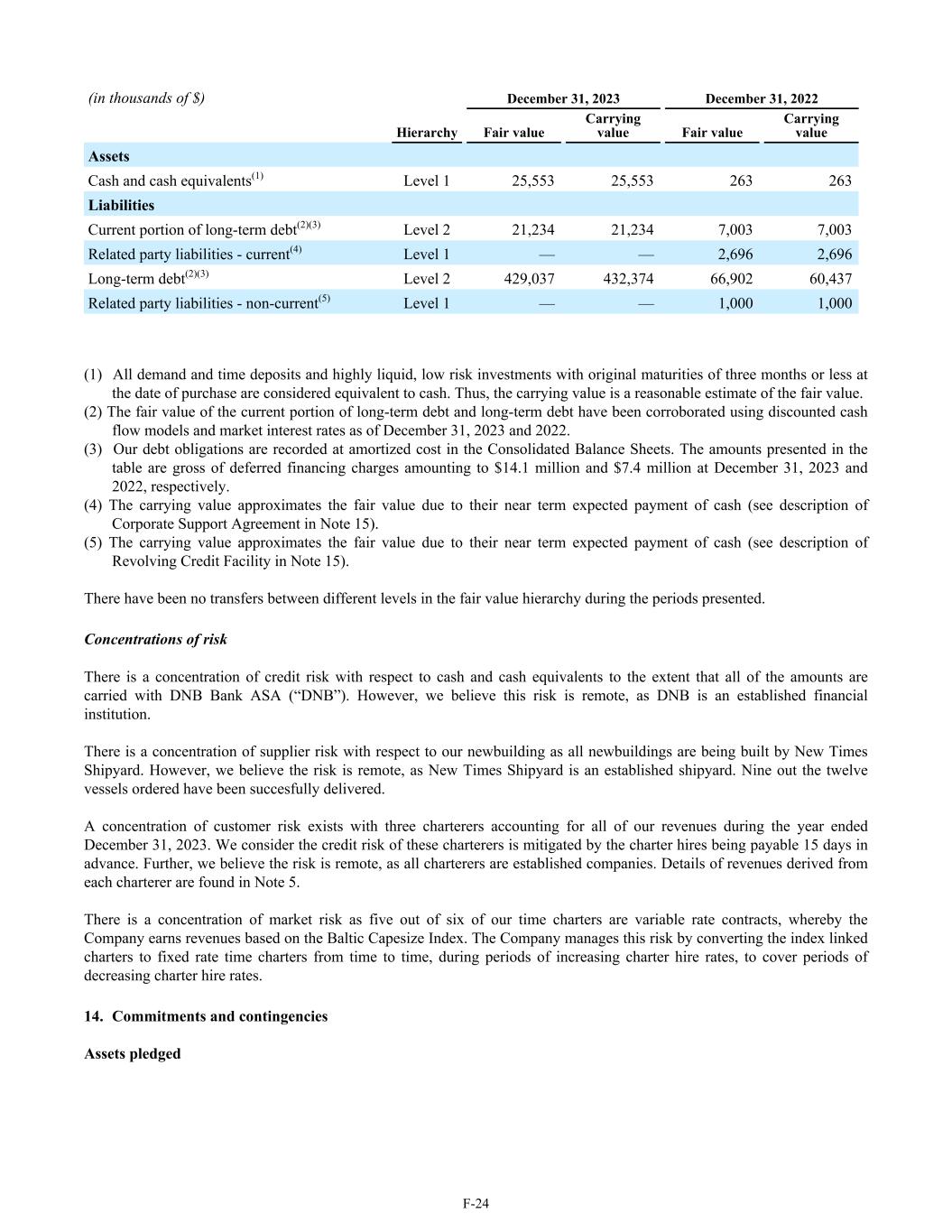
(in thousands of $) December 31, 2023 December 31, 2022 Hierarchy Fair value Carrying value Fair value Carrying value Assets Cash and cash equivalents(1) Level 1 25,553 25,553 263 263 Liabilities Current portion of long-term debt(2)(3) Level 2 21,234 21,234 7,003 7,003 Related party liabilities - current(4) Level 1 — — 2,696 2,696 Long-term debt(2)(3) Level 2 429,037 432,374 66,902 60,437 Related party liabilities - non-current(5) Level 1 — — 1,000 1,000 (1) All demand and time deposits and highly liquid, low risk investments with original maturities of three months or less at the date of purchase are considered equivalent to cash. Thus, the carrying value is a reasonable estimate of the fair value. (2) The fair value of the current portion of long-term debt and long-term debt have been corroborated using discounted cash flow models and market interest rates as of December 31, 2023 and 2022. (3) Our debt obligations are recorded at amortized cost in the Consolidated Balance Sheets. The amounts presented in the table are gross of deferred financing charges amounting to $14.1 million and $7.4 million at December 31, 2023 and 2022, respectively. (4) The carrying value approximates the fair value due to their near term expected payment of cash (see description of Corporate Support Agreement in Note 15). (5) The carrying value approximates the fair value due to their near term expected payment of cash (see description of Revolving Credit Facility in Note 15). There have been no transfers between different levels in the fair value hierarchy during the periods presented. Concentrations of risk There is a concentration of credit risk with respect to cash and cash equivalents to the extent that all of the amounts are carried with DNB Bank ASA (“DNB”). However, we believe this risk is remote, as DNB is an established financial institution. There is a concentration of supplier risk with respect to our newbuilding as all newbuildings are being built by New Times Shipyard. However, we believe the risk is remote, as New Times Shipyard is an established shipyard. Nine out the twelve vessels ordered have been succesfully delivered. A concentration of customer risk exists with three charterers accounting for all of our revenues during the year ended December 31, 2023. We consider the credit risk of these charterers is mitigated by the charter hires being payable 15 days in advance. Further, we believe the risk is remote, as all charterers are established companies. Details of revenues derived from each charterer are found in Note 5. There is a concentration of market risk as five out of six of our time charters are variable rate contracts, whereby the Company earns revenues based on the Baltic Capesize Index. The Company manages this risk by converting the index linked charters to fixed rate time charters from time to time, during periods of increasing charter hire rates, to cover periods of decreasing charter hire rates. 14. Commitments and contingencies Assets pledged F-24
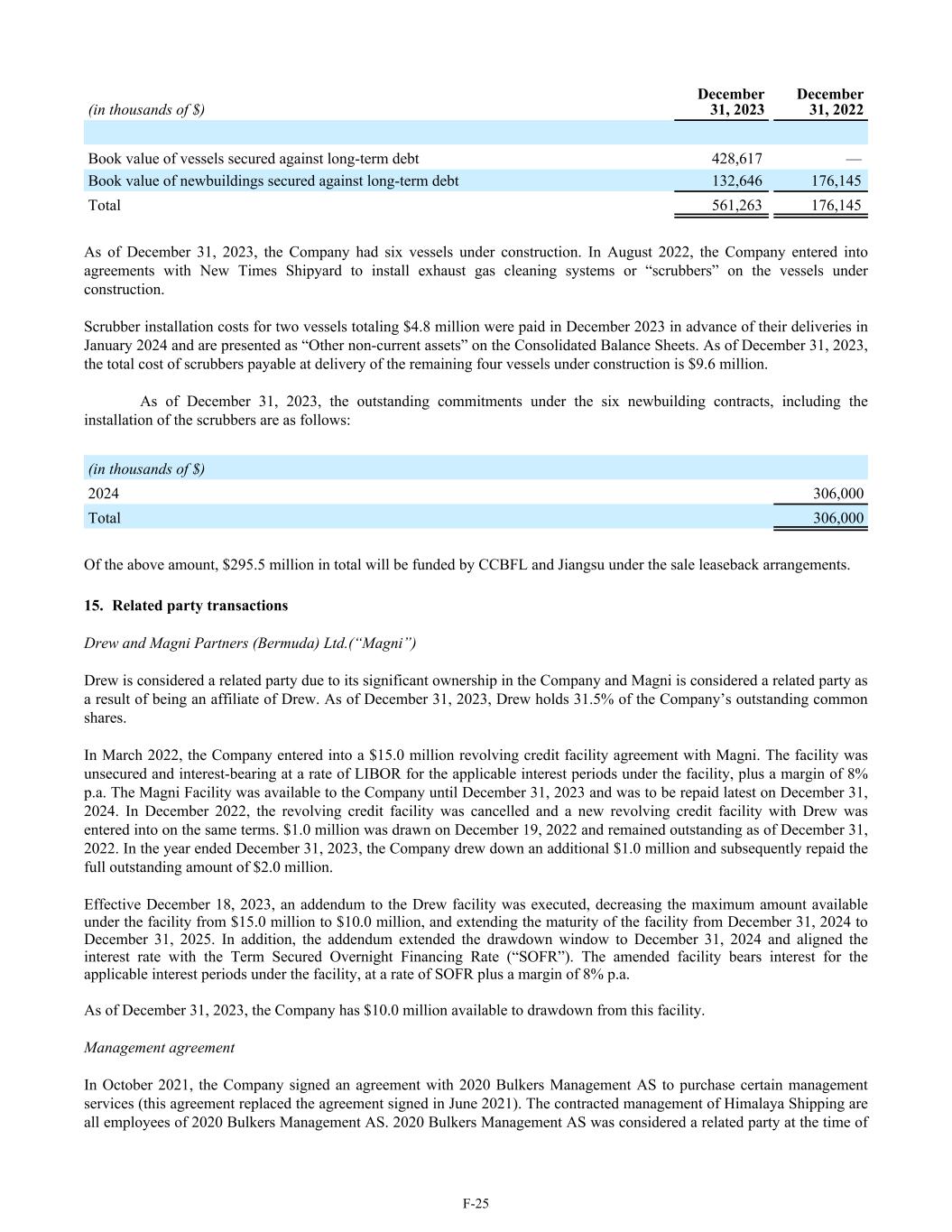
(in thousands of $) December 31, 2023 December 31, 2022 Book value of vessels secured against long-term debt 428,617 — Book value of newbuildings secured against long-term debt 132,646 176,145 Total 561,263 176,145 As of December 31, 2023, the Company had six vessels under construction. In August 2022, the Company entered into agreements with New Times Shipyard to install exhaust gas cleaning systems or “scrubbers” on the vessels under construction. Scrubber installation costs for two vessels totaling $4.8 million were paid in December 2023 in advance of their deliveries in January 2024 and are presented as “Other non-current assets” on the Consolidated Balance Sheets. As of December 31, 2023, the total cost of scrubbers payable at delivery of the remaining four vessels under construction is $9.6 million. As of December 31, 2023, the outstanding commitments under the six newbuilding contracts, including the installation of the scrubbers are as follows: (in thousands of $) 2024 306,000 Total 306,000 Of the above amount, $295.5 million in total will be funded by CCBFL and Jiangsu under the sale leaseback arrangements. 15. Related party transactions Drew and Magni Partners (Bermuda) Ltd.(“Magni”) Drew is considered a related party due to its significant ownership in the Company and Magni is considered a related party as a result of being an affiliate of Drew. As of December 31, 2023, Drew holds 31.5% of the Company’s outstanding common shares. In March 2022, the Company entered into a $15.0 million revolving credit facility agreement with Magni. The facility was unsecured and interest-bearing at a rate of LIBOR for the applicable interest periods under the facility, plus a margin of 8% p.a. The Magni Facility was available to the Company until December 31, 2023 and was to be repaid latest on December 31, 2024. In December 2022, the revolving credit facility was cancelled and a new revolving credit facility with Drew was entered into on the same terms. $1.0 million was drawn on December 19, 2022 and remained outstanding as of December 31, 2022. In the year ended December 31, 2023, the Company drew down an additional $1.0 million and subsequently repaid the full outstanding amount of $2.0 million. Effective December 18, 2023, an addendum to the Drew facility was executed, decreasing the maximum amount available under the facility from $15.0 million to $10.0 million, and extending the maturity of the facility from December 31, 2024 to December 31, 2025. In addition, the addendum extended the drawdown window to December 31, 2024 and aligned the interest rate with the Term Secured Overnight Financing Rate (“SOFR”). The amended facility bears interest for the applicable interest periods under the facility, at a rate of SOFR plus a margin of 8% p.a. As of December 31, 2023, the Company has $10.0 million available to drawdown from this facility. Management agreement In October 2021, the Company signed an agreement with 2020 Bulkers Management AS to purchase certain management services (this agreement replaced the agreement signed in June 2021). The contracted management of Himalaya Shipping are all employees of 2020 Bulkers Management AS. 2020 Bulkers Management AS was considered a related party at the time of F-25
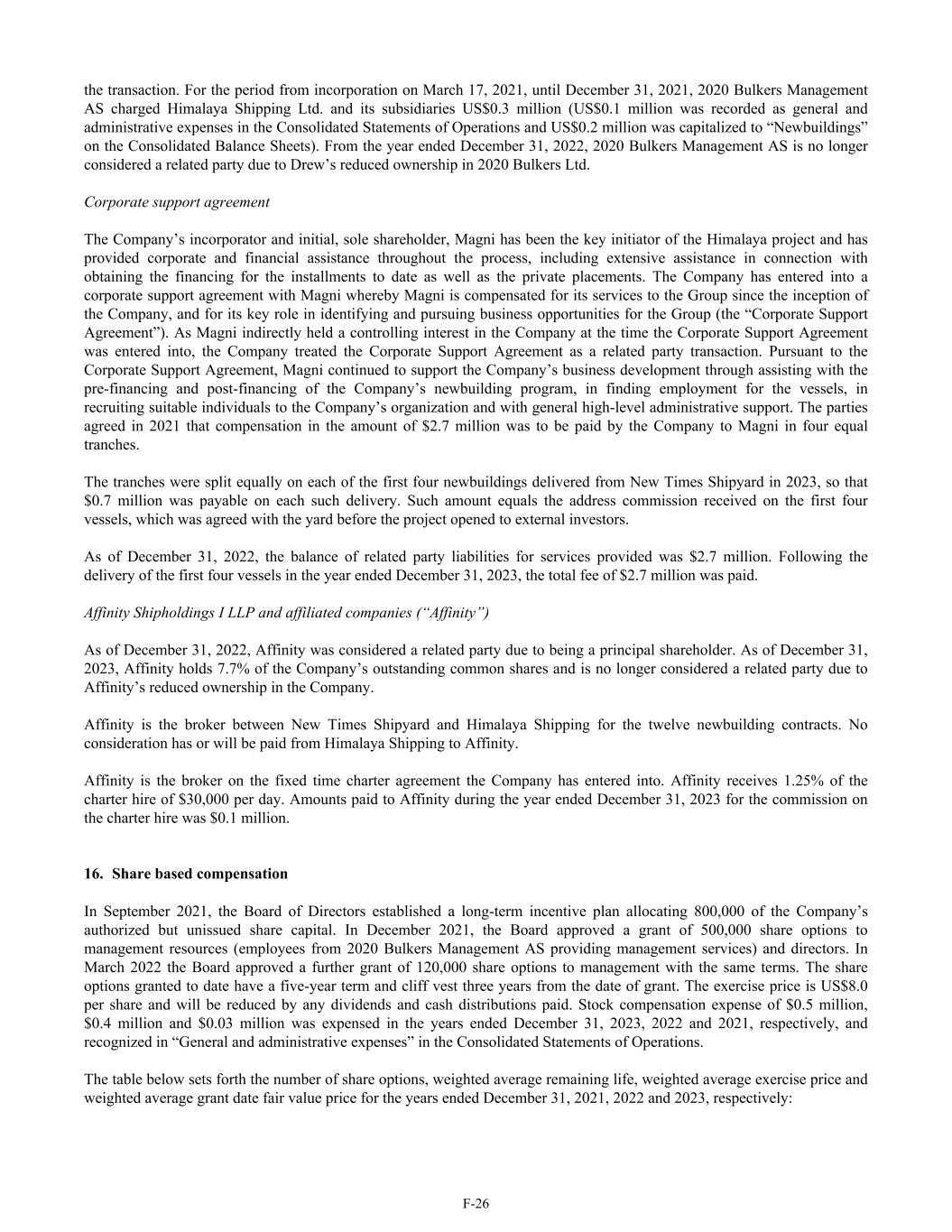
the transaction. For the period from incorporation on March 17, 2021, until December 31, 2021, 2020 Bulkers Management AS charged Himalaya Shipping Ltd. and its subsidiaries US$0.3 million (US$0.1 million was recorded as general and administrative expenses in the Consolidated Statements of Operations and US$0.2 million was capitalized to “Newbuildings” on the Consolidated Balance Sheets). From the year ended December 31, 2022, 2020 Bulkers Management AS is no longer considered a related party due to Drew’s reduced ownership in 2020 Bulkers Ltd. Corporate support agreement The Company’s incorporator and initial, sole shareholder, Magni has been the key initiator of the Himalaya project and has provided corporate and financial assistance throughout the process, including extensive assistance in connection with obtaining the financing for the installments to date as well as the private placements. The Company has entered into a corporate support agreement with Magni whereby Magni is compensated for its services to the Group since the inception of the Company, and for its key role in identifying and pursuing business opportunities for the Group (the “Corporate Support Agreement”). As Magni indirectly held a controlling interest in the Company at the time the Corporate Support Agreement was entered into, the Company treated the Corporate Support Agreement as a related party transaction. Pursuant to the Corporate Support Agreement, Magni continued to support the Company’s business development through assisting with the pre-financing and post-financing of the Company’s newbuilding program, in finding employment for the vessels, in recruiting suitable individuals to the Company’s organization and with general high-level administrative support. The parties agreed in 2021 that compensation in the amount of $2.7 million was to be paid by the Company to Magni in four equal tranches. The tranches were split equally on each of the first four newbuildings delivered from New Times Shipyard in 2023, so that $0.7 million was payable on each such delivery. Such amount equals the address commission received on the first four vessels, which was agreed with the yard before the project opened to external investors. As of December 31, 2022, the balance of related party liabilities for services provided was $2.7 million. Following the delivery of the first four vessels in the year ended December 31, 2023, the total fee of $2.7 million was paid. Affinity Shipholdings I LLP and affiliated companies (“Affinity”) As of December 31, 2022, Affinity was considered a related party due to being a principal shareholder. As of December 31, 2023, Affinity holds 7.7% of the Company’s outstanding common shares and is no longer considered a related party due to Affinity’s reduced ownership in the Company. Affinity is the broker between New Times Shipyard and Himalaya Shipping for the twelve newbuilding contracts. No consideration has or will be paid from Himalaya Shipping to Affinity. Affinity is the broker on the fixed time charter agreement the Company has entered into. Affinity receives 1.25% of the charter hire of $30,000 per day. Amounts paid to Affinity during the year ended December 31, 2023 for the commission on the charter hire was $0.1 million. 16. Share based compensation In September 2021, the Board of Directors established a long-term incentive plan allocating 800,000 of the Company’s authorized but unissued share capital. In December 2021, the Board approved a grant of 500,000 share options to management resources (employees from 2020 Bulkers Management AS providing management services) and directors. In March 2022 the Board approved a further grant of 120,000 share options to management with the same terms. The share options granted to date have a five-year term and cliff vest three years from the date of grant. The exercise price is US$8.0 per share and will be reduced by any dividends and cash distributions paid. Stock compensation expense of $0.5 million, $0.4 million and $0.03 million was expensed in the years ended December 31, 2023, 2022 and 2021, respectively, and recognized in “General and administrative expenses” in the Consolidated Statements of Operations. The table below sets forth the number of share options, weighted average remaining life, weighted average exercise price and weighted average grant date fair value price for the years ended December 31, 2021, 2022 and 2023, respectively: F-26
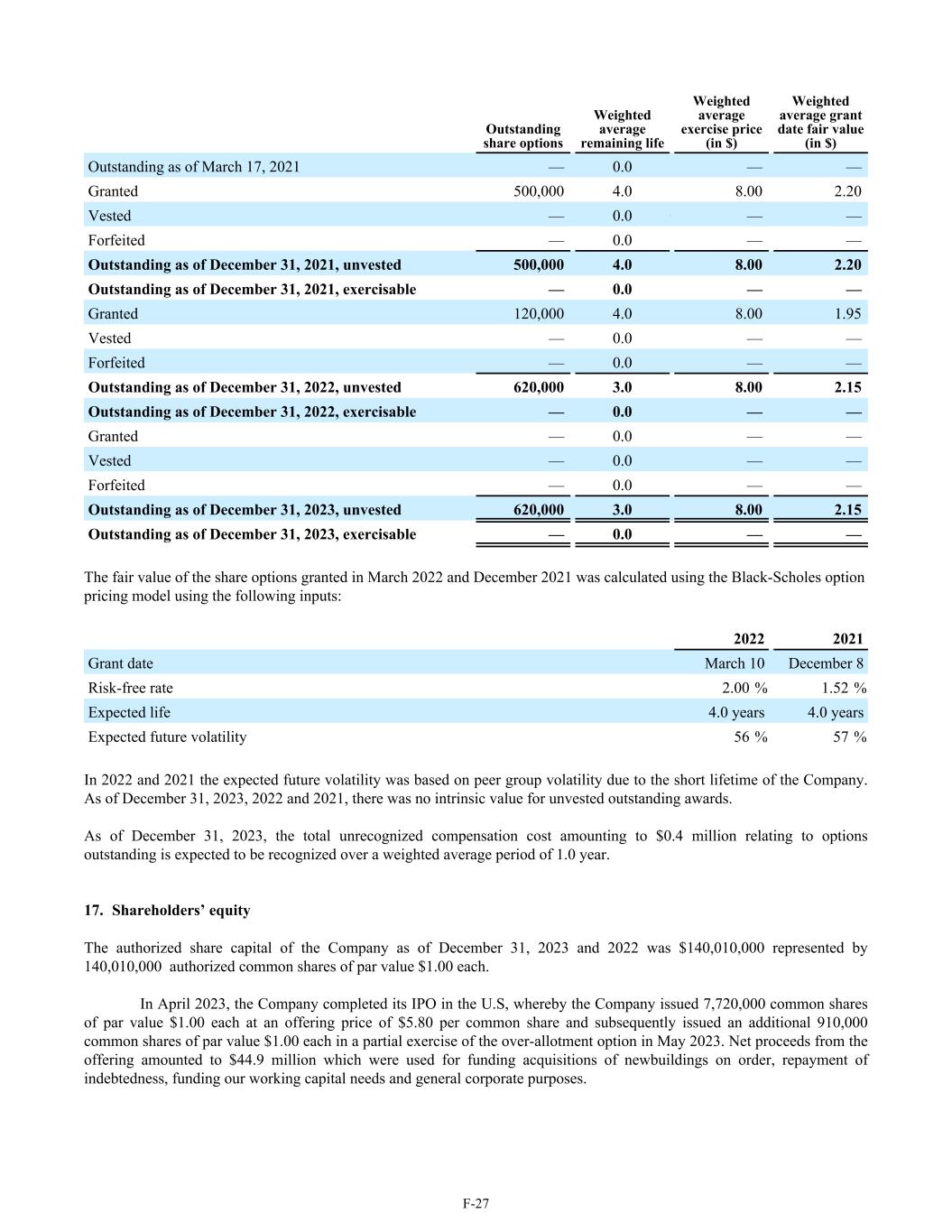
Outstanding share options Weighted average remaining life Weighted average exercise price (in $) Weighted average grant date fair value (in $) Outstanding as of March 17, 2021 — 0.0 — — Granted 500,000 4.0 8.00 2.20 Vested — 0.0 0 — — Forfeited — 0.0 — — Outstanding as of December 31, 2021, unvested 500,000 4.0 8.00 2.20 Outstanding as of December 31, 2021, exercisable — 0.0 — — Granted 120,000 4.0 8.00 1.95 Vested — 0.0 — — Forfeited — 0.0 — — Outstanding as of December 31, 2022, unvested 620,000 3.0 8.00 2.15 Outstanding as of December 31, 2022, exercisable — 0.0 — — Granted — 0.0 — — Vested — 0.0 — — Forfeited — 0.0 — — Outstanding as of December 31, 2023, unvested 620,000 3.0 8.00 2.15 Outstanding as of December 31, 2023, exercisable — 0.0 — — The fair value of the share options granted in March 2022 and December 2021 was calculated using the Black-Scholes option pricing model using the following inputs: 2022 2021 Grant date March 10 December 8 Risk-free rate 2.00 % 1.52 % Expected life 4.0 years 4.0 years Expected future volatility 56 % 57 % In 2022 and 2021 the expected future volatility was based on peer group volatility due to the short lifetime of the Company. As of December 31, 2023, 2022 and 2021, there was no intrinsic value for unvested outstanding awards. As of December 31, 2023, the total unrecognized compensation cost amounting to $0.4 million relating to options outstanding is expected to be recognized over a weighted average period of 1.0 year. 17. Shareholders’ equity The authorized share capital of the Company as of December 31, 2023 and 2022 was $140,010,000 represented by 140,010,000 authorized common shares of par value $1.00 each. In April 2023, the Company completed its IPO in the U.S, whereby the Company issued 7,720,000 common shares of par value $1.00 each at an offering price of $5.80 per common share and subsequently issued an additional 910,000 common shares of par value $1.00 each in a partial exercise of the over-allotment option in May 2023. Net proceeds from the offering amounted to $44.9 million which were used for funding acquisitions of newbuildings on order, repayment of indebtedness, funding our working capital needs and general corporate purposes. F-27

In December 2023, the Company issued 3,117,143 common shares of par value $1.00 each in a private placement at a price of $5.64 per share. Net proceeds amounted to $16.9 million which are being used for funding acquisitions of newbuildings on order, repayment of indebtedness, funding our working capital needs and general corporate purposes. 18. Subsequent events In January 2024, the Company took delivery of three newbuilding vessels, “Mount Bandeira,” “Mount Hua” and “Mount Elbrus,” from New Times Shipyard, resulting in a total delivered fleet of nine vessels, with three additional vessels to be delivered in 2024. The time charters with the respective charterers commenced shortly thereafter. In January 2024, an addendum was entered into with Drew in relation to the revolving credit facility, effective December 18, 2023, to: (i) reduce the amount available under the facility from January 1, 2024 to $10.0 million, (ii) extend the timeframe to drawdown from the facility to December 31, 2024 and the latest repayment date to December 31, 2025, and (iii) change interest to Term Secured Overnight Financing Rate (“SOFR”) plus a margin of 8% per annum. As of December 31, 2023, the revolving credit facility remains undrawn. In February 2024, the Board approved a cash distribution of $0.01 for January 2024 which was paid in March 2024. The distribution was made from the Company's Contributed Surplus account. In January 2024, the shareholders, at a Special General Meeting, approved the transfer of $97.9 million to the Company’s Contributed Surplus Account from the Company's Share Premium account (Additional paid-in capital in the Company’s Consolidated Statement of Changes in Shareholder’s Equity). In February 2024, the Board approved a grant of 115,000 share options to key human resources and one director. The share options granted have a five-year term and cliff vest three years from the grant date. The exercise price is $8.00 per share and will be reduced by any dividends and cash distributions paid. In March 2024, the Board approved a cash distribution of $0.03 per share for February 2024 which will be paid in April 2024. The distribution will be made from the Company's Contributed Surplus account. F-28